ZyXEL Communications NBG-419NV2 Wireless N NetUSB Router User Manual Book
ZyXEL Communications Corporation Wireless N NetUSB Router Book
Contents
- 1. Users Manual-1
- 2. Users Manual-2
Users Manual-2
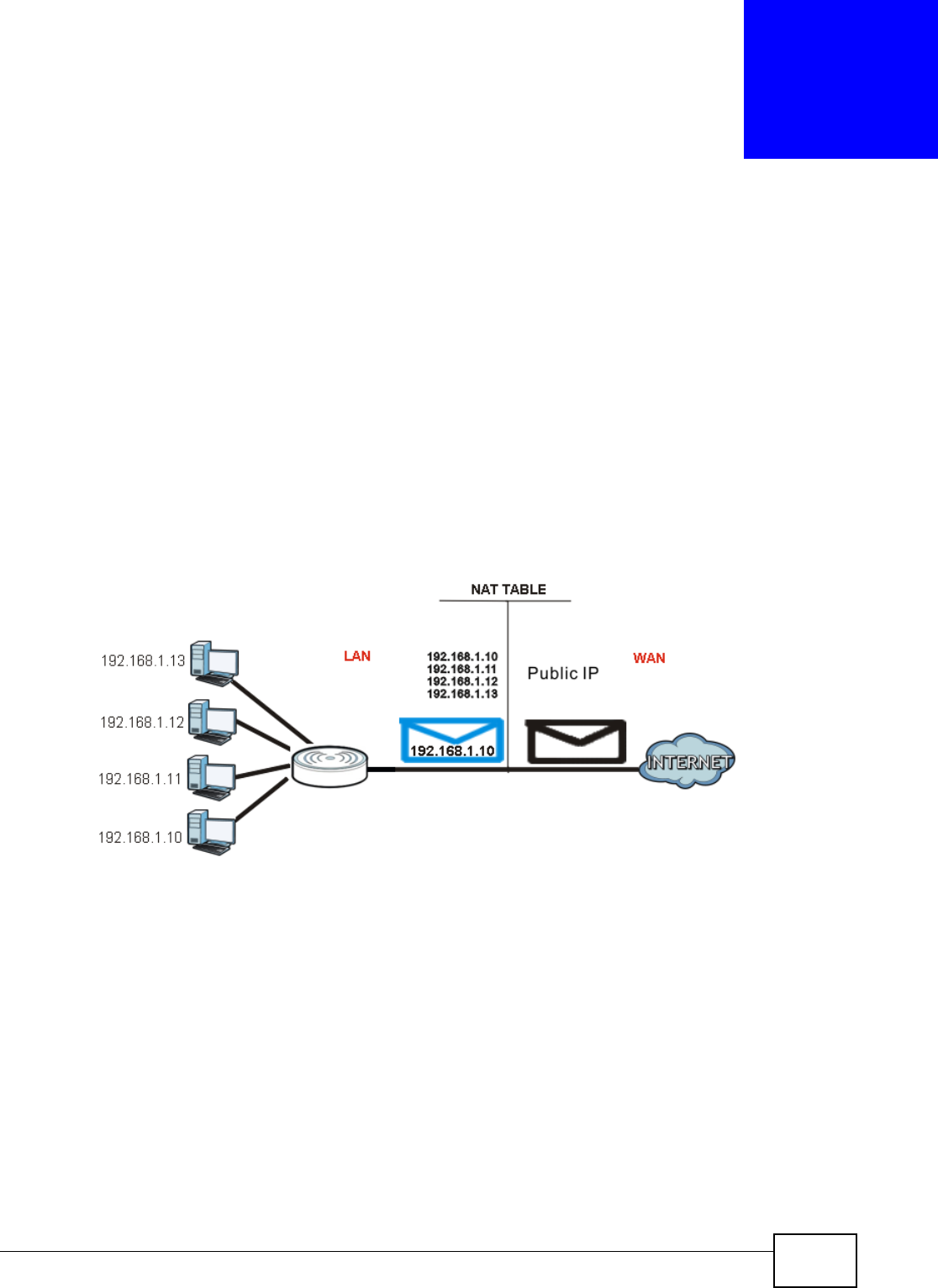
NBG-419N v2 User’s Guide 141
CHAPTER 17
Network Address Translation (NAT)
17.1 Overview
NAT (Network Address Translation - NAT, RFC 1631) is the translation of the IP address of a host in
a packet. For example, the source address of an outgoing packet, used within one network is
changed to a different IP address known within another network.
Each packet has two addresses – a source address and a destination address. For outgoing packets,
NAT maps private (local) IP addresses to globally unique ones required for communication with
hosts on other networks. It replaces the original IP source address in each packet and then
forwards it to the Internet. The Router keeps track of the original addresses and port numbers so
incoming reply packets can have their original values restored. The following figure illustrates this.
Figure 99 NAT Example
For more information on IP address translation, refer to RFC 1631, The IP Network Address
Translator (NAT).
17.2 What You Can Do
•Use the General screen (Section 17.3 on page 142) to enable NAT and set a default server.
•Use the Application screen (Section 17.4 on page 142) o forward incoming service requests to
the server(s) on your local network.
•Use the Advanced screen (Section 17.5 on page 144) to change your Router’s trigger port
settings.
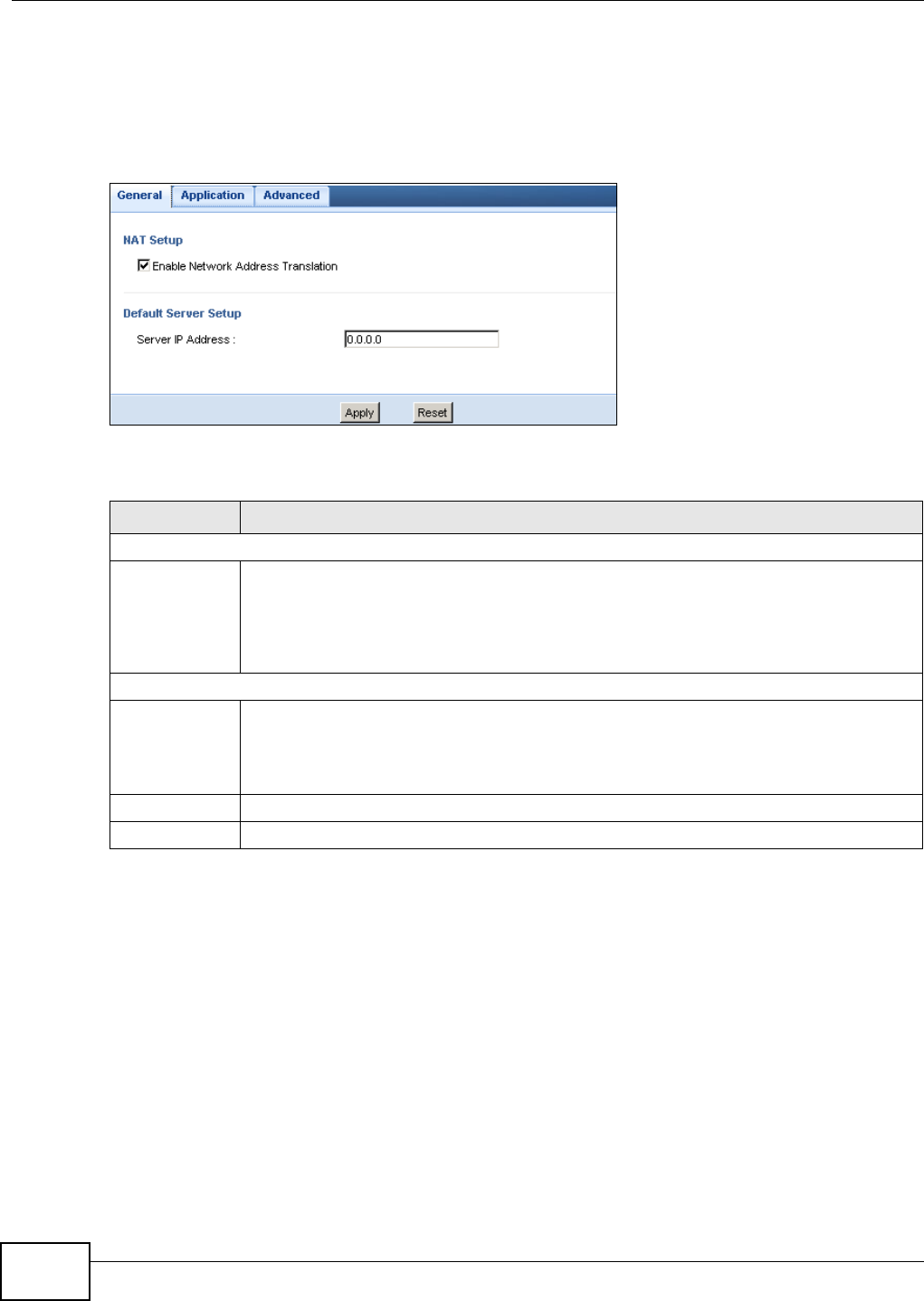
Chapter 17 Network Address Translation (NAT)
NBG-419N v2 User’s Guide
142
17.3 General NAT Screen
Use this screen to enable NAT and set a default server. Click Network > NAT > General to open
the following screen.
Figure 100 Network > NAT > General
The following table describes the labels in this screen.
17.4 NAT Application Screen
Use the Application screen to forward incoming service requests to the server(s) on your local
network. You may enter a single port number or a range of port numbers to be forwarded, and the
local IP address of the desired server. The port number identifies a service; for example, web
service is on port 80 and FTP on port 21. In some cases, such as for unknown services or where one
server can support more than one service (for example both FTP and web service), it might be
better to specify a range of port numbers.
In addition to the servers for specified services, NAT supports a default server. A service request
that does not have a server explicitly designated for it is forwarded to the default server. If the
default is not defined, the service request is simply discarded.
Table 62 Network > NAT > General
LABEL DESCRIPTION
NAT Setup
Enable Network
Address
Translation
Network Address Translation (NAT) allows the translation of an Internet protocol address
used within one network (for example a private IP address used in a local network) to a
different IP address known within another network (for example a public IP address used on
the Internet).
Select the check box to enable NAT.
Default Server Setup
Server IP
Address In addition to the servers for specified services, NAT supports a default server. A default
server receives packets from ports that are not specified in the Application screen.
If you do not assign a Default Server IP address, the Router discards all packets received
for ports that are not specified in the Application screen or remote management.
Apply Click Apply to save your changes back to the Router.
Reset Click Reset to begin configuring this screen afresh.
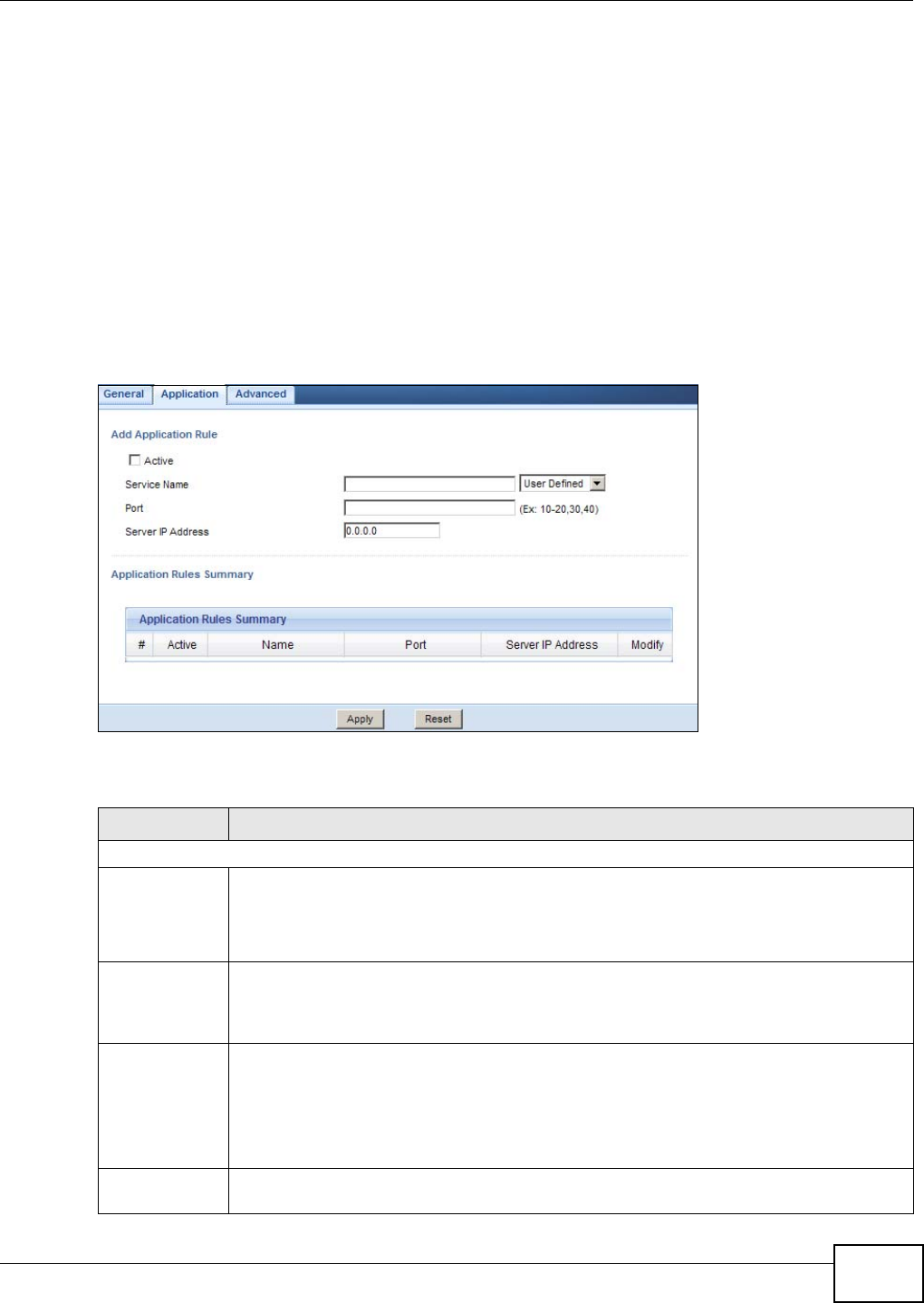
Chapter 17 Network Address Translation (NAT)
NBG-419N v2 User’s Guide 143
Note: Many residential broadband ISP accounts do not allow you to run any server
processes (such as a Web or FTP server) from your location. Your ISP may
periodically check for servers and may suspend your account if it discovers any
active services at your location. If you are unsure, refer to your ISP.
Port forwarding allows you to define the local servers to which the incoming services will be
forwarded. To change your Router’s port forwarding settings, click Network > NAT > Application.
The screen appears as shown.
Note: If you do not assign a Default Server IP address in the NAT > General screen,
the Router discards all packets received for ports that are not specified in this
screen or remote management.
Refer to Appendix E on page 263 for port numbers commonly used for particular services.
Figure 101 Network > NAT > Application
The following table describes the labels in this screen.
Table 63 Network > NAT > Application
LABEL DESCRIPTION
Add Application Rule
Active Select the check box to enable this rule and the requested service can be forwarded to the
host with a specified internal IP address.
Clear the checkbox to disallow forwarding of these ports to an inside server without having
to delete the entry.
Service Name Type a name (of up to 31 printable characters) to identify this rule in the first field next to
Service Name. Otherwise, select a predefined service in the second field next to Service
Name. The predefined service name and port number(s) will display in the Service Name
and Port fields.
Port Type a port number(s) to define the service to be forwarded to the specified server.
To specify a range of ports, enter a hyphen (-) between the first port and the last port, such
as 10-20.
To specify two or more non-consecutive port numbers, separate them by a comma without
spaces, such as 123,567.
Server IP
Address
Type the IP address of the server on your LAN that receives packets from the port(s)
specified in the Port field.

Chapter 17 Network Address Translation (NAT)
NBG-419N v2 User’s Guide
144
17.5 NAT Advanced Screen
Some services use a dedicated range of ports on the client side and a dedicated range of ports on
the server side. With regular port forwarding you set a forwarding port in NAT to forward a service
(coming in from the server on the WAN) to the IP address of a computer on the client side (LAN).
The problem is that port forwarding only forwards a service to a single LAN IP address. In order to
use the same service on a different LAN computer, you have to manually replace the LAN
computer's IP address in the forwarding port with another LAN computer's IP address.
Trigger port forwarding solves this problem by allowing computers on the LAN to dynamically take
turns using the service. The Router records the IP address of a LAN computer that sends traffic to
the WAN to request a service with a specific port number and protocol (a "trigger" port). When the
Router's WAN port receives a response with a specific port number and protocol ("incoming" port),
the Router forwards the traffic to the LAN IP address of the computer that sent the request. After
that computer’s connection for that service closes, another computer on the LAN can use the
service in the same manner. This way you do not need to configure a new IP address each time you
want a different LAN computer to use the application.
To change your Router’s trigger port settings, click Network > NAT > Advanced. The screen
appears as shown.
Application Rules Summary
#This is the number of an individual port forwarding server entry.
Active This icon is turned on when the rule is enabled.
Name This field displays a name to identify this rule.
Port This field displays the port number(s).
Server IP
Address
This field displays the inside IP address of the server.
Modify Click the Edit icon to display and modify an existing rule setting in the fields under Add
Application Rule.
Click the Remove icon to delete a rule.
Apply Click Apply to save your changes back to the Router.
Reset Click Reset to begin configuring this screen afresh.
Table 63 Network > NAT > Application (continued)
LABEL DESCRIPTION
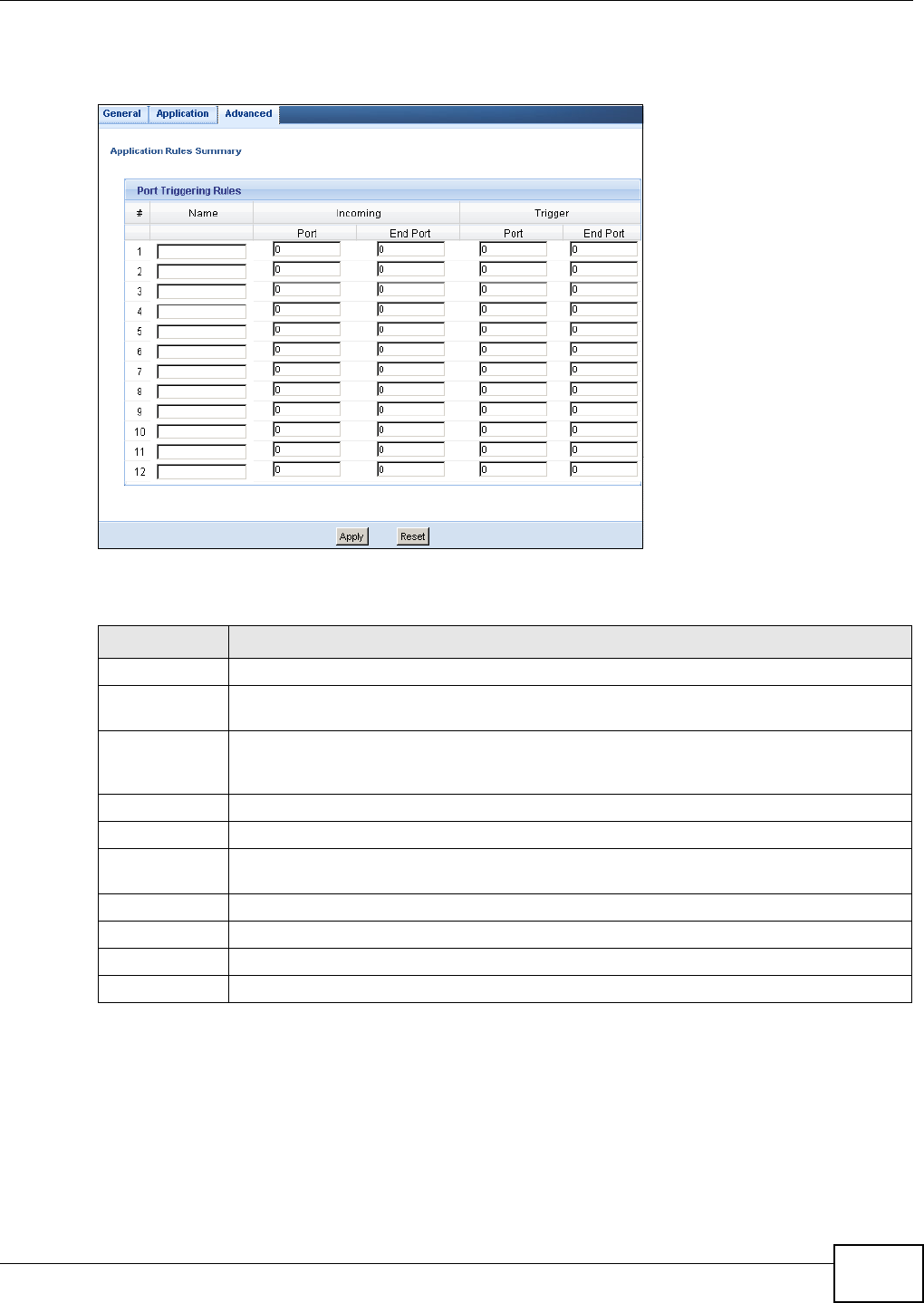
Chapter 17 Network Address Translation (NAT)
NBG-419N v2 User’s Guide 145
Note: Only one LAN computer can use a trigger port (range) at a time.
Figure 102 Network > NAT > Advanced
The following table describes the labels in this screen.
Table 64 Network > NAT > Advanced
LABEL DESCRIPTION
#This is the rule index number (read-only).
Name Type a unique name (up to 15 characters) for identification purposes. All characters are
permitted - including spaces.
Incoming Incoming is a port (or a range of ports) that a server on the WAN uses when it sends out a
particular service. The Router forwards the traffic with this port (or range of ports) to the
client computer on the LAN that requested the service.
Start Port Type a port number or the starting port number in a range of port numbers.
End Port Type a port number or the ending port number in a range of port numbers.
Trigger The trigger port is a port (or a range of ports) that causes (or triggers) the Router to record
the IP address of the LAN computer that sent the traffic to a server on the WAN.
Start Port Type a port number or the starting port number in a range of port numbers.
End Port Type a port number or the ending port number in a range of port numbers.
Apply Click Apply to save your changes back to the Router.
Reset Click Reset to begin configuring this screen afresh.
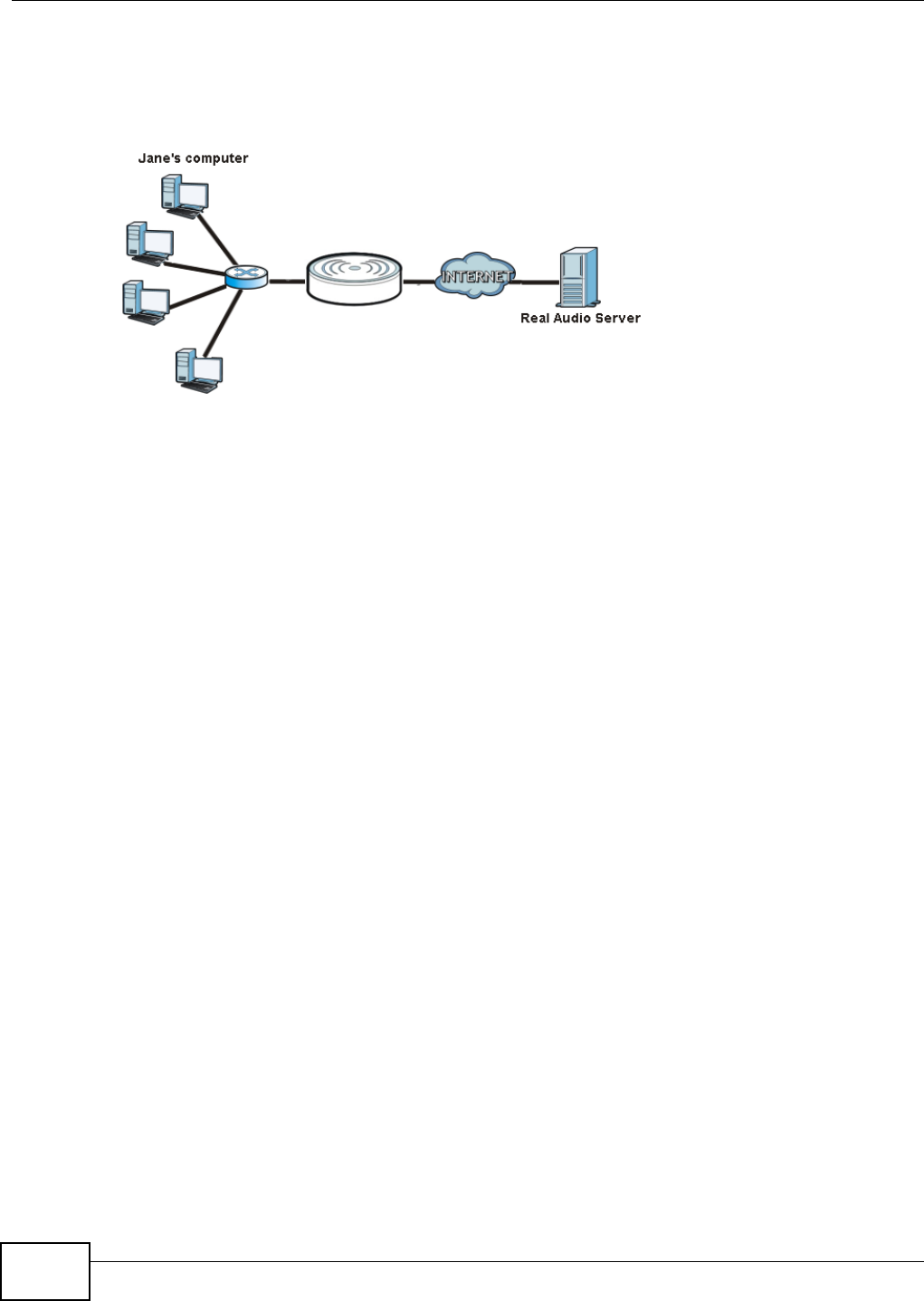
Chapter 17 Network Address Translation (NAT)
NBG-419N v2 User’s Guide
146
17.5.1 Trigger Port Forwarding Example
The following is an example of trigger port forwarding.
Figure 103 Trigger Port Forwarding Process: Example
1Jane requests a file from the Real Audio server (port 7070).
2Port 7070 is a “trigger” port and causes the Router to record Jane’s computer IP address. The
Router associates Jane's computer IP address with the "incoming" port range of 6970-7170.
3The Real Audio server responds using a port number ranging between 6970-7170.
4The Router forwards the traffic to Jane’s computer IP address.
5Only Jane can connect to the Real Audio server until the connection is closed or times out. The
Router times out in three minutes with UDP (User Datagram Protocol), or two hours with TCP/IP
(Transfer Control Protocol/Internet Protocol).
17.5.2 Two Points To Remember About Trigger Ports
1Trigger events only happen on data that is going coming from inside the Router and going to the
outside.
If an application needs a continuous data stream, that port (range) will be tied up so that another
computer on the LAN can’t trigger it.
Router
Router
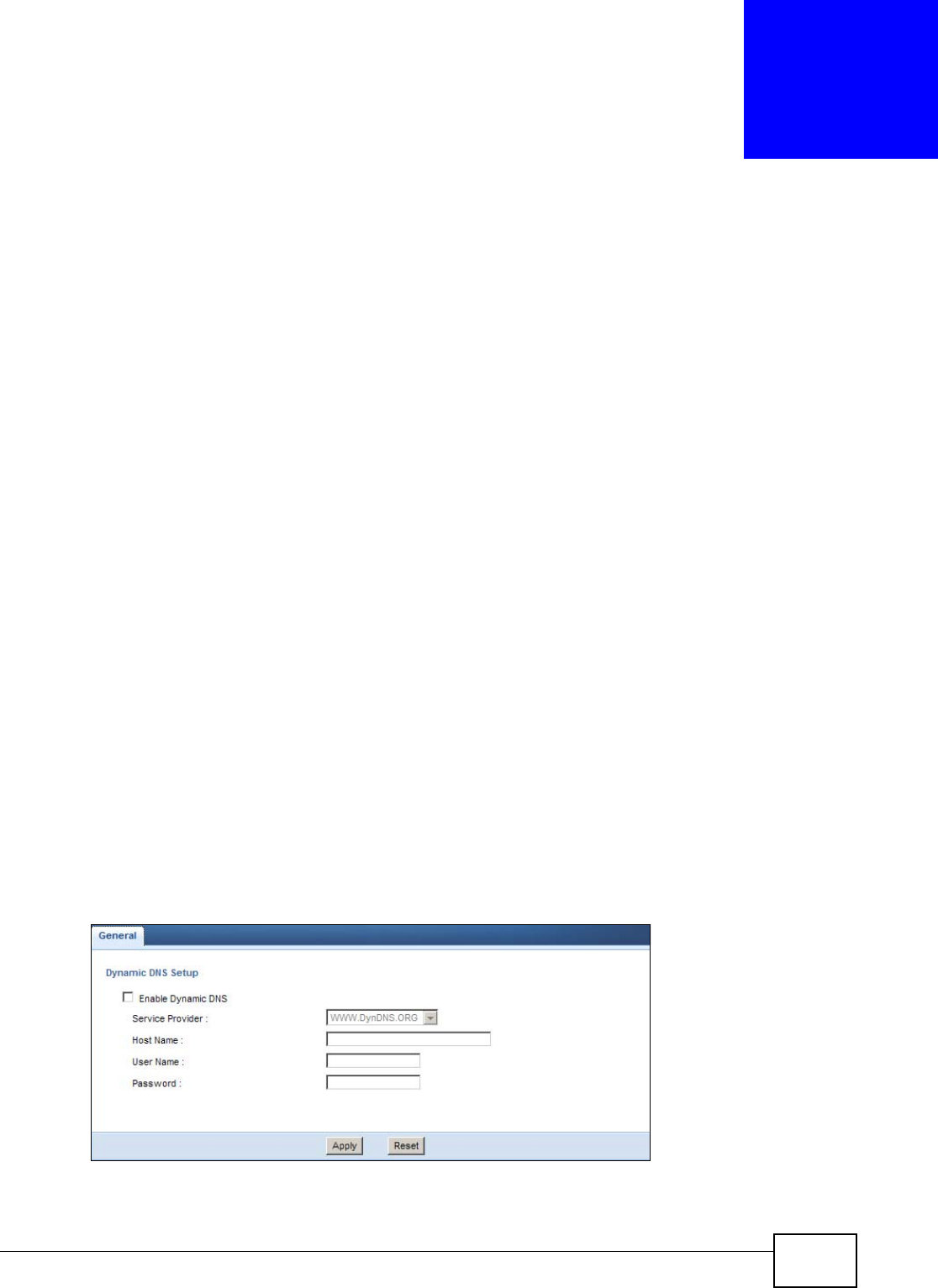
NBG-419N v2 User’s Guide 147
CHAPTER 18
Dynamic DNS
18.1 Overview
Dynamic DNS (DDNS) services let you use a domain name with a dynamic IP address.
18.2 What You Can Do
Use the Dynamic DNS screen (Section 18.4 on page 147) to enable DDNS and configure the DDNS
settings on the Router.
18.3 What You Need To Know
Dynamic DNS allows you to update your current dynamic IP address with one or many dynamic
DNS services so that anyone can contact you (in NetMeeting, CU-SeeMe, etc.). You can also access
your FTP server or Web site on your own computer using a domain name (for instance
myhost.dhs.org, where myhost is a name of your choice) that will never change instead of using an
IP address that changes each time you reconnect. Your friends or relatives will always be able to
call you even if they don't know your IP address.
18.4 Dynamic DNS Screen
To change your Router’s DDNS, click Network > DDNS. The screen appears as shown.
Figure 104 Network > DDNS

Chapter 18 Dynamic DNS
NBG-419N v2 User’s Guide
148
The following table describes the labels in this screen.
Table 65 Network > DDNS
LABEL DESCRIPTION
Enable
Dynamic DNS
Select this check box to use dynamic DNS.
Service
Provider
Select the name of your Dynamic DNS service provider.
Host Name Enter a host names in the field provided. You can specify up to two host names in the field
separated by a comma (",").
User Name Enter your user name.
Password Enter the password assigned to you.
Apply Click Apply to save your changes back to the Router.
Reset Click Reset to begin configuring this screen afresh.
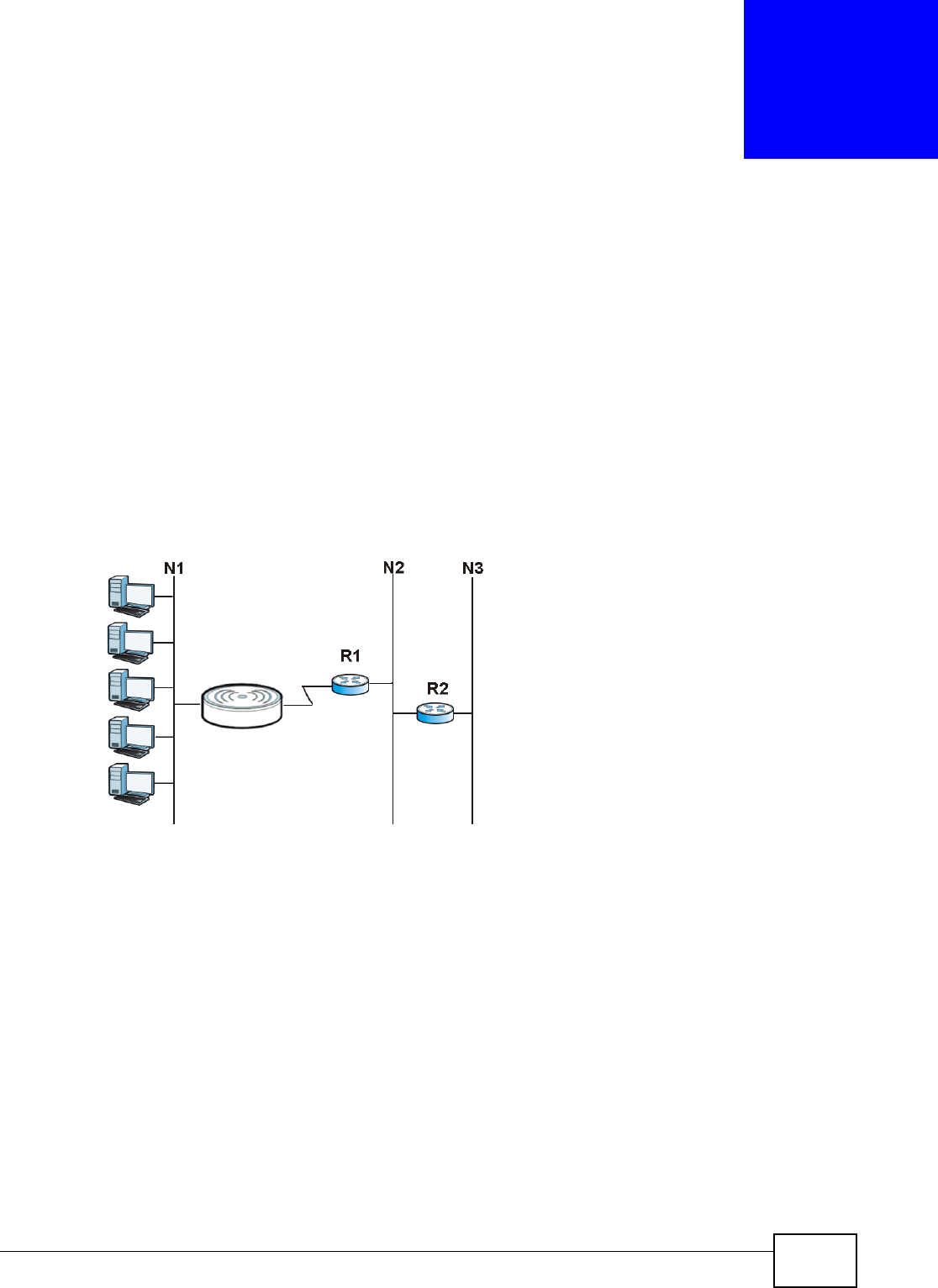
NBG-419N v2 User’s Guide 149
CHAPTER 19
Static Route
19.1 Overview
This chapter shows you how to configure static routes for your Router.
Each remote node specifies only the network to which the gateway is directly connected, and the
Router has no knowledge of the networks beyond. For instance, the Router knows about network
N2 in the following figure through remote node Router 1. However, the Router is unable to route a
packet to network N3 because it doesn't know that there is a route through the same remote node
Router 1 (via gateway Router 2). The static routes are for you to tell the Router about the networks
beyond the remote nodes.
Figure 105 Example of Static Routing Topology
19.2 What You Can Do
Use the IP Static Route screen (Section 19.3 on page 150) to view, add and delete routes.
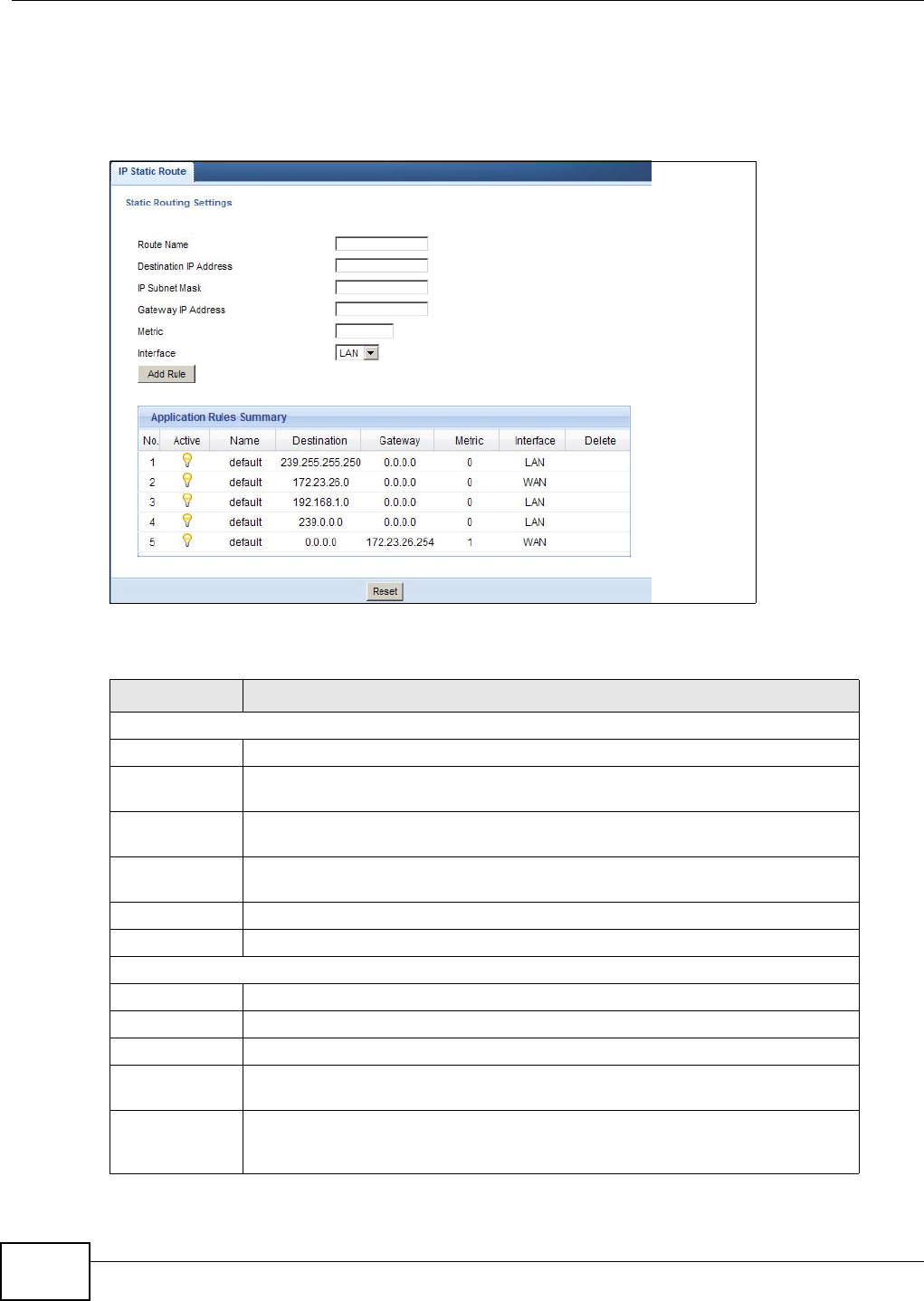
Chapter 19 Static Route
NBG-419N v2 User’s Guide
150
19.3 IP Static Route Screen
Click Network > Static Route to open the IP Static Route screen.
Figure 106 Network > Static Route
The following table describes the labels in this screen.
Table 66 Network > Static Route
LABEL DESCRIPTION
Static Routing Settings
Route Name Enter a the name that describes or identifies this route.
Destination IP
Address
Enter the IP network address of the final destination.
IP Subnet
Netmask
This is the subnet to which the route’s final destination belongs.
Gateway IP
Address
Enter the the IP address of the gateway.
Metric Assign a number to identify the route.
Add Rule Click this to add the IP static route.
Application Rules Summary
No. This is the number of an individual static route.
Active The rules are always on and this is indicated by the icon.
Name This is the name that describes or identifies this route.
Destination This parameter specifies the IP network address of the final destination. Routing is
always based on network number.
Gateway This is the IP address of the gateway. The gateway is a router or switch on the
same network segment as the device's LAN or WAN port. The gateway helps
forward packets to their destinations.
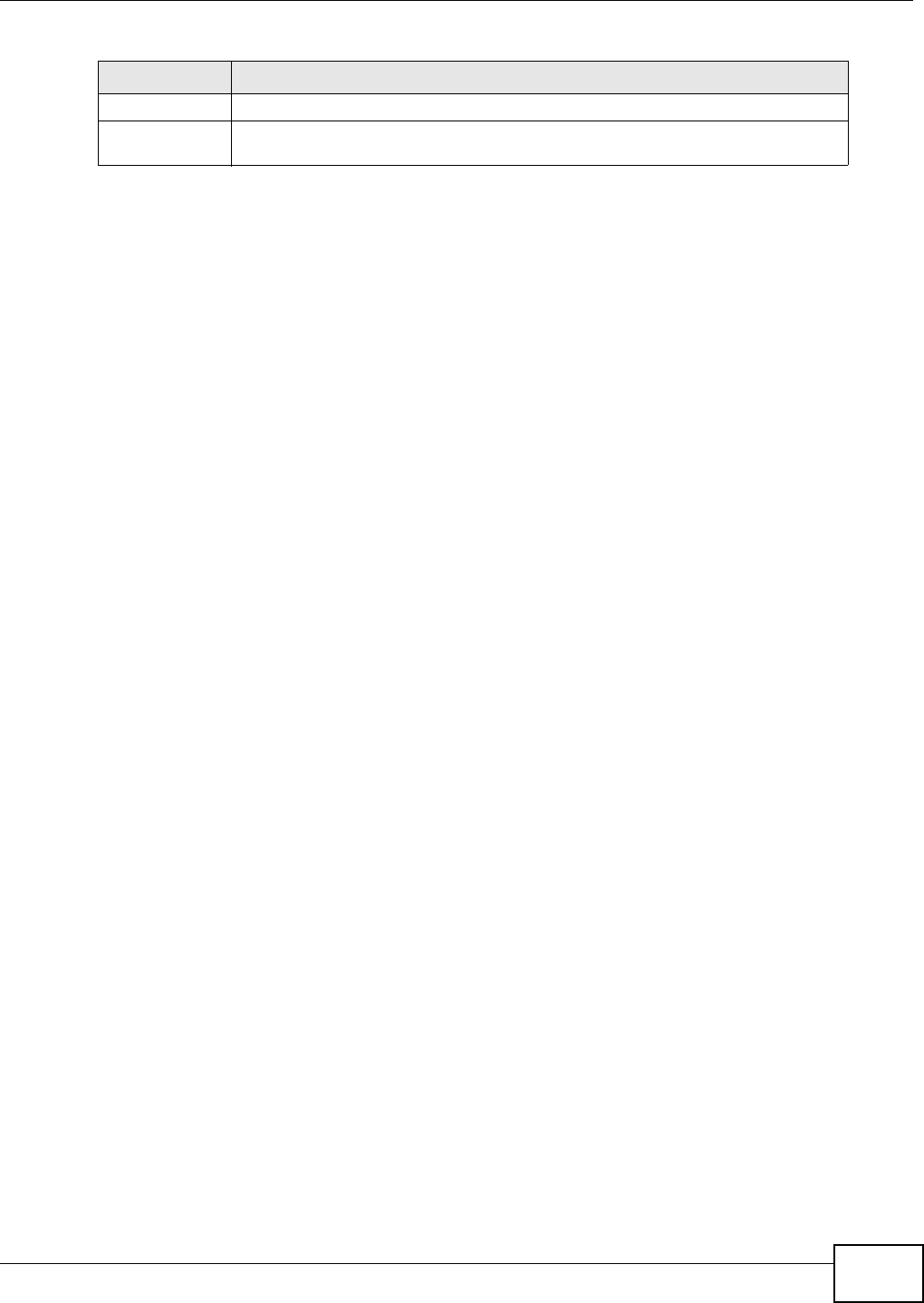
Chapter 19 Static Route
NBG-419N v2 User’s Guide 151
Metric This is the number assigned to the route.
Delete Click the Delete icon to remove a static route from the Router. A window displays
asking you to confirm that you want to delete the route.
Table 66 Network > Static Route
LABEL DESCRIPTION

Chapter 19 Static Route
NBG-419N v2 User’s Guide
152
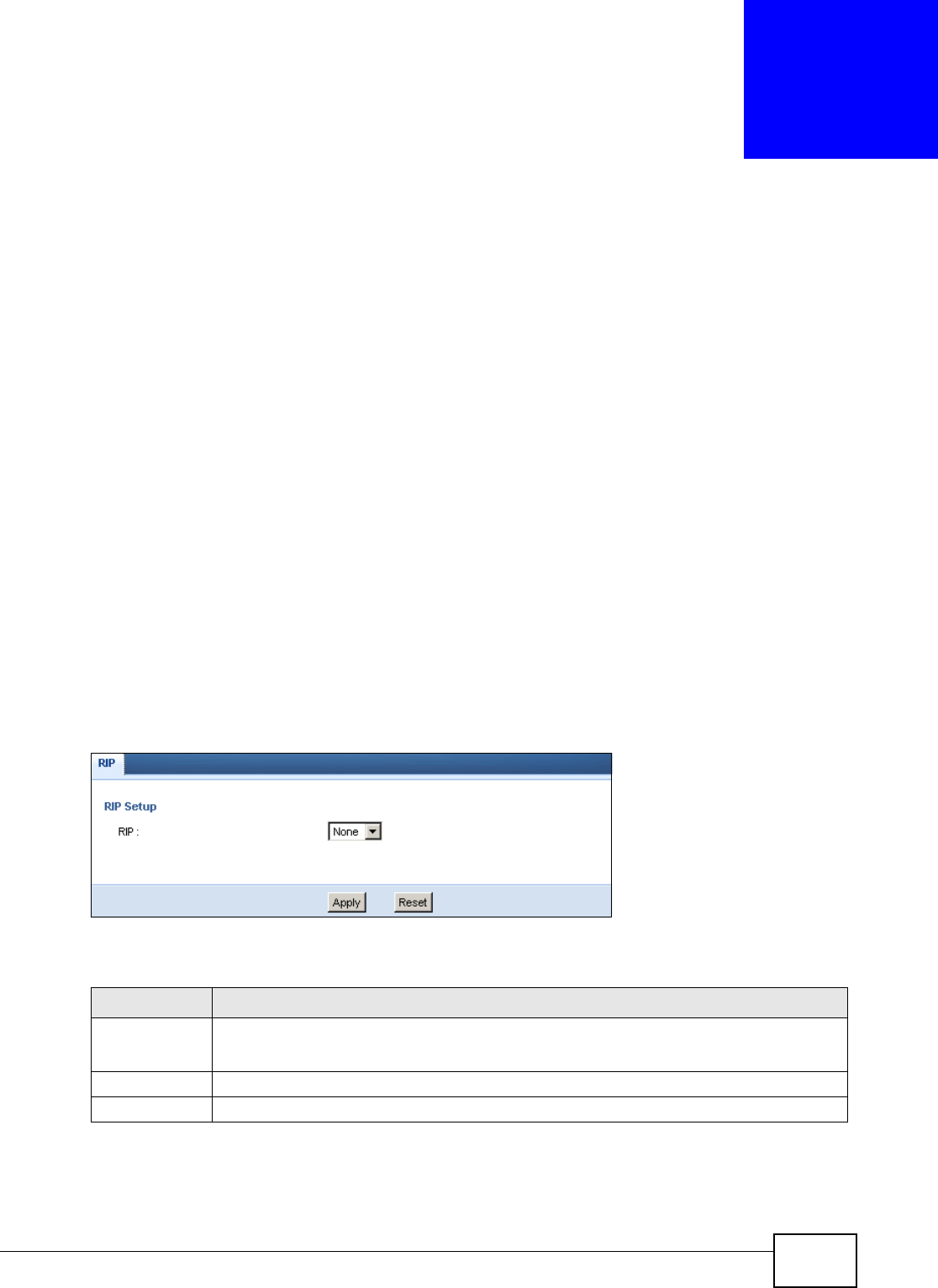
NBG-419N v2 User’s Guide 153
CHAPTER 20
RIP
20.1 Overview
Routing Information Protocol (RIP) is an interior or intra-domain routing protocol that uses
distance-vector routing algorithms. RIP is used on the Internet and is common in the NetWare
environment as a method for exchanging routing information between routers.
20.2 What You Can Do
Use the RIP screen (Section 20.3 on page 153) to enable RIPv1 or RIPv2, which are LAN broadcast
protocols.
20.3 RIP Screen
Use this screen to enable RIPv1 or RIPv2, which are LAN broadcast protocols. Click Network >
RIP. The screen appears as shown.
Figure 107 Network > RIP
The following table describes the labels in this screen.
Table 67 Network > RIP
LABEL DESCRIPTION
RIP Select the RIPv1 or RIPv2 you want the Router to use.
Otherwise select None.
Apply Click Apply to save your changes back to the Router.
Reset Click Reset to begin configuring this screen afresh.

Chapter 20 RIP
NBG-419N v2 User’s Guide
154
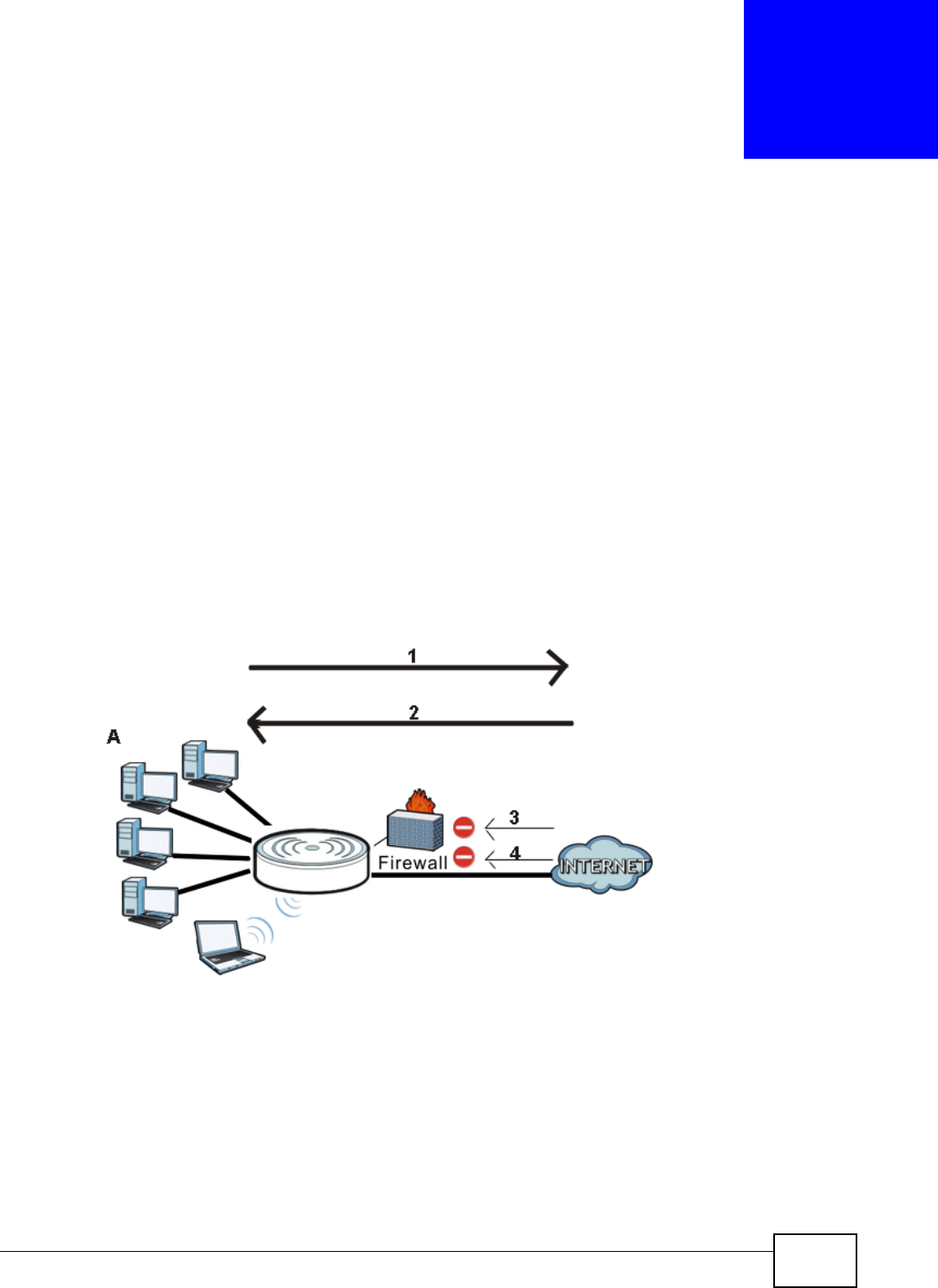
NBG-419N v2 User’s Guide 155
CHAPTER 21
Firewall
21.1 Overview
This chapter shows you how to enable and configure the firewall that protects your Router and your
LAN from unwanted or malicious traffic.
Enable the firewall to protect your LAN computers from attacks by hackers on the Internet and
control access between the LAN and WAN. By default the firewall:
• allows traffic that originates from your LAN computers to go to all of the networks.
• blocks traffic that originates on the other networks from going to the LAN.
The following figure illustrates the default firewall action. User A can initiate an IM (Instant
Messaging) session from the LAN to the WAN (1). Return traffic for this session is also allowed (2).
However other traffic initiated from the WAN is blocked (3 and 4).
Figure 108 Default Firewall Action
21.2 What You Can Do
•Use the General (Section 21.4 on page 156) screen to enable or disable the Router’s firewall.
•Use the Services screen (Section 21.5 on page 157) screen enable service blocking, enter/
delete/modify the services you want to block and the date/time you want to block them.
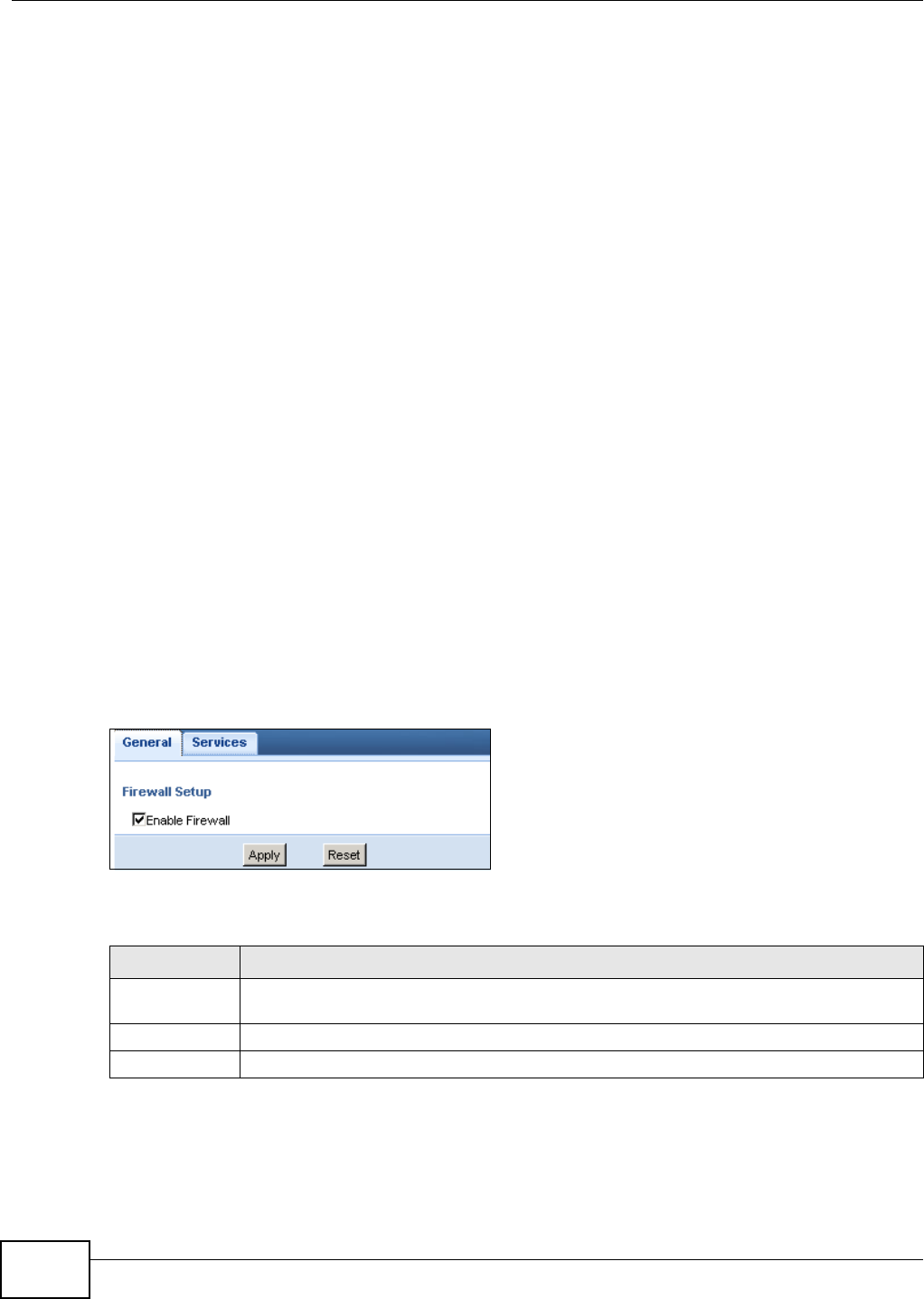
Chapter 21 Firewall
NBG-419N v2 User’s Guide
156
21.3 What You Need To Know
The Router’s firewall feature physically separates the LAN and the WAN and acts as a secure
gateway for all data passing between the networks.
It is designed to protect against Denial of Service (DoS) attacks when activated (click the General
tab under Firewall and then click the Enable Firewall check box). The Router's purpose is to
allow a private Local Area Network (LAN) to be securely connected to the Internet. The Router can
be used to prevent theft, destruction and modification of data, as well as log events, which may be
important to the security of your network.
The Router is installed between the LAN and a broadband modem connecting to the Internet. This
allows it to act as a secure gateway for all data passing between the Internet and the LAN.
The Router has one Ethernet WAN port and four Ethernet LAN ports, which are used to physically
separate the network into two areas.The WAN (Wide Area Network) port attaches to the broadband
(cable or DSL) modem to the Internet.
The LAN (Local Area Network) port attaches to a network of computers, which needs security from
the outside world. These computers will have access to Internet services such as e-mail, FTP and
the World Wide Web. However, "inbound access" is not allowed (by default) unless the remote host
is authorized to use a specific service.
21.4 General Firewall Screen
Use this screen to enable or disable the Router’s firewall, and set up firewall logs. Click Security >
Firewall to open the General screen.
Figure 109 Security > Firewall > General
The following table describes the labels in this screen.
Table 68 Security > Firewall > General
LABEL DESCRIPTION
Enable Firewall Select this check box to activate the firewall. The Router performs access control and
protects against Denial of Service (DoS) attacks when the firewall is activated.
Apply Click Apply to save the settings.
Reset Click Reset to start configuring this screen again.
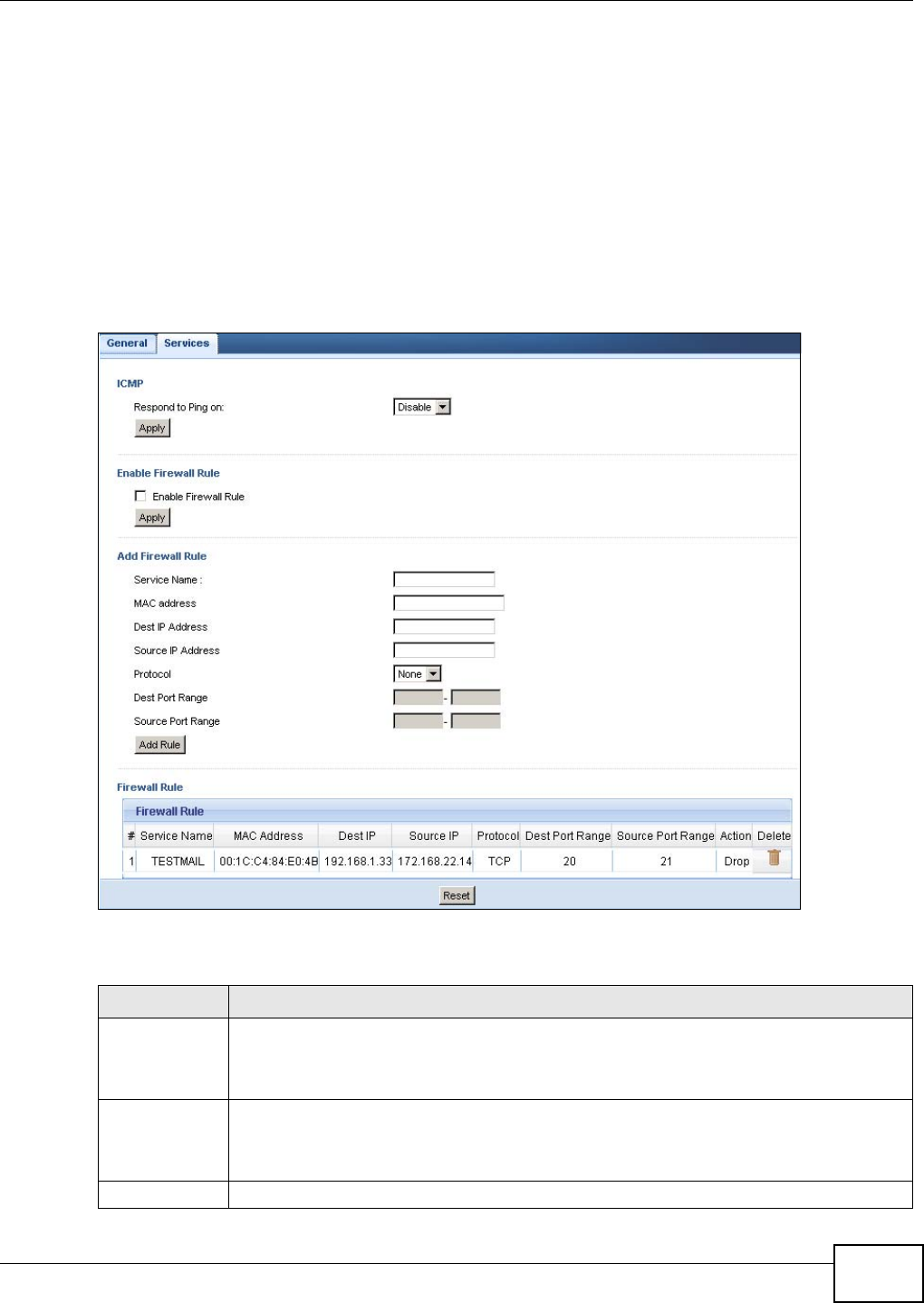
Chapter 21 Firewall
NBG-419N v2 User’s Guide 157
21.5 Services Screen
If an outside user attempts to probe an unsupported port on your Router, an ICMP response packet
is automatically returned. This allows the outside user to know the Router exists. Use this screen to
prevent the ICMP response packet from being sent. This keeps outsiders from discovering your
Router when unsupported ports are probed.
You can also use this screen to enable service blocking, enter/delete/modify the services you want
to block and the date/time you want to block them.
Click Security > Firewall > Services. The screen appears as shown next.
Figure 110 Security > Firewall > Services
The following table describes the labels in this screen.
Table 69 Security > Firewall > Services
LABEL DESCRIPTION
ICMP Internet Control Message Protocol is a message control and error-reporting protocol
between a host server and a gateway to the Internet. ICMP uses Internet Protocol (IP)
datagrams, but the messages are processed by the TCP/IP software and directly apparent
to the application user.
Respond to
Ping on
The Router will not respond to any incoming Ping requests when Disable is selected. Select
LAN to reply to incoming LAN Ping requests. Select WAN to reply to incoming WAN Ping
requests. Otherwise select LAN & WAN to reply to all incoming LAN and WAN Ping
requests.
Apply Click Apply to save the settings.

Chapter 21 Firewall
NBG-419N v2 User’s Guide
158
See Appendix E on page 263 for commonly used services and port numbers.
Enable Firewall Rule
Enable Firewall
Rule
Select this check box to activate the firewall rules that you define (see Add Firewall Rule
below)
Apply Click Apply to save the settings.
Add Firewall Rule
Service Name Enter a name that identifies or describes the firewall rule.
MAC Address Enter the MAC address of the computer for which the firewall rule applies.
Dest IP Address Enter the IP address of the computer to which traffic for the application or service is
entering.
The Router applies the firewall rule to traffic initiating from this computer.
Source IP
Address
Enter the IP address of the computer that initializes traffic for the application or service.
The Router applies the firewall rule to traffic initiating from this computer.
Protocol Select the protocol (TCP, UDP, ICMP or None) used to transport the packets for which you
want to apply the firewall rule.
Dest Port
Range
Enter the port number/range of the destination that define the traffic type, for example TCP
port 80 defines web traffic.
Source Port
Range
Enter the port number/range of the source that define the traffic type, for example TCP port
80 defines web traffic.
Add Rule Click Add to save the firewall rule.
Firewall Rule
#This is your firewall rule number. The ordering of your rules is important as rules are applied
in turn.
Service Name This is a name that identifies or describes the firewall rule.
MAC Address This is the MAC address of the computer for which the firewall rule applies.
Dest IP Address This is the IP address of the computer to which traffic for the application or service is
entering.
Source IP
Address
This is the IP address of the computer from which traffic for the application or service is
initialized.
Protocol This is the protocol (TCP, UDP, ICMP or None) used to transport the packets for which you
want to apply the firewall rule.
Dest Port
Range
This is the port number/range of the destination that define the traffic type, for example
TCP port 80 defines web traffic.
Source Port
Range
This is the port number/range of the source that define the traffic type, for example TCP
port 80 defines web traffic.
Action Drop - Traffic matching the conditions of the firewall rule are stopped.
Delete Click this to remove the firewall rule.
Reset Click Reset to start configuring this screen again.
Table 69 Security > Firewall > Services (continued)
LABEL DESCRIPTION

NBG-419N v2 User’s Guide 159
CHAPTER 22
Content Filter
22.1 Overview
This chapter provides a brief overview of content filtering using the embedded web GUI.
Internet content filtering allows you to create and enforce Internet access policies tailored to your
needs. Content filtering is the ability to block certain web features or specific URL keywords.
22.2 What You Can Do
Use the Content Filter (Section 22.4 on page 160) screen to restrict web features, add
keywords for blocking and designate a trusted computer.
22.3 What You Need To Know
Content filtering allows you to block certain web features, such as cookies, and/or block access to
specific web sites. For example, you can configure one policy that blocks John Doe’s access to arts
and entertainment web pages.
22.3.1 Content Filtering Profiles
A content filtering profile conveniently stores your custom settings for the following features.
Restrict Web Features
The Router can disable web proxies and block web features such as ActiveX controls, Java applets
and cookies.
Keyword Blocking URL Checking
The Router checks the URL’s domain name (or IP address) and file path separately when performing
keyword blocking.
The URL’s domain name or IP address is the characters that come before the first slash in the URL.
For example, with the URL www.zyxel.com.tw/news/pressroom.php, the domain name is
www.zyxel.com.tw.
The file path is the characters that come after the first slash in the URL. For example, with the URL
www.zyxel.com.tw/news/pressroom.php, the file path is news/pressroom.php.
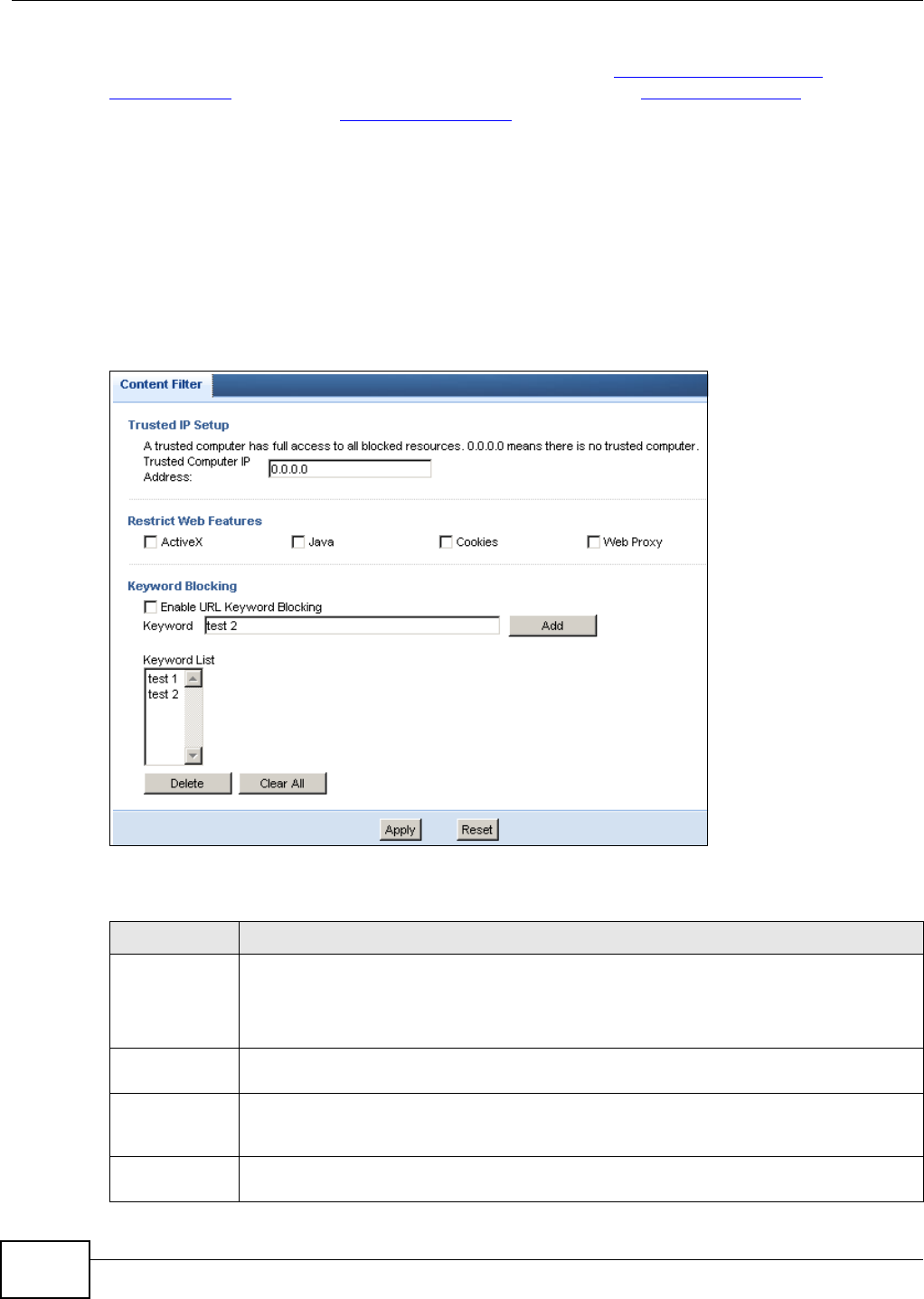
Chapter 22 Content Filter
NBG-419N v2 User’s Guide
160
Since the Router checks the URL’s domain name (or IP address) and file path separately, it will not
find items that go across the two. For example, with the URL www.zyxel.com.tw/news/
pressroom.php, the Router would find “tw” in the domain name (www.zyxel.com.tw). It would also
find “news” in the file path (news/pressroom.php) but it would not find “tw/news”.
22.4 Content Filter Screen
Use this screen to restrict web features, add keywords for blocking and designate a trusted
computer.
Click Security > Content Filter to open the Content Filter screen.
Figure 111 Security > Content Filter > Content Filter
The following table describes the labels in this screen.
Table 70 Security > Content Filter > Content Filter
LABEL DESCRIPTION
Trusted IP
Setup
To enable this feature, type an IP address of any one of the computers in your network that
you want to have as a trusted computer. This allows the trusted computer to have full
access to all features that are configured to be blocked by content filtering.
Leave this field blank to have no trusted computers.
Restrict Web
Features
Select the box(es) to restrict a feature. When you download a page containing a restricted
feature, that part of the web page will appear blank or grayed out.
ActiveX A tool for building dynamic and active Web pages and distributed object applications. When
you visit an ActiveX Web site, ActiveX controls are downloaded to your browser, where they
remain in case you visit the site again.
Java A programming language and development environment for building downloadable Web
components or Internet and intranet business applications of all kinds.
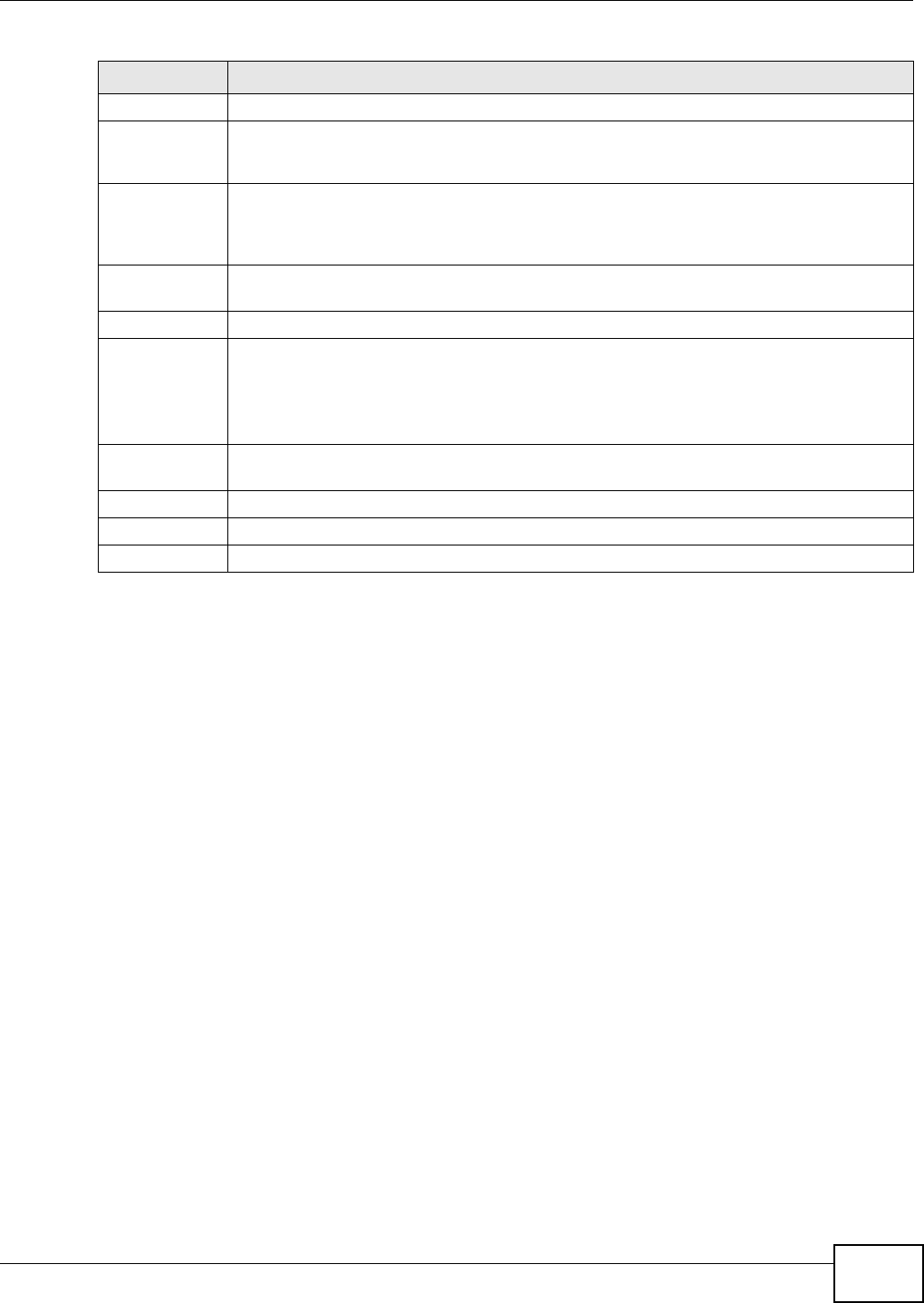
Chapter 22 Content Filter
NBG-419N v2 User’s Guide 161
Cookies Used by Web servers to track usage and provide service based on ID.
Web Proxy A server that acts as an intermediary between a user and the Internet to provide security,
administrative control, and caching service. When a proxy server is located on the WAN it is
possible for LAN users to circumvent content filtering by pointing to this proxy server.
Enable URL
Keyword
Blocking
The Router can block Web sites with URLs that contain certain keywords in the domain name
or IP address. For example, if the keyword "bad" was enabled, all sites containing this
keyword in the domain name or IP address will be blocked, e.g., URL http://
www.website.com/bad.html would be blocked. Select this check box to enable this feature.
Keyword Type a keyword in this field. You may use any character (up to 64 characters). Wildcards are
not allowed. You can also enter a numerical IP address.
Keyword List This list displays the keywords already added.
Add Click Add after you have typed a keyword.
Repeat this procedure to add other keywords. Up to 64 keywords are allowed.
When you try to access a web page containing a keyword, you will get a message telling you
that the content filter is blocking this request.
Delete Highlight a keyword in the lower box and click Delete to remove it. The keyword disappears
from the text box after you click Apply.
Clear All Click this button to remove all of the listed keywords.
Apply Click Apply to save your changes.
Reset Click Reset to begin configuring this screen afresh
Table 70 Security > Content Filter > Content Filter (continued)
LABEL DESCRIPTION

Chapter 22 Content Filter
NBG-419N v2 User’s Guide
162
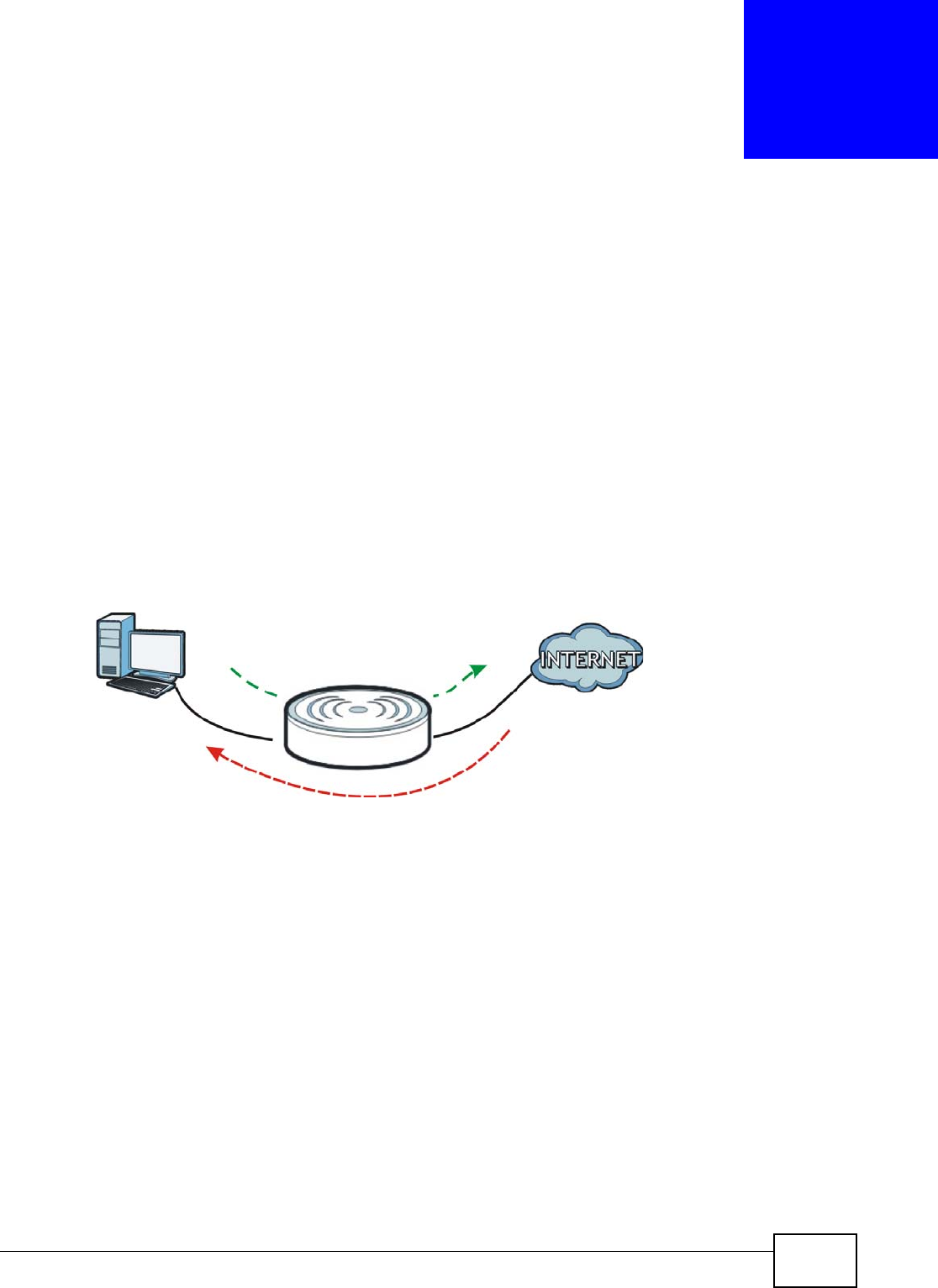
NBG-419N v2 User’s Guide 163
CHAPTER 23
Bandwidth Management
23.1 Overview
This chapter contains information about configuring bandwidth management and editing rules.
ZyXEL’s Bandwidth Management allows you to specify bandwidth management rules based on an
application.
In the figure below, uplink traffic goes from the LAN device (A) to the WAN device (B). Bandwidth
management is applied before sending the packets out to the WAN. Downlink traffic comes back
from the WAN device (B) to the LAN device (A). Bandwidth management is applied before sending
the traffic out to LAN.
Figure 112 Bandwidth Management Example
You can allocate specific amounts of bandwidth capacity (bandwidth budgets) to individual
applications (like VoIP, Web, FTP, and E-mail for example).
23.2 What You Can Do
•Use the General screen (Section 23.4 on page 164) to enable bandwidth management and
assign bandwidth values.
•Use the Advanced screen (Section 23.5 on page 164) to configure bandwidth managements rule
for the pre-defined services and applications.
•Use the Monitor screen (Section 23.6 on page 168) to view the amount of network bandwidth
that applications running in the network are using.
AB
-> VOIP
-> FTP
-> HTTP
-> Chat, Email
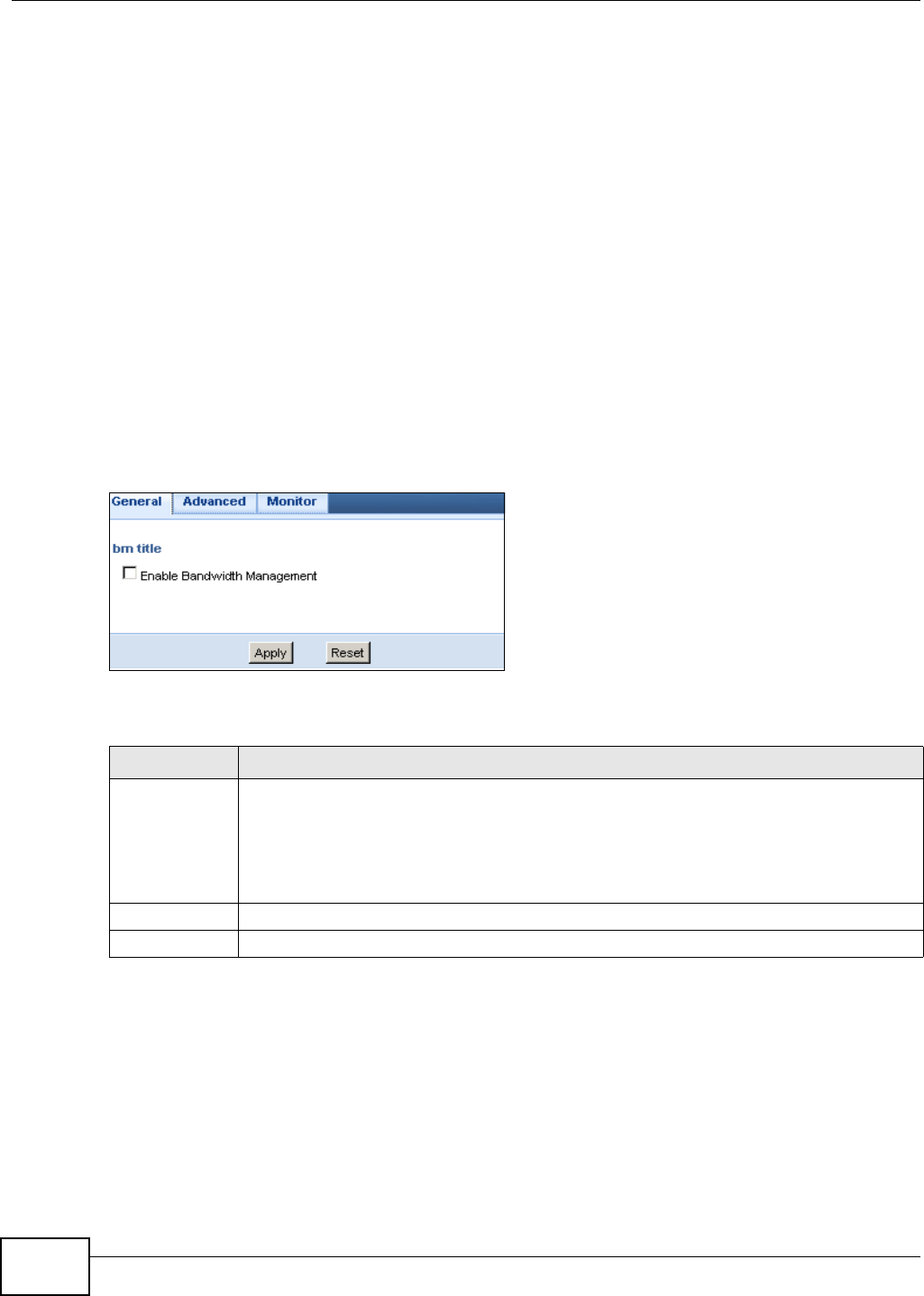
Chapter 23 Bandwidth Management
NBG-419N v2 User’s Guide
164
23.3 What You Need To Know
The sum of the bandwidth allotments that apply to the WAN interface (LAN to WAN, WLAN to WAN)
must be less than or equal to the Upstream Bandwidth that you configure in the Bandwidth
Management Advanced screen (Section 23.5 on page 164).
The sum of the bandwidth allotments that apply to the LAN interface (WAN to LAN, WAN to WLAN)
must be less than or equal to the Downstream Bandwidth that you configure in the Bandwidth
Management Advanced screen Section 23.5 on page 164.
23.4 General Screen
Use this screen to have the Router apply bandwidth management.
Click Management > Bandwidth Management to open the bandwidth management General
screen.
Figure 113 Management > Bandwidth Management > General
The following table describes the labels in this screen.
23.5 Advanced Screen
Use this screen to configure bandwidth management rules for the pre-defined services or
applications.
You can also use this screen to configure bandwidth management rule for other services or
applications that are not on the pre-defined list of Router. Additionally, you can define the source
and destination IP addresses and port for a service or application.
Table 71 Management > Bandwidth Management > General
LABEL DESCRIPTION
Enable
Bandwidth
Management
This field allows you to have Router apply bandwidth management.
Enable bandwidth management to give traffic that matches a bandwidth rule priority over
traffic that does not match a bandwidth rule.
Enabling bandwidth management also allows you to control the maximum or minimum
amounts of bandwidth that can be used by traffic that matches a bandwidth rule.
Apply Click Apply to save your customized settings.
Reset Click Reset to begin configuring this screen afresh.
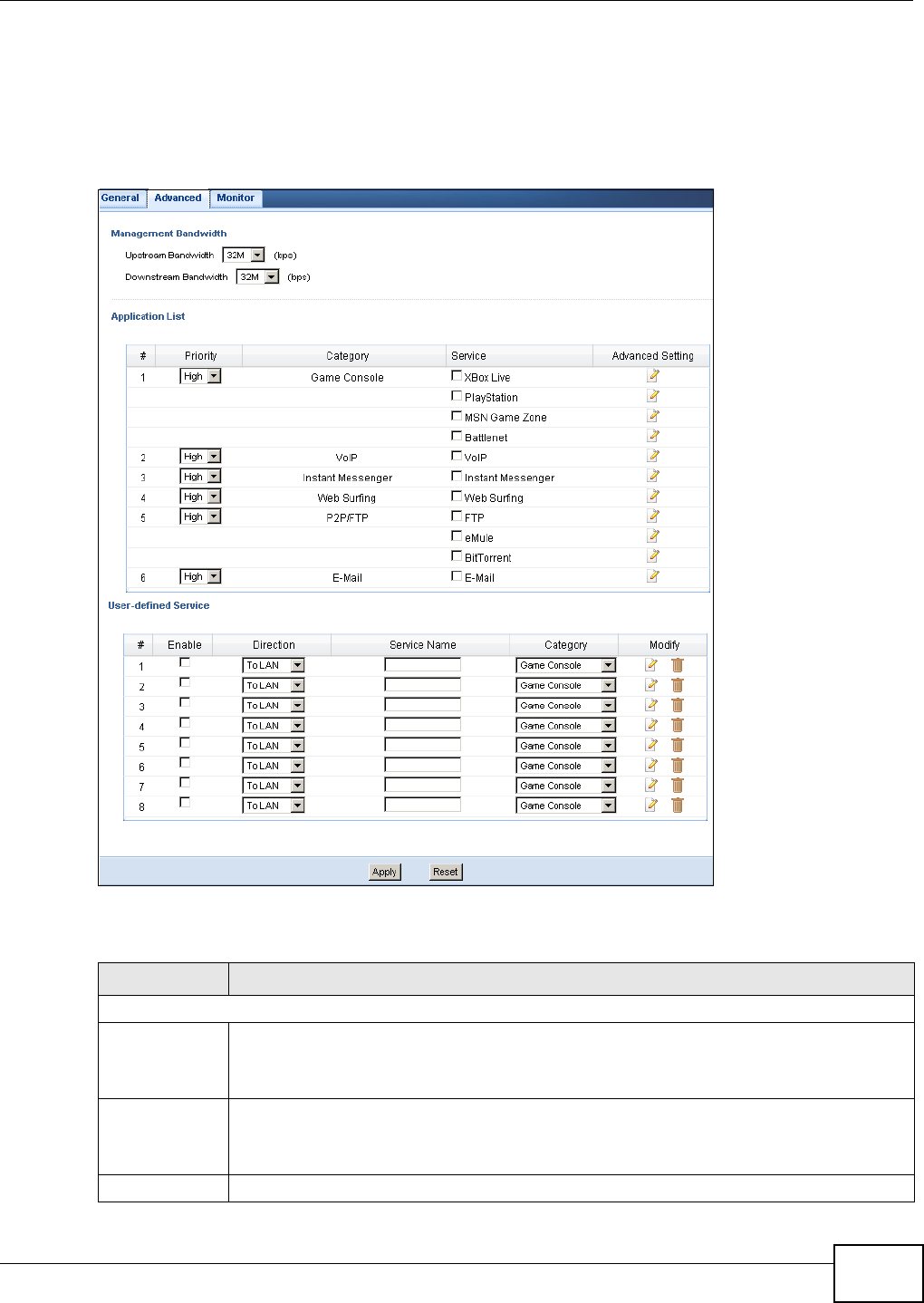
Chapter 23 Bandwidth Management
NBG-419N v2 User’s Guide 165
Note: The two tables shown in this screen can be configured and applied at the same
time.
Click Management > Bandwidth Management > Advanced to open the bandwidth
management Advanced screen.
Figure 114 Management > Bandwidth Management > Advanced
The following table describes the labels in this screen.
Table 72 Management > Bandwidth Management > Advanced
LABEL DESCRIPTION
Management Bandwidth
Upstream
Bandwidth
Select the total amount of bandwidth (from 64 Kilobits to 32 Megabits) that you want to
dedicate to uplink traffic.
This is traffic from LAN/WLAN to WAN.
Downstream
Bandwidth
Select the total amount of bandwidth (from 64 Kilobits to 32 Megabits) that you want to
dedicate to uplink traffic.
This is traffic from WAN to LAN/WLAN.
Application List Use this table to allocate specific amounts of bandwidth based on a pre-defined service.
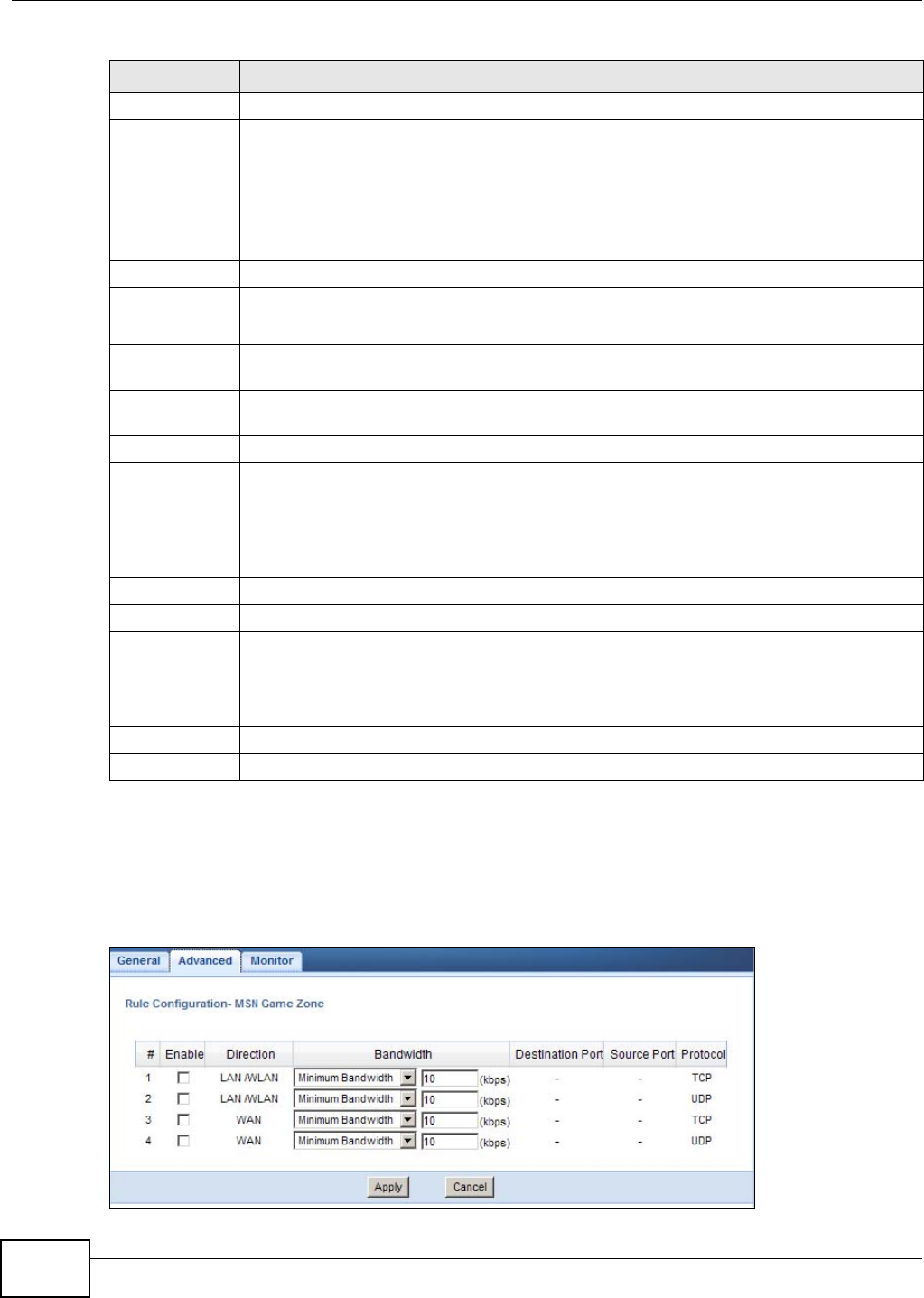
Chapter 23 Bandwidth Management
NBG-419N v2 User’s Guide
166
23.5.1 Rule Configuration: Application Rule Configuration
If you want to edit a bandwidth management rule for a pre-defined service or application, click the
Edit icon in the Application List table of the Advanced screen. The following screen displays.
Figure 115 Bandwidth Management Rule Configuration: Application List
#This is the number of an individual bandwidth management rule.
Priority Select a priority from the drop down list box. Choose High, Mid or Low.
•High - Select this for voice traffic or video that is especially sensitive to jitter (jitter is
the variations in delay).
•Mid - Select this for "excellent effort" or better than best effort and would include
important business traffic that can tolerate some delay.
•Low - Select this for non-critical "background" traffic such as bulk transfers that are
allowed but that should not affect other applications and users.
Category This is the category where a service belongs.
Service This is the name of the service.
Select the check box to have the Router apply this bandwidth management rule.
Advanced
Setting
Click the Edit icon to open the Rule Configuration screen where you can modify the rule.
User-defined
Service
Use this table to allocate specific amounts of bandwidth to specific applications or services
you specify.
#This is the number of an individual bandwidth management rule.
Enable Select this check box to have the Router apply this bandwidth management rule.
Direction Select LAN to apply bandwidth management to traffic from WAN to LAN.
Select WAN to apply bandwidth management to traffic from LAN/WLAN to WAN.
Select WLAN to apply bandwidth management to traffic from WAN to WLAN.
Service Name Enter a descriptive name for the bandwidth management rule.
Category This is the category where a service belongs.
Modify Click the Edit icon to open the Rule Configuration screen. Modify an existing rule or
create a new rule in the Rule Configuration screen. See Section 23.5.2 on page 167 for
more information.
Click the Remove icon to delete a rule.
Apply Click Apply to save your customized settings.
Reset Click Reset to begin configuring this screen afresh.
Table 72 Management > Bandwidth Management > Advanced (continued)
LABEL DESCRIPTION
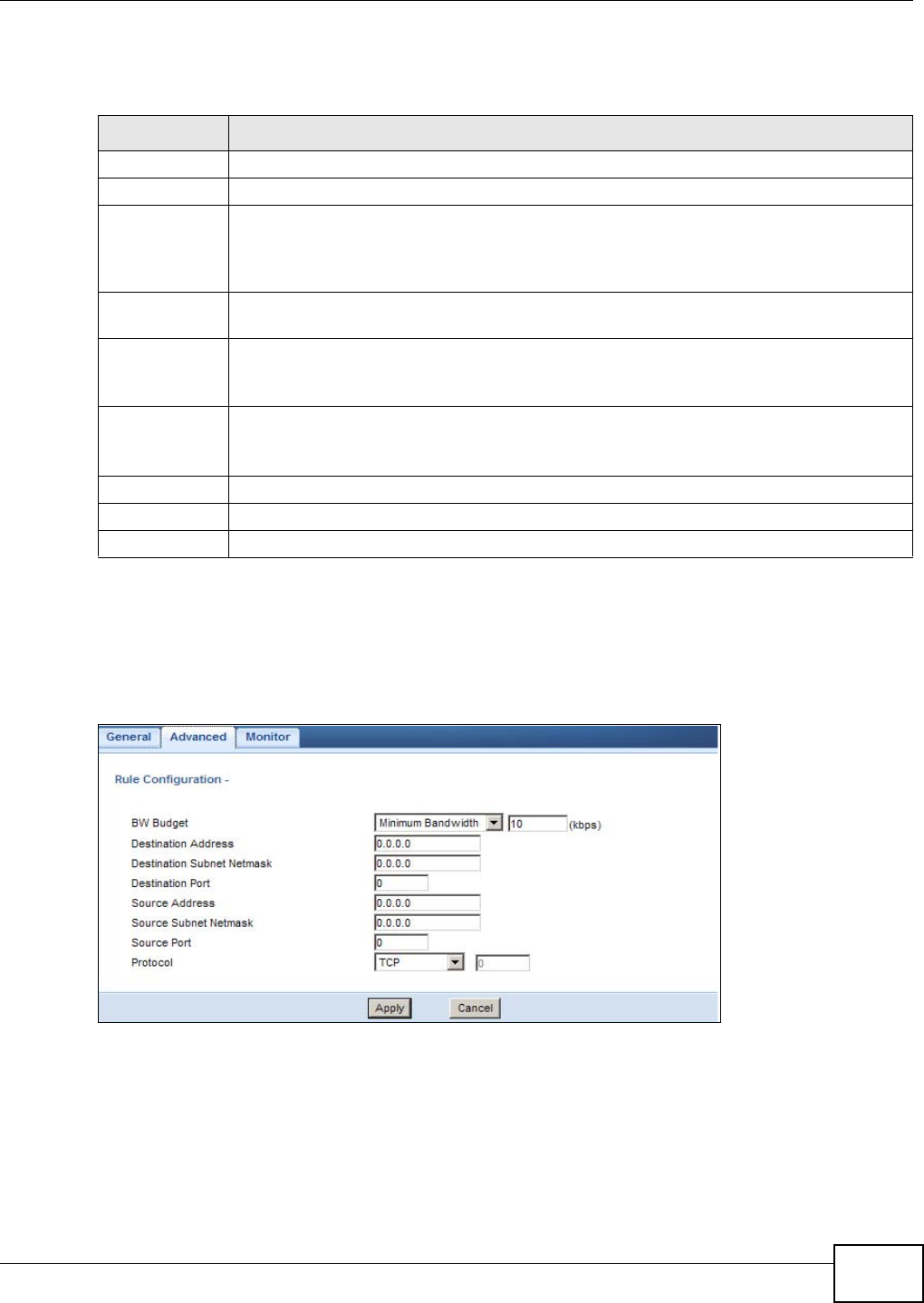
Chapter 23 Bandwidth Management
NBG-419N v2 User’s Guide 167
The following table describes the labels in this screen.
23.5.2 Rule Configuration: User Defined Service Rule Configuration
If you want to edit a bandwidth management rule for other applications or services, click the Edit
icon in the User-defined Service table of the Advanced screen. The following screen displays.
Figure 116 Bandwidth Management Rule Configuration: User-defined Service
The following table describes the labels in this screen
Table 73 Bandwidth Management Rule Configuration: Application List
LABEL DESCRIPTION
#This is the number of an individual bandwidth management rule.
Enable Select an interface’s check box to enable bandwidth management on that interface.
Direction These read-only labels represent the physical interfaces. Bandwidth management applies to
all traffic flowing out of the router through the interface, regardless of the traffic’s source.
Traffic redirect or IP alias may cause LAN-to-LAN traffic to pass through the Router and be
managed by bandwidth management.
Bandwidth Select Maximum Bandwidth or Minimum Bandwidth and specify the maximum or
minimum bandwidth allowed for the rule in kilobits per second.
Destination Port This is the port number of the destination that define the traffic type, for example TCP port
80 defines web traffic.
See Appendix E on page 263 for some common services and port numbers.
Source Port This is the port number of the source that define the traffic type, for example TCP port 80
defines web traffic.
See Appendix E on page 263 for some common services and port numbers.
Protocol This is the protocol (TCP, UDP or user-defined) used for the service.
Apply Click Apply to save your customized settings.
Cancel Click Cancel to exit this screen without saving.

Chapter 23 Bandwidth Management
NBG-419N v2 User’s Guide
168
Table 74 Bandwidth Management Rule Configuration: User-defined Service
See Appendix E on page 263 for commonly used services and port numbers.
23.6 Monitor Screen
Use this screen to view the amount of network bandwidth that applications running in the network
are using.
The bandwidth is measured in kilobits per second (kbps).
LABEL DESCRIPTION
BW Budget Select Maximum Bandwidth or Minimum Bandwidth and specify the maximum or
minimum bandwidth allowed for the rule in kilobits per second.
Destination
Address
Enter the IP address of the destination computer.
The Router applies bandwidth management to the service or application that is entering this
computer.
Destination
Subnet
Netmask
Enter the subnet netmask of the destination of the traffic for which the bandwidth
management rule applies.
Destination
Port
This is the port number of the destination that define the traffic type, for example TCP port
80 defines web traffic.
Source Address Enter the IP address of the computer that initializes traffic for the application or service.
The Router applies bandwidth management to traffic initiating from this computer.
Source Subnet
Netmask
Enter the subnet netmask of the computer initiating the traffic for which the bandwidth
management rule applies.
Source Port This is the port number of the source that define the traffic type, for example TCP port 80
defines web traffic.
Protocol Select the protocol (TCP, UDP, User defined) for which the bandwidth management rule
applies.
If you select User-defined, enter the protocol for which the bandwidth management rule
applies. For example, ICMP for ping traffic.
Apply Click Apply to save your customized settings.
Cancel Click Cancel to exit this screen without saving.
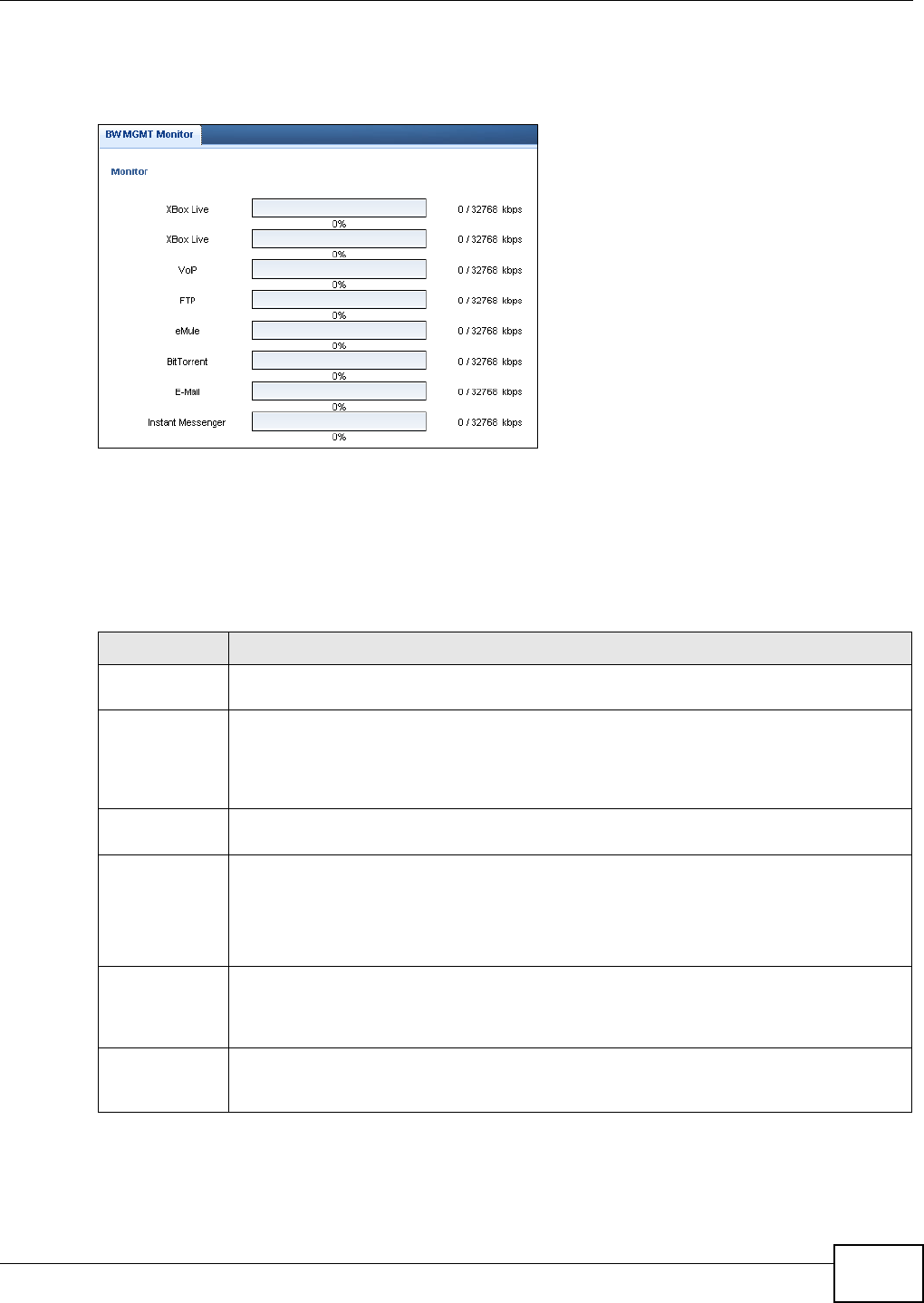
Chapter 23 Bandwidth Management
NBG-419N v2 User’s Guide 169
The monitor shows what kinds of applications are running in the network, the maximum kbps that
each application can use, as well as the percentage of bandwidth it is using.
Figure 117 Management > Bandwidth Management > Monitor
23.6.1 Predefined Bandwidth Management Services
The following is a description of some services that you can select and to which you can apply
media bandwidth management in the Management > Bandwidth Management > Advanced
screen.
Table 75 Media Bandwidth Management Setup: Services
SERVICE DESCRIPTION
FTP File Transfer Program enables fast transfer of files, including large files that may not be
possible by e-mail.
WWW The World Wide Web (WWW) is an Internet system to distribute graphical, hyper-linked
information, based on Hyper Text Transfer Protocol (HTTP) - a client/server protocol for the
World Wide Web. The Web is not synonymous with the Internet; rather, it is just one service
on the Internet. Other services on the Internet include Internet Relay Chat and
Newsgroups. The Web is accessed through use of a browser.
E-Mail Electronic mail consists of messages sent through a computer network to specific groups or
individuals. Here are some default ports for e-mail:
VoIP (SIP) Sending voice signals over the Internet is called Voice over IP or VoIP. Session Initiated
Protocol (SIP) is an internationally recognized standard for implementing VoIP. SIP is an
application-layer control (signaling) protocol that handles the setting up, altering and
tearing down of voice and multimedia sessions over the Internet.
SIP is transported primarily over UDP but can also be transported over TCP.
BitTorrent BitTorrent is a free P2P (peer-to-peer) sharing tool allowing you to distribute large software
and media files. BitTorrent requires you to search for a file with a searching engine yourself.
It distributes files by corporation and trading, that is, the client downloads the file in small
pieces and share the pieces with other peers to get other half of the file.
Gaming Online gaming services lets you play multiplayer games on the Internet via broadband
technology. As of this writing, your Router supports Xbox, Playstation, Battlenet and MSN
Game Zone.

NBG-419N v2 User’s Guide 170
CHAPTER 24
Remote Management
24.1 Overview
This chapter provides information on the Remote Management screens.
Remote Management allows you to manage your Router from a remote location through the
following interfaces:
•LAN and WAN
•LAN only
•WAN only
Note: The Router is managed using the Web Configurator.
24.2 What You Can Do
Use the WWW screen (Section 24.4 on page 171) to define the interface/s from which the Router
can be managed remotely and specify a secure client that can manage the Router.
24.3 What You Need to Know
Remote management over LAN or WAN will not work when:
1The IP address in the Secured Client IP Address field (Section 24.4 on page 171) does not
match the client IP address. If it does not match, the Router will disconnect the session
immediately.
2There is already another remote management session. You may only have one remote
management session running at one time.
3There is a firewall rule that blocks it.
24.3.1 Remote Management and NAT
When NAT is enabled:
• Use the Router’s WAN IP address when configuring from the WAN.
• Use the Router’s LAN IP address when configuring from the LAN.
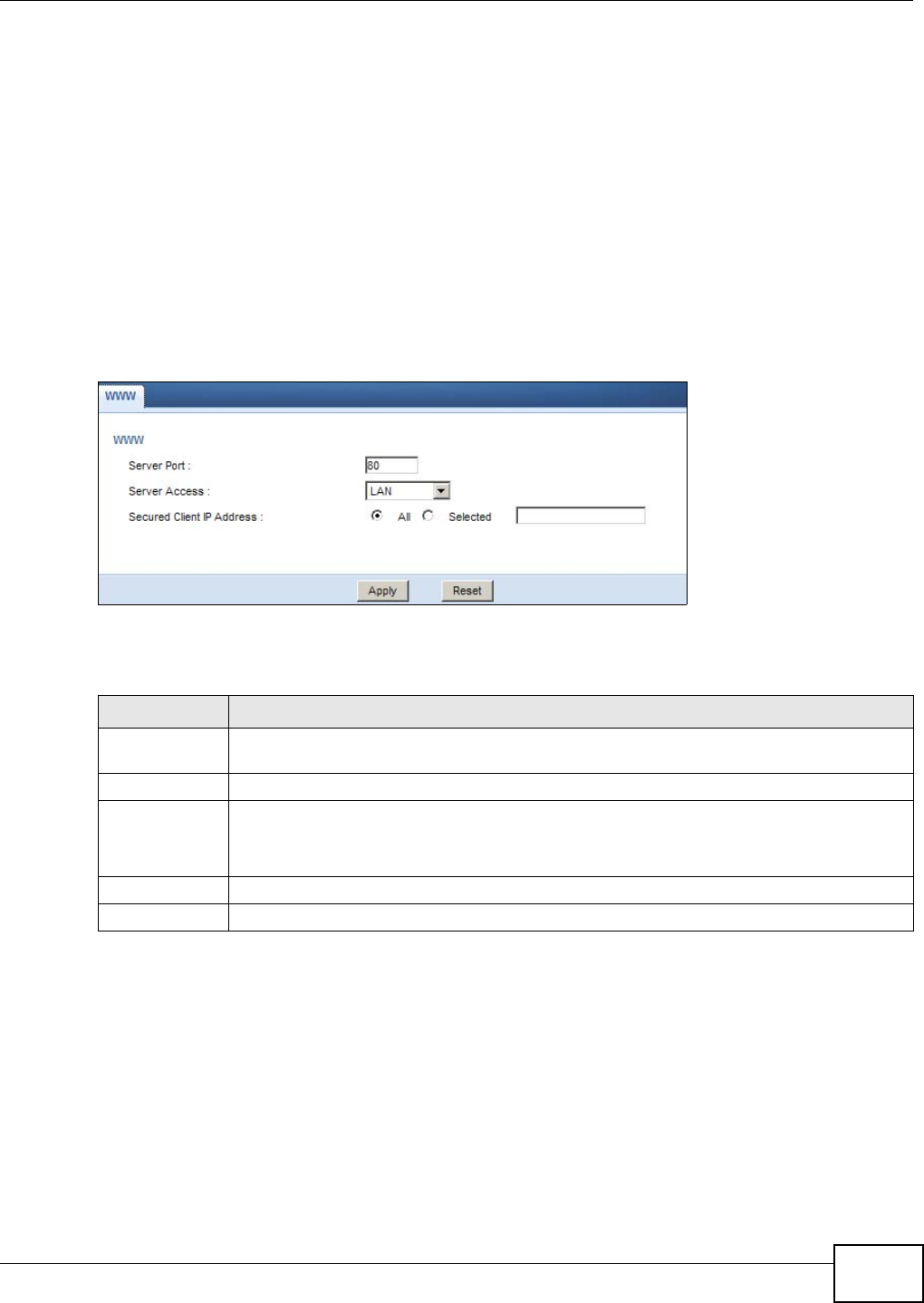
Chapter 24 Remote Management
NBG-419N v2 User’s Guide 171
24.3.2 System Timeout
There is a default system management idle timeout of five minutes (three hundred seconds). The
Router automatically logs you out if the management session remains idle for longer than this
timeout period. The management session does not time out when a statistics screen is polling. You
can change the timeout period in the System screen
24.4 WWW Screen
To change your Router’s remote management settings, click Management > Remote
Management > WWW.
Figure 118 Management > Remote Management > WWW
The following table describes the labels in this screen
Table 76 Management > Remote Management > WWW
LABEL DESCRIPTION
Server Port You may change the server port number for a service if needed, however you must use the
same port number in order to use that service for remote management.
Server Access Select the interface(s) through which a computer may access the Router using this service.
Secured Client
IP Address
Select All to allow all computes to access the Router.
Otherwise, check Selected and specify the IP address of the computer that can access the
Router.
Apply Click Apply to save your customized settings and exit this screen.
Reset Click Reset to begin configuring this screen afresh.

Chapter 24 Remote Management
NBG-419N v2 User’s Guide
172

NBG-419N v2 User’s Guide 173
CHAPTER 25
Universal Plug-and-Play (UPnP)
25.1 Overview
This chapter introduces the UPnP feature in the web configurator.
Universal Plug and Play (UPnP) is a distributed, open networking standard that uses TCP/IP for
simple peer-to-peer network connectivity between devices. A UPnP device can dynamically join a
network, obtain an IP address, convey its capabilities and learn about other devices on the network.
In turn, a device can leave a network smoothly and automatically when it is no longer in use.
25.2 What You Can Do
Use the UPnP screen (Section 25.4 on page 174) to enable UPnP on your Router.
25.3 What You Need to Know
UPnP hardware is identified as an icon in the Network Connections folder (Windows XP). Each UPnP
compatible device installed on your network will appear as a separate icon. Selecting the icon of a
UPnP device will allow you to access the information and properties of that device.
25.3.1 NAT Traversal
UPnP NAT traversal automates the process of allowing an application to operate through NAT. UPnP
network devices can automatically configure network addressing, announce their presence in the
network to other UPnP devices and enable exchange of simple product and service descriptions.
NAT traversal allows the following:
• Dynamic port mapping
• Learning public IP addresses
• Assigning lease times to mappings
Windows Messenger is an example of an application that supports NAT traversal and UPnP.
See the NAT chapter for more information on NAT.
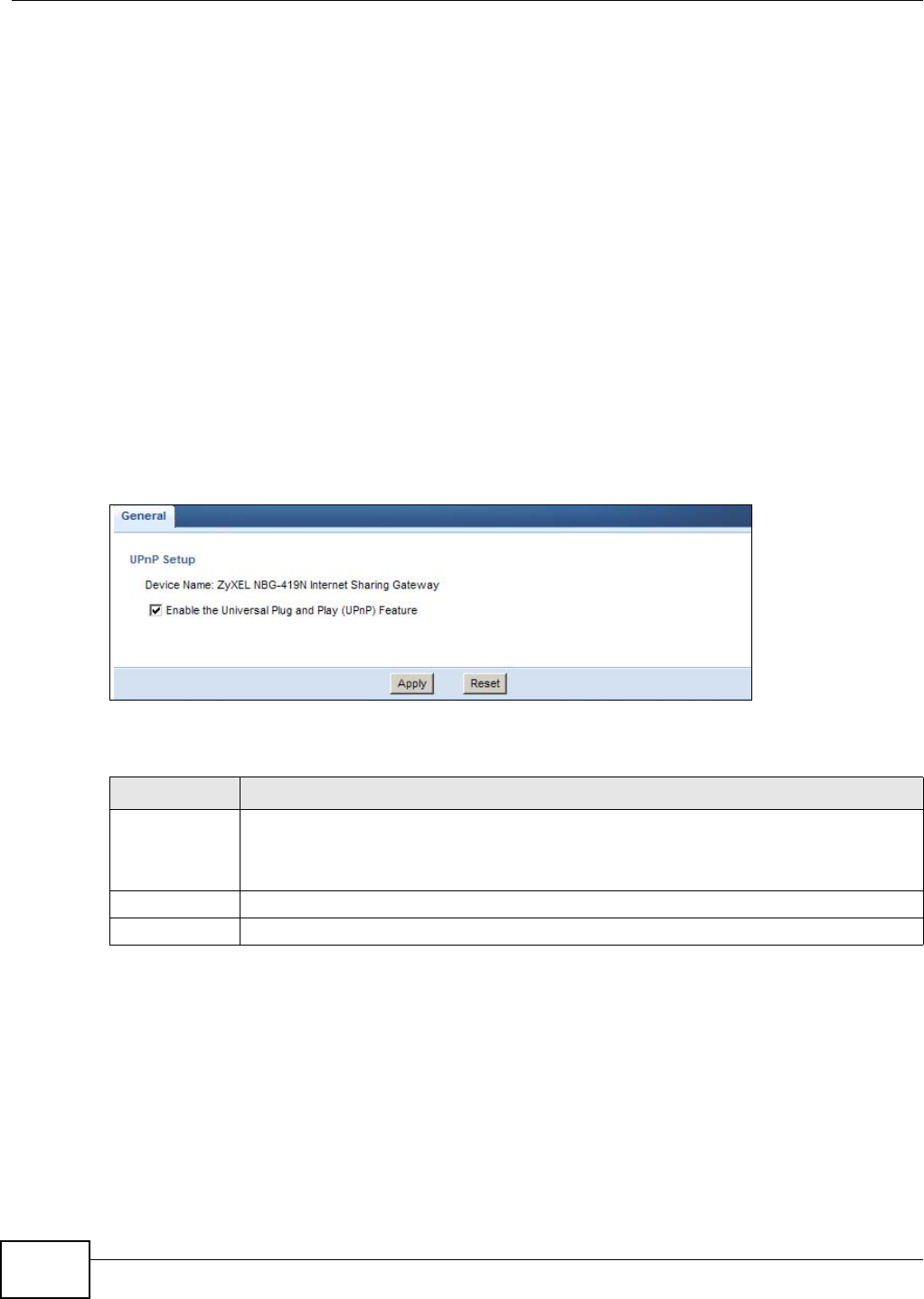
Chapter 25 Universal Plug-and-Play (UPnP)
NBG-419N v2 User’s Guide
174
25.3.2 Cautions with UPnP
The automated nature of NAT traversal applications in establishing their own services and opening
firewall ports may present network security issues. Network information and configuration may also
be obtained and modified by users in some network environments.
When a UPnP device joins a network, it announces its presence with a multicast message. For
security reasons, the Router allows multicast messages on the LAN only.
All UPnP-enabled devices may communicate freely with each other without additional configuration.
Disable UPnP if this is not your intention.
25.4 UPnP Screen
Use this screen to enable UPnP on your Router.
Click Management > UPnP to display the screen shown next.
Figure 119 Management > UPnP
The following table describes the fields in this screen.
25.5 Technical Refereance
The sections show examples of using UPnP.
25.5.1 Using UPnP in Windows XP Example
This section shows you how to use the UPnP feature in Windows XP. You must already have UPnP
installed in Windows XP and UPnP activated on the Router.
Table 77 Management > UPnP
LABEL DESCRIPTION
Enable the
Universal Plug
and Play
(UPnP) Feature
Select this check box to activate UPnP. Be aware that anyone could use a UPnP application
to open the web configurator's login screen without entering the Router's IP address
(although you must still enter the password to access the web configurator).
Apply Click Apply to save the setting to the Router.
Reset Click Reset to return to the previously saved settings.
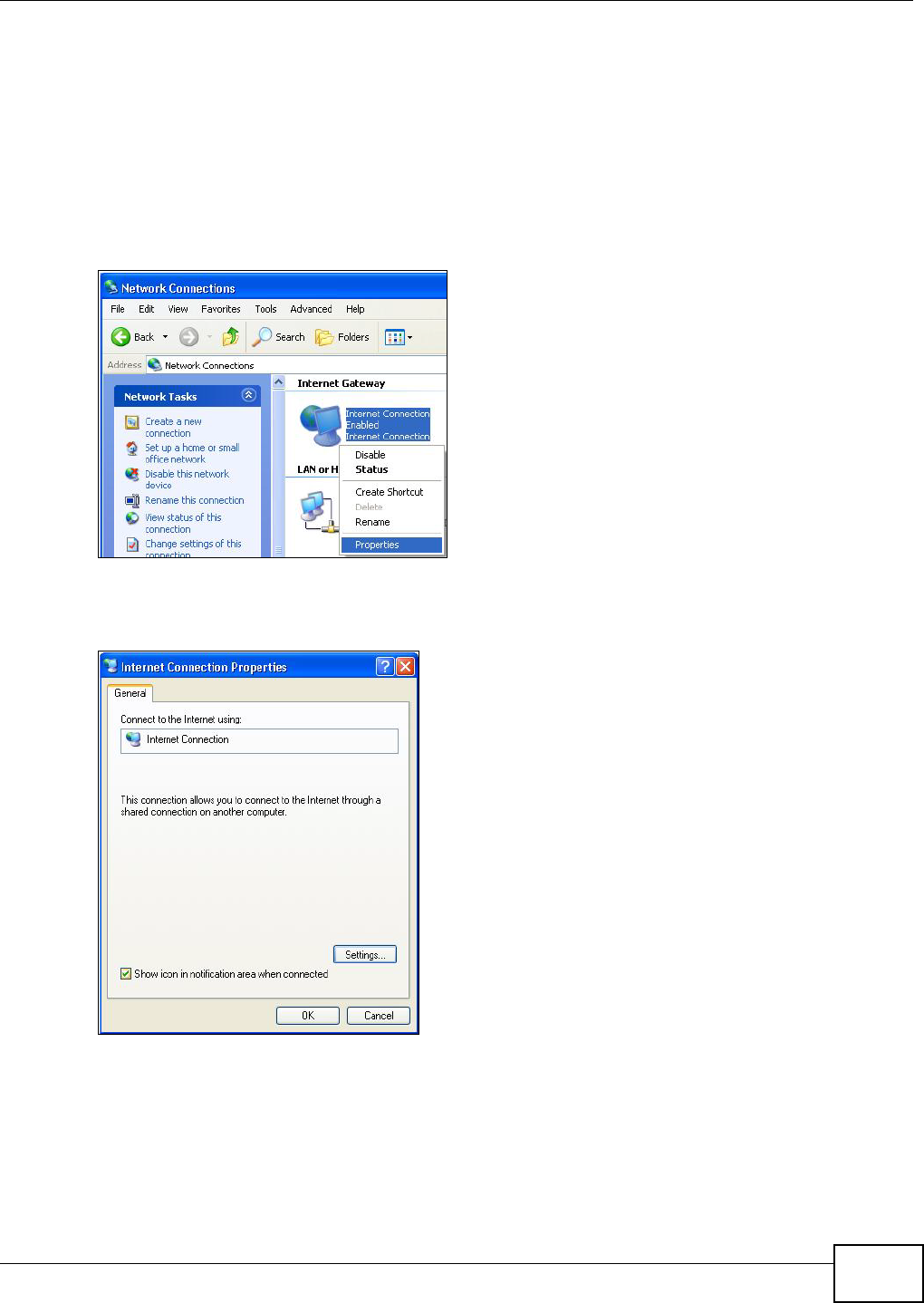
Chapter 25 Universal Plug-and-Play (UPnP)
NBG-419N v2 User’s Guide 175
Make sure the computer is connected to a LAN port of the Router. Turn on your computer and the
Router.
25.5.1.1 Auto-discover Your UPnP-enabled Network Device
1Click start and Control Panel. Double-click Network Connections. An icon displays under
Internet Gateway.
2Right-click the icon and select Properties.
Figure 120 Network Connections
3In the Internet Connection Properties window, click Settings to see the port mappings there
were automatically created.
Figure 121 Internet Connection Properties
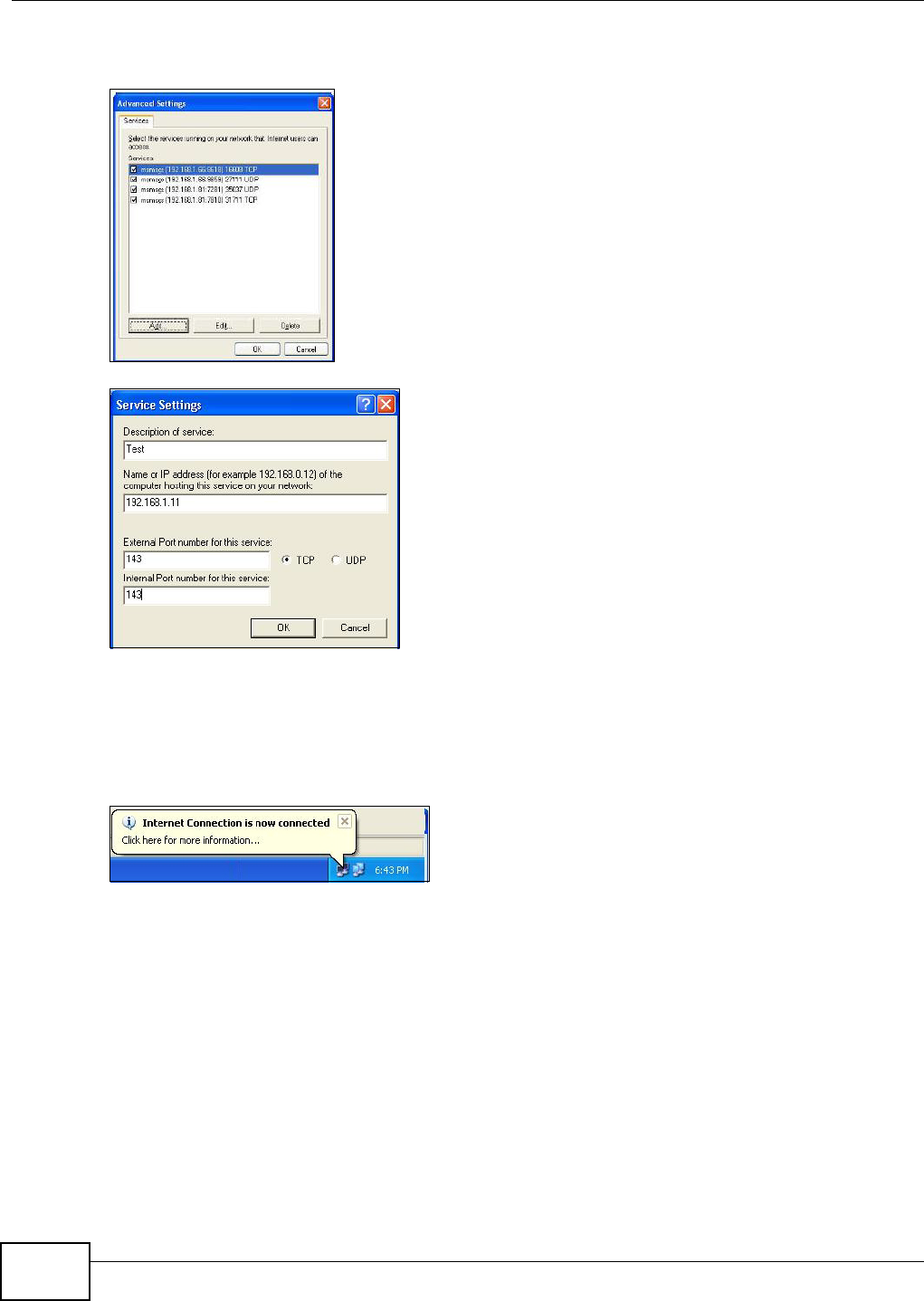
Chapter 25 Universal Plug-and-Play (UPnP)
NBG-419N v2 User’s Guide
176
4You may edit or delete the port mappings or click Add to manually add port mappings.
Figure 122 Internet Connection Properties: Advanced Settings
Figure 123 Internet Connection Properties: Advanced Settings: Add
Note: When the UPnP-enabled device is disconnected from your computer, all port
mappings will be deleted automatically.
5Select Show icon in notification area when connected option and click OK. An icon displays in
the system tray.
Figure 124 System Tray Icon
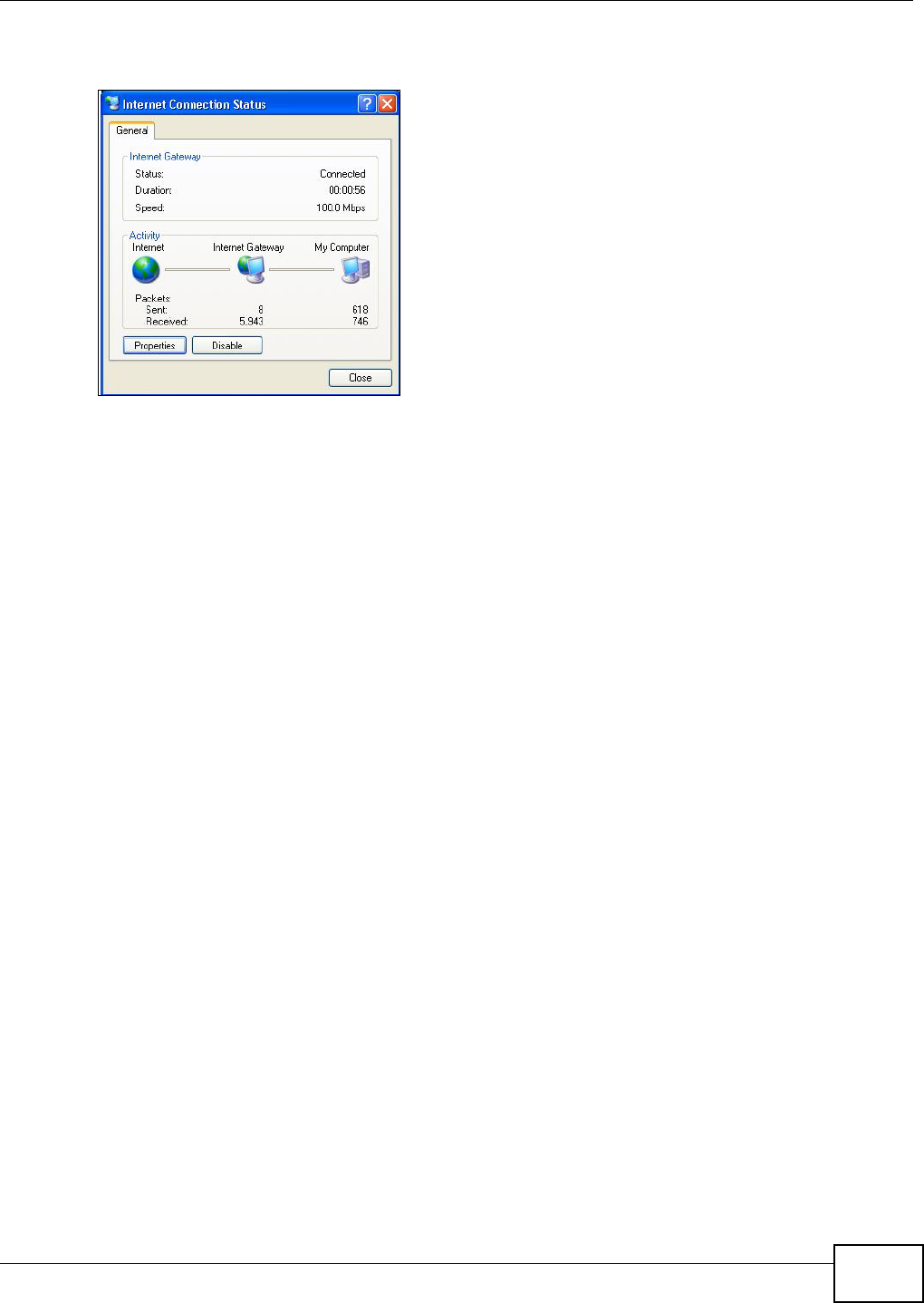
Chapter 25 Universal Plug-and-Play (UPnP)
NBG-419N v2 User’s Guide 177
6Double-click on the icon to display your current Internet connection status.
Figure 125 Internet Connection Status
25.5.2 Web Configurator Easy Access
With UPnP, you can access the web-based configurator on the Router without finding out the IP
address of the Router first. This comes helpful if you do not know the IP address of the Router.
Follow the steps below to access the web configurator.
1Click Start and then Control Panel.
2Double-click Network Connections.
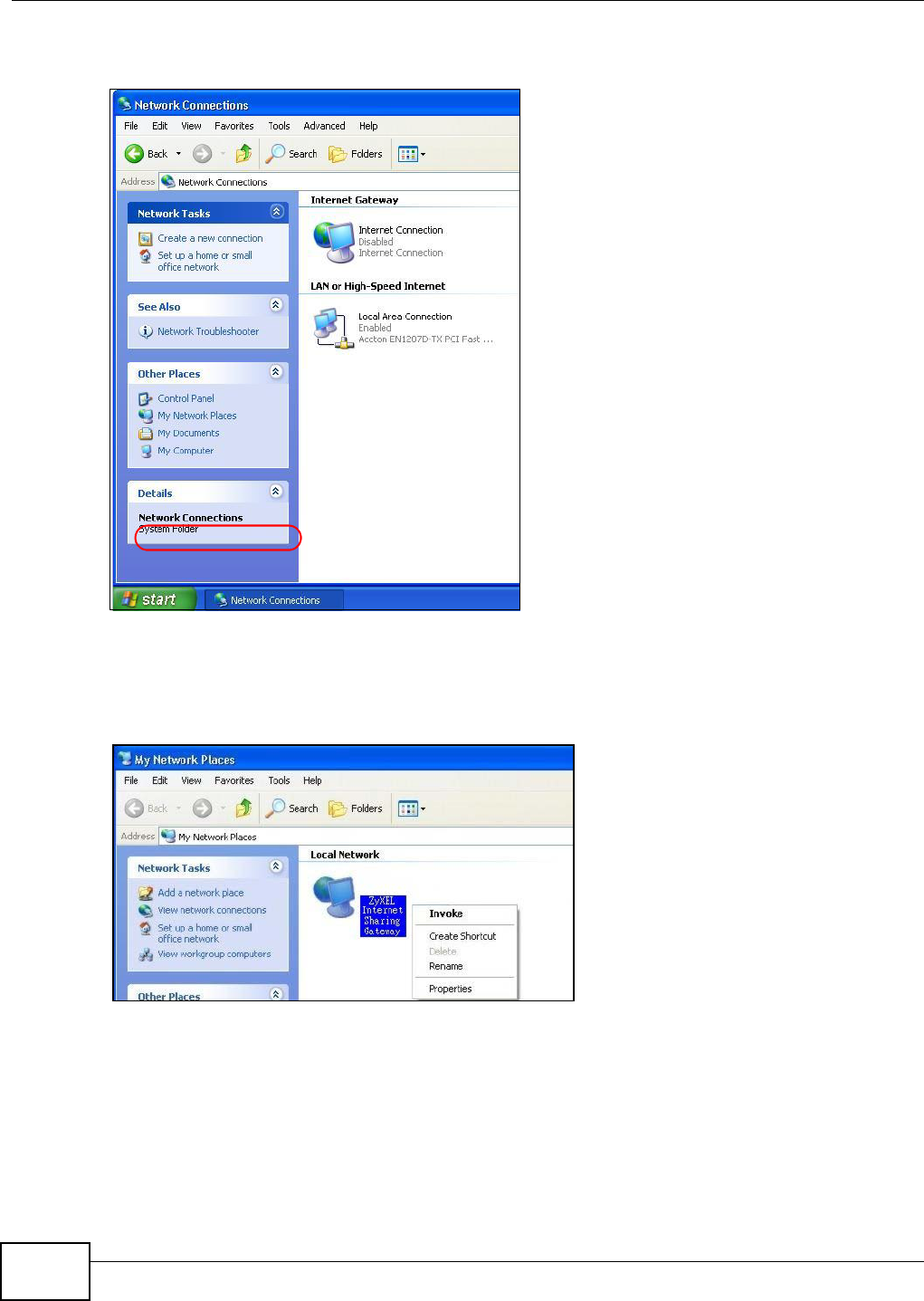
Chapter 25 Universal Plug-and-Play (UPnP)
NBG-419N v2 User’s Guide
178
3Select My Network Places under Other Places.
Figure 126 Network Connections
4An icon with the description for each UPnP-enabled device displays under Local Network.
5Right-click on the icon for your Router and select Invoke. The web configurator login screen
displays.
Figure 127 Network Connections: My Network Places
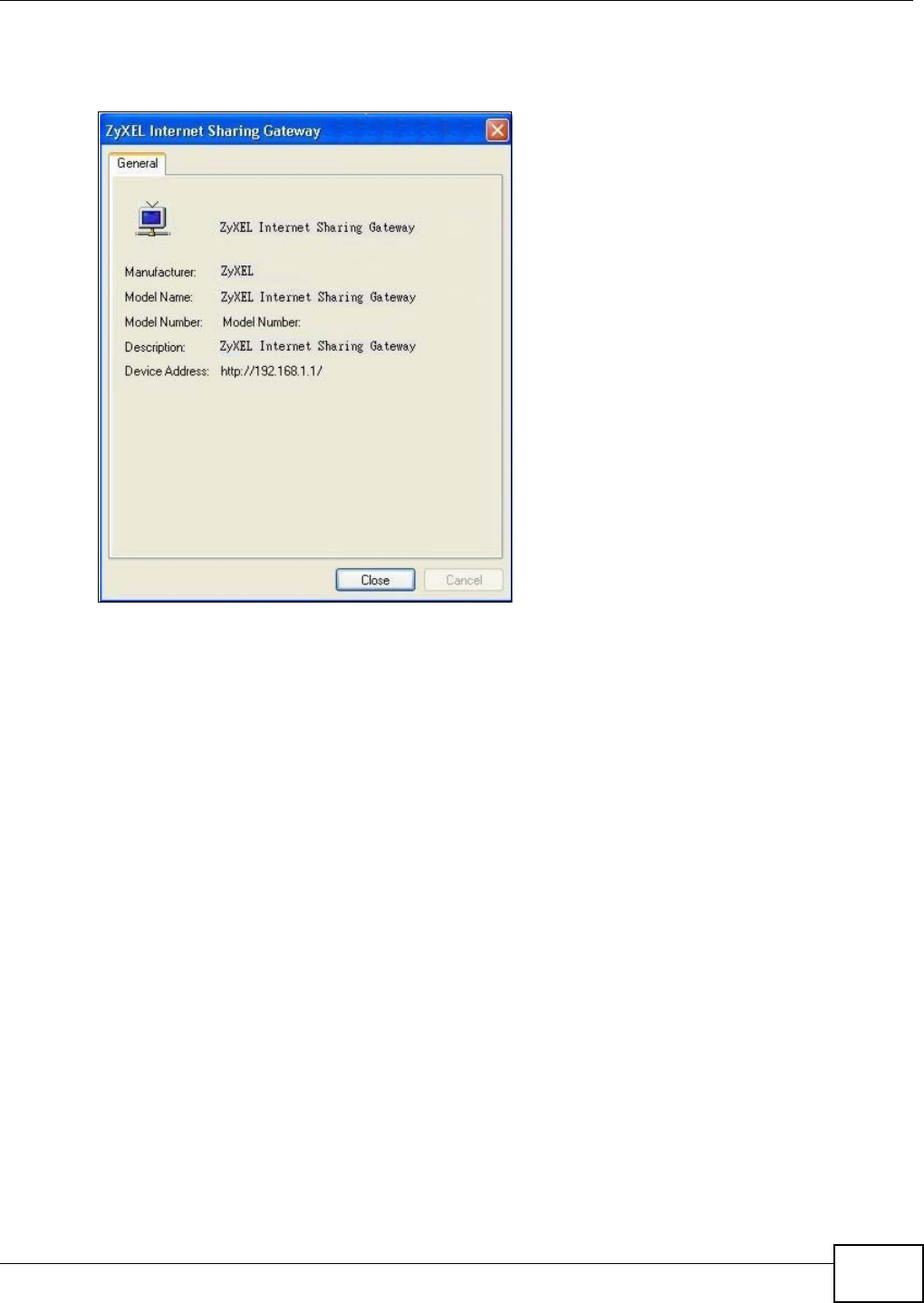
Chapter 25 Universal Plug-and-Play (UPnP)
NBG-419N v2 User’s Guide 179
6Right-click on the icon for your Router and select Properties. A properties window displays with
basic information about the Router.
Figure 128 Network Connections: My Network Places: Properties: Example

Chapter 25 Universal Plug-and-Play (UPnP)
NBG-419N v2 User’s Guide
180
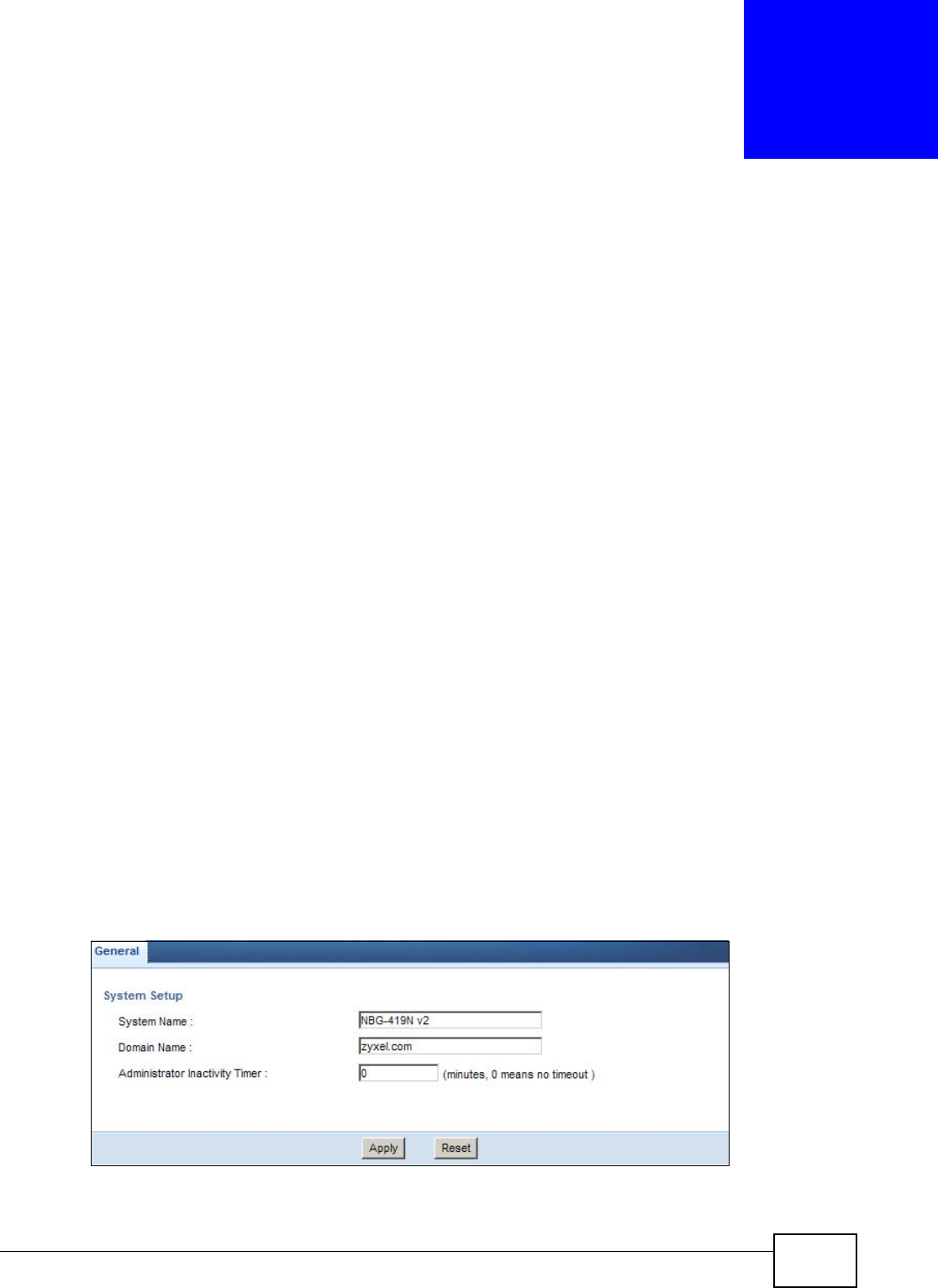
NBG-419N v2 User’s Guide 181
CHAPTER 26
Maintenance
26.1 Overview
This chapter provides information on the Maintenance screens.
26.2 What You Can Do
•Use the General screen to configure system and domain name. You can also set the timeout
period of the management session (Section 26.3 on page 181).
•Use the Password screen to change your Router’s system password (Section 26.4 on page 182).
•Use the Time screen to change your Router’s time and date (Section 26.5 on page 183).
•Use the Firmware Upgrade screen to upload firmware to your Router (Section 26.6 on page
184).
•Use the Backup/Restore screen to view information related to factory defaults, backup
configuration, and restoring configuration (Section 26.8 on page 187).
•Use the Reset/Restart screen to reboot the Router without turning the power off (Section 26.8
on page 187).
•Use the Sys OP Mode screen to select how you want to use your Router (Section 26.10 on page
189).
26.3 General Screen
Use this screen to set the configure system and domain name as well as management session
timeout period. Click Maintenance > General. The following screen displays.
Figure 129 Maintenance > General
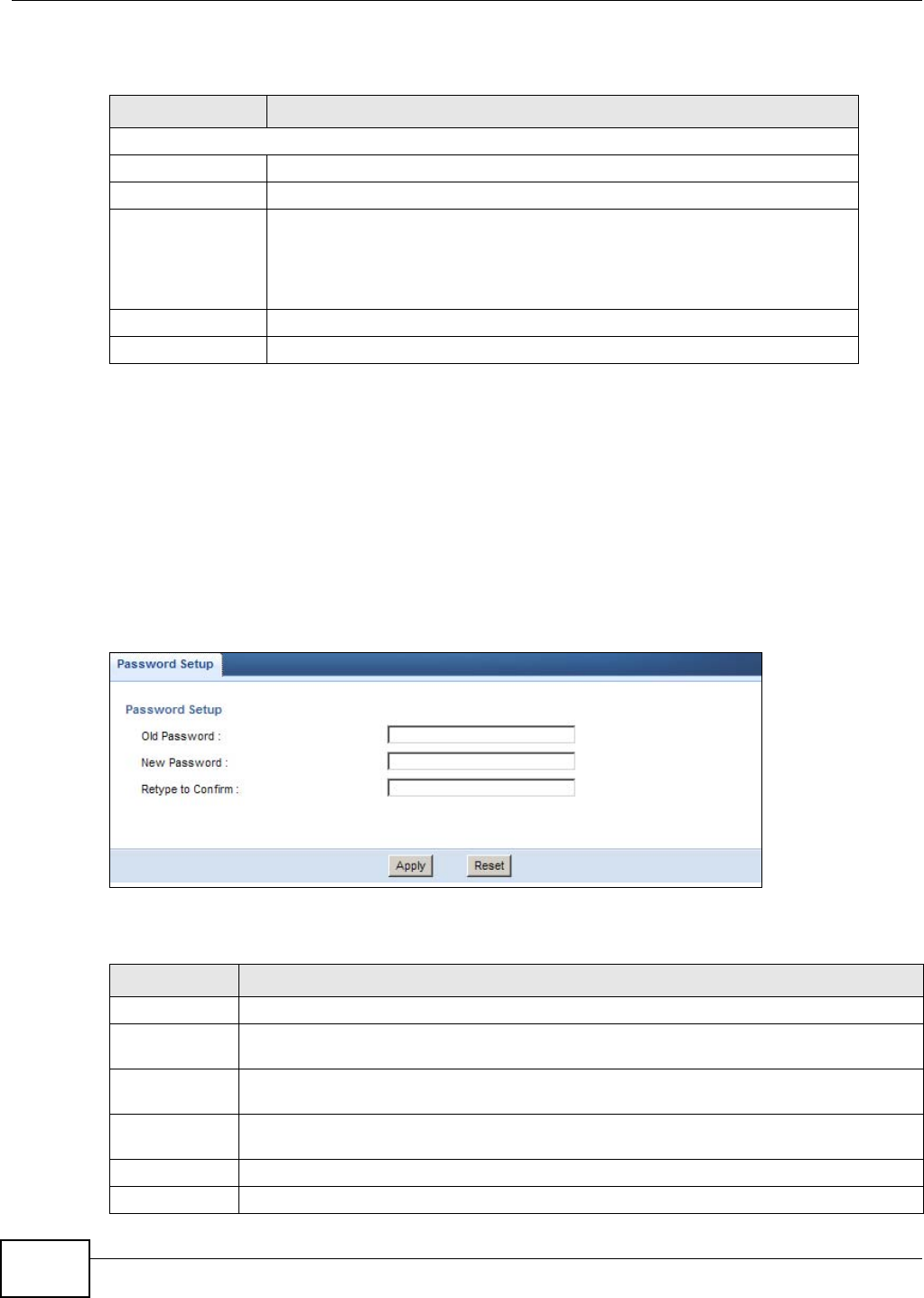
Chapter 26 Maintenance
NBG-419N v2 User’s Guide
182
The following table describes the labels in this screen.
26.4 Password Screen
It is strongly recommended that you change your Router's password.
If you forget your Router's password (or IP address), you will need to reset the device. See Section
26.8 on page 187 for details.
Click Maintenance > Password. The screen appears as shown.
Figure 130 Maintenance > Password
The following table describes the labels in this screen.
Table 78 Maintenance > General
LABEL DESCRIPTION
System Setup
System Name System Name is a unique name to identify the Router in an Ethernet network.
Domain Name Enter the domain name you want to give to the Router.
Administrator
Inactivity Timer
Type how many minutes a management session can be left idle before the
session times out. The default is 5 minutes. After it times out you have to log in
with your password again. Very long idle timeouts may have security risks. A
value of "0" means a management session never times out, no matter how long
it has been left idle (not recommended).
Apply Click Apply to save your changes back to the Router.
Cancel Click Cancel to begin configuring this screen afresh.
Table 79 Maintenance > Password
LABEL DESCRIPTION
Password Setup Change your Router’s password (recommended) using the fields as shown.
Old Password Type the default password or the existing password you use to access the system in this
field.
New Password Type your new system password (up to 30 characters). Note that as you type a password,
the screen displays an asterisk (*) for each character you type.
Retype to
Confirm
Type the new password again in this field.
Apply Click Apply to save your changes back to the Router.
Reset Click Reset to begin configuring this screen afresh.
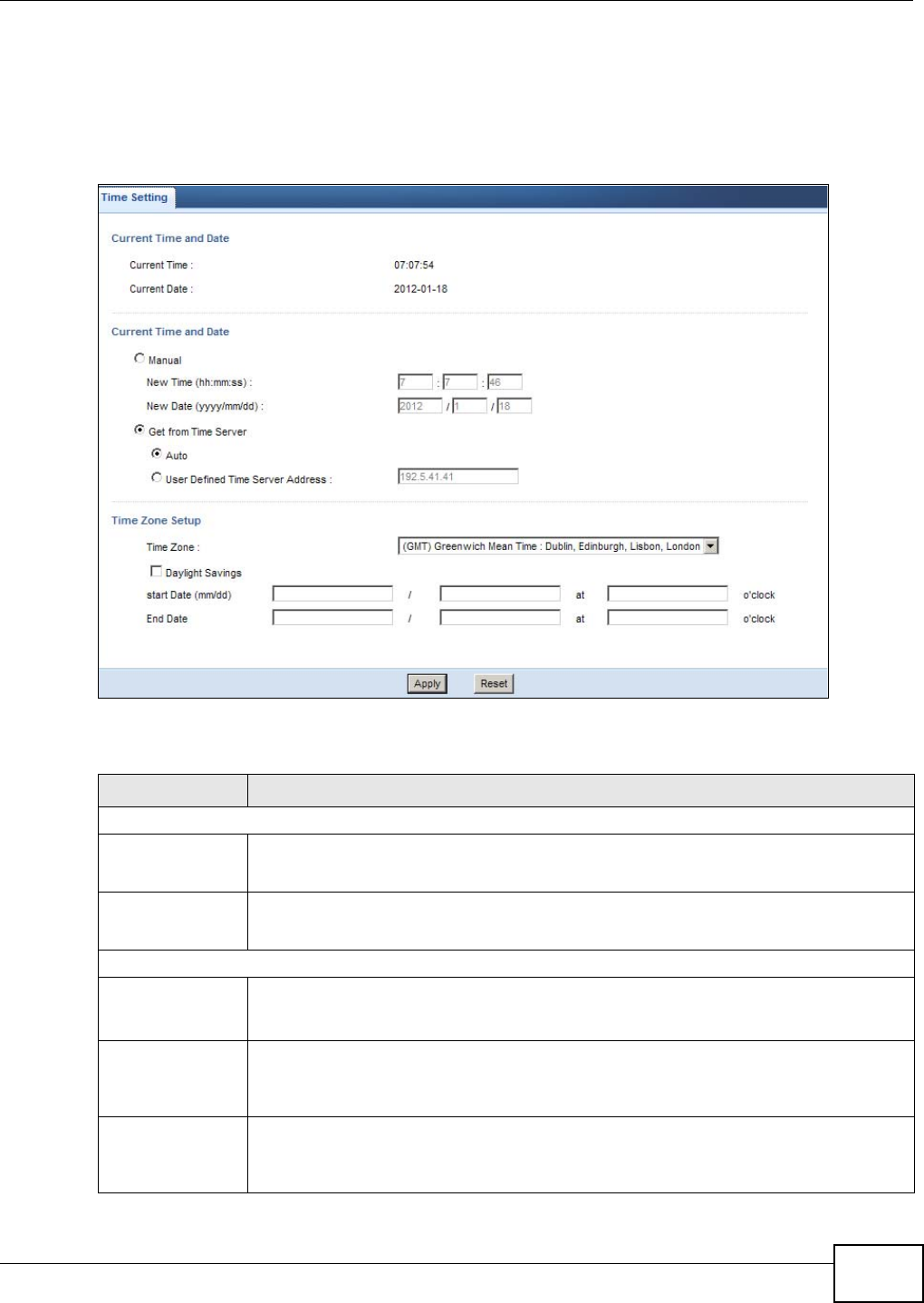
Chapter 26 Maintenance
NBG-419N v2 User’s Guide 183
26.5 Time Setting Screen
Use this screen to configure the Router’s time based on your local time zone. To change your
Router’s time and date, click Maintenance > Time. The screen appears as shown.
Figure 131 Maintenance > Time
The following table describes the labels in this screen.
Table 80 Maintenance > Time
LABEL DESCRIPTION
Current Time and Date
Current Time This field displays the time of your Router.
Each time you reload this page, the Router synchronizes the time with the time server.
Current Date This field displays the date of your Router.
Each time you reload this page, the Router synchronizes the date with the time server.
Current Time and Date
Manual Select this radio button to enter the time and date manually. If you configure a new time
and date, Time Zone and Daylight Saving at the same time, the new time and date you
entered has priority and the Time Zone and Daylight Saving settings do not affect it.
New Time
(hh:mm:ss)
This field displays the last updated time from the time server or the last time configured
manually.
When you select Manual, enter the new time in this field and then click Apply.
New Date
(yyyy/mm/dd)
This field displays the last updated date from the time server or the last date configured
manually.
When you select Manual, enter the new date in this field and then click Apply.

Chapter 26 Maintenance
NBG-419N v2 User’s Guide
184
26.6 Firmware Upgrade Screen
Find firmware at www.zyxel.com in a file that (usually) uses the system model name with a “*.bin”
extension, e.g., “Router.bin”. The upload process uses HTTP (Hypertext Transfer Protocol) and may
take up to two minutes. After a successful upload, the system will reboot.
Get from Time
Server
Select this radio button to have the Router get the time and date from the time server
you specified below.
Auto Select Auto to have the Router automatically search for an available time server and
synchronize the date and time with the time server after you click Apply.
User Defined Time
Server Address
Select User Defined Time Server Address and enter the IP address or URL (up to 20
extended ASCII characters in length) of your time server. Check with your ISP/network
administrator if you are unsure of this information.
Time Zone Setup
Time Zone Choose the time zone of your location. This will set the time difference between your time
zone and Greenwich Mean Time (GMT).
Daylight Savings Daylight saving is a period from late spring to early fall when many countries set their
clocks ahead of normal local time by one hour to give more daytime light in the evening.
Select this option if you use Daylight Saving Time.
Start Date Configure the day and time when Daylight Saving Time starts if you selected Daylight
Savings. The o'clock field uses the 24 hour format. Here are a couple of examples:
Daylight Saving Time starts in most parts of the United States on the first Sunday of
April. Each time zone in the United States starts using Daylight Saving Time at 2 A.M.
local time. So in the United States you would select First, Sunday, April and type 2 in
the o'clock field.
Daylight Saving Time starts in the European Union on the last Sunday of March. All of the
time zones in the European Union start using Daylight Saving Time at the same moment
(1 A.M. GMT or UTC). So in the European Union you would select Last, Sunday, March.
The time you type in the o'clock field depends on your time zone. In Germany for
instance, you would type 2 because Germany's time zone is one hour ahead of GMT or
UTC (GMT+1).
End Date Configure the day and time when Daylight Saving Time ends if you selected Daylight
Savings. The o'clock field uses the 24 hour format. Here are a couple of examples:
Daylight Saving Time ends in the United States on the last Sunday of October. Each time
zone in the United States stops using Daylight Saving Time at 2 A.M. local time. So in the
United States you would select Last, Sunday, October and type 2 in the o'clock field.
Daylight Saving Time ends in the European Union on the last Sunday of October. All of the
time zones in the European Union stop using Daylight Saving Time at the same moment
(1 A.M. GMT or UTC). So in the European Union you would select Last, Sunday,
October. The time you type in the o'clock field depends on your time zone. In Germany
for instance, you would type 2 because Germany's time zone is one hour ahead of GMT or
UTC (GMT+1).
Apply Click Apply to save your changes back to the Router.
Cancel Click Cancel to begin configuring this screen afresh.
Table 80 Maintenance > Time (continued)
LABEL DESCRIPTION
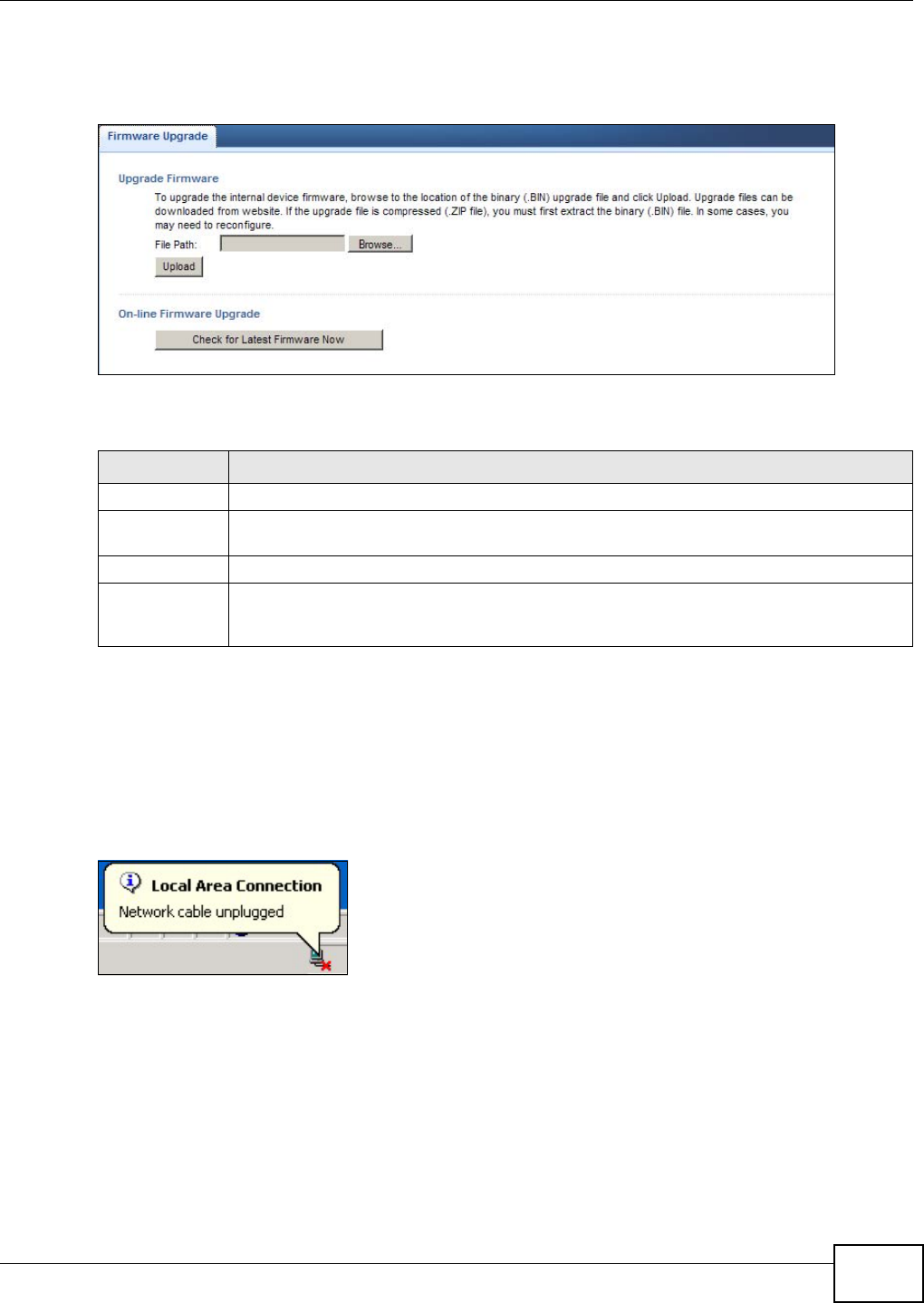
Chapter 26 Maintenance
NBG-419N v2 User’s Guide 185
Click Maintenance > Firmware Upgrade. Follow the instructions in this screen to upload
firmware to your Router.
Figure 132 Maintenance > Firmware Upgrade
The following table describes the labels in this screen.
Note: Do not turn off the Router while firmware upload is in progress!
After you see the Firmware Upload In Process screen, wait two minutes before logging into the
Router again.
The Router automatically restarts in this time causing a temporary network disconnect. In some
operating systems, you may see the following icon on your desktop.
Figure 133 Network Temporarily Disconnected
After two minutes, log in again and check your new firmware version in the Status screen.
If the upload was not successful, an error message appears. Click Return to go back to the
Firmware Upgrade screen.
Table 81 Maintenance > Firmware Upgrade
LABEL DESCRIPTION
File Path Type in the location of the file you want to upload in this field or click Browse... to find it.
Browse... Click Browse... to find the .bin file you want to upload. Remember that you must
decompress compressed (.zip) files before you can upload them.
Upload Click Upload to begin the upload process. This process may take up to two minutes.
Check for
Latest
Firmware Now
Click this to check for the latest updated firmware.
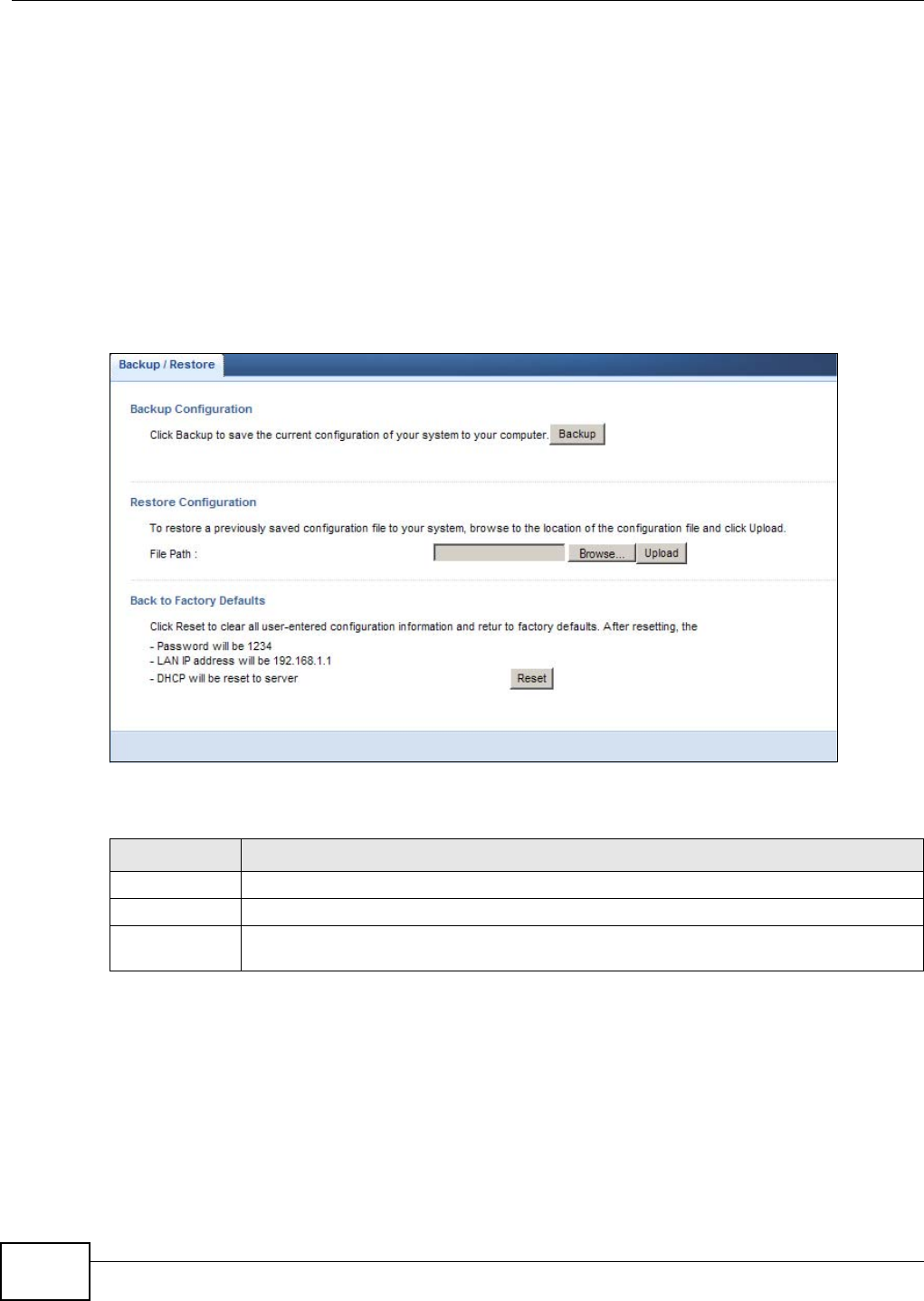
Chapter 26 Maintenance
NBG-419N v2 User’s Guide
186
26.7 Configuration Backup/Restore Screen
Backup configuration allows you to back up (save) the Router’s current configuration to a file on
your computer. Once your Router is configured and functioning properly, it is highly recommended
that you back up your configuration file before making configuration changes. The backup
configuration file will be useful in case you need to return to your previous settings.
Restore configuration allows you to upload a new or previously saved configuration file from your
computer to your Router.
Click Maintenance > Backup/Restore. Information related to factory defaults, backup
configuration, and restoring configuration appears as shown next.
Figure 134 Maintenance > Backup/Restore
The following table describes the labels in this screen.
Table 82 Maintenance > Backup/Restore
LABEL DESCRIPTION
Backup Click Backup to save the Router’s current configuration to your computer.
File Path Type in the location of the file you want to upload in this field or click Browse... to find it.
Browse... Click Browse... to find the file you want to upload. Remember that you must decompress
compressed (.ZIP) files before you can upload them.
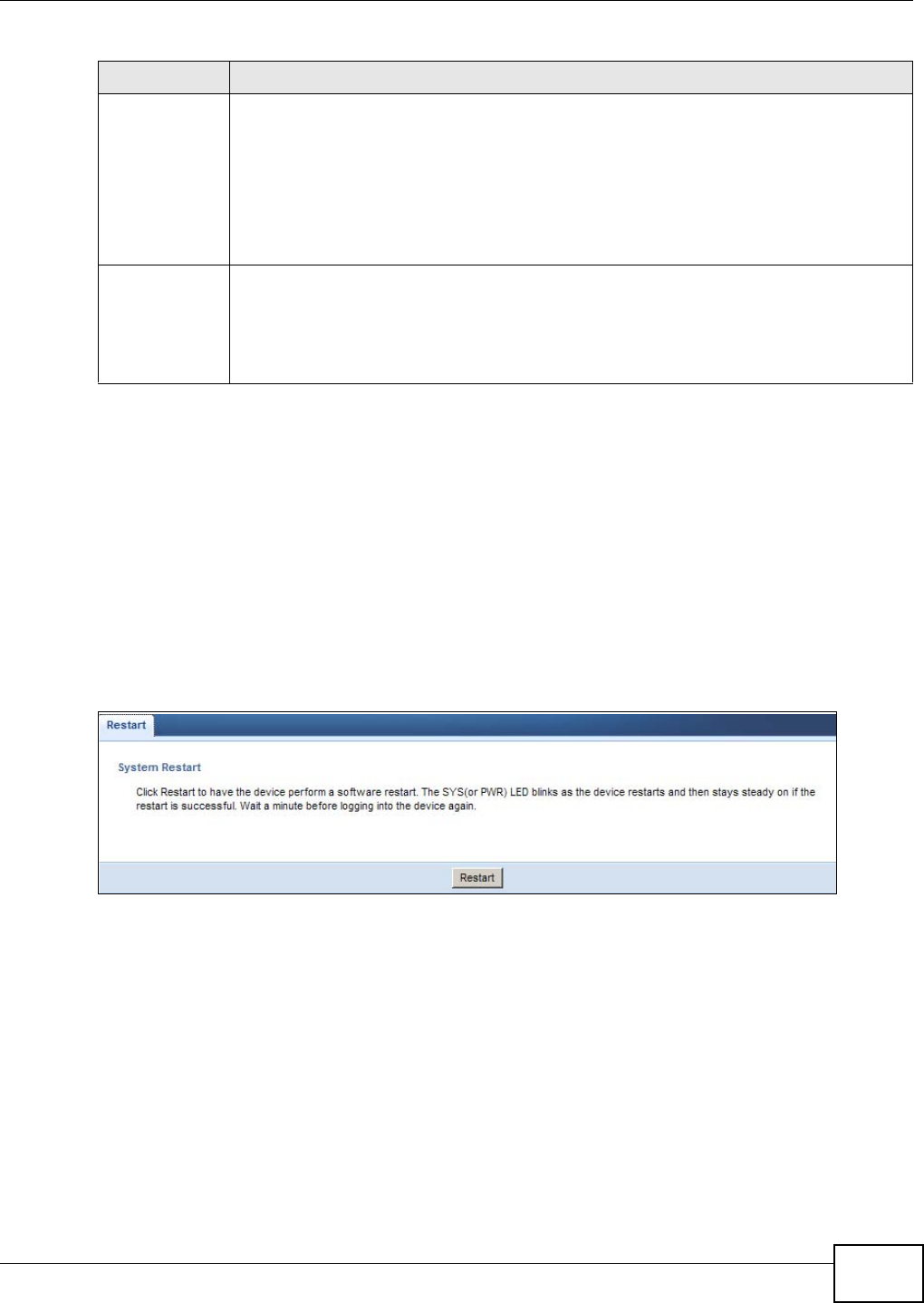
Chapter 26 Maintenance
NBG-419N v2 User’s Guide 187
Note: If you uploaded the default configuration file you may need to change the IP
address of your computer to be in the same subnet as that of the default Router IP
address (192.168.1.2). See Appendix C on page 221 for details on how to set up
your computer’s IP address.
26.8 Reset/Restart Screen
System restart allows you to reboot the Router without turning the power off.
Click Maintenance > Reset/Restart to open the following screen.
Figure 135 Maintenance > Reset/Restart
Click Restart to have the Router reboot. This does not affect the Router's configuration.
26.9 System Operation Mode Overview
The Sys OP Mode (System Operation Mode) function lets you configure your Router as an access
point, wireless client or both at the same time. You can choose between Router, Access Point
Mode, and WISP Mode depending on your network topology and the features you require from
your device.
The following describes the device modes available in your Router.
Upload Click Upload to begin the upload process.
Note: Do not turn off the Router while configuration file upload is in progress.
After you see a “configuration upload successful” screen, you must then wait one minute
before logging into the Router again. The Router automatically restarts in this time causing
a temporary network disconnect.
If you see an error screen, click Back to return to the Backup/Restore screen.
Reset Pressing the Reset button in this section clears all user-entered configuration information
and returns the Router to its factory defaults.
You can also press the RESET button on the rear panel to reset the factory defaults of your
Router. Refer to the chapter about introducing the Web Configurator for more information
on the RESET button.
Table 82 Maintenance > Backup/Restore (continued)
LABEL DESCRIPTION
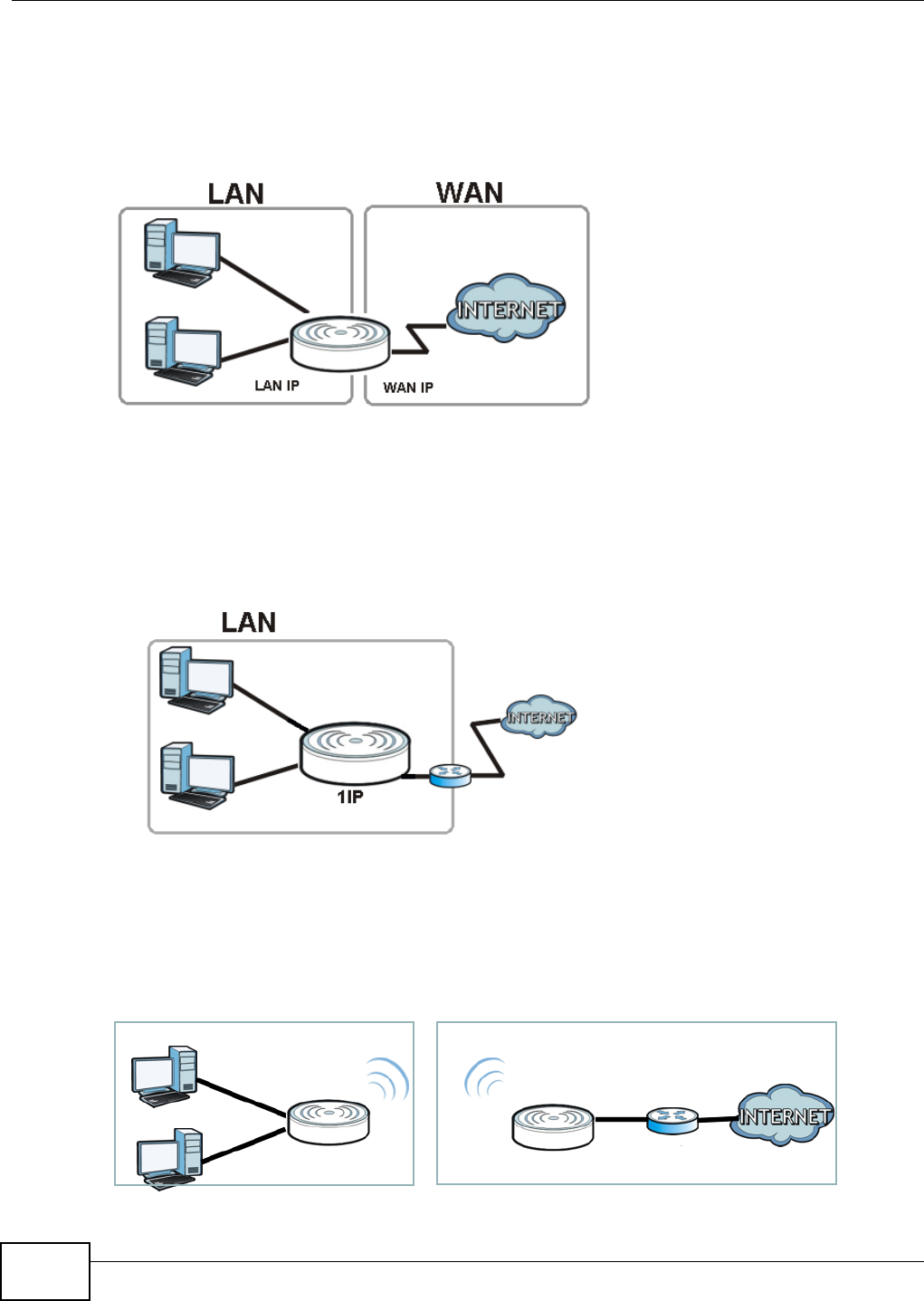
Chapter 26 Maintenance
NBG-419N v2 User’s Guide
188
Router
A router connects your local network with another network, such as the Internet. The router has
two IP addresses, the LAN IP address and the WAN IP address.
Figure 136 LAN and WAN IP Addresses in Router Mode
Access Point
An access point enabled all ethernet ports to be bridged together and be in the same subnet. To
connect to the Internet, another device, such as a router, is required.
Figure 137 Access Point Mode
WISP
A WISP client connects to an existing access point wirelessly. It acts just like a wireless client in
notebooks/computers.
Figure 138 IP Address in Access Point Mode
Access Point
Wireless Client
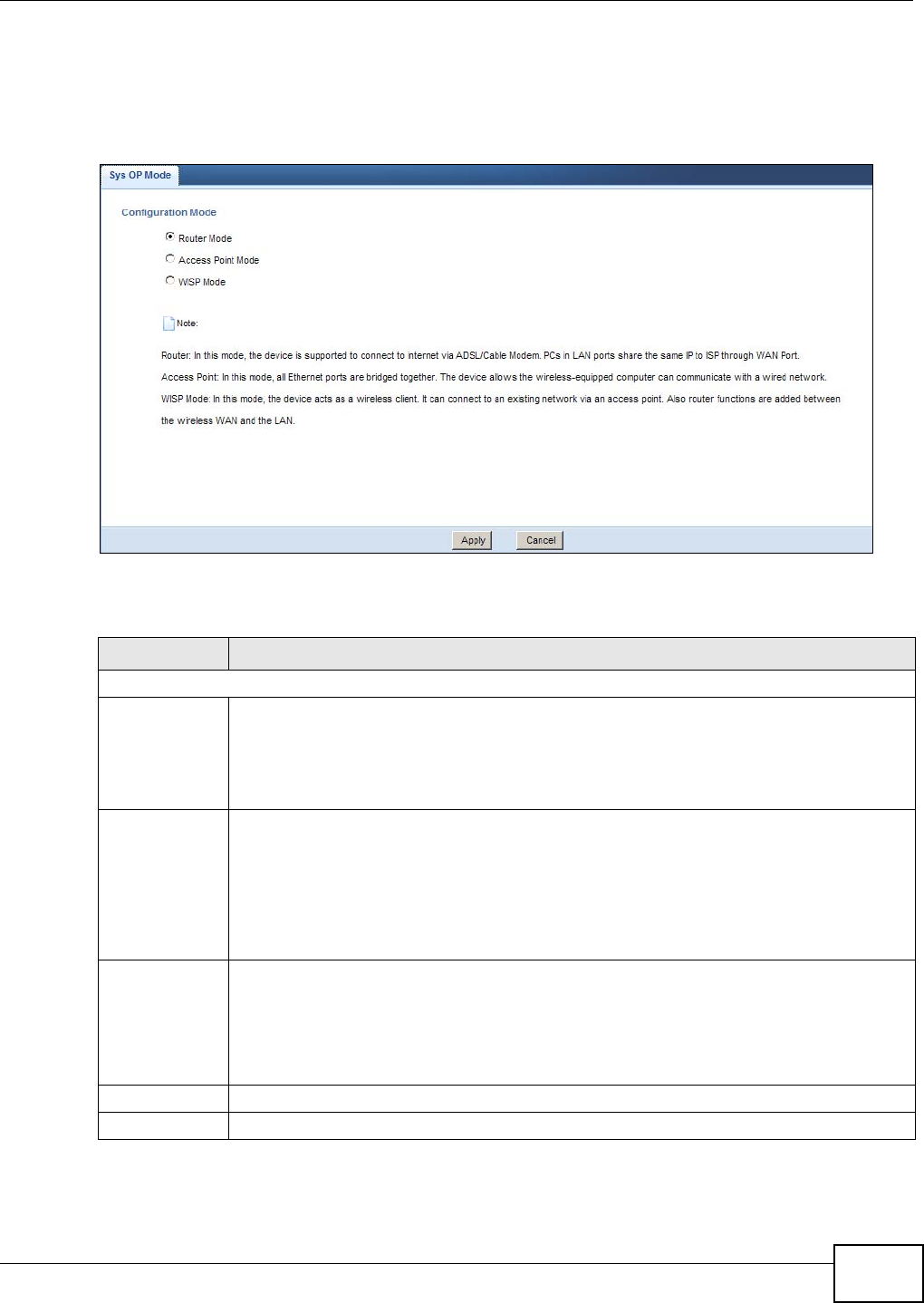
Chapter 26 Maintenance
NBG-419N v2 User’s Guide 189
26.10 Sys OP Mode Screen
Use this screen to select how you want to use your Router.
Figure 139 Maintenance > Sys OP Mode
The following table describes the labels in the General screen.
Note: If you select the incorrect System Operation Mode you may not be able to connect
to the Internet.
Table 83 Maintenance > Sys OP Mode
LABEL DESCRIPTION
System Operation Mode
Router Select Router Mode if your device routes traffic between a local network and another
network such as the Internet. This mode offers services such as a firewall or bandwidth
management.
You can configure the IP address settings on your WAN port. Contact your ISP or system
administrator for more information on appropriate settings.
Access Point Select Access Point Mode if your device bridges traffic between clients on the same
network.
•In Access Point Mode, all Ethernet ports have the same IP address.
• All ports on the rear panel of the device are LAN ports, including the port labeled WAN.
There is no WAN port.
• The DHCP server on your device is disabled.
• The IP address of the device on the local network is set to 192.168.1.2.
WISP Mode Select WISP Mode if your device needs a wireless client to connect to an existing access
point.
• You cannot configure Wireless LAN settings (including WPS) and scheduling in the WISP
Mode.
• The IP address of the device on the local network is the same as the IP address given to
the Router while in router mode (default is 192.168.1.1).
Apply Click Apply to save your settings.
Cancel Click Cancel to return your settings to the default (Router).

Chapter 26 Maintenance
NBG-419N v2 User’s Guide
190

NBG-419N v2 User’s Guide 191
CHAPTER 27
Troubleshooting
This chapter offers some suggestions to solve problems you might encounter. The potential
problems are divided into the following categories.
•Power, Hardware Connections, and LEDs
•Router Access and Login
•Internet Access
•Resetting the Router to Its Factory Defaults
•Wireless Router/AP Troubleshooting
•ZyXEL Share Center Utility Problems
27.1 Power, Hardware Connections, and LEDs
The Router does not turn on. None of the LEDs turn on.
1Make sure you are using the power adaptor or cord included with the Router.
2Make sure the power adaptor or cord is connected to the Router and plugged in to an appropriate
power source. Make sure the power source is turned on.
3Disconnect and re-connect the power adaptor or cord to the Router.
4If the problem continues, contact the vendor.
One of the LEDs does not behave as expected.
1Make sure you understand the normal behavior of the LED. See Section 1.5 on page 17.
2Check the hardware connections. See the Quick Start Guide.
3Inspect your cables for damage. Contact the vendor to replace any damaged cables.
4Disconnect and re-connect the power adaptor to the Router.
5If the problem continues, contact the vendor.

Chapter 27 Troubleshooting
NBG-419N v2 User’s Guide
192
27.2 Router Access and Login
I don’t know the IP address of my Router.
1The default IP address is 192.168.1.1.
2If you changed the IP address and have forgotten it, you might get the IP address of the Router by
looking up the IP address of the default gateway for your computer. To do this in most Windows
computers, click Start > Run, enter cmd, and then enter ipconfig. The IP address of the Default
Gateway might be the IP address of the Router (it depends on the network), so enter this IP
address in your Internet browser.Set your device to Router Mode, login (see the Quick Start Guide
for instructions) and go to the Device Information table in the Status screen. Your Router’s IP
address is available in the Device Information table.
•If the DHCP setting under LAN information is None, your device has a fixed IP address.
•If the DHCP setting under LAN information is Client, then your device receives an IP
address from a DHCP server on the network.
3If your Router is a DHCP client, you can find your IP address from the DHCP server. This information
is only available from the DHCP server which allocates IP addresses on your network. Find this
information directly from the DHCP server or contact your system administrator for more
information.
4Reset your Router to change all settings back to their default. This means your current settings are
lost. See Section 27.4 on page 195 in the Troubleshooting for information on resetting your
Router.
I forgot the password.
1The default password is 1234.
2If this does not work, you have to reset the device to its factory defaults. See Section 27.4 on page
195.
I cannot see or access the Login screen in the Web Configurator.
1Make sure you are using the correct IP address.
• The default IP address is 192.168.1.1.
• If you changed the IP address (Section 15.4 on page 135), use the new IP address.
• If you changed the IP address and have forgotten it, see the troubleshooting suggestions for I
don’t know the IP address of my Router.

Chapter 27 Troubleshooting
NBG-419N v2 User’s Guide 193
2Check the hardware connections, and make sure the LEDs are behaving as expected. See the Quick
Start Guide.
3Make sure your Internet browser does not block pop-up windows and has JavaScript and Java
enabled. See Appendix A on page 199.
4Make sure your computer is in the same subnet as the Router. (If you know that there are routers
between your computer and the Router, skip this step.)
• If there is a DHCP server on your network, make sure your computer is using a dynamic IP
address. See Appendix C on page 221.
• If there is no DHCP server on your network, make sure your computer’s IP address is in the
same subnet as the Router. See Appendix C on page 221.
5Reset the device to its factory defaults, and try to access the Router with the default IP address.
See Section 5.3 on page 43.
6If the problem continues, contact the network administrator or vendor, or try one of the advanced
suggestions.
Advanced Suggestion
• If your computer is connected to the WAN port or is connected wirelessly, use a computer that is
connected to a LAN/ETHERNET port.
I can see the Login screen, but I cannot log in to the Router.
1Make sure you have entered the password correctly. The default password is 1234. This field is
case-sensitive, so make sure [Caps Lock] is not on.
2This can happen when you fail to log out properly from your last session. Try logging in again after
5 minutes.
3Disconnect and re-connect the power adaptor or cord to the Router.
4If this does not work, you have to reset the device to its factory defaults. See Section 27.4 on page
195.
27.3 Internet Access
I cannot access the Internet.
1Check the hardware connections, and make sure the LEDs are behaving as expected. See the Quick
Start Guide.

Chapter 27 Troubleshooting
NBG-419N v2 User’s Guide
194
2Make sure you entered your ISP account information correctly in the wizard. These fields are case-
sensitive, so make sure [Caps Lock] is not on.
3If you are trying to access the Internet wirelessly, make sure the wireless settings in the wireless
client are the same as the settings in the AP.
•Go to Network > Wireless LAN > General > WDS and check if the Router is set to bridge
mode. Select Disable and try to connect to the Internet again.
4Disconnect all the cables from your device, and follow the directions in the Quick Start Guide again.
5Go to Maintenance > Sys OP Mode. Check your System Operation Mode setting.
•Select Router if your device routes traffic between a local network and another network such
as the Internet.
•Select Access Point if your device bridges traffic between clients on the same network.
6If the problem continues, contact your ISP.
I cannot access the Internet anymore. I had access to the Internet (with the Router), but my
Internet connection is not available anymore.
1Check the hardware connections, and make sure the LEDs are behaving as expected. See the Quick
Start Guide and Section 1.5 on page 17.
2Reboot the Router.
3If the problem continues, contact your ISP.
The Internet connection is slow or intermittent.
1There might be a lot of traffic on the network. Look at the LEDs, and check Section 1.5 on page 17.
If the Router is sending or receiving a lot of information, try closing some programs that use the
Internet, especially peer-to-peer applications.
2Check the signal strength. If the signal strength is low, try moving the Router closer to the AP if
possible, and look around to see if there are any devices that might be interfering with the wireless
network (for example, microwaves, other wireless networks, and so on).
3Reboot the Router.
4If the problem continues, contact the network administrator or vendor, or try one of the advanced
suggestions.
Advanced Suggestions
• Check the settings for bandwidth management. If it is disabled, you might consider activating it.
If it is enabled, you might consider changing the allocations.

Chapter 27 Troubleshooting
NBG-419N v2 User’s Guide 195
• Check the settings for QoS. If it is disabled, you might consider activating it. If it is enabled, you
might consider raising or lowering the priority for some applications.
27.4 Resetting the Router to Its Factory Defaults
If you reset the Router, you lose all of the changes you have made. The Router re-loads its default
settings, and the password resets to 1234. You have to make all of your changes again.
You will lose all of your changes when you push the RESET button.
To reset the Router,
1Make sure the power LED is on.
2Press the RESET button for longer than 1 second to restart/reboot the Router.
3Press the RESET button for longer than five seconds to set the Router back to its factory-default
configurations.
If the Router restarts automatically, wait for the Router to finish restarting, and log in to the Web
Configurator. The password is “1234”.
If the Router does not restart automatically, disconnect and reconnect the Router’s power. Then,
follow the directions above again.
27.5 Wireless Router/AP Troubleshooting
I cannot access the Router or ping any computer from the WLAN (wireless AP or router).
1Make sure the wireless LAN is enabled on the Router
2Make sure the wireless adapter on the wireless station is working properly.
3Make sure the wireless adapter installed on your computer is IEEE 802.11 compatible and supports
the same wireless standard as the Router.
4Make sure your computer (with a wireless adapter installed) is within the transmission range of the
Router.
5Check that both the Router and your wireless station are using the same wireless and wireless
security settings.
6Make sure traffic between the WLAN and the LAN is not blocked by the firewall on the Router.

Chapter 27 Troubleshooting
NBG-419N v2 User’s Guide
196
7Make sure you allow the Router to be remotely accessed through the WLAN interface. Check your
remote management settings.
• See the chapter on Wireless LAN in the User’s Guide for more information.
I set up URL keyword blocking, but I can still access a website that should be blocked.
Make sure that you select the Enable URL Keyword Blocking check box in the Content Filtering
screen. Make sure that the keywords that you type are listed in the Keyword List.
If a keyword that is listed in the Keyword List is not blocked when it is found in a URL, customize
the keyword blocking using commands. See the Customizing Keyword Blocking URL Checking
section in the Content Filter chapter.
I can access the Web Configurator after I switched to AP mode.
When you change from router mode to AP mode, your computer must have an IP address in the
range between “192.168.1.3” and “192.168.1.254”.
Refer to Appendix C on page 221 for instructions on how to change your computer’s IP address.
27.6 ZyXEL Share Center Utility Problems
I cannot access or see a USB device that is connected to the Router.
1Disconnect the problematic USB device, then reconnect it to the Router.
2Ensure that the USB device in question has power.
3Check your cable connections.
4Restart the Router by disconnecting the power and then reconnecting it.
5If the USB device requires a special driver, install the driver from the installation disc that came
with the device. After driver installation, reconnect the USB device to the Router and try to connect
to it again with your computer.
6If the problem persists, contact your vendor.
I cannot install the ZyXEL Share Center Utility.

Chapter 27 Troubleshooting
NBG-419N v2 User’s Guide 197
1Make sure that the set up program is one required for your operating system.
2Install the latest patches and updates for your operating system.
3Check the zyxel.com download site for a newer version of the utility.
Two computers cannot connect the USB storage at the same time using the ZyXEL Share
Center Utility.
Only one computer can connect to the USB storage through the ZyXEL Share Center Utlity at a
time. If two computers (A and B) want to connect to the USB storage by using the Utility, do the
following:
1After A finishes connection to the USB storage, disconnect it by clicking Disconnect in A’s Utlity.
2Connect B to the USB storage (through the Utility) by clicking Connect in B’s Utility.
3If A does not disconnect the USB storage, B should click Request to Connect in the Utility to
request A to disconnect. B cannot access the USB storage until A disconnects.
•See Chapter 12 on page 89 for more details on connecting to USB storage by the Utility.

Chapter 27 Troubleshooting
NBG-419N v2 User’s Guide
198
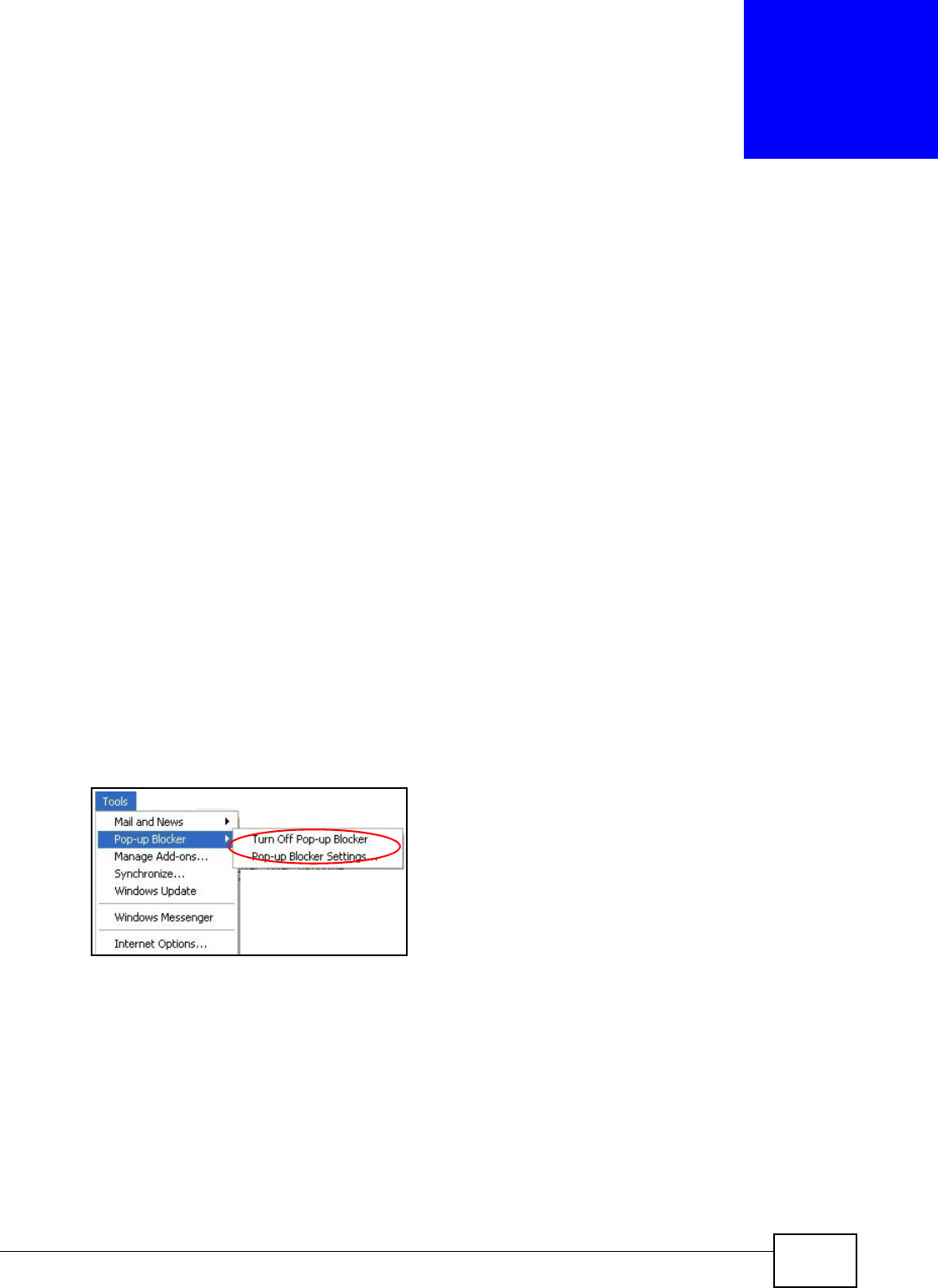
NBG-419N v2 User’s Guide 199
APPENDIX A
Pop-up Windows, JavaScript and Java
Permissions
In order to use the web configurator you need to allow:
• Web browser pop-up windows from your device.
• JavaScript (enabled by default).
• Java permissions (enabled by default).
Note: The screens used below belong to Internet Explorer version 6, 7 and 8. Screens for
other Internet Explorer versions may vary.
Internet Explorer Pop-up Blockers
You may have to disable pop-up blocking to log into your device.
Either disable pop-up blocking (enabled by default in Windows XP SP (Service Pack) 2) or allow
pop-up blocking and create an exception for your device’s IP address.
Disable Pop-up Blockers
1In Internet Explorer, select Tools, Pop-up Blocker and then select Turn Off Pop-up Blocker.
Figure 140 Pop-up Blocker
You can also check if pop-up blocking is disabled in the Pop-up Blocker section in the Privacy tab.
1In Internet Explorer, select Tools, Internet Options, Privacy.
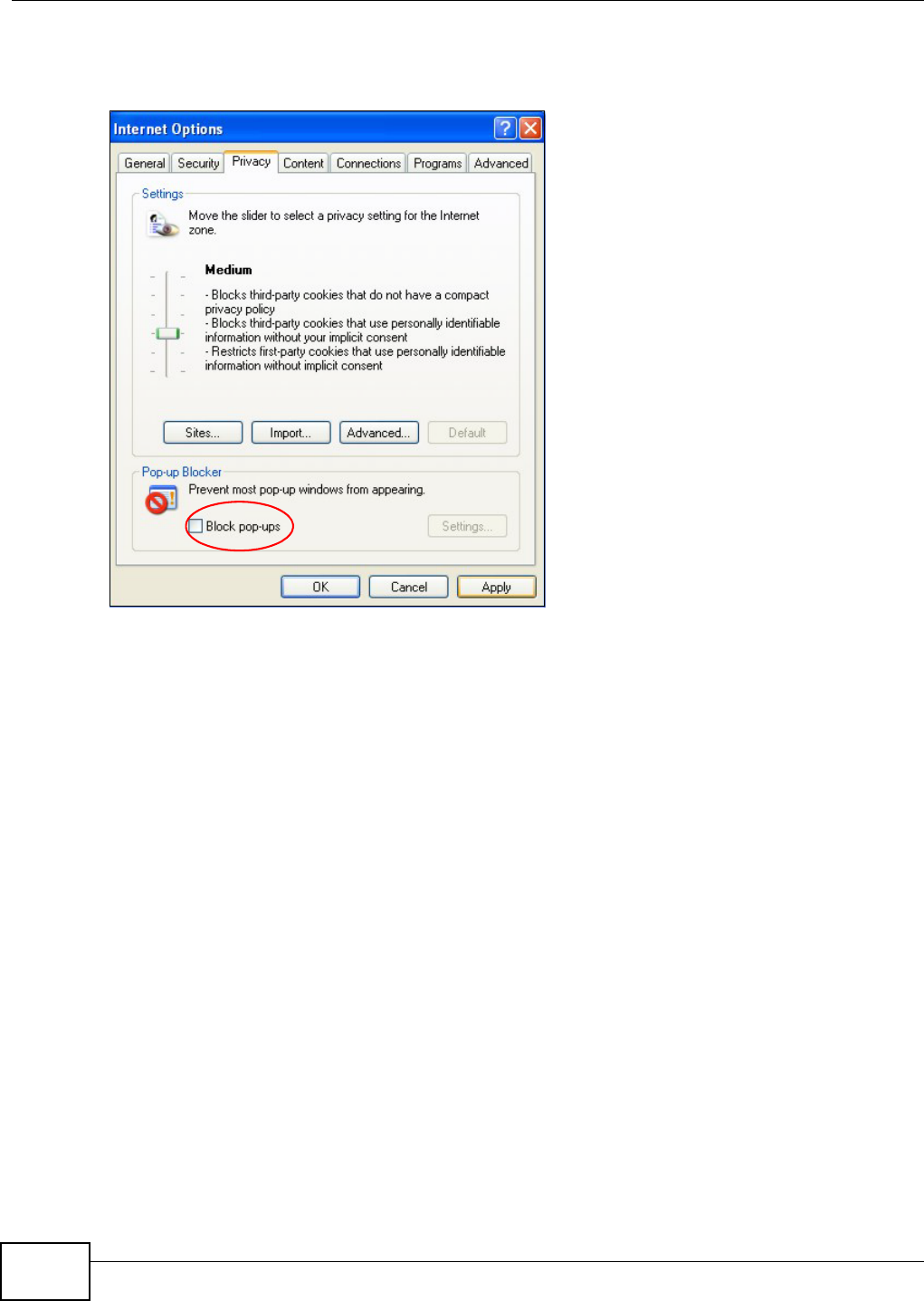
Appendix A Pop-up Windows, JavaScript and Java Permissions
NBG-419N v2 User’s Guide
200
2Clear the Block pop-ups check box in the Pop-up Blocker section of the screen. This disables any
web pop-up blockers you may have enabled.
Figure 141 Internet Options: Privacy
3Click Apply to save this setting.
Enable Pop-up Blockers with Exceptions
Alternatively, if you only want to allow pop-up windows from your device, see the following steps.
1In Internet Explorer, select Tools, Internet Options and then the Privacy tab.
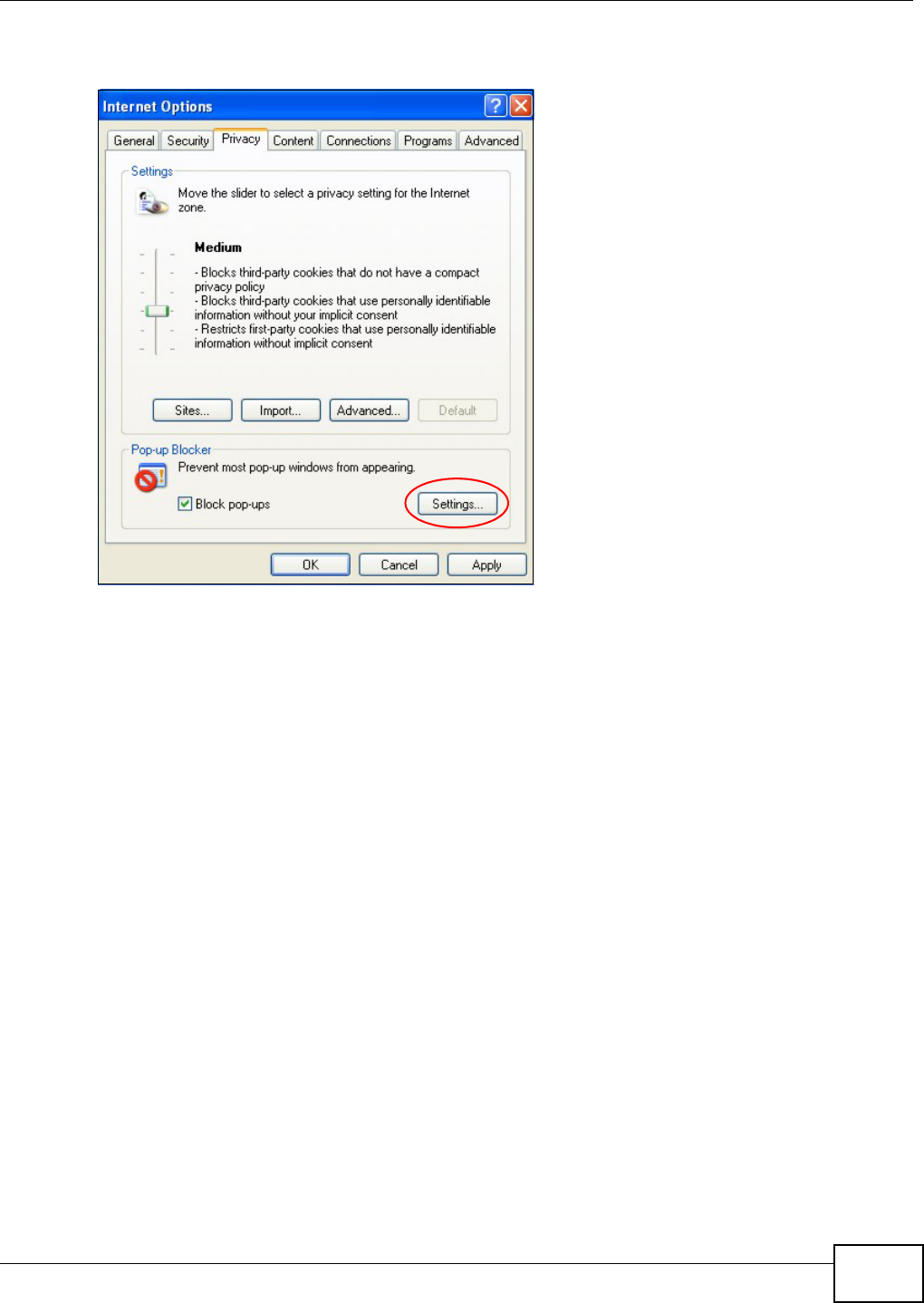
Appendix A Pop-up Windows, JavaScript and Java Permissions
NBG-419N v2 User’s Guide 201
2Select Settings…to open the Pop-up Blocker Settings screen.
Figure 142 Internet Options: Privacy
3Type the IP address of your device (the web page that you do not want to have blocked) with the
prefix “http://”. For example, http://192.168.167.1.
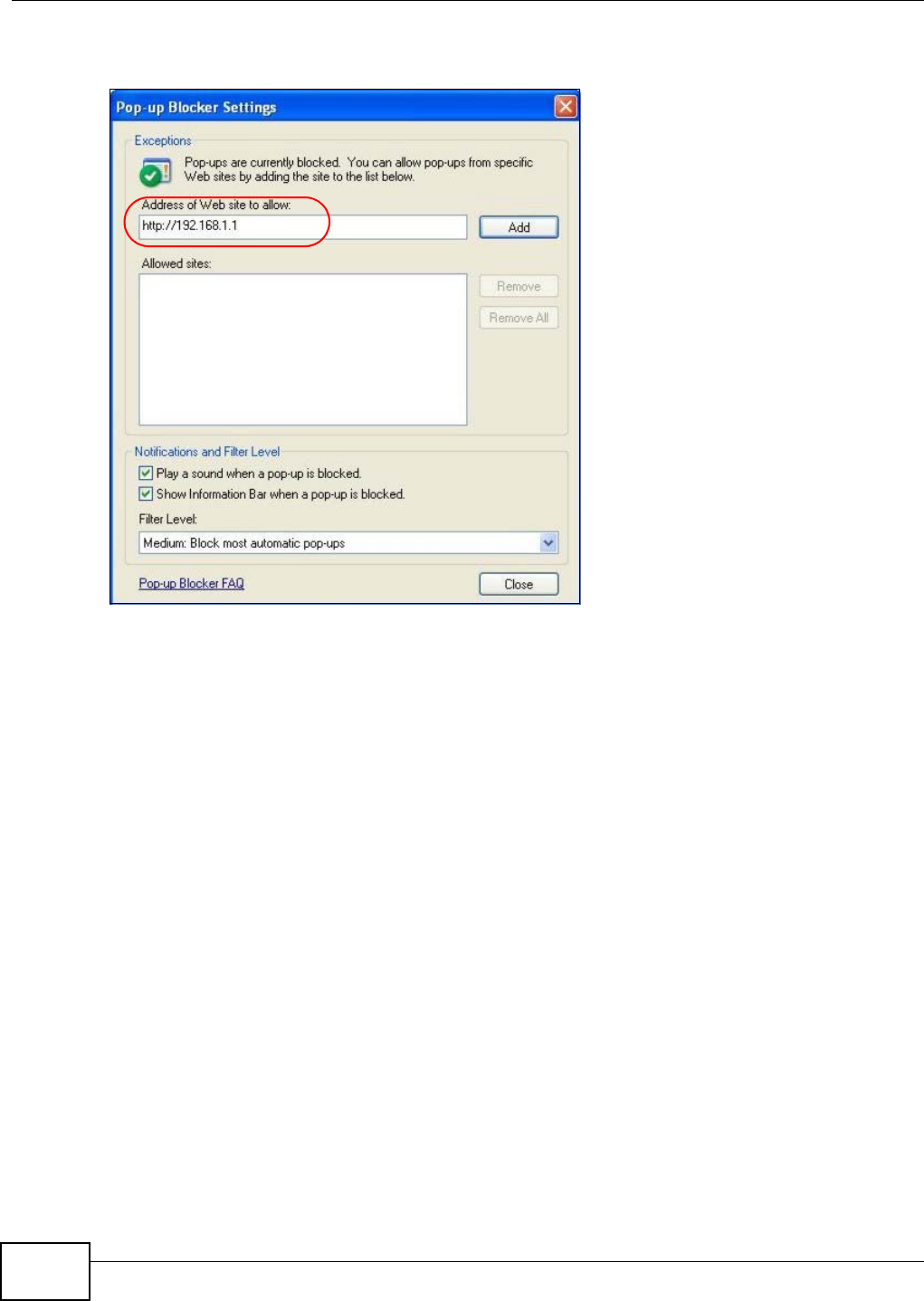
Appendix A Pop-up Windows, JavaScript and Java Permissions
NBG-419N v2 User’s Guide
202
4Click Add to move the IP address to the list of Allowed sites.
Figure 143 Pop-up Blocker Settings
5Click Close to return to the Privacy screen.
6Click Apply to save this setting.
JavaScript
If pages of the web configurator do not display properly in Internet Explorer, check that JavaScript
are allowed.
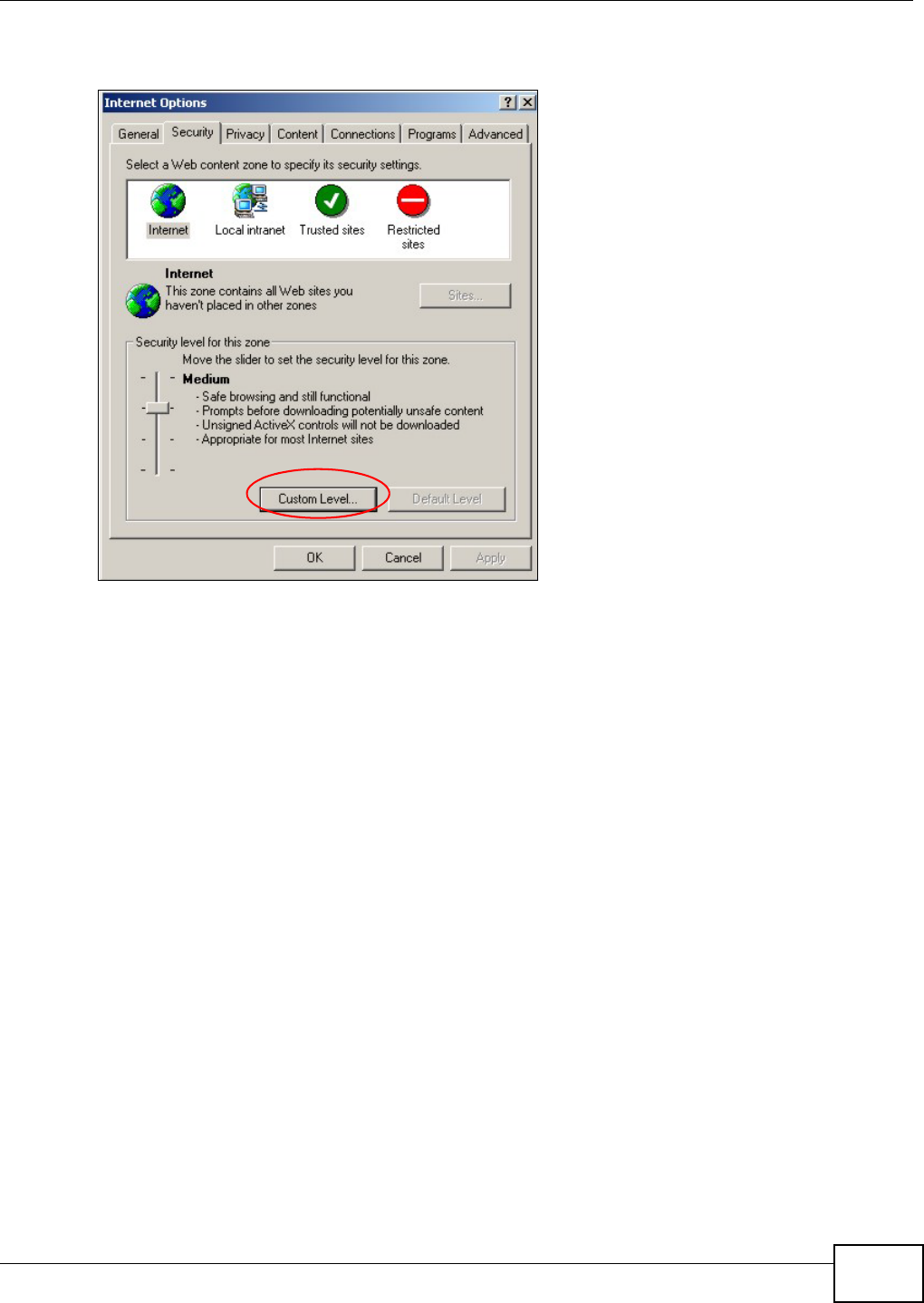
Appendix A Pop-up Windows, JavaScript and Java Permissions
NBG-419N v2 User’s Guide 203
1In Internet Explorer, click Tools, Internet Options and then the Security tab.
Figure 144 Internet Options: Security
2Click the Custom Level... button.
3Scroll down to Scripting.
4Under Active scripting make sure that Enable is selected (the default).
5Under Scripting of Java applets make sure that Enable is selected (the default).
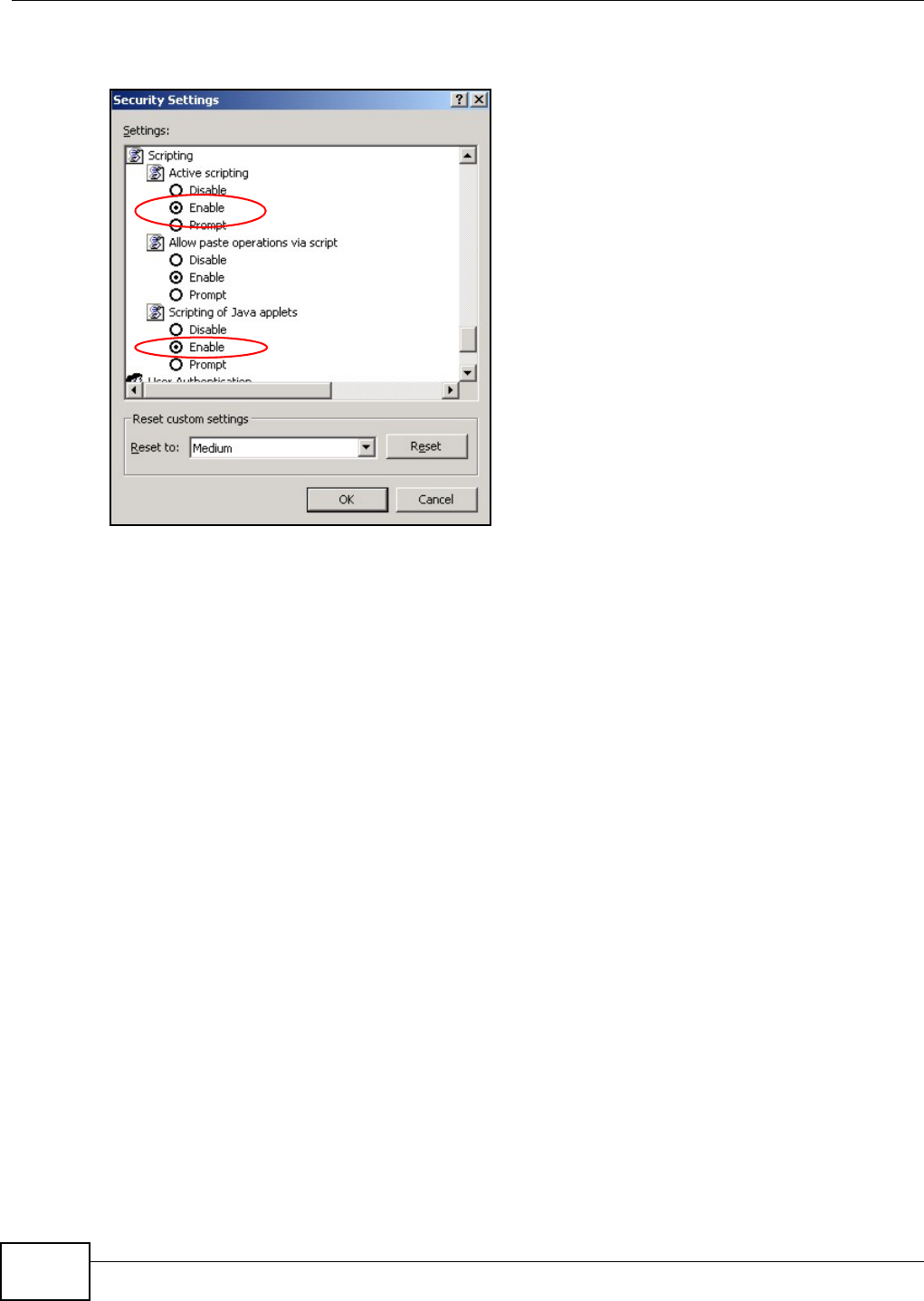
Appendix A Pop-up Windows, JavaScript and Java Permissions
NBG-419N v2 User’s Guide
204
6Click OK to close the window.
Figure 145 Security Settings - Java Scripting
Java Permissions
1From Internet Explorer, click Tools, Internet Options and then the Security tab.
2Click the Custom Level... button.
3Scroll down to Microsoft VM.
4Under Java permissions make sure that a safety level is selected.
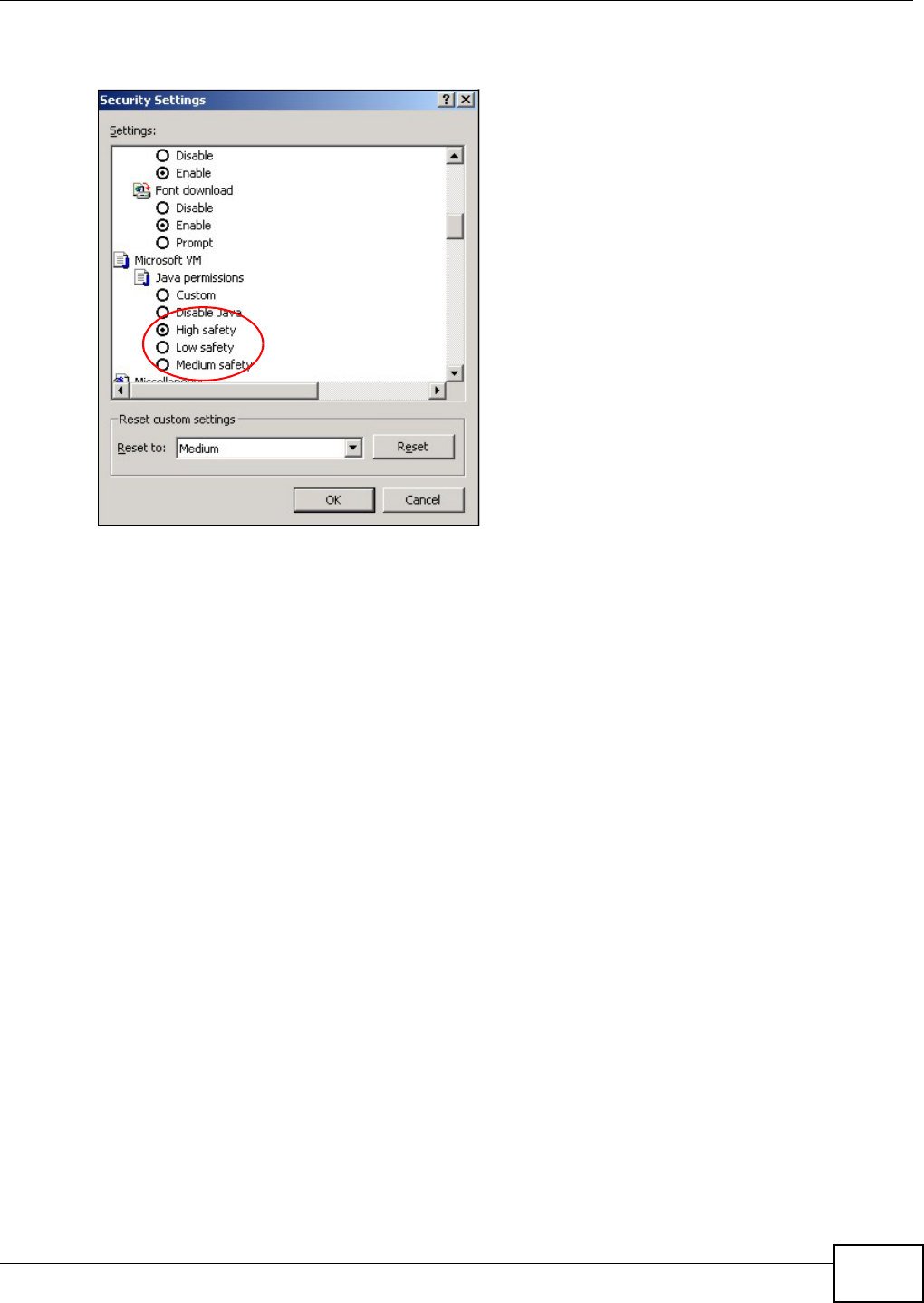
Appendix A Pop-up Windows, JavaScript and Java Permissions
NBG-419N v2 User’s Guide 205
5Click OK to close the window.
Figure 146 Security Settings - Java
JAVA (Sun)
1From Internet Explorer, click Tools, Internet Options and then the Advanced tab.
2Make sure that Use Java 2 for <applet> under Java (Sun) is selected.
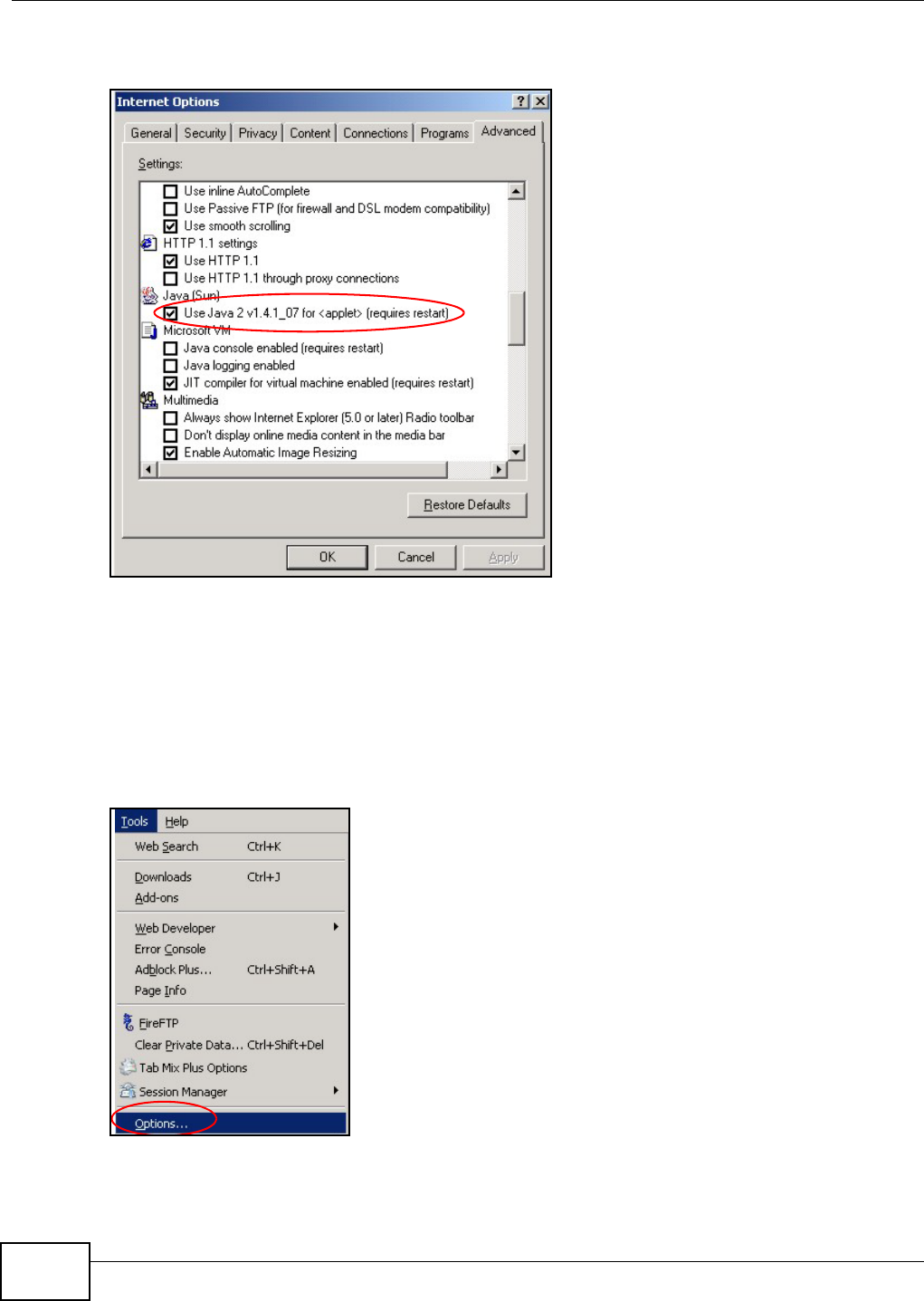
Appendix A Pop-up Windows, JavaScript and Java Permissions
NBG-419N v2 User’s Guide
206
3Click OK to close the window.
Figure 147 Java (Sun)
Mozilla Firefox
Mozilla Firefox 2.0 screens are used here. Screens for other versions may vary slightly. The steps
below apply to Mozilla Firefox 3.0 as well.
You can enable Java, Javascript and pop-ups in one screen. Click Tools, then click Options in the
screen that appears.
Figure 148 Mozilla Firefox: TOOLS > Options
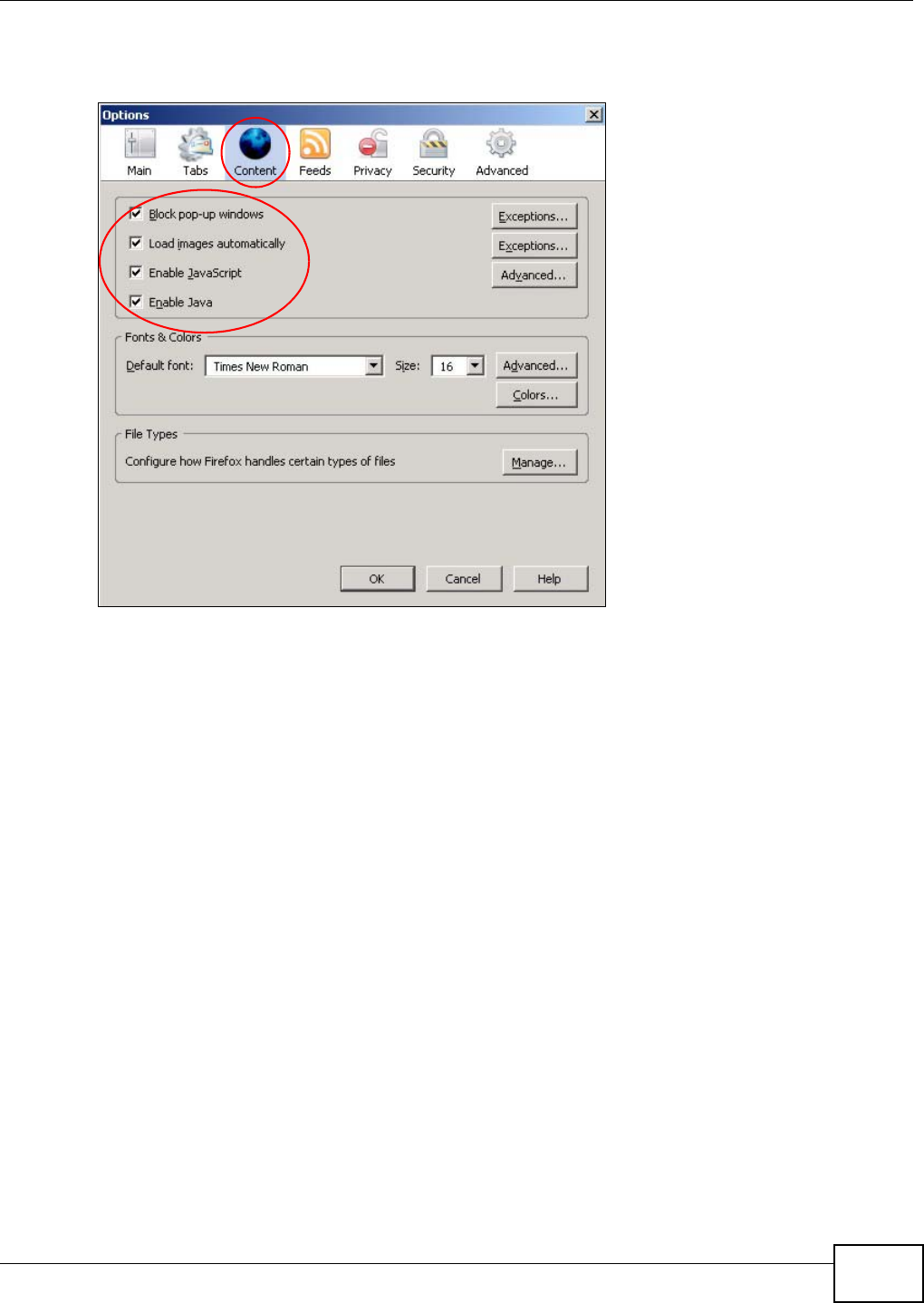
Appendix A Pop-up Windows, JavaScript and Java Permissions
NBG-419N v2 User’s Guide 207
Click Content to show the screen below. Select the check boxes as shown in the following screen.
Figure 149 Mozilla Firefox Content Security
Opera
Opera 10 screens are used here. Screens for other versions may vary slightly.
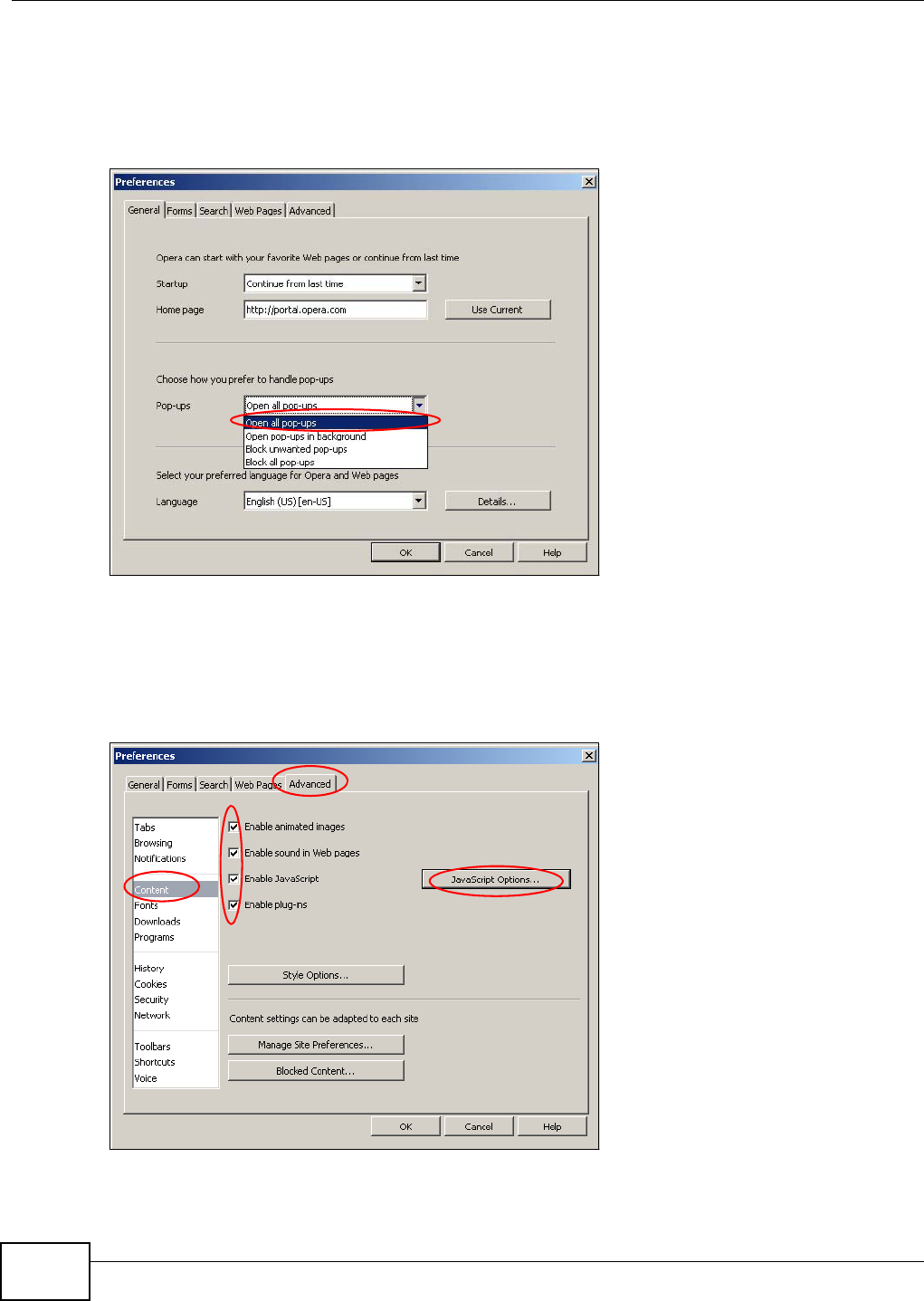
Appendix A Pop-up Windows, JavaScript and Java Permissions
NBG-419N v2 User’s Guide
208
Allowing Pop-Ups
From Opera, click Tools, then Preferences. In the General tab, go to Choose how you prefer
to handle pop-ups and select Open all pop-ups.
Figure 150 Opera: Allowing Pop-Ups
Enabling Java
From Opera, click Tools, then Preferences. In the Advanced tab, select Content from the left-
side menu. Select the check boxes as shown in the following screen.
Figure 151 Opera: Enabling Java
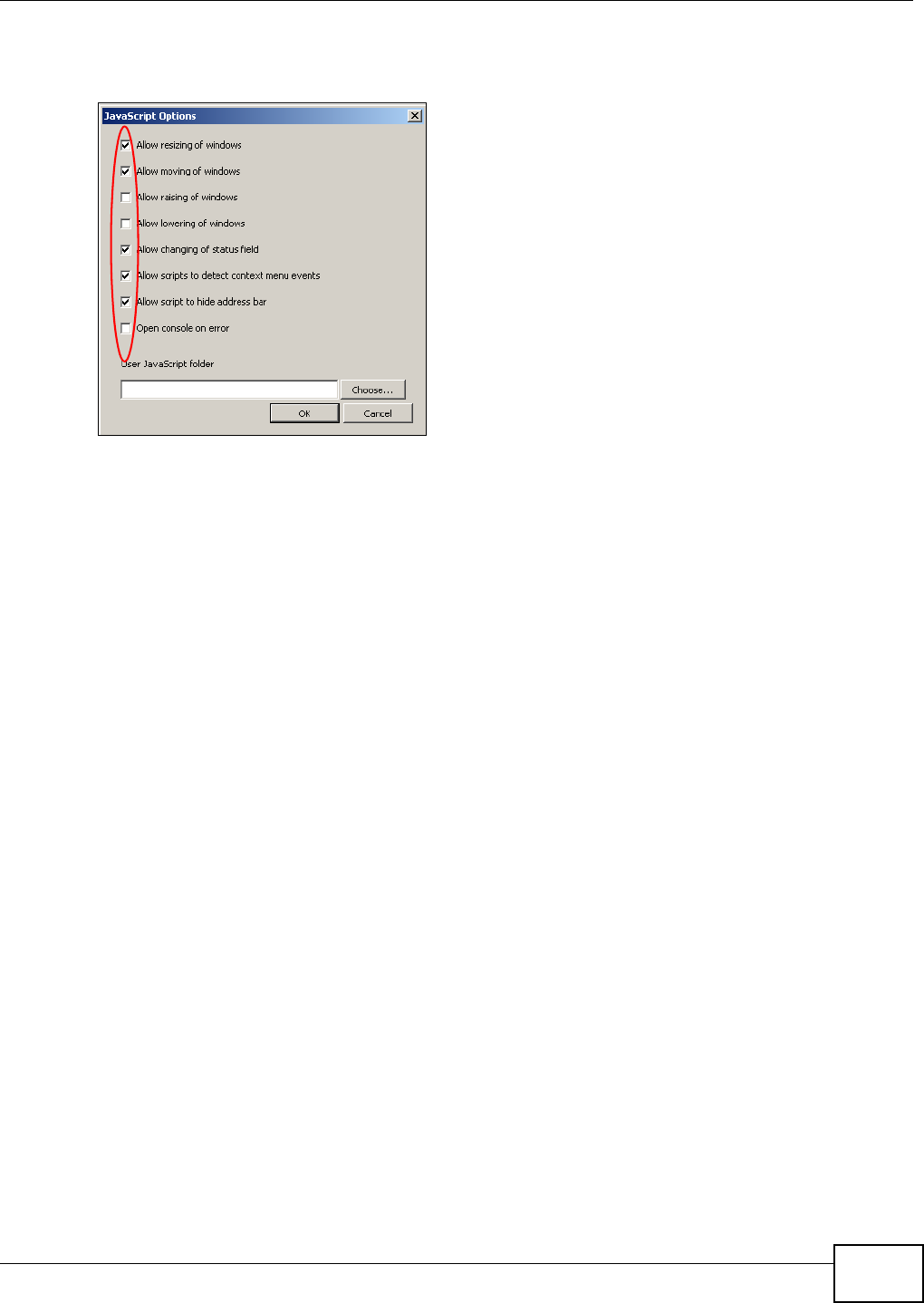
Appendix A Pop-up Windows, JavaScript and Java Permissions
NBG-419N v2 User’s Guide 209
To customize JavaScript behavior in the Opera browser, click JavaScript Options.
Figure 152 Opera: JavaScript Options
Select the items you want Opera’s JavaScript to apply.

Appendix A Pop-up Windows, JavaScript and Java Permissions
NBG-419N v2 User’s Guide
210

NBG-419N v2 User’s Guide 211
APPENDIX B
IP Addresses and Subnetting
This appendix introduces IP addresses and subnet masks.
IP addresses identify individual devices on a network. Every networking device (including
computers, servers, routers, printers, etc.) needs an IP address to communicate across the
network. These networking devices are also known as hosts.
Subnet masks determine the maximum number of possible hosts on a network. You can also use
subnet masks to divide one network into multiple sub-networks.
Introduction to IP Addresses
One part of the IP address is the network number, and the other part is the host ID. In the same
way that houses on a street share a common street name, the hosts on a network share a common
network number. Similarly, as each house has its own house number, each host on the network has
its own unique identifying number - the host ID. Routers use the network number to send packets
to the correct network, while the host ID determines to which host on the network the packets are
delivered.
Structure
An IP address is made up of four parts, written in dotted decimal notation (for example,
192.168.1.1). Each of these four parts is known as an octet. An octet is an eight-digit binary
number (for example 11000000, which is 192 in decimal notation).
Therefore, each octet has a possible range of 00000000 to 11111111 in binary, or 0 to 255 in
decimal.
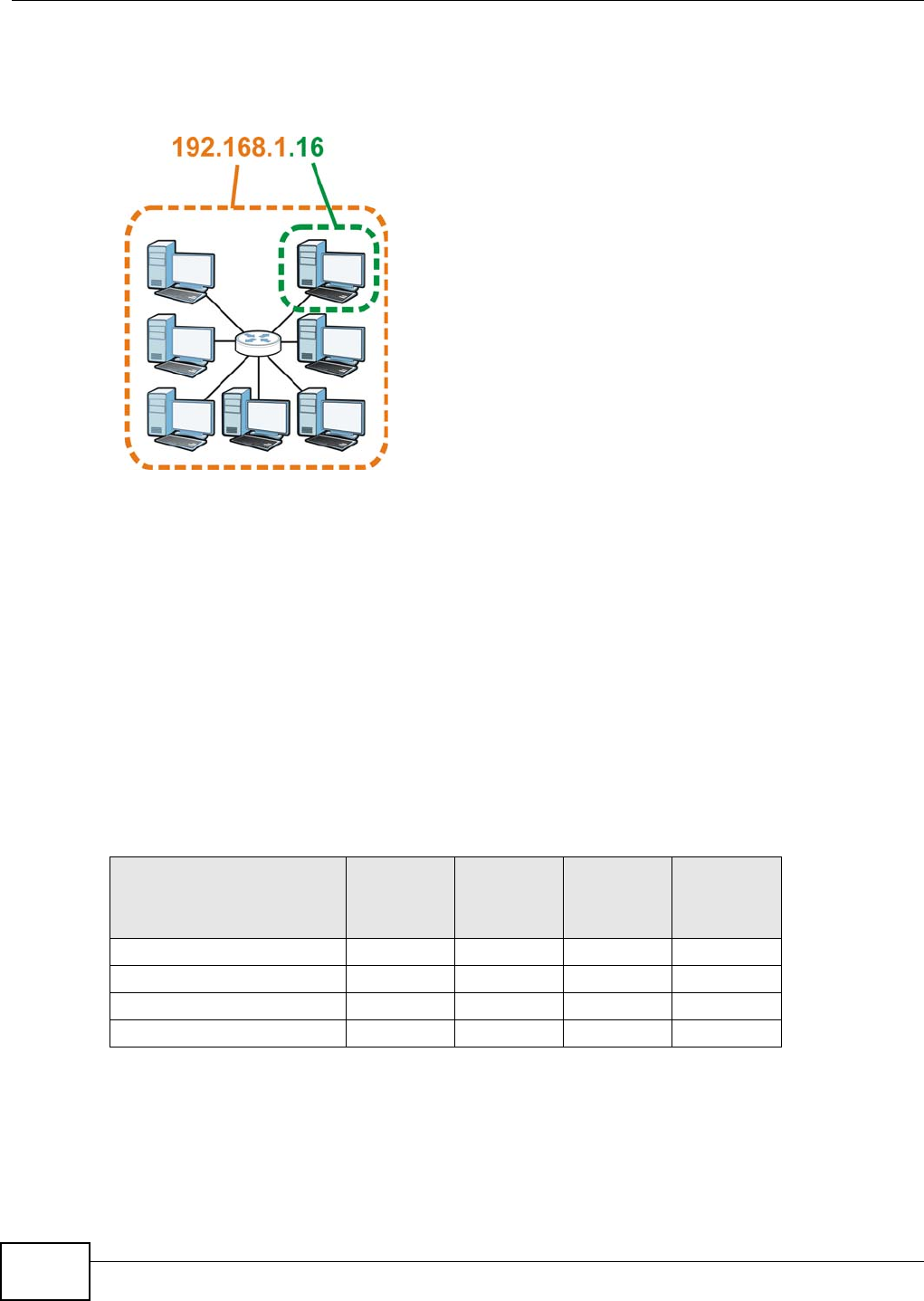
Appendix B IP Addresses and Subnetting
NBG-419N v2 User’s Guide
212
The following figure shows an example IP address in which the first three octets (192.168.1) are
the network number, and the fourth octet (16) is the host ID.
Figure 153 Network Number and Host ID
How much of the IP address is the network number and how much is the host ID varies according
to the subnet mask.
Subnet Masks
A subnet mask is used to determine which bits are part of the network number, and which bits are
part of the host ID (using a logical AND operation). The term “subnet” is short for “sub-network”.
A subnet mask has 32 bits. If a bit in the subnet mask is a “1” then the corresponding bit in the IP
address is part of the network number. If a bit in the subnet mask is “0” then the corresponding bit
in the IP address is part of the host ID.
The following example shows a subnet mask identifying the network number (in bold text) and host
ID of an IP address (192.168.1.2 in decimal).
By convention, subnet masks always consist of a continuous sequence of ones beginning from the
leftmost bit of the mask, followed by a continuous sequence of zeros, for a total number of 32 bits.
Subnet masks can be referred to by the size of the network number part (the bits with a “1” value).
For example, an “8-bit mask” means that the first 8 bits of the mask are ones and the remaining 24
bits are zeroes.
Table 84 IP Address Network Number and Host ID Example
1ST OCTET:
(192)
2ND
OCTET:
(168)
3RD
OCTET:
(1)
4TH OCTET
(2)
IP Address (Binary) 11000000 10101000 00000001 00000010
Subnet Mask (Binary) 11111111 11111111 11111111 00000000
Network Number 11000000 10101000 00000001
Host ID 00000010
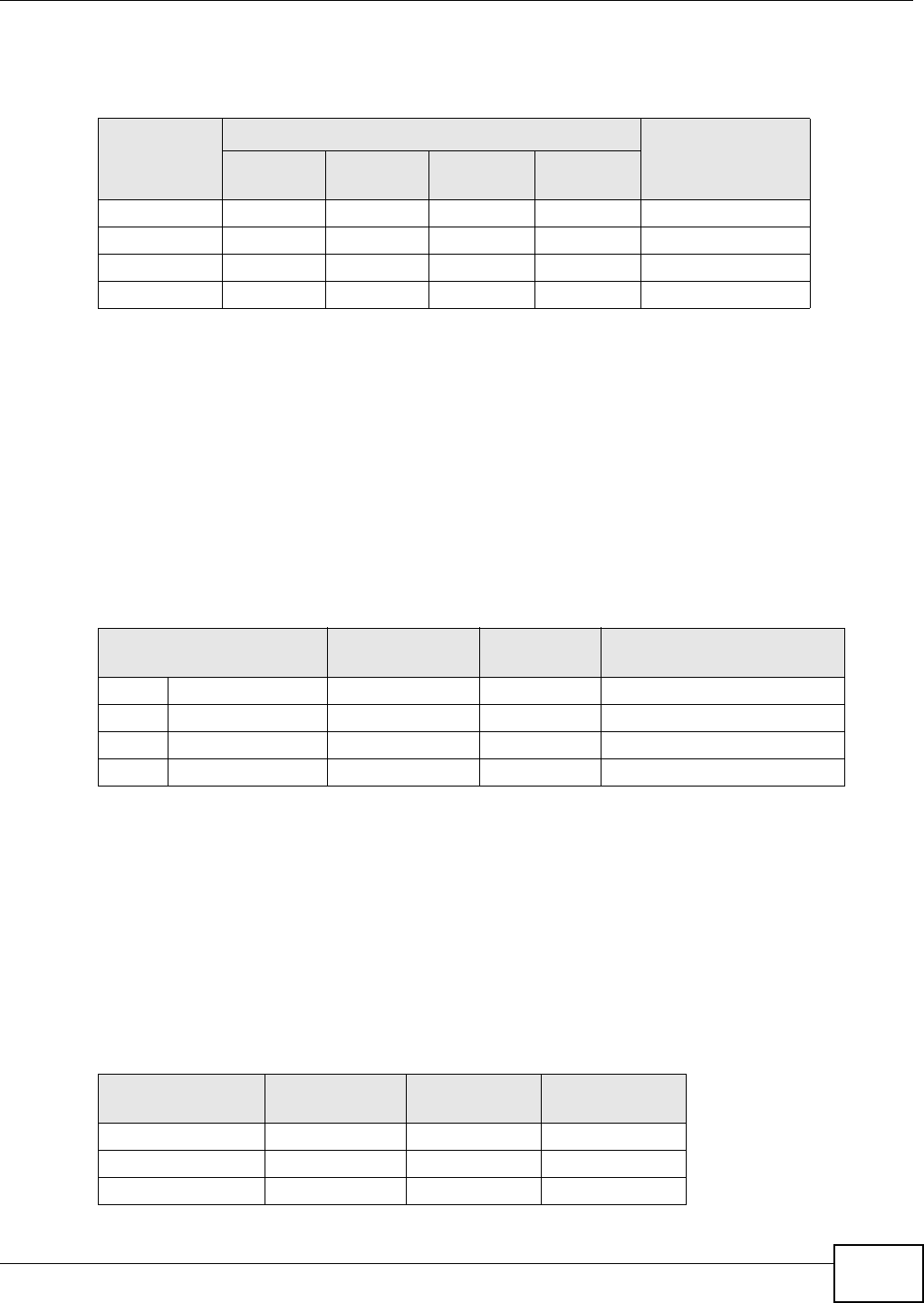
Appendix B IP Addresses and Subnetting
NBG-419N v2 User’s Guide 213
Subnet masks are expressed in dotted decimal notation just like IP addresses. The following
examples show the binary and decimal notation for 8-bit, 16-bit, 24-bit and 29-bit subnet masks.
Network Size
The size of the network number determines the maximum number of possible hosts you can have
on your network. The larger the number of network number bits, the smaller the number of
remaining host ID bits.
An IP address with host IDs of all zeros is the IP address of the network (192.168.1.0 with a 24-bit
subnet mask, for example). An IP address with host IDs of all ones is the broadcast address for that
network (192.168.1.255 with a 24-bit subnet mask, for example).
As these two IP addresses cannot be used for individual hosts, calculate the maximum number of
possible hosts in a network as follows:
Notation
Since the mask is always a continuous number of ones beginning from the left, followed by a
continuous number of zeros for the remainder of the 32 bit mask, you can simply specify the
number of ones instead of writing the value of each octet. This is usually specified by writing a “/”
followed by the number of bits in the mask after the address.
For example, 192.1.1.0 /25 is equivalent to saying 192.1.1.0 with subnet mask 255.255.255.128.
The following table shows some possible subnet masks using both notations.
Table 85 Subnet Masks
BINARY
DECIMAL
1ST
OCTET 2ND
OCTET 3RD
OCTET 4TH OCTET
8-bit mask 11111111 00000000 00000000 00000000 255.0.0.0
16-bit mask 11111111 11111111 00000000 00000000 255.255.0.0
24-bit mask 11111111 11111111 11111111 00000000 255.255.255.0
29-bit mask 11111111 11111111 11111111 11111000 255.255.255.248
Table 86 Maximum Host Numbers
SUBNET MASK HOST ID SIZE MAXIMUM NUMBER OF
HOSTS
8 bits 255.0.0.0 24 bits 224 – 2 16777214
16 bits 255.255.0.0 16 bits 216 – 2 65534
24 bits 255.255.255.0 8 bits 28 – 2 254
29 bits 255.255.255.248 3 bits 23 – 2 6
Table 87 Alternative Subnet Mask Notation
SUBNET MASK ALTERNATIVE
NOTATION LAST OCTET
(BINARY) LAST OCTET
(DECIMAL)
255.255.255.0 /24 0000 0000 0
255.255.255.128 /25 1000 0000 128
255.255.255.192 /26 1100 0000 192
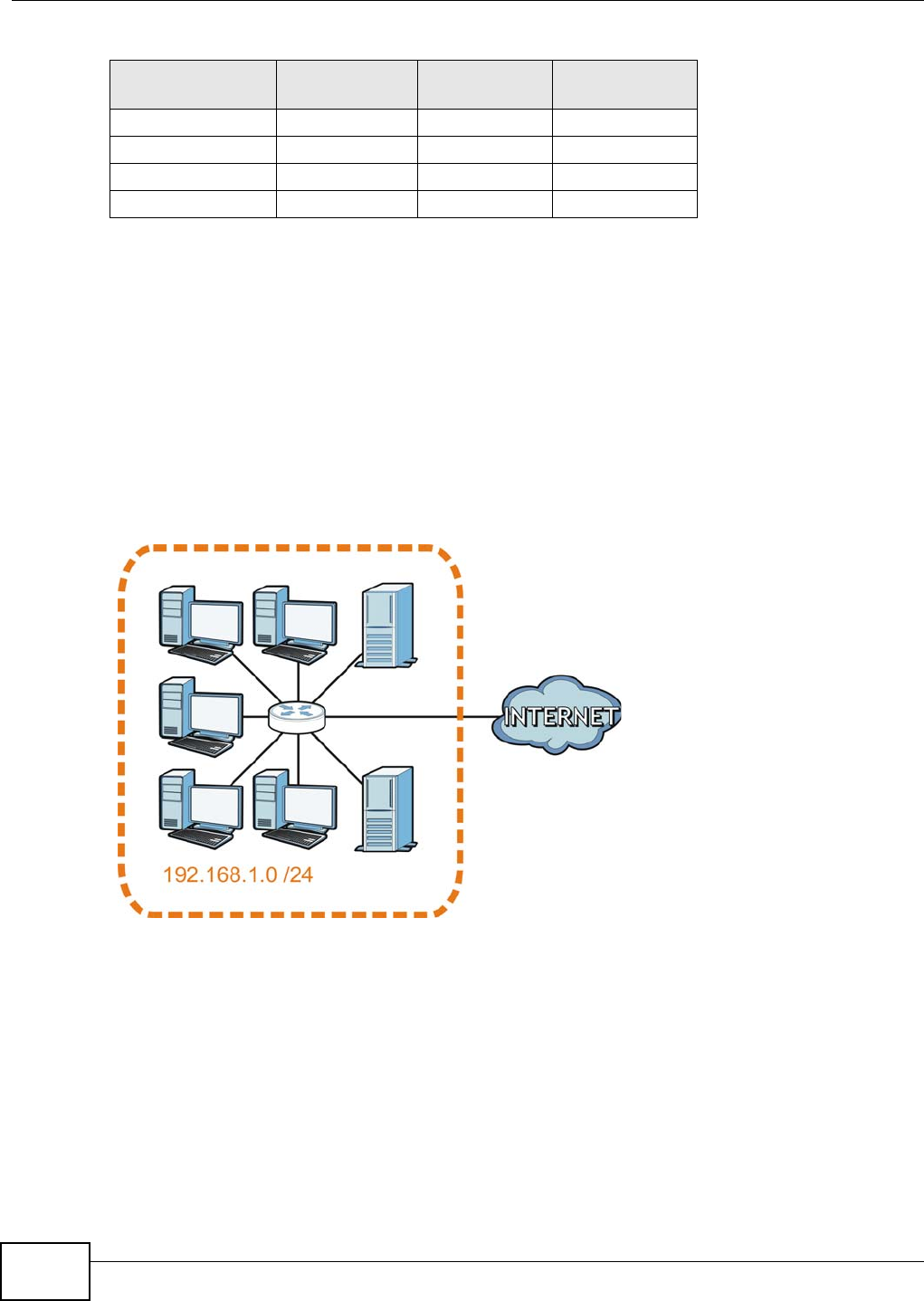
Appendix B IP Addresses and Subnetting
NBG-419N v2 User’s Guide
214
Subnetting
You can use subnetting to divide one network into multiple sub-networks. In the following example
a network administrator creates two sub-networks to isolate a group of servers from the rest of the
company network for security reasons.
In this example, the company network address is 192.168.1.0. The first three octets of the address
(192.168.1) are the network number, and the remaining octet is the host ID, allowing a maximum
of 28 – 2 or 254 possible hosts.
The following figure shows the company network before subnetting.
Figure 154 Subnetting Example: Before Subnetting
You can “borrow” one of the host ID bits to divide the network 192.168.1.0 into two separate sub-
networks. The subnet mask is now 25 bits (255.255.255.128 or /25).
The “borrowed” host ID bit can have a value of either 0 or 1, allowing two subnets; 192.168.1.0 /25
and 192.168.1.128 /25.
255.255.255.224 /27 1110 0000 224
255.255.255.240 /28 1111 0000 240
255.255.255.248 /29 1111 1000 248
255.255.255.252 /30 1111 1100 252
Table 87 Alternative Subnet Mask Notation (continued)
SUBNET MASK ALTERNATIVE
NOTATION LAST OCTET
(BINARY) LAST OCTET
(DECIMAL)
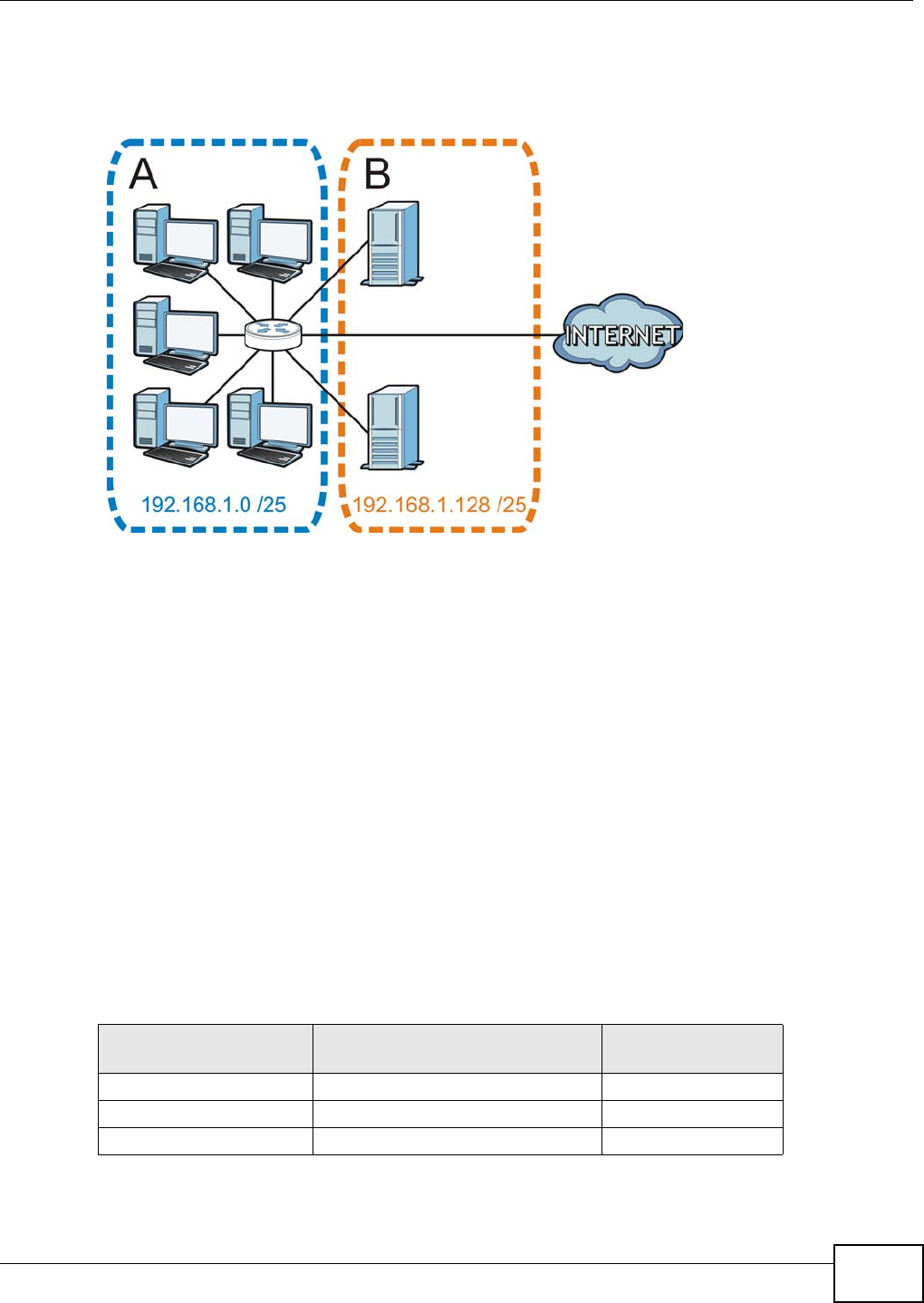
Appendix B IP Addresses and Subnetting
NBG-419N v2 User’s Guide 215
The following figure shows the company network after subnetting. There are now two sub-
networks, A and B.
Figure 155 Subnetting Example: After Subnetting
In a 25-bit subnet the host ID has 7 bits, so each sub-network has a maximum of 27 – 2 or 126
possible hosts (a host ID of all zeroes is the subnet’s address itself, all ones is the subnet’s
broadcast address).
192.168.1.0 with mask 255.255.255.128 is subnet A itself, and 192.168.1.127 with mask
255.255.255.128 is its broadcast address. Therefore, the lowest IP address that can be assigned to
an actual host for subnet A is 192.168.1.1 and the highest is 192.168.1.126.
Similarly, the host ID range for subnet B is 192.168.1.129 to 192.168.1.254.
Example: Four Subnets
The previous example illustrated using a 25-bit subnet mask to divide a 24-bit address into two
subnets. Similarly, to divide a 24-bit address into four subnets, you need to “borrow” two host ID
bits to give four possible combinations (00, 01, 10 and 11). The subnet mask is 26 bits
(11111111.11111111.11111111.11000000) or 255.255.255.192.
Each subnet contains 6 host ID bits, giving 26 - 2 or 62 hosts for each subnet (a host ID of all
zeroes is the subnet itself, all ones is the subnet’s broadcast address).
Table 88 Subnet 1
IP/SUBNET MASK NETWORK NUMBER LAST OCTET BIT
VALUE
IP Address (Decimal) 192.168.1. 0
IP Address (Binary) 11000000.10101000.00000001. 00000000
Subnet Mask (Binary) 11111111.11111111.11111111. 11000000
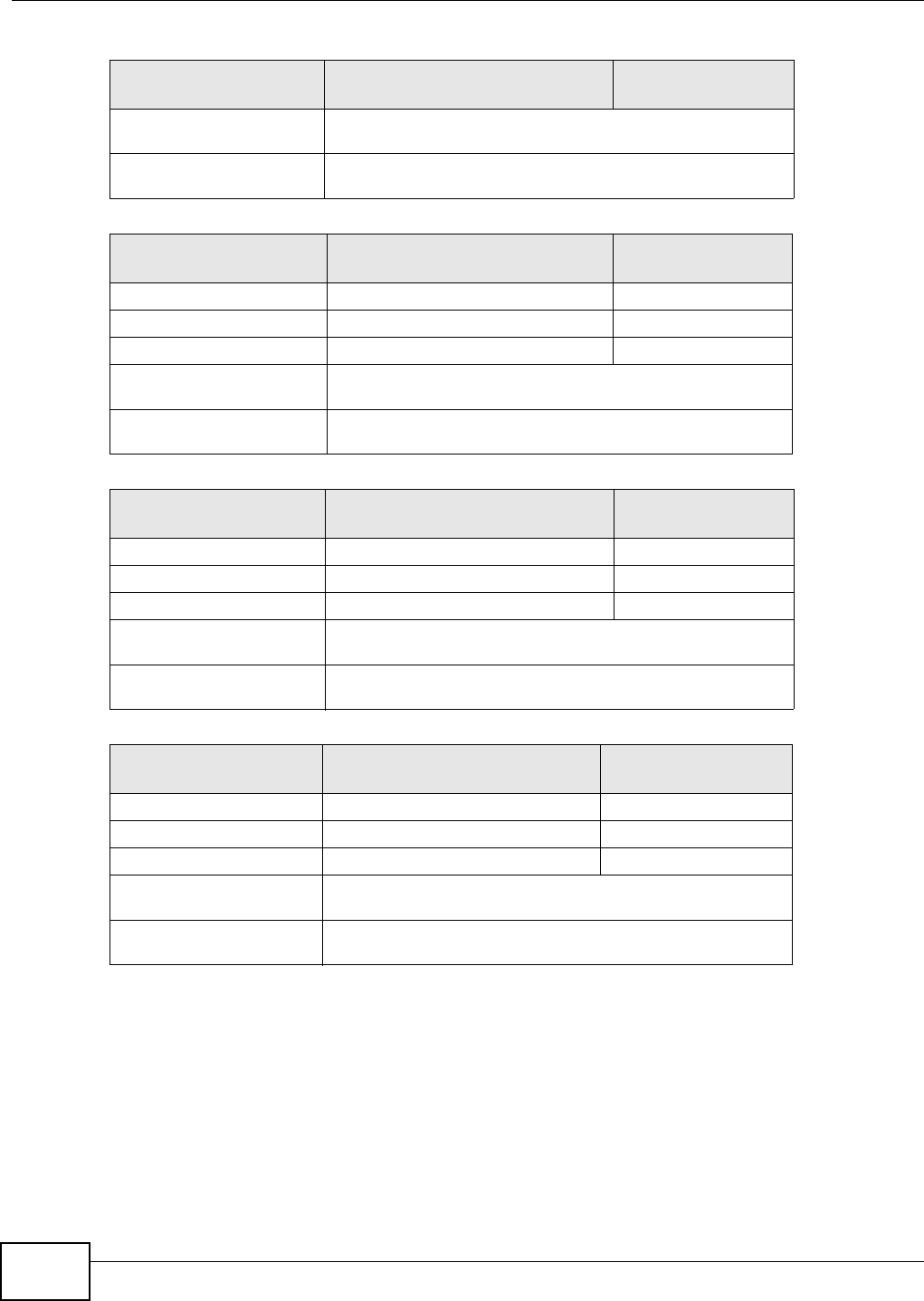
Appendix B IP Addresses and Subnetting
NBG-419N v2 User’s Guide
216
Example: Eight Subnets
Similarly, use a 27-bit mask to create eight subnets (000, 001, 010, 011, 100, 101, 110 and 111).
Subnet Address:
192.168.1.0
Lowest Host ID: 192.168.1.1
Broadcast Address:
192.168.1.63
Highest Host ID: 192.168.1.62
Table 89 Subnet 2
IP/SUBNET MASK NETWORK NUMBER LAST OCTET BIT
VALUE
IP Address 192.168.1. 64
IP Address (Binary) 11000000.10101000.00000001. 01000000
Subnet Mask (Binary) 11111111.11111111.11111111. 11000000
Subnet Address:
192.168.1.64
Lowest Host ID: 192.168.1.65
Broadcast Address:
192.168.1.127
Highest Host ID: 192.168.1.126
Table 90 Subnet 3
IP/SUBNET MASK NETWORK NUMBER LAST OCTET BIT
VALUE
IP Address 192.168.1. 128
IP Address (Binary) 11000000.10101000.00000001. 10000000
Subnet Mask (Binary) 11111111.11111111.11111111. 11000000
Subnet Address:
192.168.1.128
Lowest Host ID: 192.168.1.129
Broadcast Address:
192.168.1.191
Highest Host ID: 192.168.1.190
Table 91 Subnet 4
IP/SUBNET MASK NETWORK NUMBER LAST OCTET BIT
VALUE
IP Address 192.168.1. 192
IP Address (Binary) 11000000.10101000.00000001. 11000000
Subnet Mask (Binary) 11111111.11111111.11111111. 11000000
Subnet Address:
192.168.1.192
Lowest Host ID: 192.168.1.193
Broadcast Address:
192.168.1.255
Highest Host ID: 192.168.1.254
Table 88 Subnet 1 (continued)
IP/SUBNET MASK NETWORK NUMBER LAST OCTET BIT
VALUE
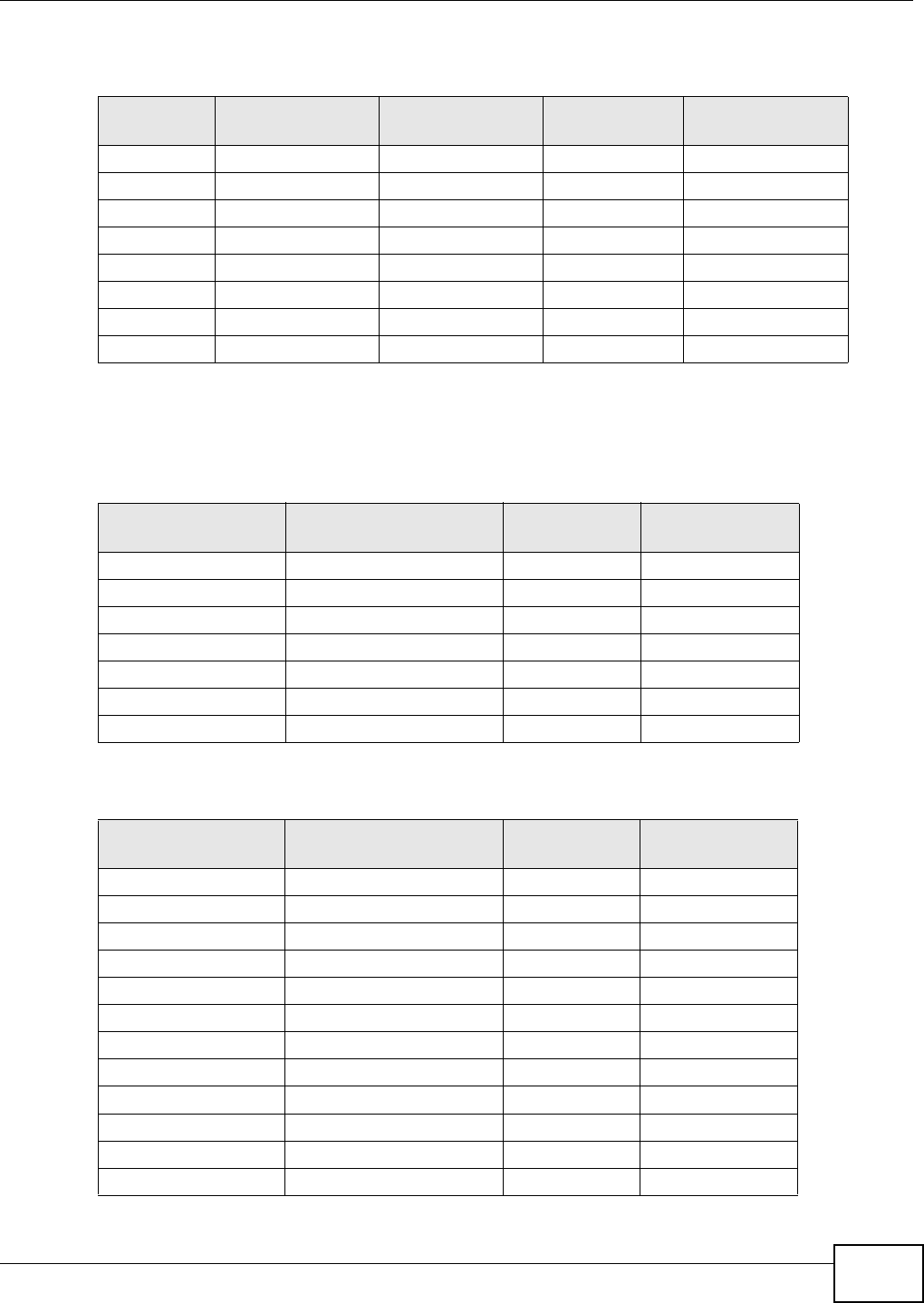
Appendix B IP Addresses and Subnetting
NBG-419N v2 User’s Guide 217
The following table shows IP address last octet values for each subnet.
Subnet Planning
The following table is a summary for subnet planning on a network with a 24-bit network number.
The following table is a summary for subnet planning on a network with a 16-bit network number.
Table 92 Eight Subnets
SUBNET SUBNET
ADDRESS FIRST ADDRESS LAST
ADDRESS BROADCAST
ADDRESS
1 0 1 30 31
232 33 62 63
364 65 94 95
496 97 126 127
5128 129 158 159
6160 161 190 191
7192 193 222 223
8224 225 254 255
Table 93 24-bit Network Number Subnet Planning
NO. “BORROWED”
HOST BITS SUBNET MASK NO. SUBNETS NO. HOSTS PER
SUBNET
1255.255.255.128 (/25) 2126
2255.255.255.192 (/26) 462
3255.255.255.224 (/27) 830
4255.255.255.240 (/28) 16 14
5255.255.255.248 (/29) 32 6
6255.255.255.252 (/30) 64 2
7255.255.255.254 (/31) 128 1
Table 94 16-bit Network Number Subnet Planning
NO. “BORROWED”
HOST BITS SUBNET MASK NO. SUBNETS NO. HOSTS PER
SUBNET
1255.255.128.0 (/17) 232766
2255.255.192.0 (/18) 416382
3255.255.224.0 (/19) 88190
4255.255.240.0 (/20) 16 4094
5255.255.248.0 (/21) 32 2046
6255.255.252.0 (/22) 64 1022
7255.255.254.0 (/23) 128 510
8255.255.255.0 (/24) 256 254
9255.255.255.128 (/25) 512 126
10 255.255.255.192 (/26) 1024 62
11 255.255.255.224 (/27) 2048 30
12 255.255.255.240 (/28) 4096 14

Appendix B IP Addresses and Subnetting
NBG-419N v2 User’s Guide
218
Configuring IP Addresses
Where you obtain your network number depends on your particular situation. If the ISP or your
network administrator assigns you a block of registered IP addresses, follow their instructions in
selecting the IP addresses and the subnet mask.
If the ISP did not explicitly give you an IP network number, then most likely you have a single user
account and the ISP will assign you a dynamic IP address when the connection is established. If this
is the case, it is recommended that you select a network number from 192.168.0.0 to
192.168.255.0. The Internet Assigned Number Authority (IANA) reserved this block of addresses
specifically for private use; please do not use any other number unless you are told otherwise. You
must also enable Network Address Translation (NAT) on the Router.
Once you have decided on the network number, pick an IP address for your Router that is easy to
remember (for instance, 192.168.1.1) but make sure that no other device on your network is using
that IP address.
The subnet mask specifies the network number portion of an IP address. Your Router will compute
the subnet mask automatically based on the IP address that you entered. You don't need to change
the subnet mask computed by the Router unless you are instructed to do otherwise.
Private IP Addresses
Every machine on the Internet must have a unique address. If your networks are isolated from the
Internet (running only between two branch offices, for example) you can assign any IP addresses to
the hosts without problems. However, the Internet Assigned Numbers Authority (IANA) has
reserved the following three blocks of IP addresses specifically for private networks:
• 10.0.0.0 — 10.255.255.255
• 172.16.0.0 — 172.31.255.255
• 192.168.0.0 — 192.168.255.255
You can obtain your IP address from the IANA, from an ISP, or it can be assigned from a private
network. If you belong to a small organization and your Internet access is through an ISP, the ISP
can provide you with the Internet addresses for your local networks. On the other hand, if you are
part of a much larger organization, you should consult your network administrator for the
appropriate IP addresses.
Regardless of your particular situation, do not create an arbitrary IP address; always follow the
guidelines above. For more information on address assignment, please refer to RFC 1597, Address
Allocation for Private Internets and RFC 1466, Guidelines for Management of IP Address Space.
13 255.255.255.248 (/29) 8192 6
14 255.255.255.252 (/30) 16384 2
15 255.255.255.254 (/31) 32768 1
Table 94 16-bit Network Number Subnet Planning (continued)
NO. “BORROWED”
HOST BITS SUBNET MASK NO. SUBNETS NO. HOSTS PER
SUBNET
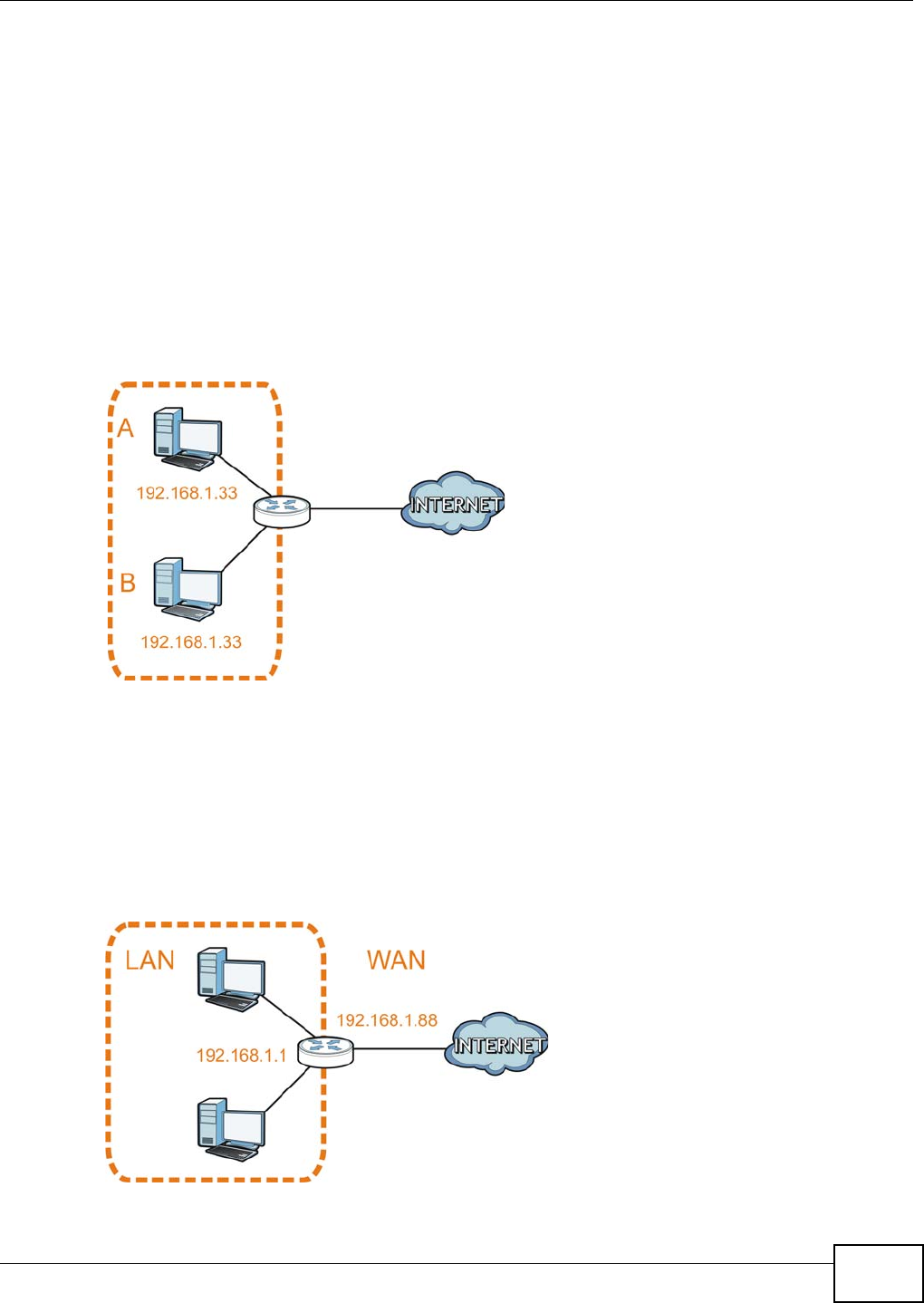
Appendix B IP Addresses and Subnetting
NBG-419N v2 User’s Guide 219
IP Address Conflicts
Each device on a network must have a unique IP address. Devices with duplicate IP addresses on
the same network will not be able to access the Internet or other resources. The devices may also
be unreachable through the network.
Conflicting Computer IP Addresses Example
More than one device can not use the same IP address. In the following example computer A has a
static (or fixed) IP address that is the same as the IP address that a DHCP server assigns to
computer B which is a DHCP client. Neither can access the Internet. This problem can be solved by
assigning a different static IP address to computer A or setting computer A to obtain an IP address
automatically.
Figure 156 Conflicting Computer IP Addresses Example
Conflicting Router IP Addresses Example
Since a router connects different networks, it must have interfaces using different network
numbers. For example, if a router is set between a LAN and the Internet (WAN), the router’s LAN
and WAN addresses must be on different subnets. In the following example, the LAN and WAN are
on the same subnet. The LAN computers cannot access the Internet because the router cannot
route between networks.
Figure 157 Conflicting Router IP Addresses Example
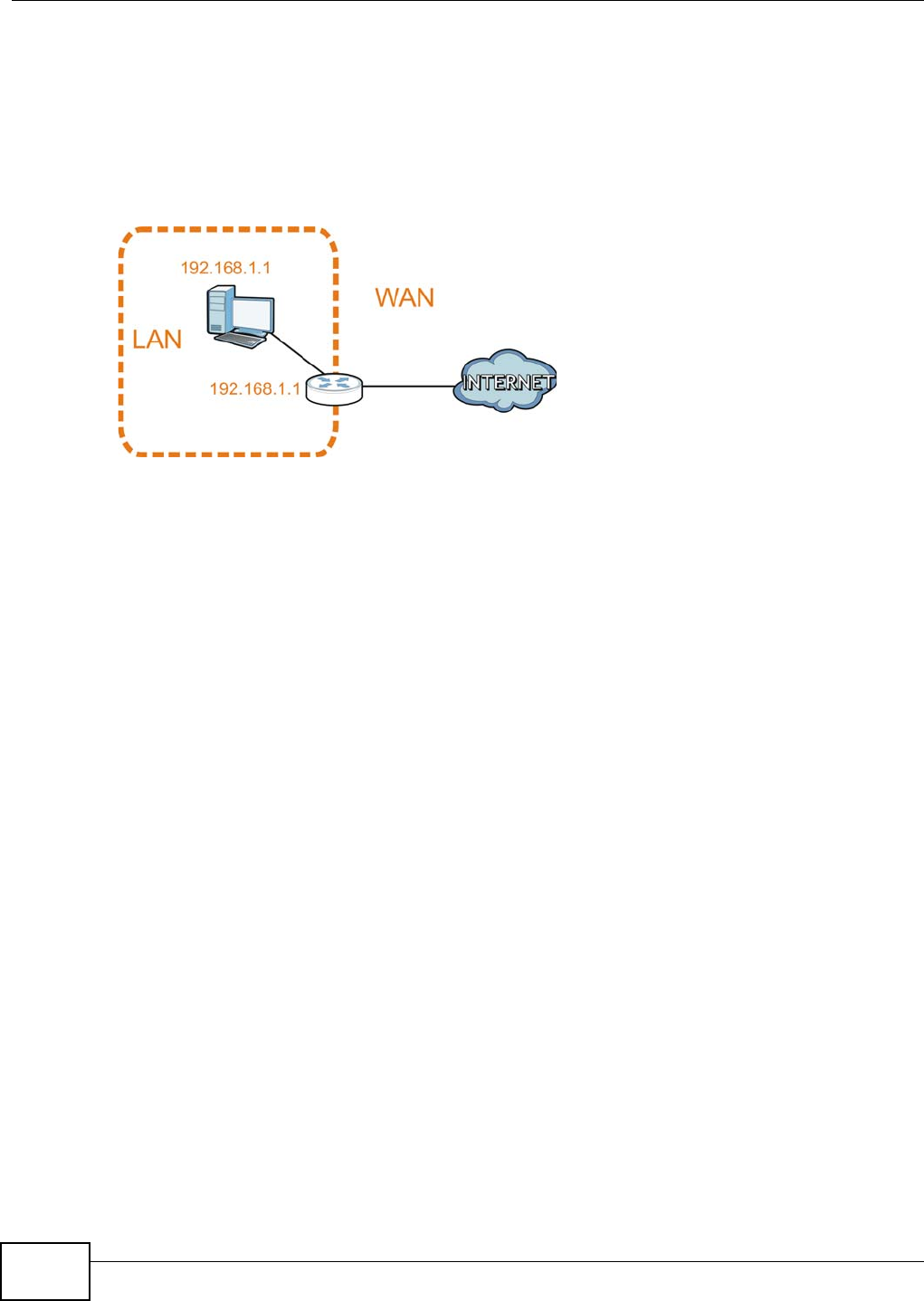
Appendix B IP Addresses and Subnetting
NBG-419N v2 User’s Guide
220
Conflicting Computer and Router IP Addresses Example
More than one device can not use the same IP address. In the following example, the computer and
the router’s LAN port both use 192.168.1.1 as the IP address. The computer cannot access the
Internet. This problem can be solved by assigning a different IP address to the computer or the
router’s LAN port.
Figure 158 Conflicting Computer and Router IP Addresses Example

NBG-419N v2 User’s Guide 221
APPENDIX C
Setting Up Your Computer’s IP Address
Note: Your specific Router may not support all of the operating systems described in this
appendix. See the product specifications for more information about which
operating systems are supported.
This appendix shows you how to configure the IP settings on your computer in order for it to be
able to communicate with the other devices on your network. Windows Vista/XP/2000, Mac OS 9/
OS X, and all versions of UNIX/LINUX include the software components you need to use TCP/IP on
your computer.
If you manually assign IP information instead of using a dynamic IP, make sure that your network’s
computers have IP addresses that place them in the same subnet.
In this appendix, you can set up an IP address for:
•Windows XP/NT/2000 on page 222
•Windows Vista on page 225
•Windows 7 on page 229
•Mac OS X: 10.3 and 10.4 on page 233
•Mac OS X: 10.5 and 10.6 on page 236
•Linux: Ubuntu 8 (GNOME) on page 239
•Linux: openSUSE 10.3 (KDE) on page 243
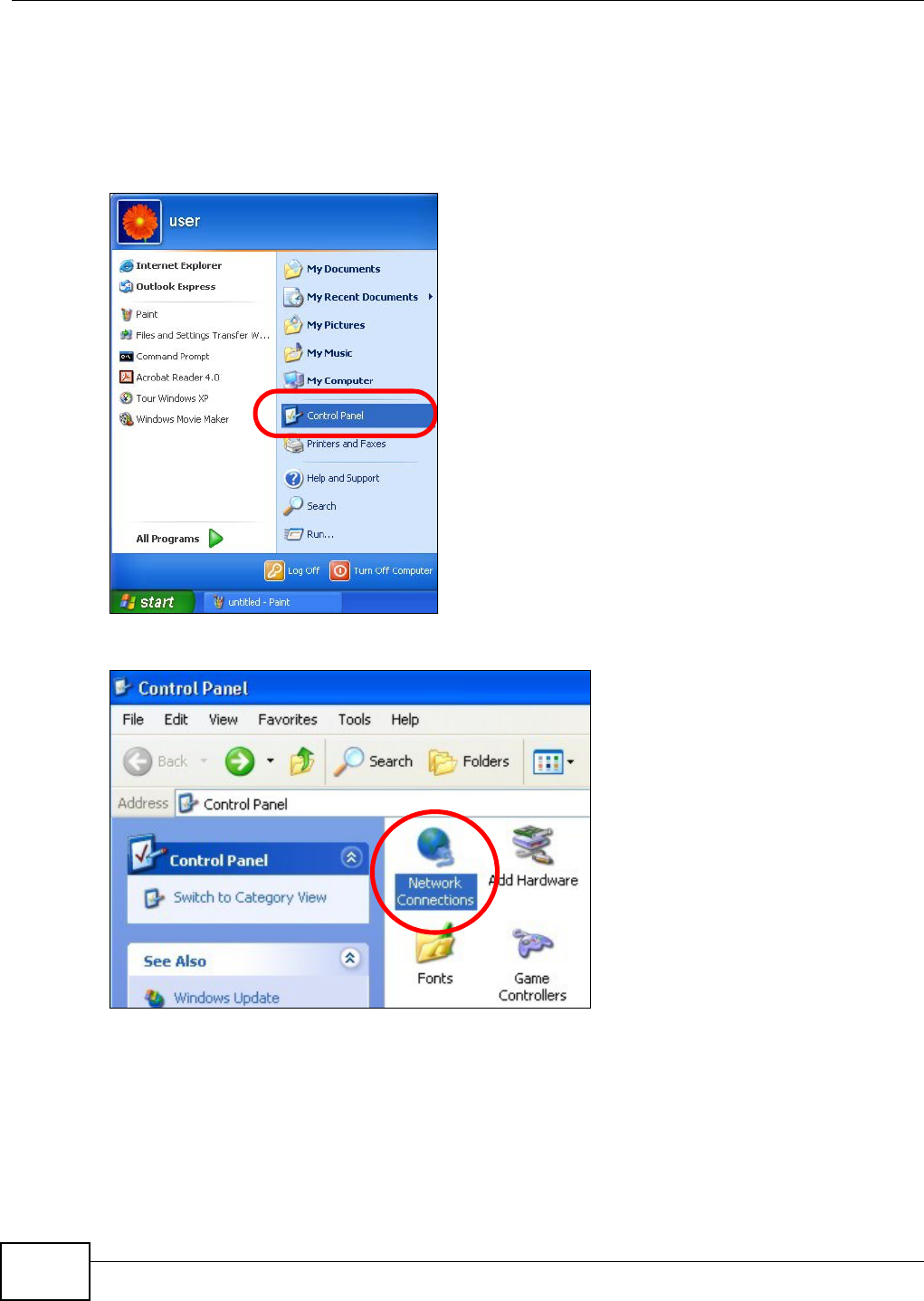
Appendix C Setting Up Your Computer’s IP Address
NBG-419N v2 User’s Guide
222
Windows XP/NT/2000
The following example uses the default Windows XP display theme but can also apply to Windows
2000 and Windows NT.
1Click Start > Control Panel.
2In the Control Panel, click the Network Connections icon.
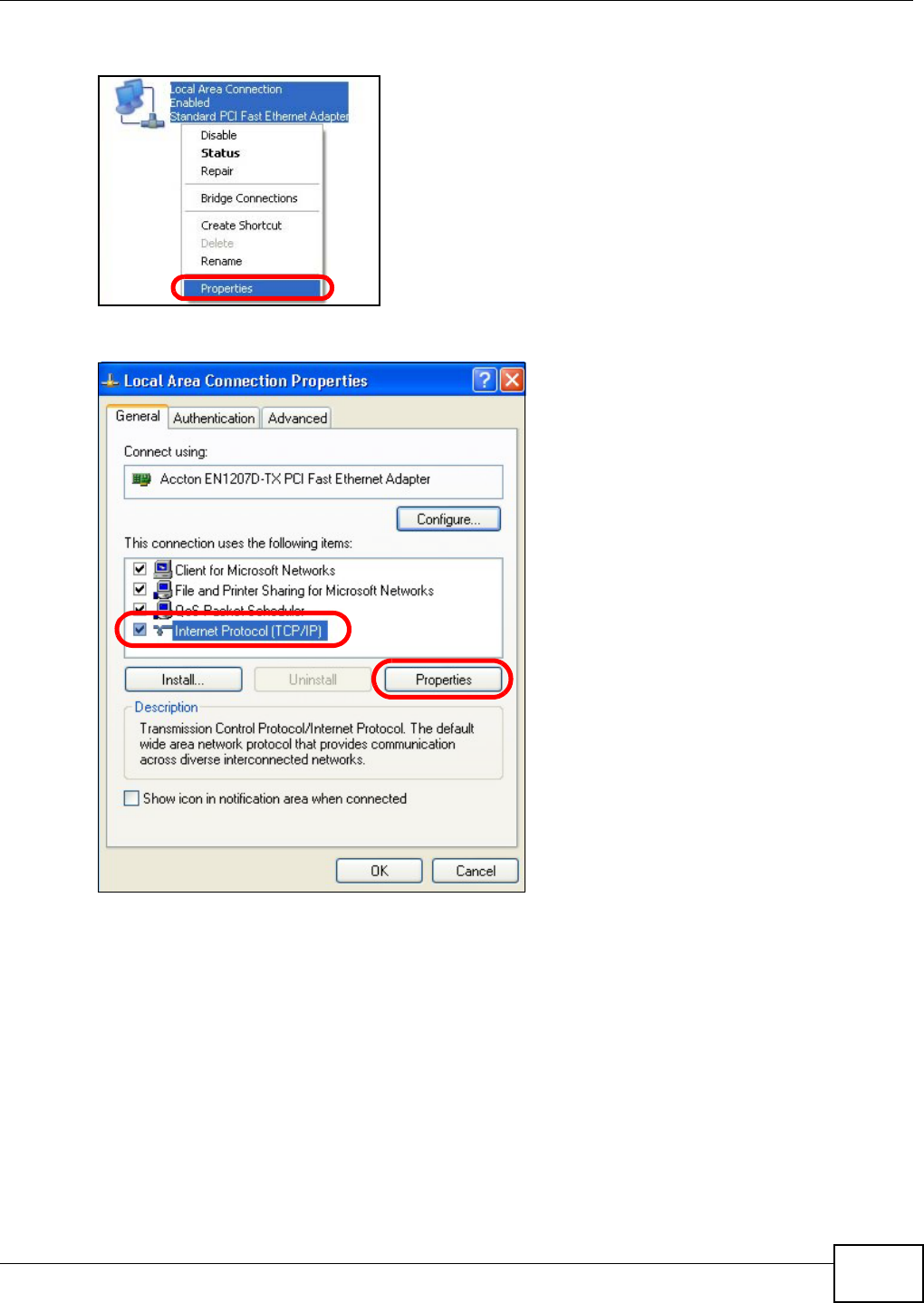
Appendix C Setting Up Your Computer’s IP Address
NBG-419N v2 User’s Guide 223
3Right-click Local Area Connection and then select Properties.
4On the General tab, select Internet Protocol (TCP/IP) and then click Properties.
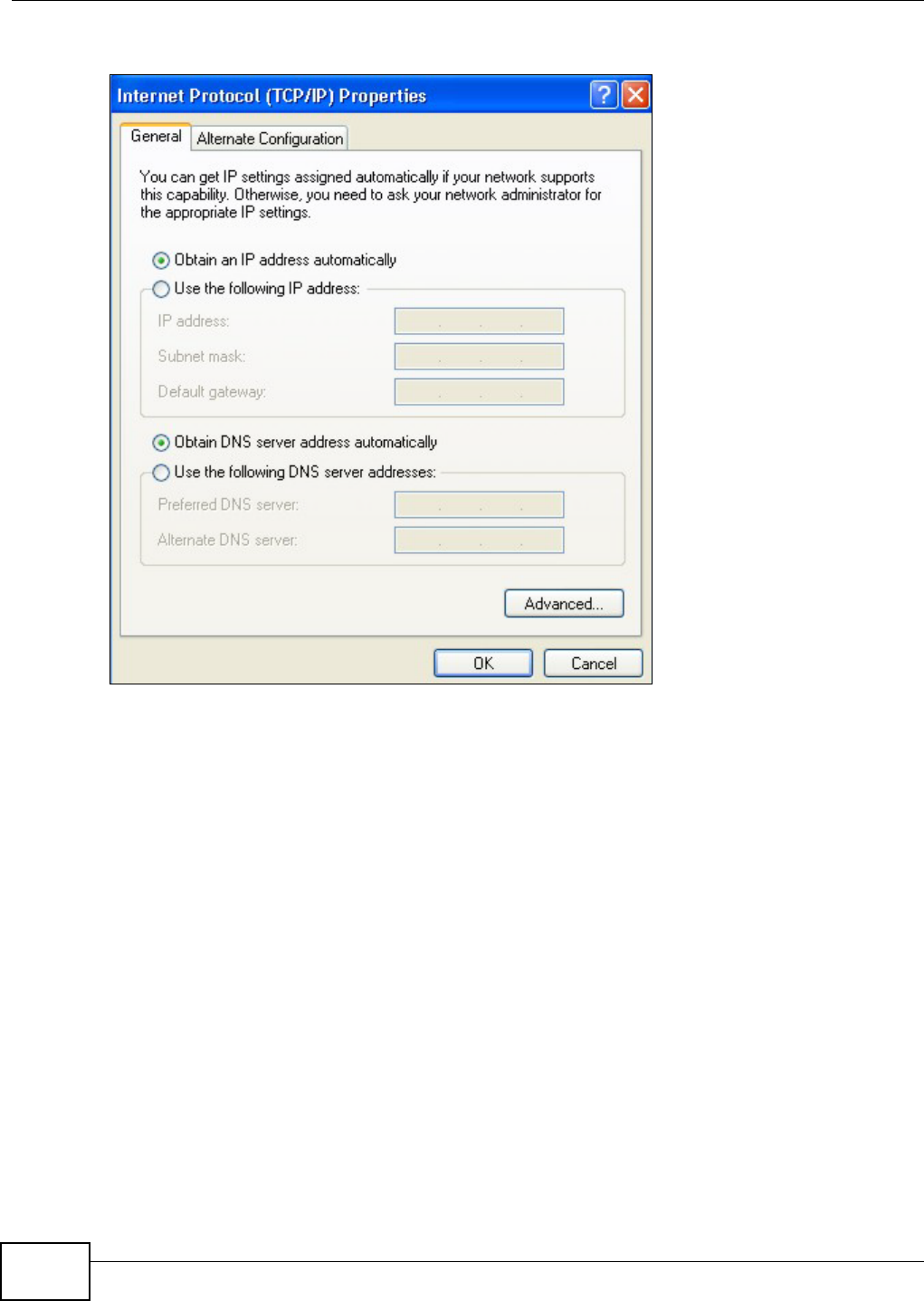
Appendix C Setting Up Your Computer’s IP Address
NBG-419N v2 User’s Guide
224
5The Internet Protocol TCP/IP Properties window opens.
6Select Obtain an IP address automatically if your network administrator or ISP assigns your IP
address dynamically.
Select Use the following IP Address and fill in the IP address, Subnet mask, and Default
gateway fields if you have a static IP address that was assigned to you by your network
administrator or ISP. You may also have to enter a Preferred DNS server and an Alternate DNS
server, if that information was provided.
7Click OK to close the Internet Protocol (TCP/IP) Properties window.
8Click OK to close the Local Area Connection Properties window.
Verifying Settings
1Click Start > All Programs > Accessories > Command Prompt.
2In the Command Prompt window, type "ipconfig" and then press [ENTER].
You can also go to Start > Control Panel > Network Connections, right-click a network
connection, click Status and then click the Support tab to view your IP address and connection
information.
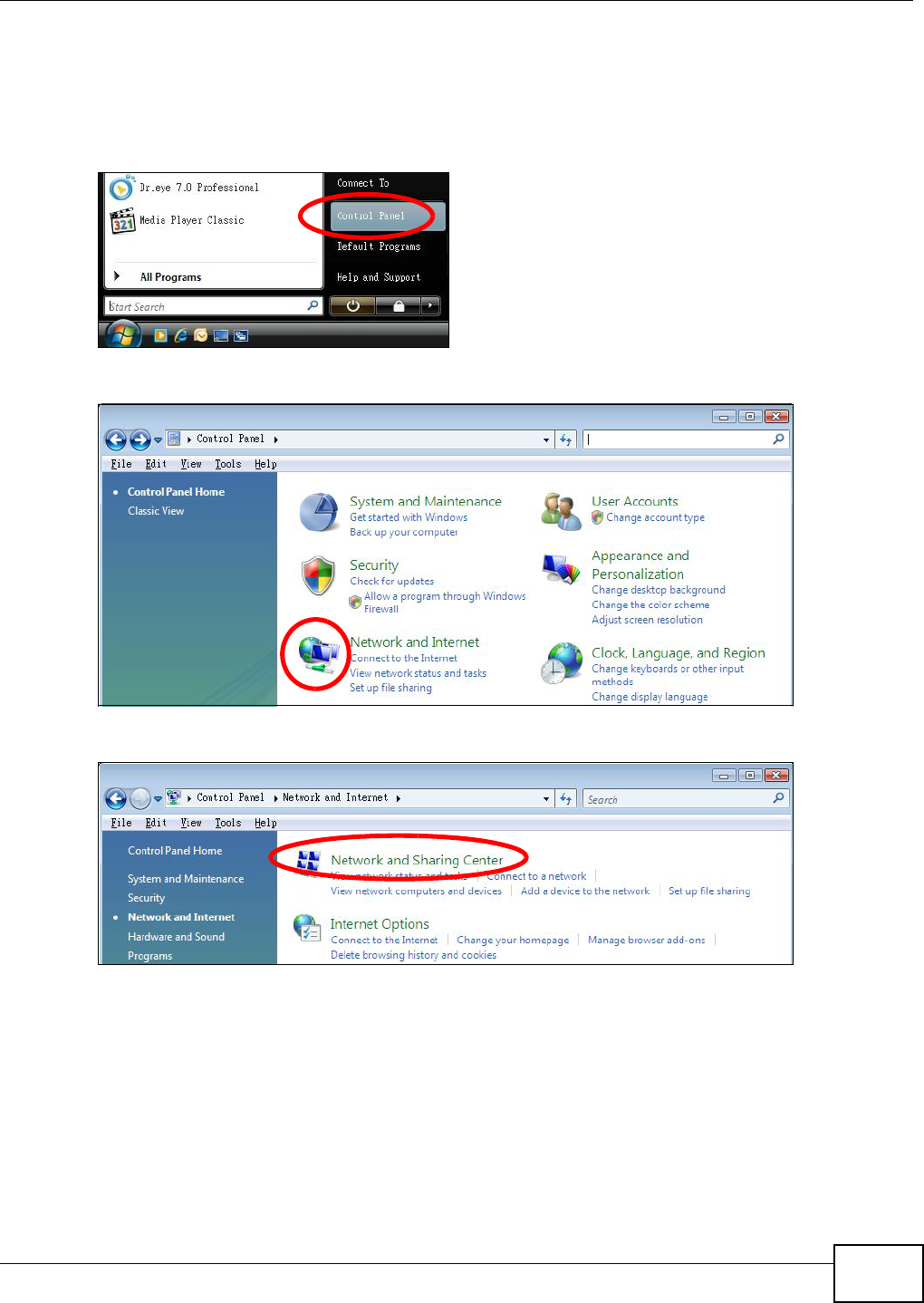
Appendix C Setting Up Your Computer’s IP Address
NBG-419N v2 User’s Guide 225
Windows Vista
This section shows screens from Windows Vista Professional.
1Click Start > Control Panel.
2In the Control Panel, click the Network and Internet icon.
3Click the Network and Sharing Center icon.
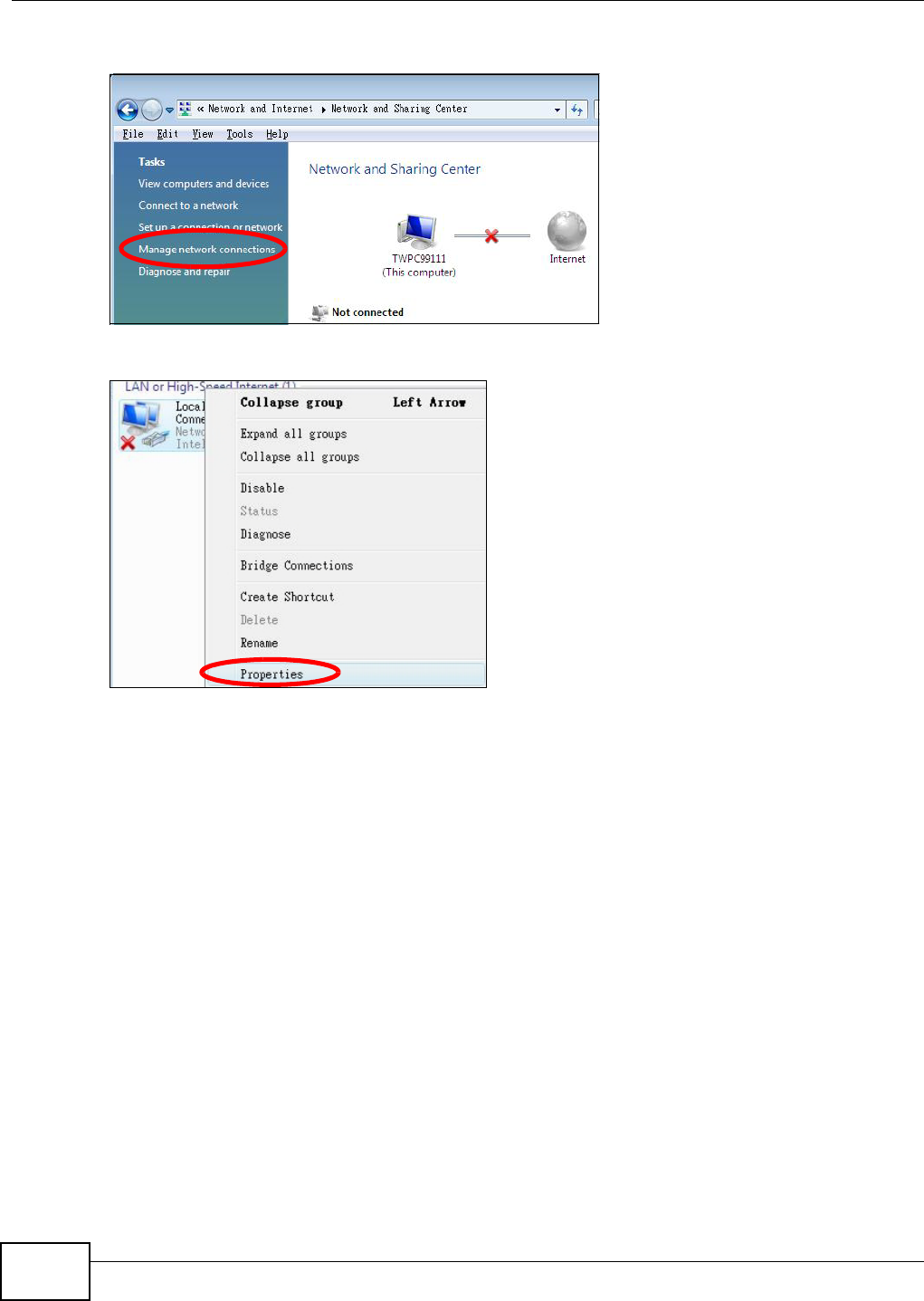
Appendix C Setting Up Your Computer’s IP Address
NBG-419N v2 User’s Guide
226
4Click Manage network connections.
5Right-click Local Area Connection and then select Properties.
Note: During this procedure, click Continue whenever Windows displays a screen saying
that it needs your permission to continue.
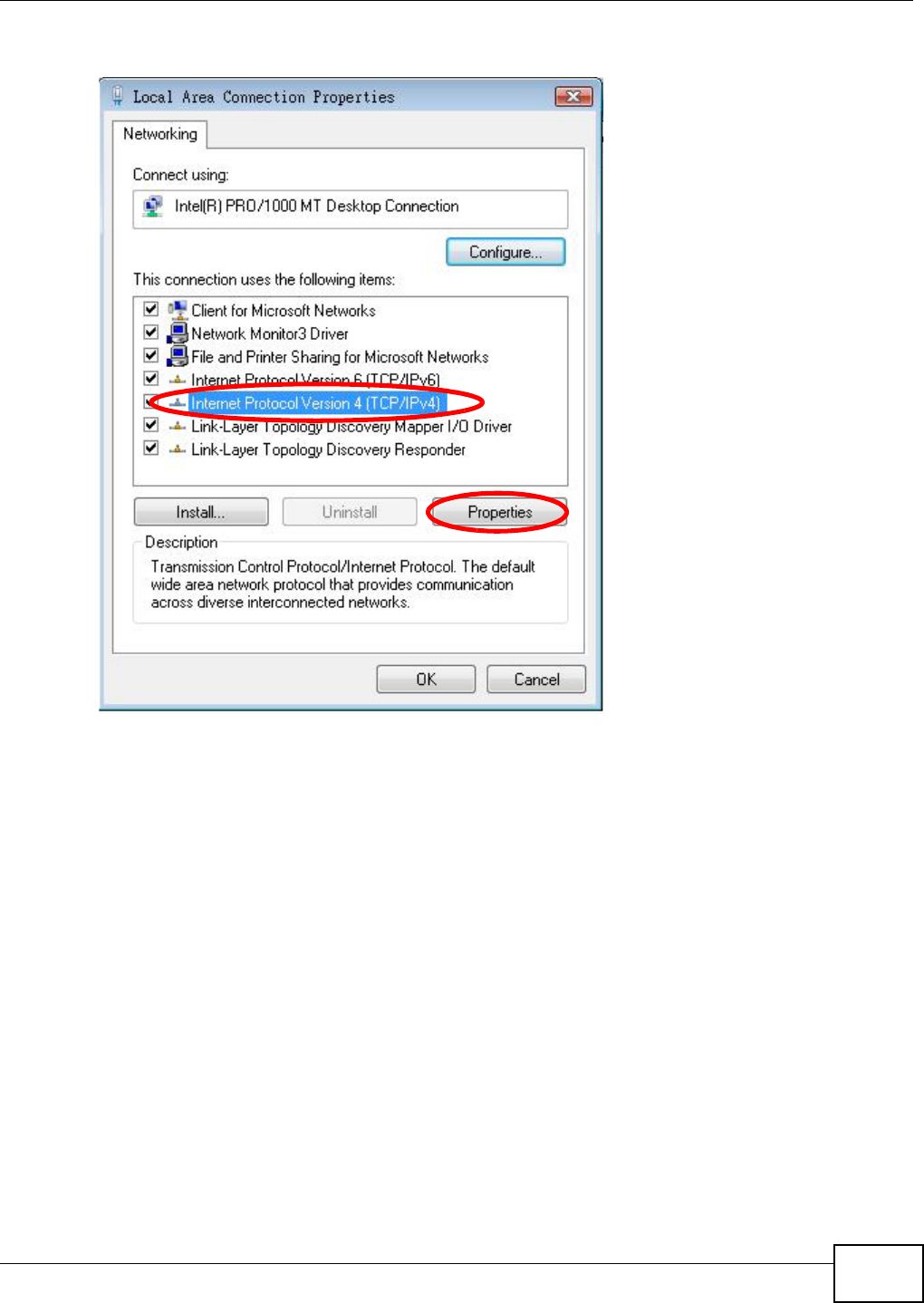
Appendix C Setting Up Your Computer’s IP Address
NBG-419N v2 User’s Guide 227
6Select Internet Protocol Version 4 (TCP/IPv4) and then select Properties.
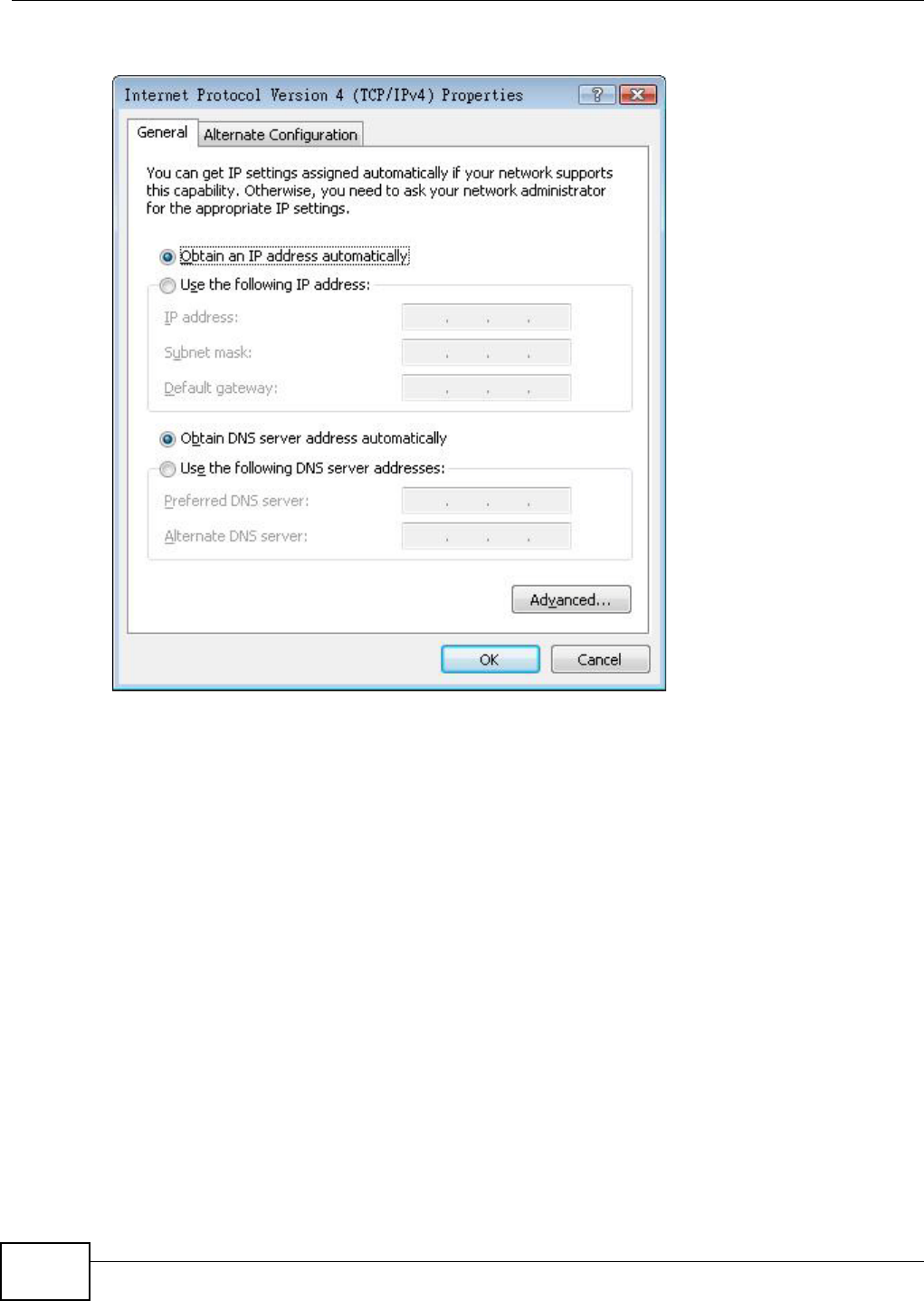
Appendix C Setting Up Your Computer’s IP Address
NBG-419N v2 User’s Guide
228
7The Internet Protocol Version 4 (TCP/IPv4) Properties window opens.
8Select Obtain an IP address automatically if your network administrator or ISP assigns your IP
address dynamically.
Select Use the following IP Address and fill in the IP address, Subnet mask, and Default
gateway fields if you have a static IP address that was assigned to you by your network
administrator or ISP. You may also have to enter a Preferred DNS server and an Alternate DNS
server, if that information was provided.Click Advanced.
9Click OK to close the Internet Protocol (TCP/IP) Properties window.
10 Click OK to close the Local Area Connection Properties window.
Verifying Settings
1Click Start > All Programs > Accessories > Command Prompt.
2In the Command Prompt window, type "ipconfig" and then press [ENTER].
You can also go to Start > Control Panel > Network Connections, right-click a network
connection, click Status and then click the Support tab to view your IP address and connection
information.
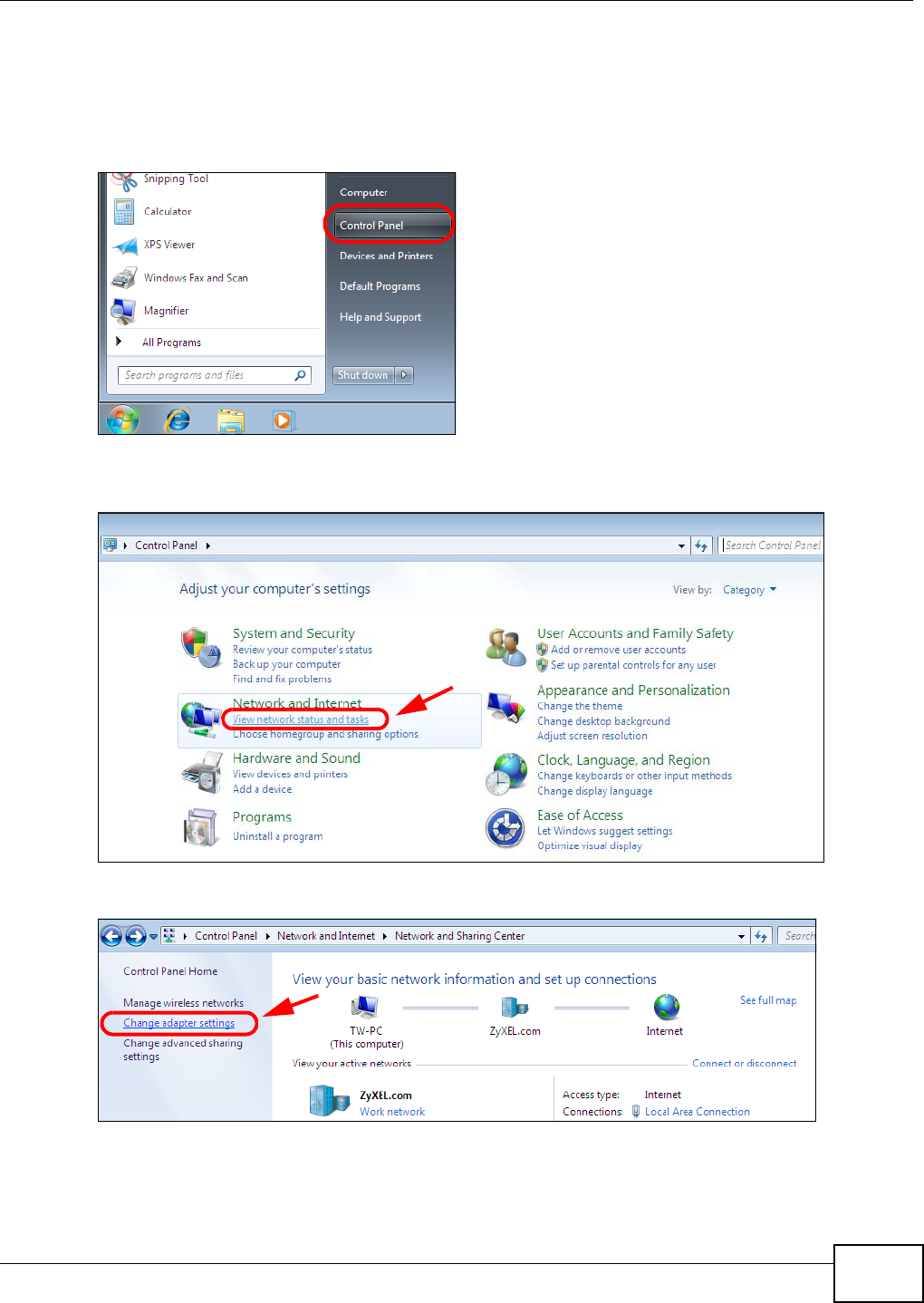
Appendix C Setting Up Your Computer’s IP Address
NBG-419N v2 User’s Guide 229
Windows 7
This section shows screens from Windows 7 Enterprise.
1Click Start > Control Panel.
2In the Control Panel, click View network status and tasks under the Network and Internet
category.
3Click Change adapter settings.
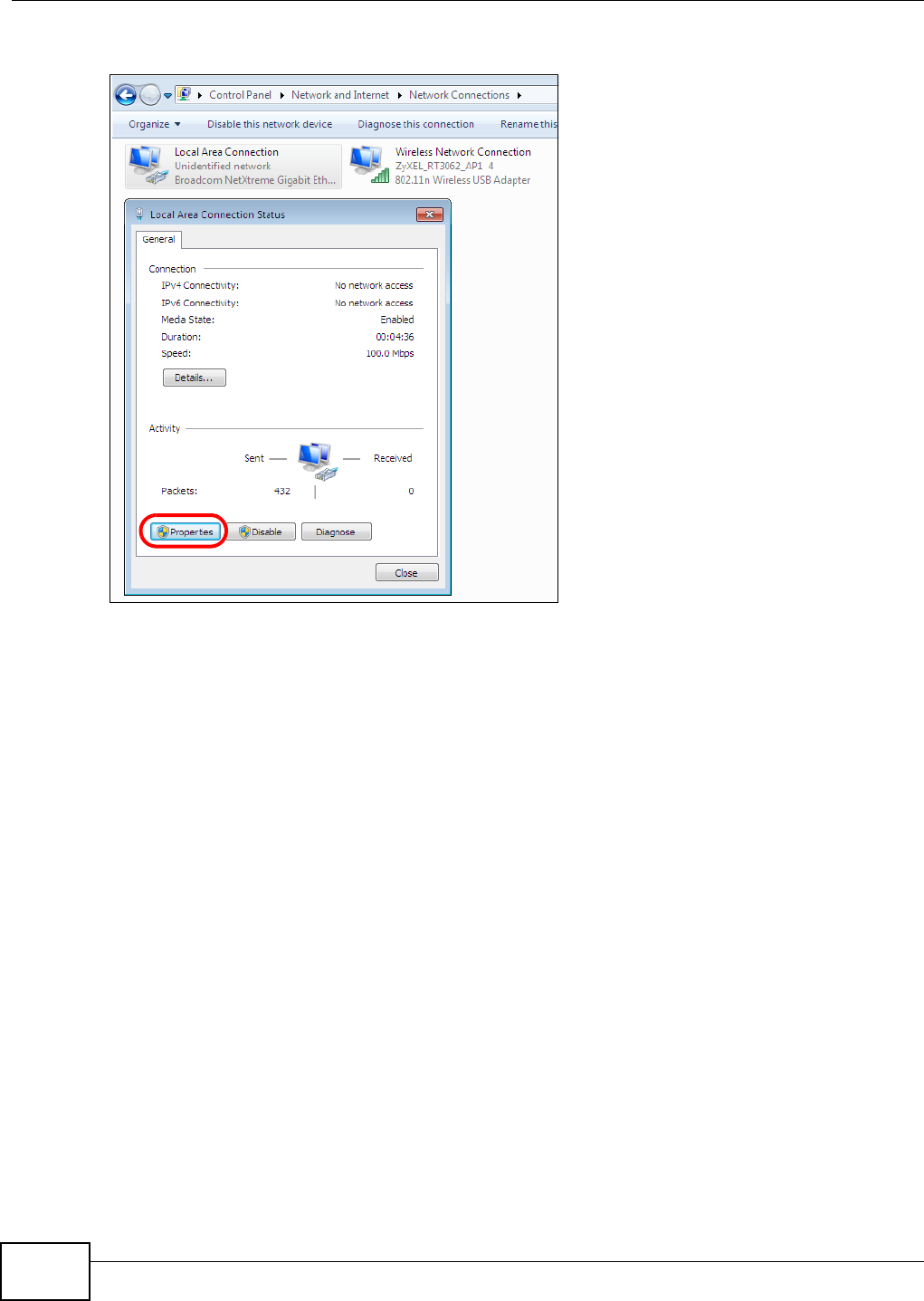
Appendix C Setting Up Your Computer’s IP Address
NBG-419N v2 User’s Guide
230
4Double click Local Area Connection and then select Properties.
Note: During this procedure, click Continue whenever Windows displays a screen saying
that it needs your permission to continue.
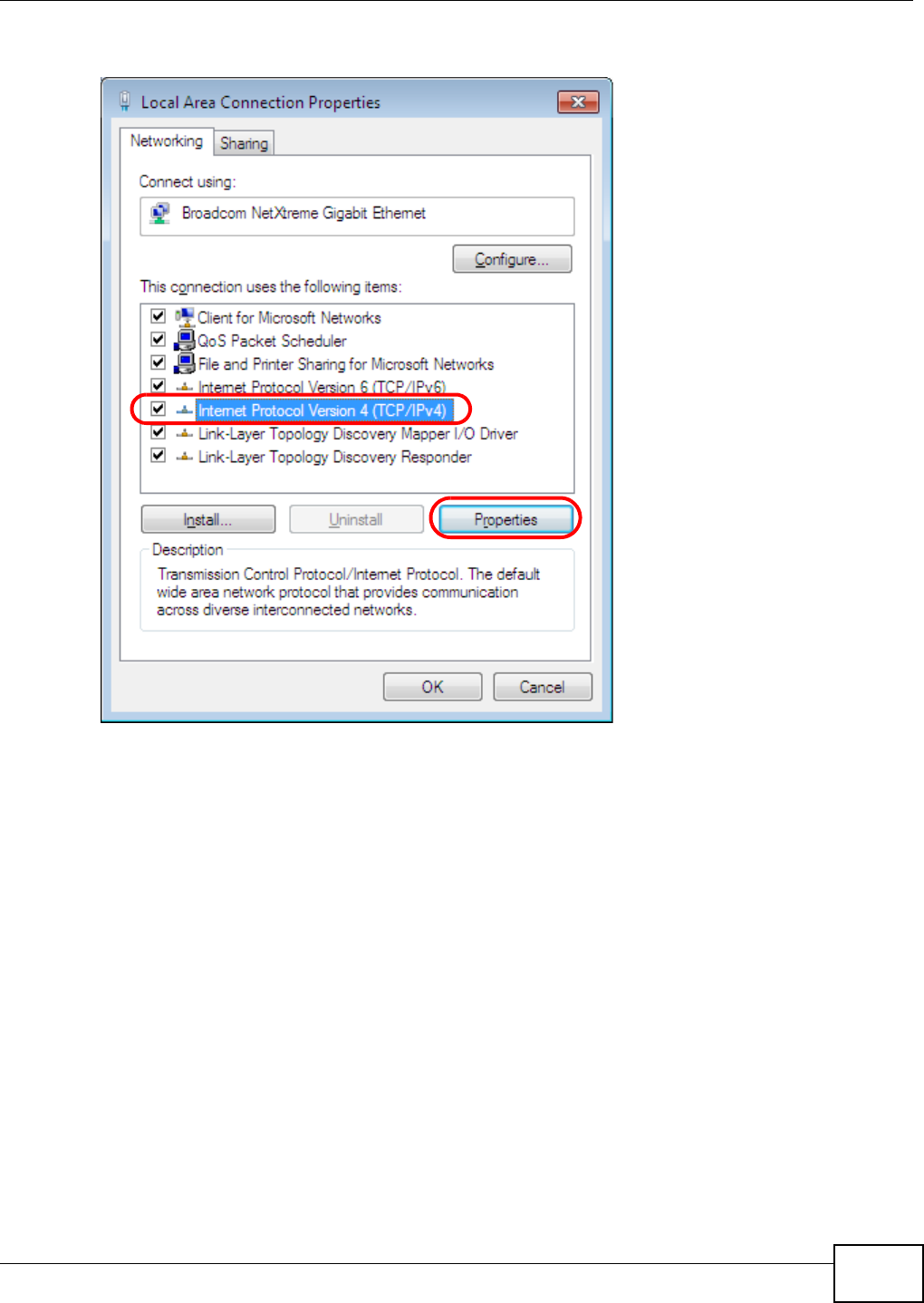
Appendix C Setting Up Your Computer’s IP Address
NBG-419N v2 User’s Guide 231
5Select Internet Protocol Version 4 (TCP/IPv4) and then select Properties.
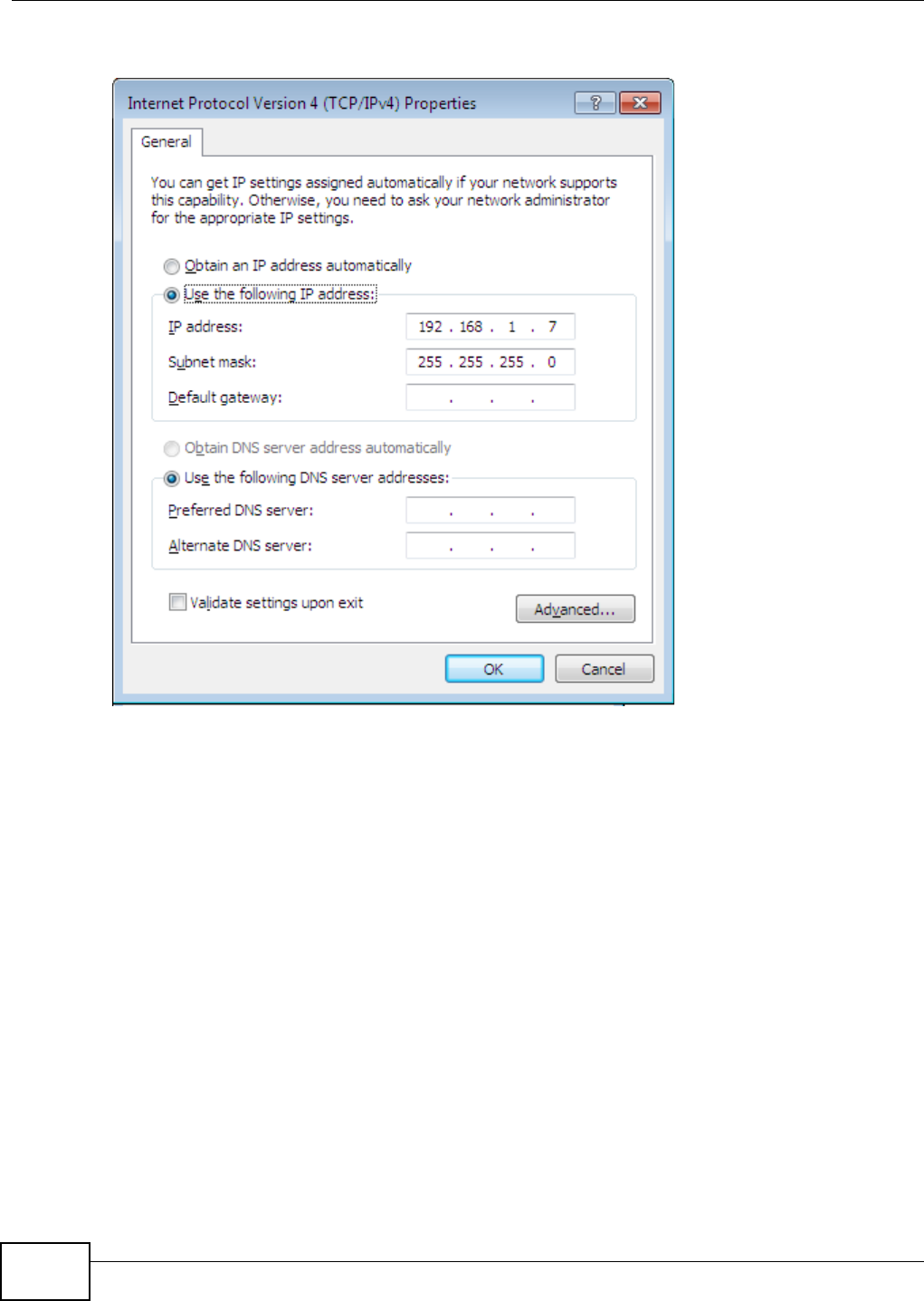
Appendix C Setting Up Your Computer’s IP Address
NBG-419N v2 User’s Guide
232
6The Internet Protocol Version 4 (TCP/IPv4) Properties window opens.
7Select Obtain an IP address automatically if your network administrator or ISP assigns your IP
address dynamically.
Select Use the following IP Address and fill in the IP address, Subnet mask, and Default
gateway fields if you have a static IP address that was assigned to you by your network
administrator or ISP. You may also have to enter a Preferred DNS server and an Alternate DNS
server, if that information was provided. Click Advanced if you want to configure advanced
settings for IP, DNS and WINS.
8Click OK to close the Internet Protocol (TCP/IP) Properties window.
9Click OK to close the Local Area Connection Properties window.
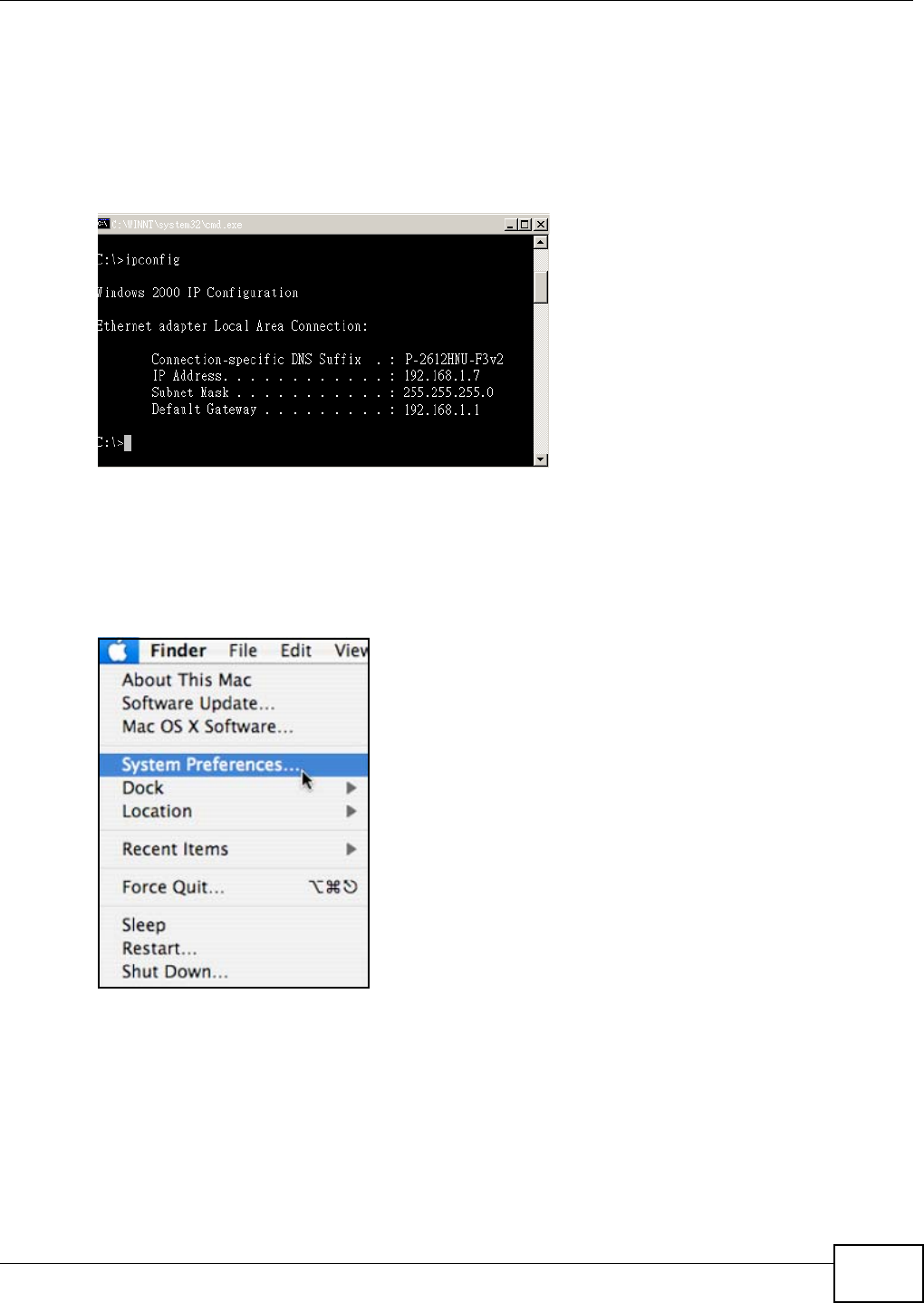
Appendix C Setting Up Your Computer’s IP Address
NBG-419N v2 User’s Guide 233
Verifying Settings
1Click Start > All Programs > Accessories > Command Prompt.
2In the Command Prompt window, type "ipconfig" and then press [ENTER].
3The IP settings are displayed as follows.
Mac OS X: 10.3 and 10.4
The screens in this section are from Mac OS X 10.4 but can also apply to 10.3.
1Click Apple > System Preferences.
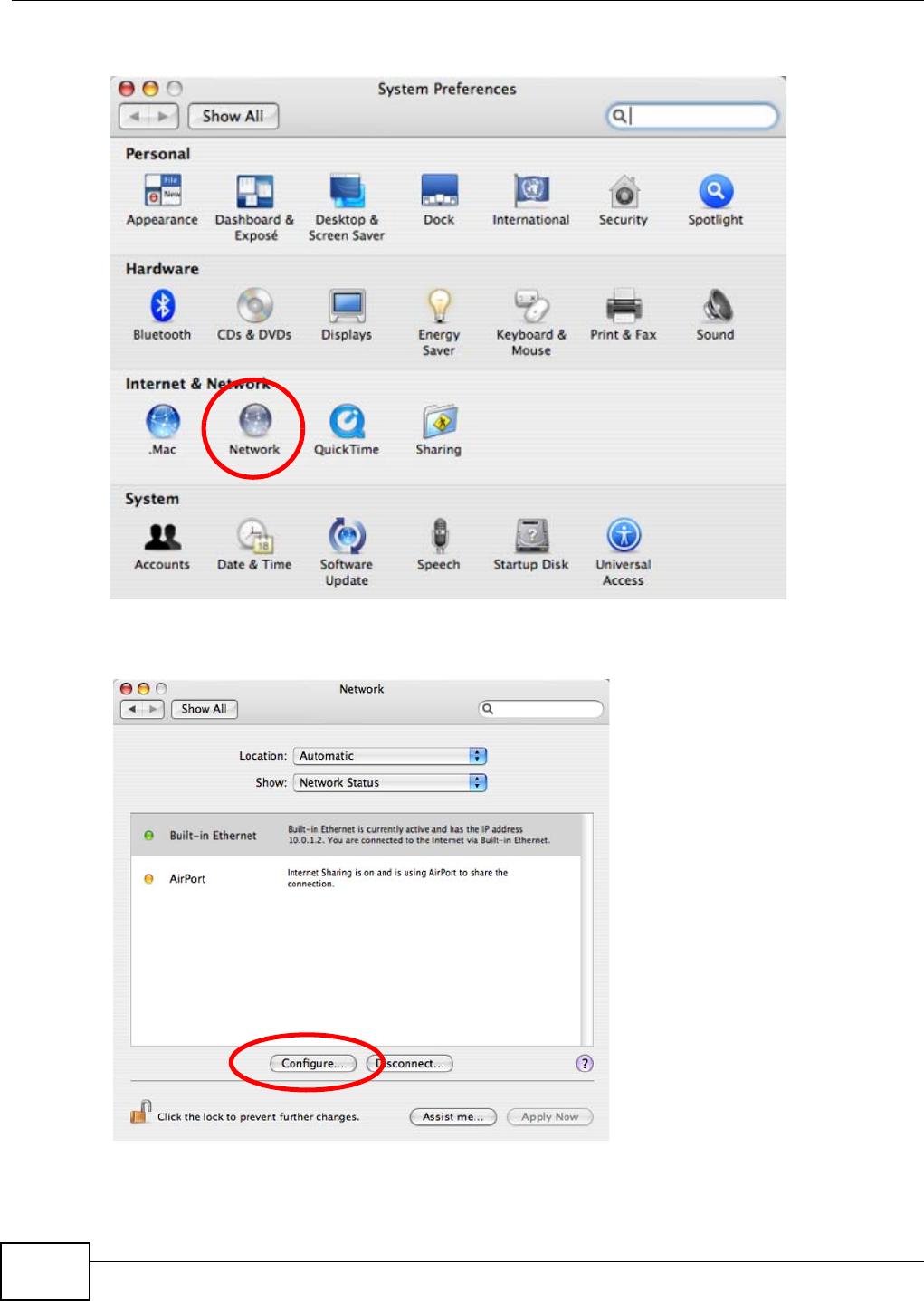
Appendix C Setting Up Your Computer’s IP Address
NBG-419N v2 User’s Guide
234
2In the System Preferences window, click the Network icon.
3When the Network preferences pane opens, select Built-in Ethernet from the network
connection type list, and then click Configure.
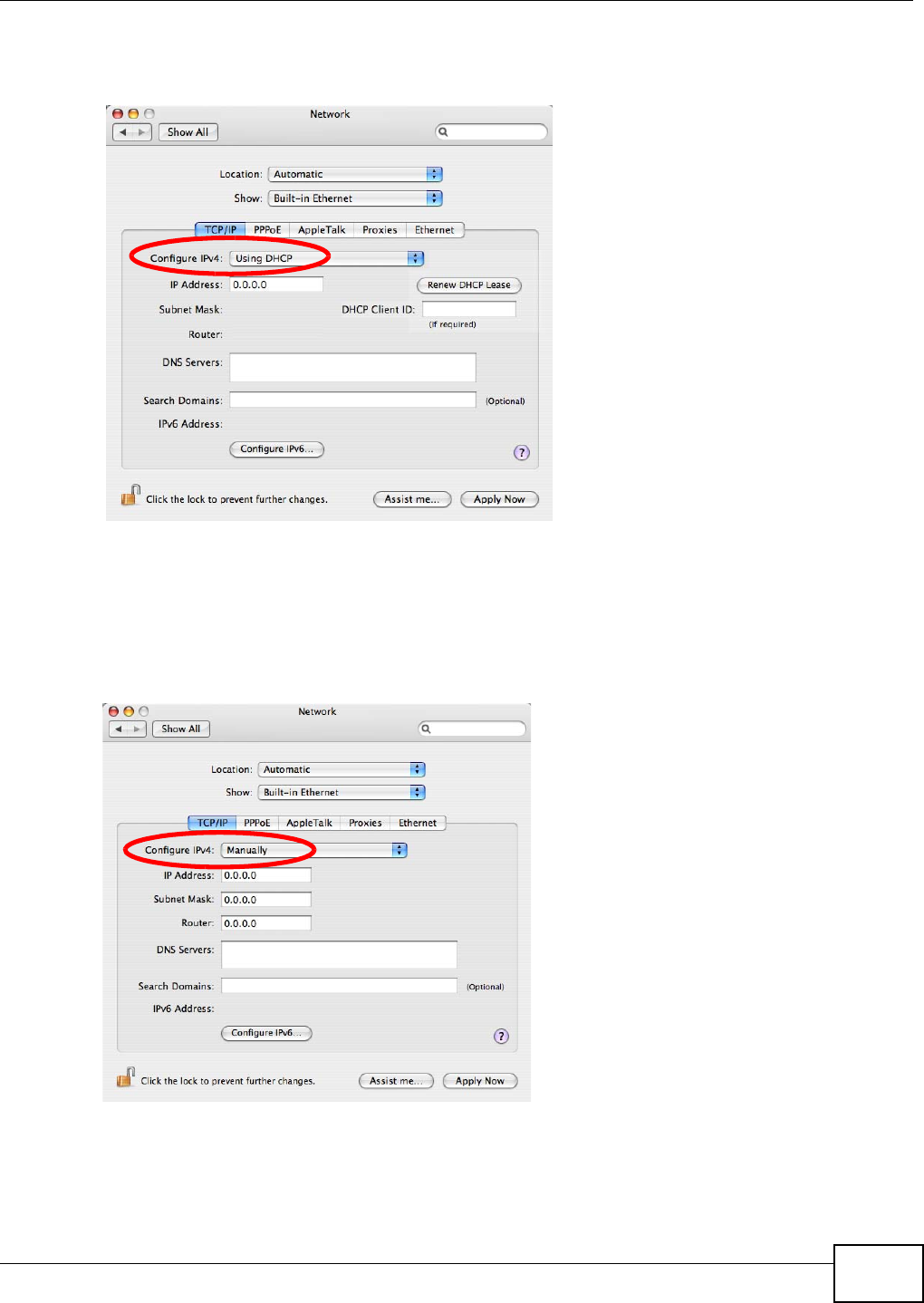
Appendix C Setting Up Your Computer’s IP Address
NBG-419N v2 User’s Guide 235
4For dynamically assigned settings, select Using DHCP from the Configure IPv4 list in the TCP/IP
tab.
5For statically assigned settings, do the following:
•From the Configure IPv4 list, select Manually.
•In the IP Address field, type your IP address.
•In the Subnet Mask field, type your subnet mask.
•In the Router field, type the IP address of your device.
6Click Apply Now and close the window.
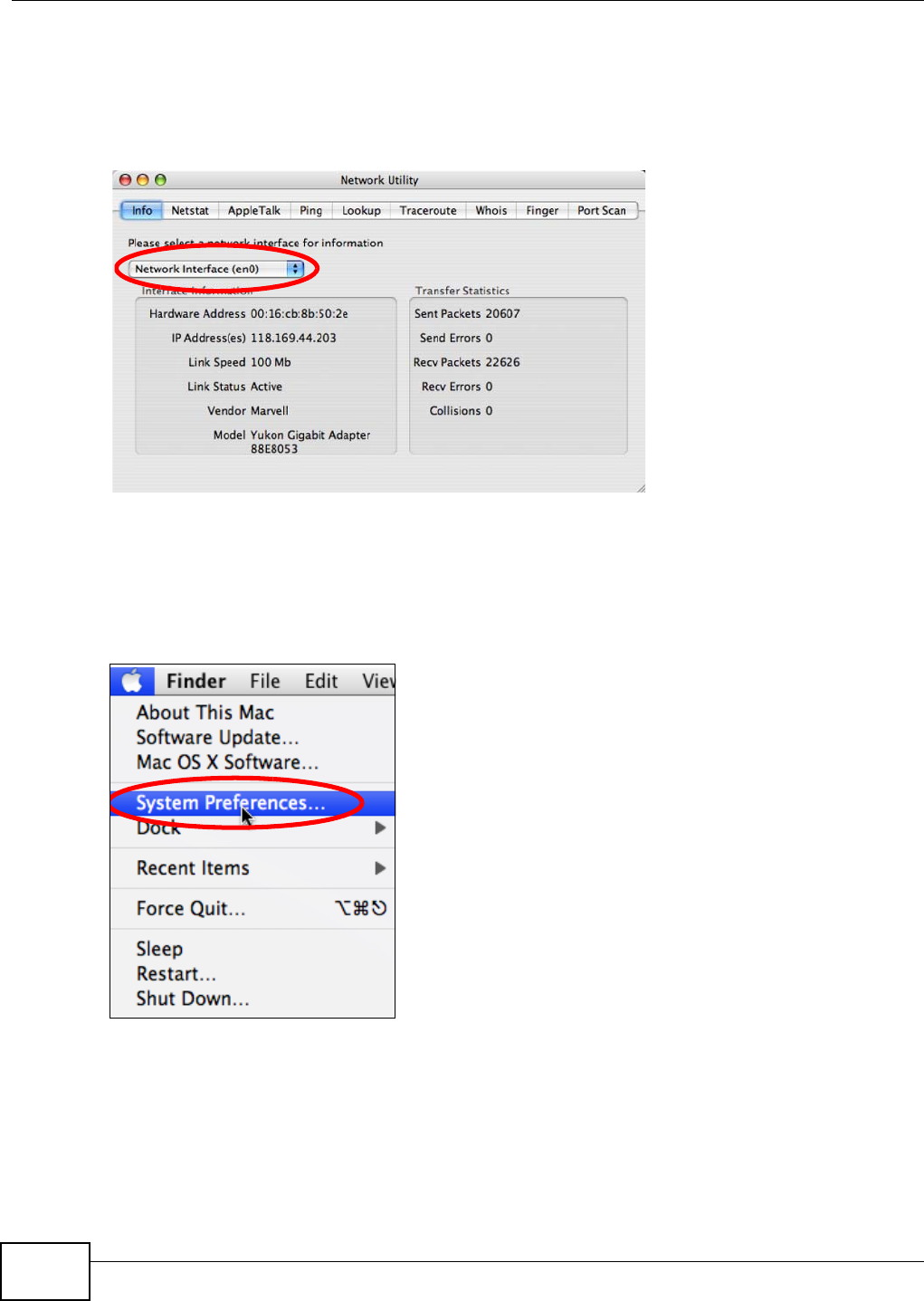
Appendix C Setting Up Your Computer’s IP Address
NBG-419N v2 User’s Guide
236
Verifying Settings
Check your TCP/IP properties by clicking Applications > Utilities > Network Utilities, and then
selecting the appropriate Network Interface from the Info tab.
Figure 159 Mac OS X 10.4: Network Utility
Mac OS X: 10.5 and 10.6
The screens in this section are from Mac OS X 10.5 but can also apply to 10.6.
1Click Apple > System Preferences.
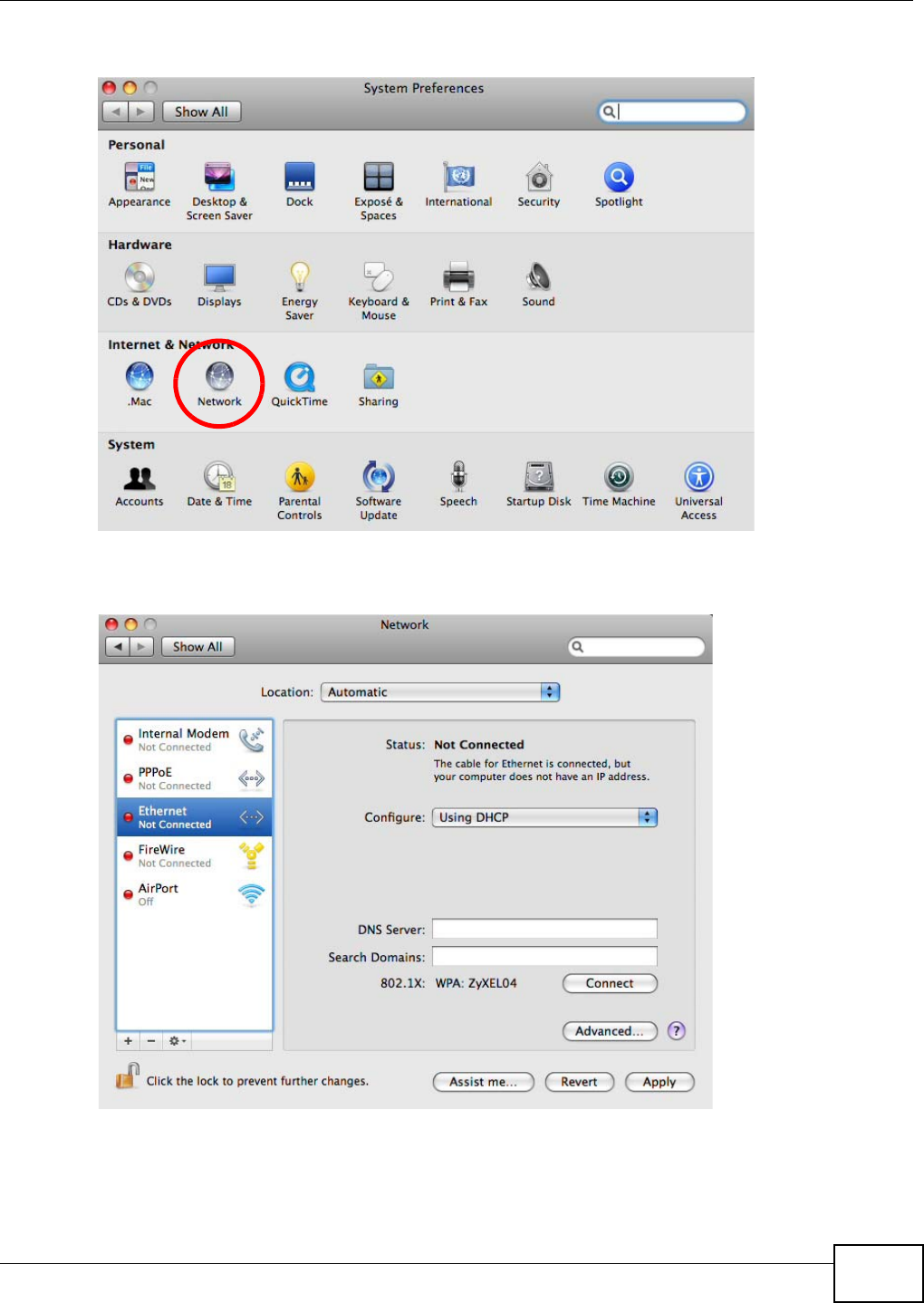
Appendix C Setting Up Your Computer’s IP Address
NBG-419N v2 User’s Guide 237
2In System Preferences, click the Network icon.
3When the Network preferences pane opens, select Ethernet from the list of available connection
types.
4From the Configure list, select Using DHCP for dynamically assigned settings.
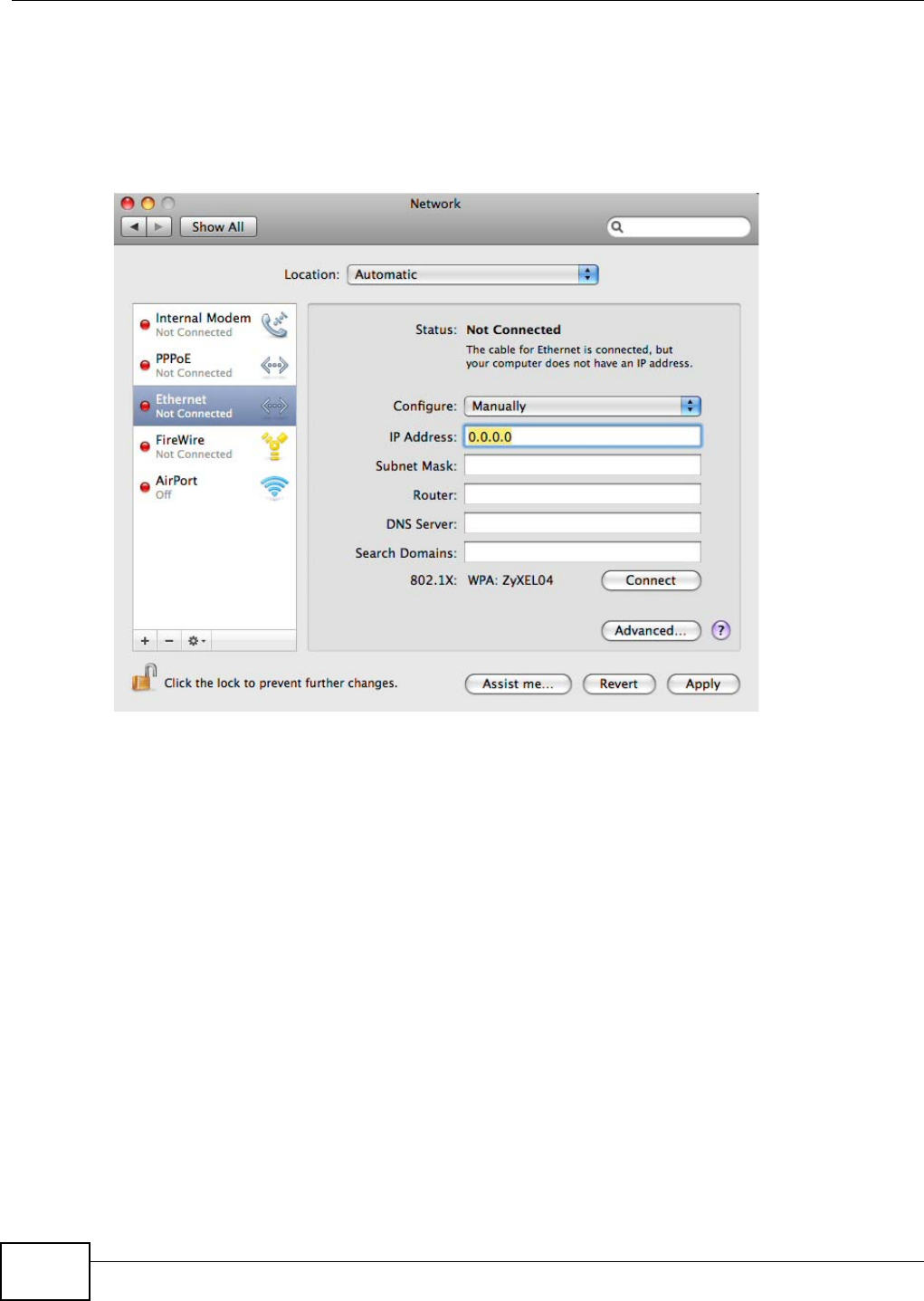
Appendix C Setting Up Your Computer’s IP Address
NBG-419N v2 User’s Guide
238
5For statically assigned settings, do the following:
•From the Configure list, select Manually.
•In the IP Address field, enter your IP address.
•In the Subnet Mask field, enter your subnet mask.
•In the Router field, enter the IP address of your Router.
6Click Apply and close the window.
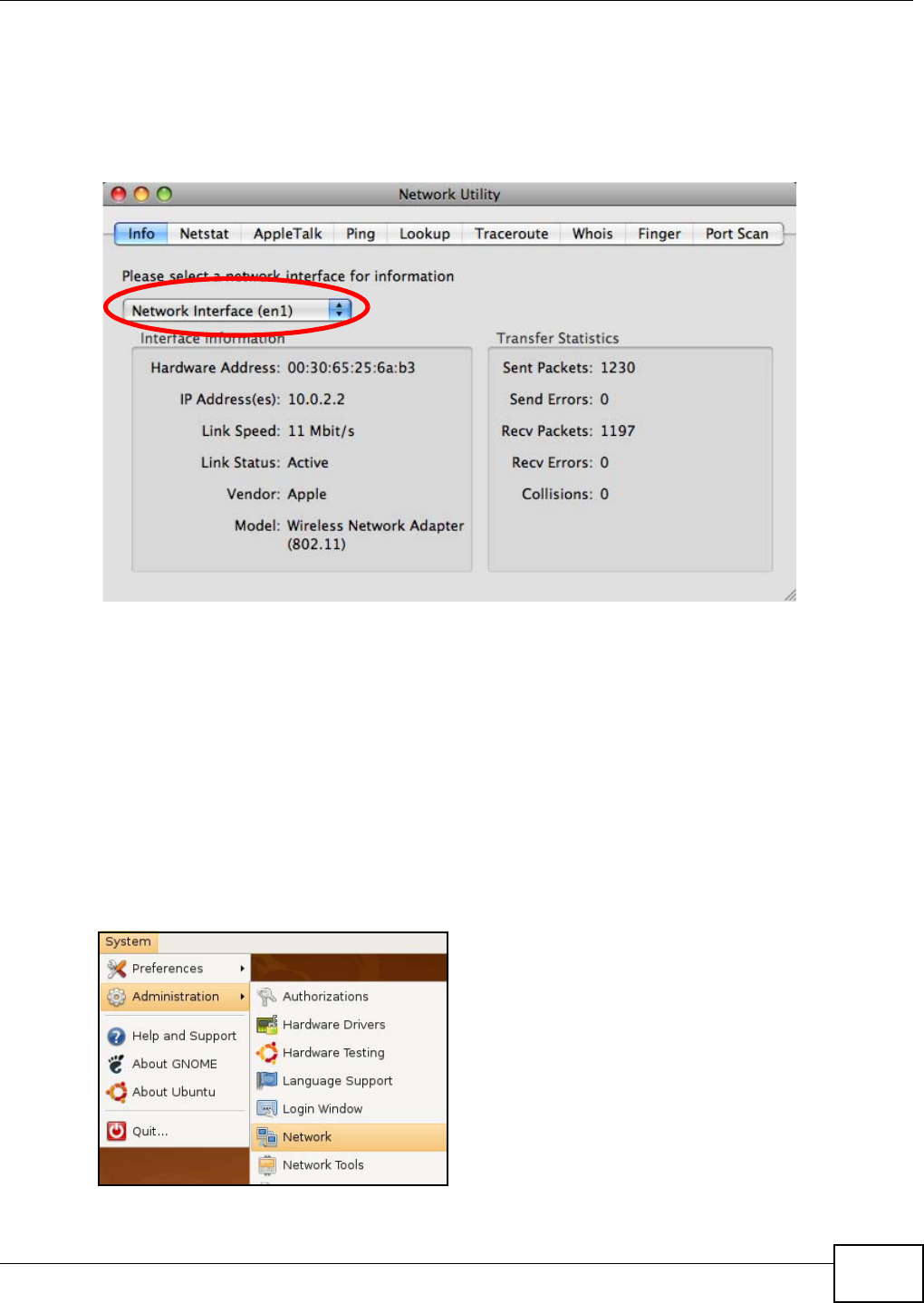
Appendix C Setting Up Your Computer’s IP Address
NBG-419N v2 User’s Guide 239
Verifying Settings
Check your TCP/IP properties by clicking Applications > Utilities > Network Utilities, and then
selecting the appropriate Network interface from the Info tab.
Figure 160 Mac OS X 10.5: Network Utility
Linux: Ubuntu 8 (GNOME)
This section shows you how to configure your computer’s TCP/IP settings in the GNU Object Model
Environment (GNOME) using the Ubuntu 8 Linux distribution. The procedure, screens and file
locations may vary depending on your specific distribution, release version, and individual
configuration. The following screens use the default Ubuntu 8 installation.
Note: Make sure you are logged in as the root administrator.
Follow the steps below to configure your computer IP address in GNOME:
1Click System > Administration > Network.
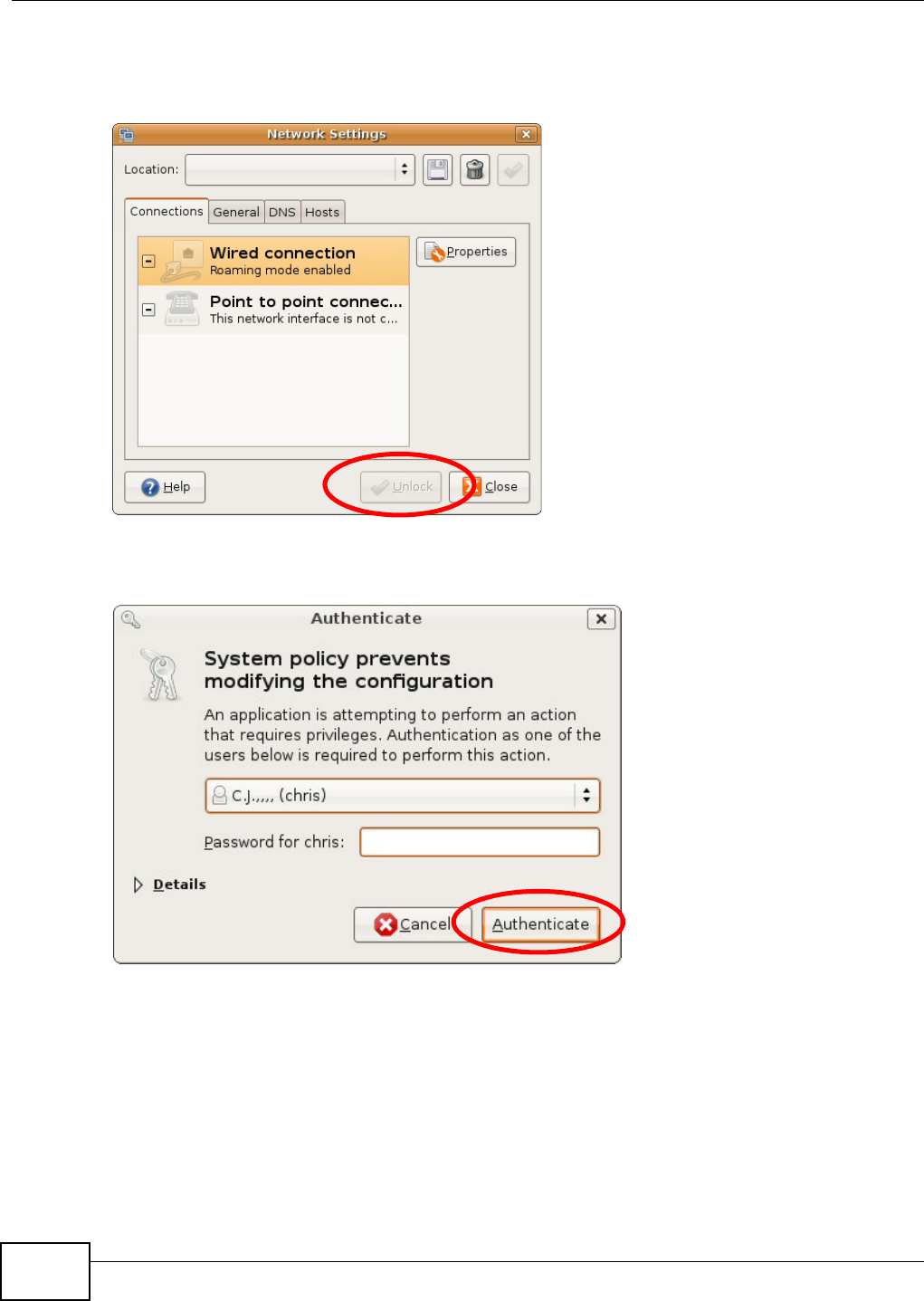
Appendix C Setting Up Your Computer’s IP Address
NBG-419N v2 User’s Guide
240
2When the Network Settings window opens, click Unlock to open the Authenticate window. (By
default, the Unlock button is greyed out until clicked.) You cannot make changes to your
configuration unless you first enter your admin password.
3In the Authenticate window, enter your admin account name and password then click the
Authenticate button.
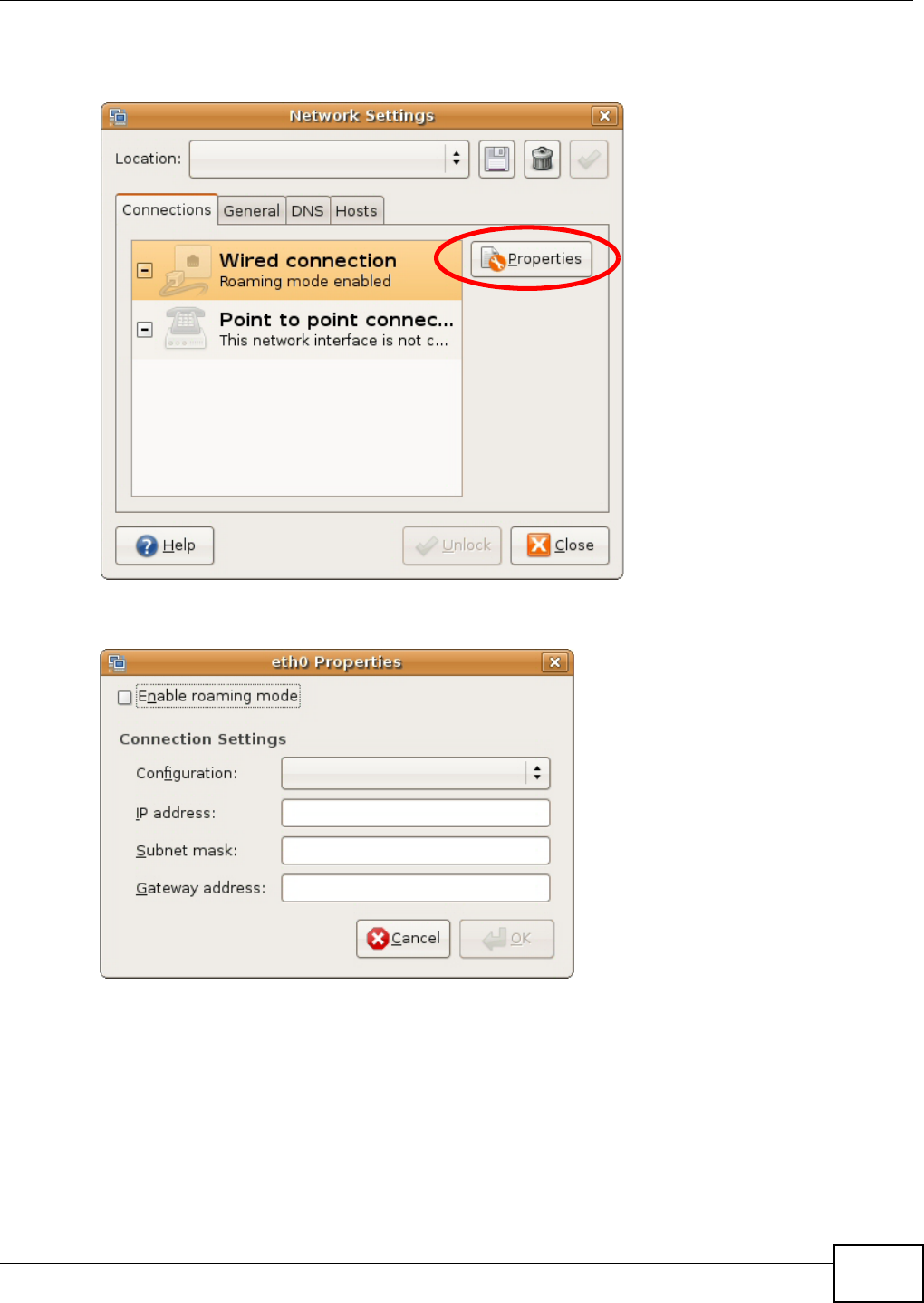
Appendix C Setting Up Your Computer’s IP Address
NBG-419N v2 User’s Guide 241
4In the Network Settings window, select the connection that you want to configure, then click
Properties.
5The Properties dialog box opens.
•In the Configuration list, select Automatic Configuration (DHCP) if you have a dynamic IP
address.
•In the Configuration list, select Static IP address if you have a static IP address. Fill in the
IP address, Subnet mask, and Gateway address fields.
6Click OK to save the changes and close the Properties dialog box and return to the Network
Settings screen.
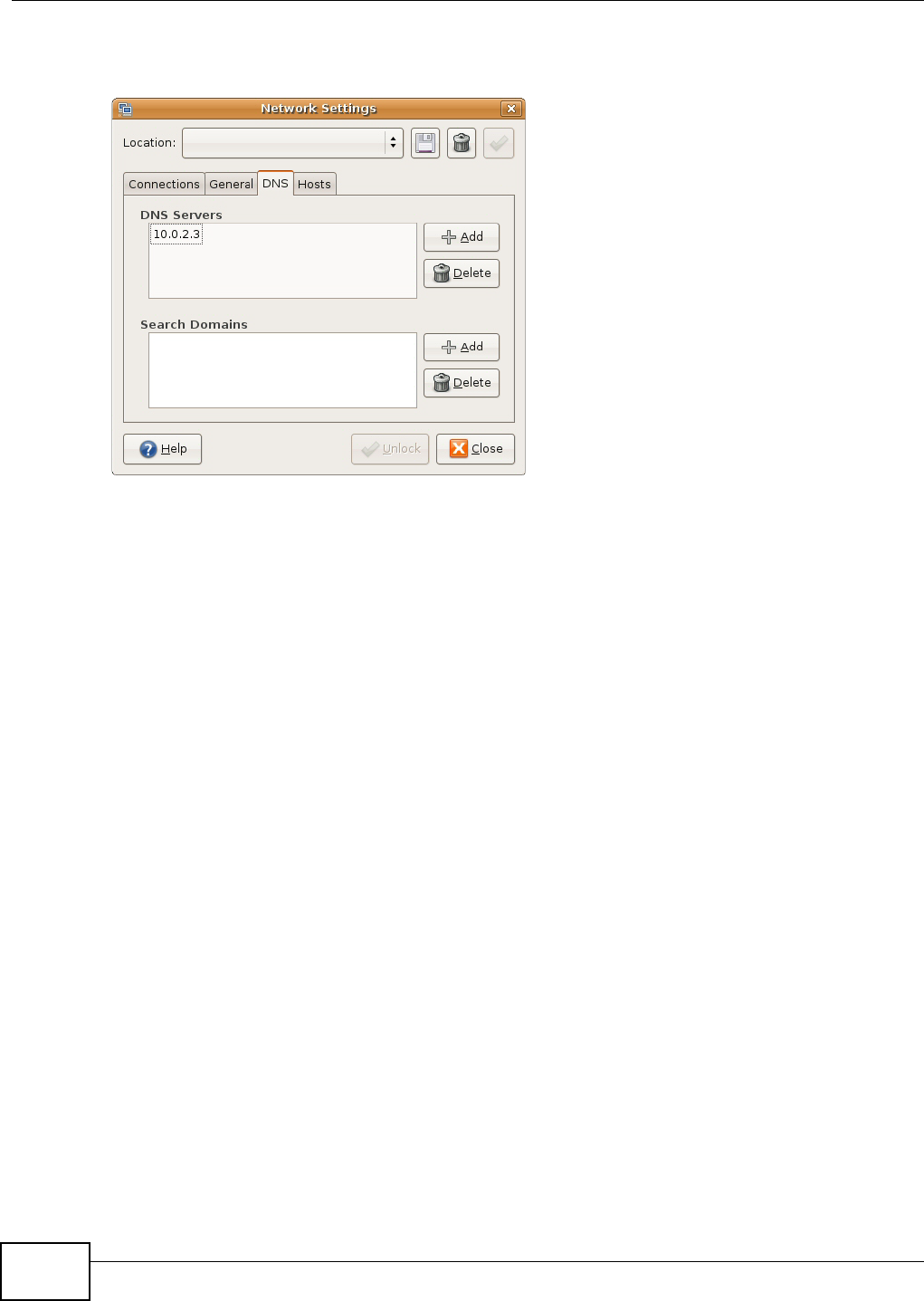
Appendix C Setting Up Your Computer’s IP Address
NBG-419N v2 User’s Guide
242
7If you know your DNS server IP address(es), click the DNS tab in the Network Settings window
and then enter the DNS server information in the fields provided.
8Click the Close button to apply the changes.
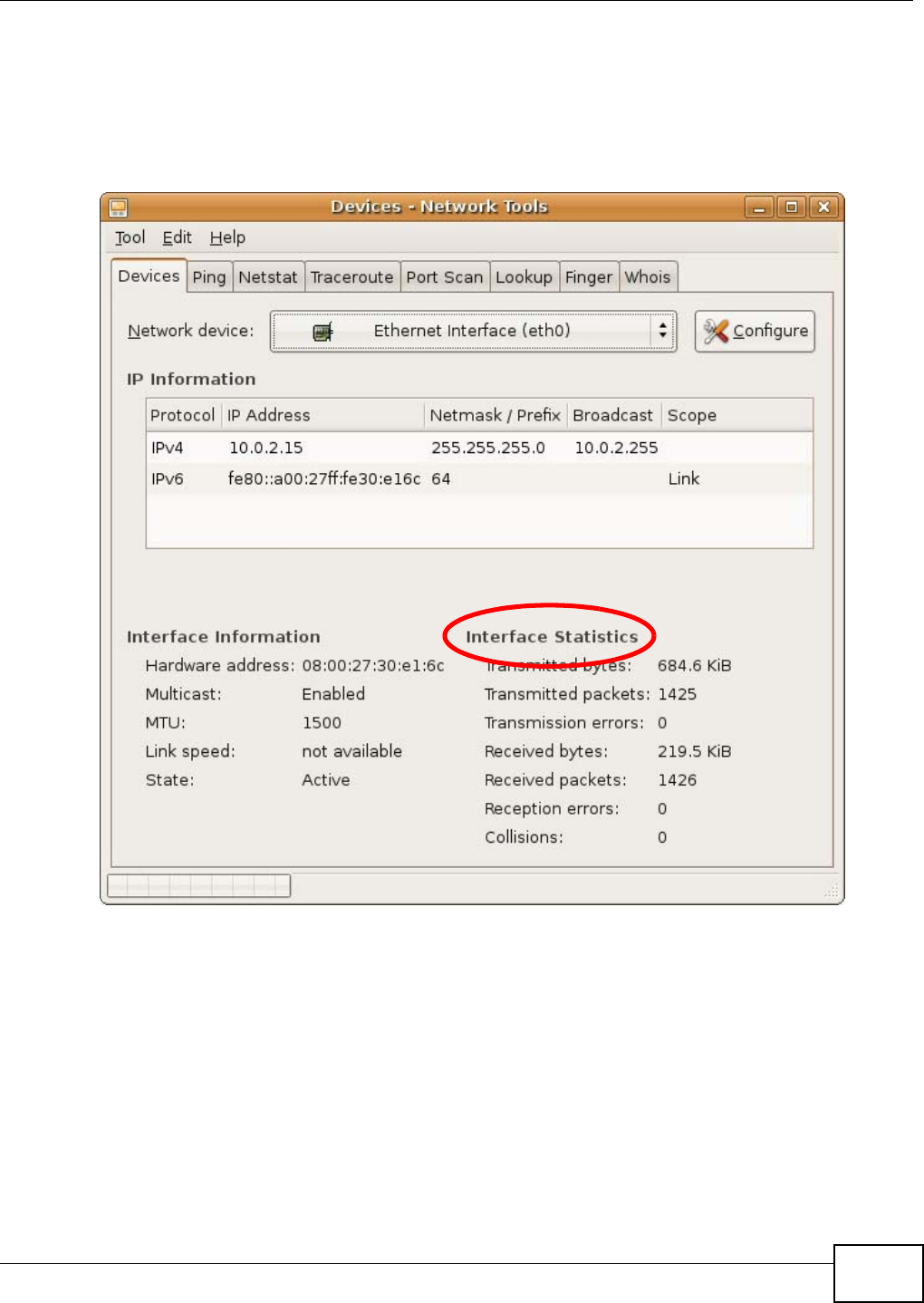
Appendix C Setting Up Your Computer’s IP Address
NBG-419N v2 User’s Guide 243
Verifying Settings
Check your TCP/IP properties by clicking System > Administration > Network Tools, and then
selecting the appropriate Network device from the Devices tab. The Interface Statistics
column shows data if your connection is working properly.
Figure 161 Ubuntu 8: Network Tools
Linux: openSUSE 10.3 (KDE)
This section shows you how to configure your computer’s TCP/IP settings in the K Desktop
Environment (KDE) using the openSUSE 10.3 Linux distribution. The procedure, screens and file
locations may vary depending on your specific distribution, release version, and individual
configuration. The following screens use the default openSUSE 10.3 installation.
Note: Make sure you are logged in as the root administrator.
Follow the steps below to configure your computer IP address in the KDE:
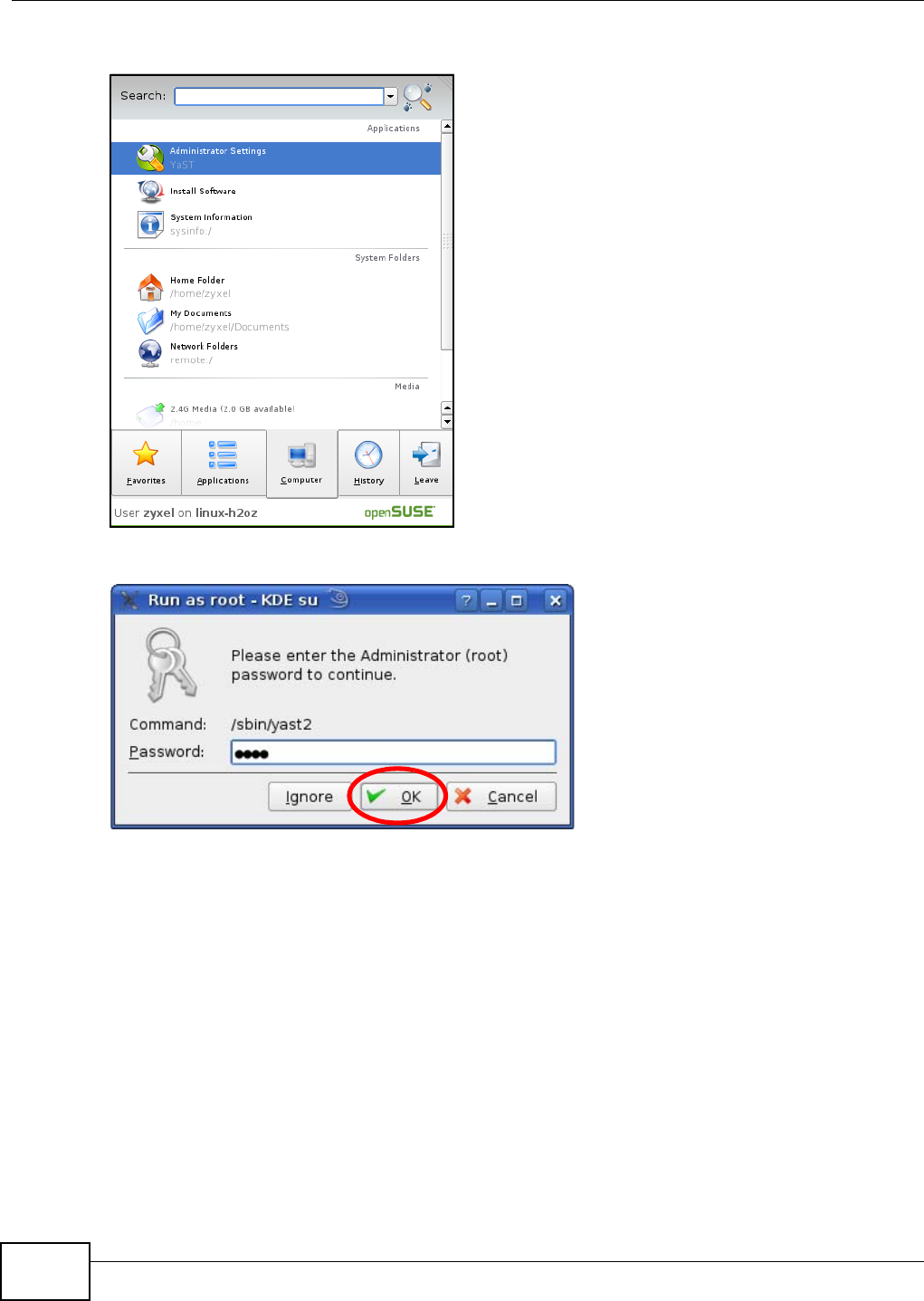
Appendix C Setting Up Your Computer’s IP Address
NBG-419N v2 User’s Guide
244
1Click K Menu > Computer > Administrator Settings (YaST).
2When the Run as Root - KDE su dialog opens, enter the admin password and click OK.
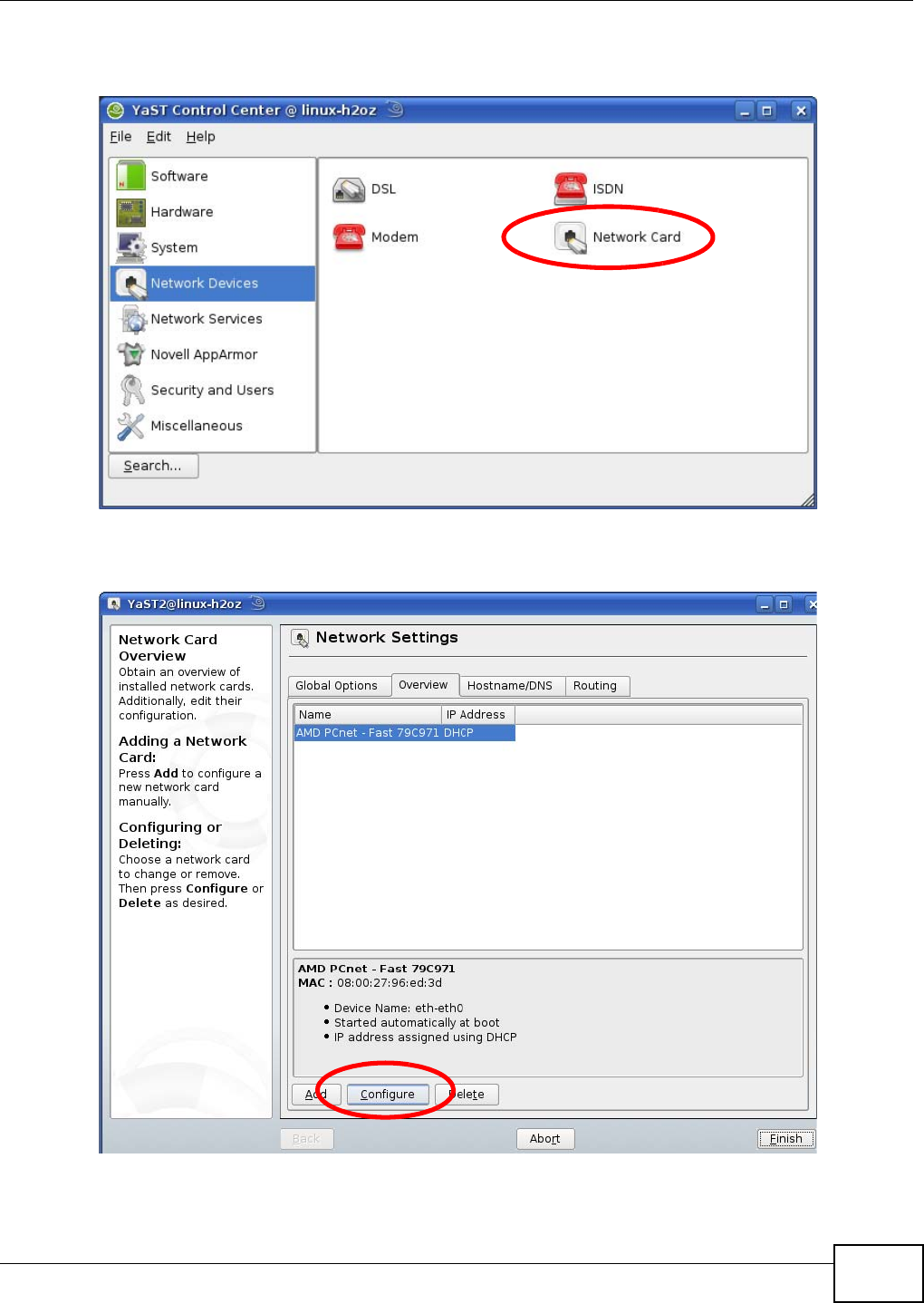
Appendix C Setting Up Your Computer’s IP Address
NBG-419N v2 User’s Guide 245
3When the YaST Control Center window opens, select Network Devices and then click the
Network Card icon.
4When the Network Settings window opens, click the Overview tab, select the appropriate
connection Name from the list, and then click the Configure button.
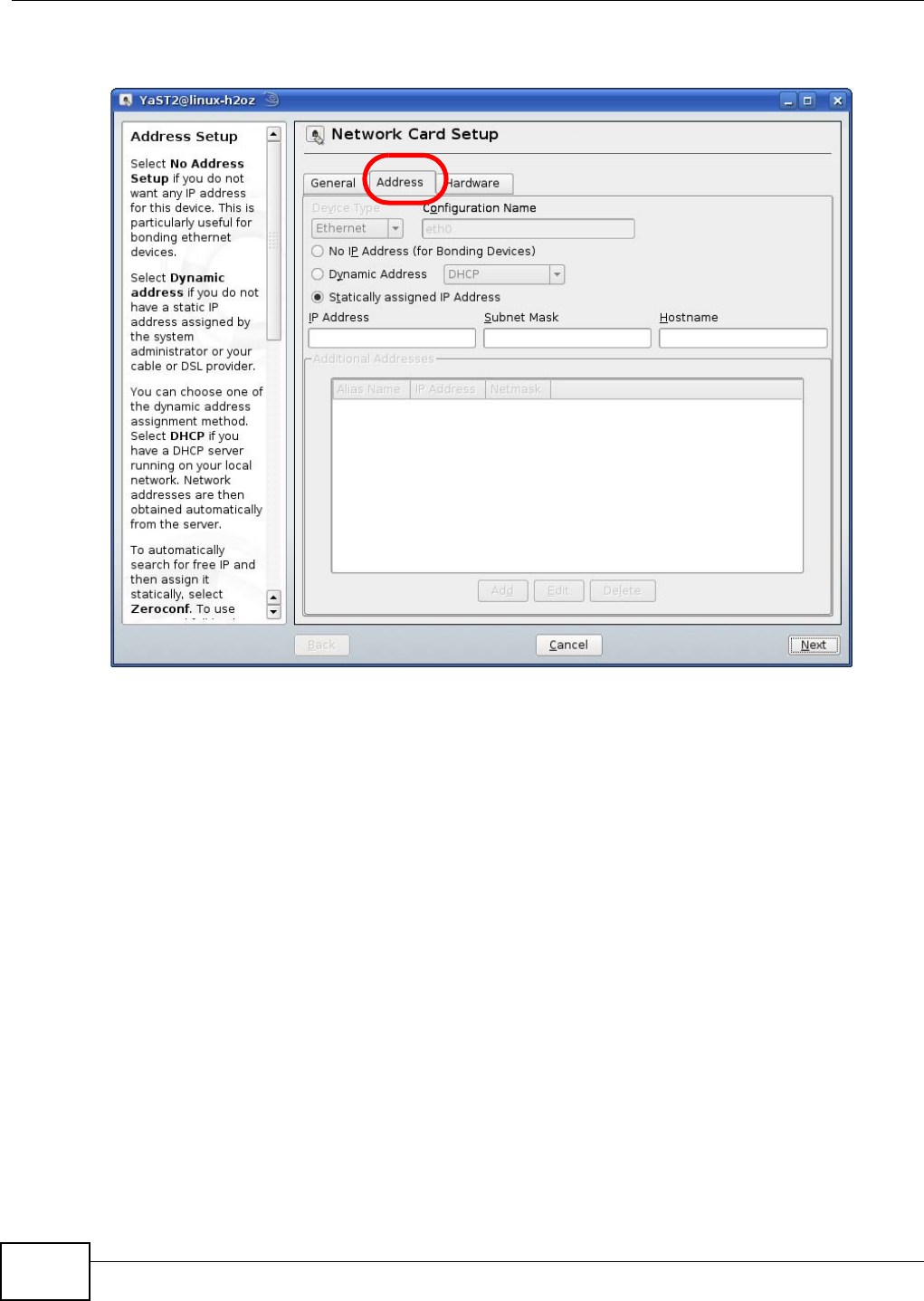
Appendix C Setting Up Your Computer’s IP Address
NBG-419N v2 User’s Guide
246
5When the Network Card Setup window opens, click the Address tab
Figure 162 openSUSE 10.3: Network Card Setup
6Select Dynamic Address (DHCP) if you have a dynamic IP address.
Select Statically assigned IP Address if you have a static IP address. Fill in the IP address,
Subnet mask, and Hostname fields.
7Click Next to save the changes and close the Network Card Setup window.
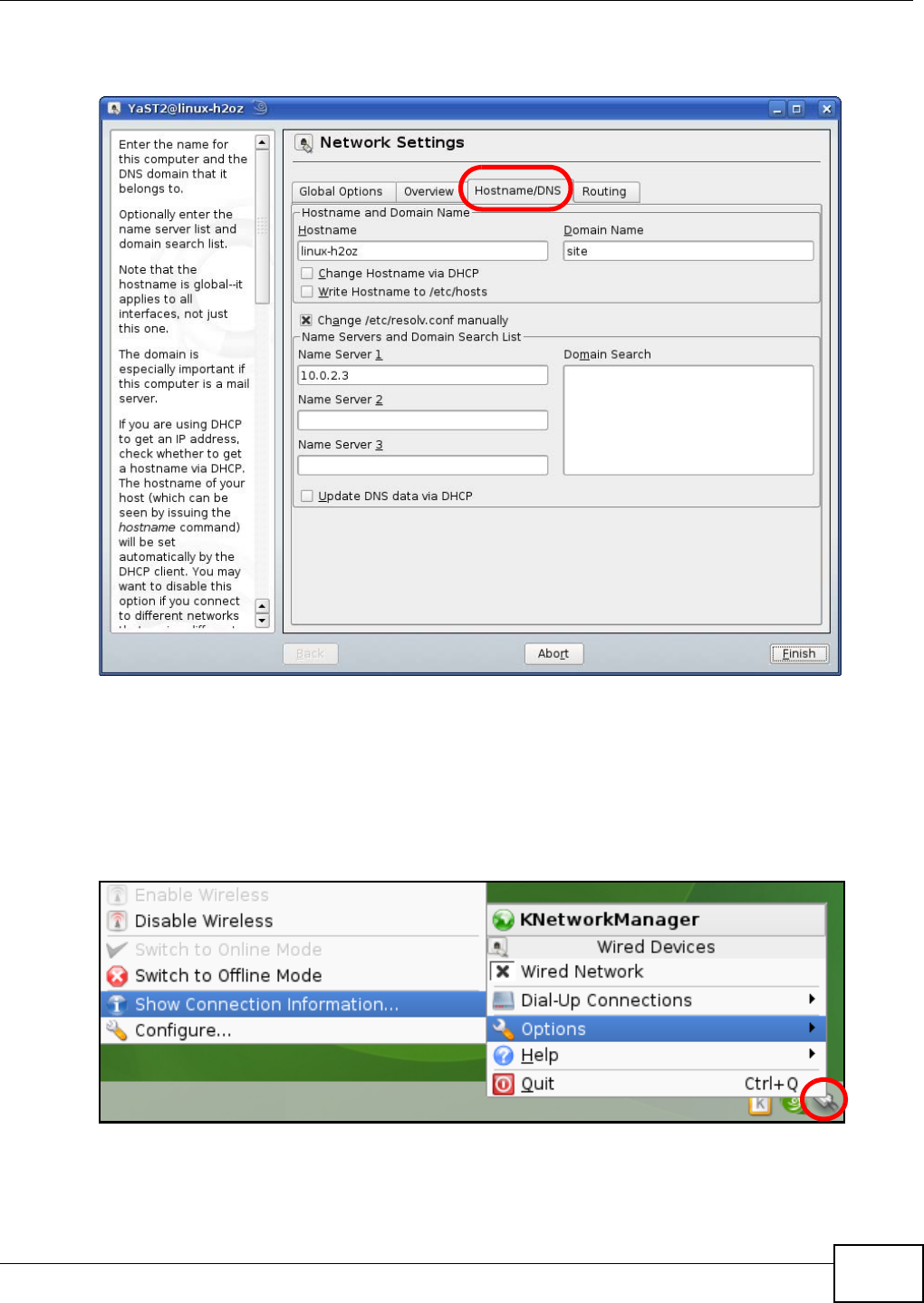
Appendix C Setting Up Your Computer’s IP Address
NBG-419N v2 User’s Guide 247
8If you know your DNS server IP address(es), click the Hostname/DNS tab in Network Settings
and then enter the DNS server information in the fields provided.
9Click Finish to save your settings and close the window.
Verifying Settings
Click the KNetwork Manager icon on the Task bar to check your TCP/IP properties. From the
Options sub-menu, select Show Connection Information.
Figure 163 openSUSE 10.3: KNetwork Manager
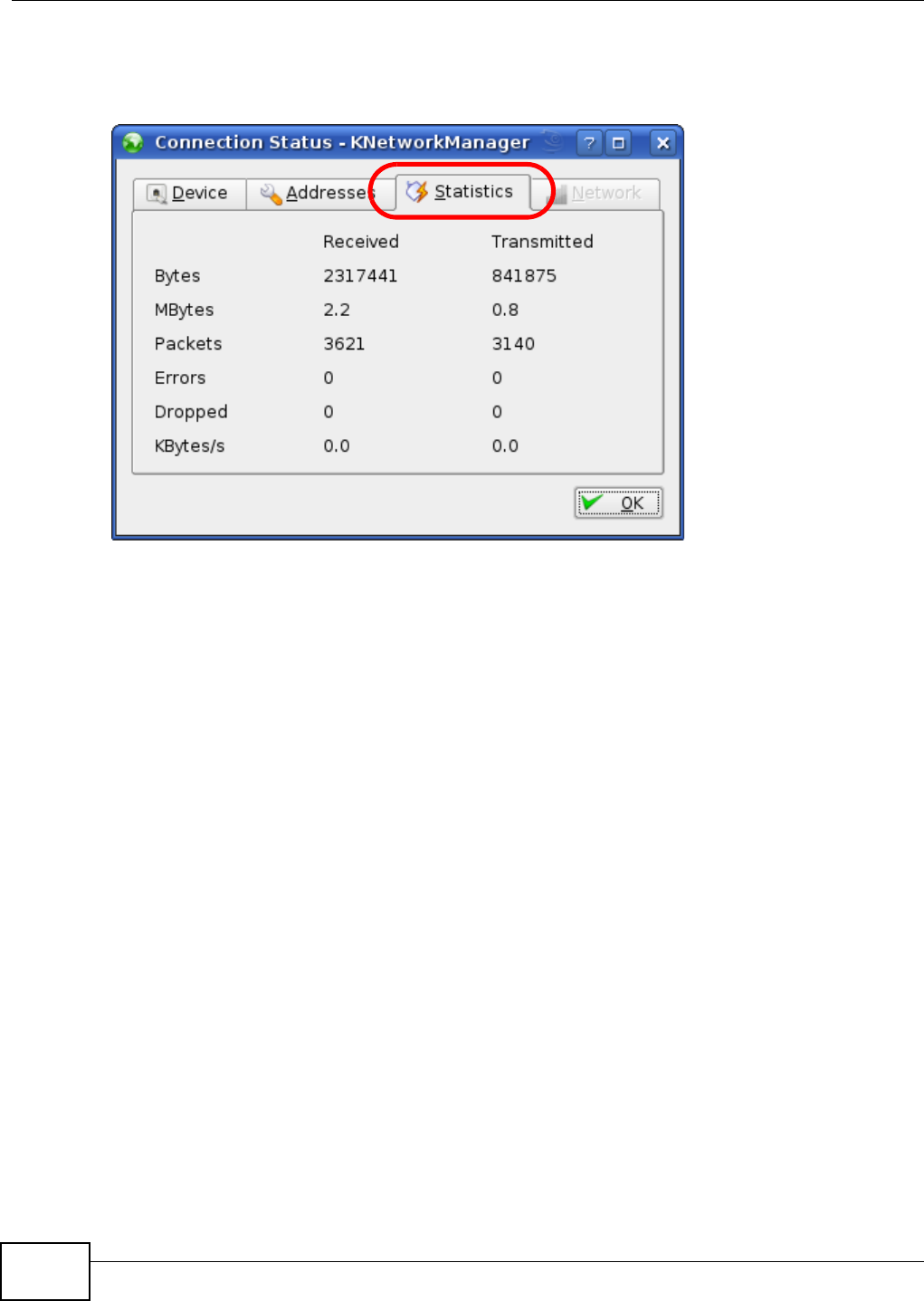
Appendix C Setting Up Your Computer’s IP Address
NBG-419N v2 User’s Guide
248
When the Connection Status - KNetwork Manager window opens, click the Statistics tab to
see if your connection is working properly.
Figure 164 openSUSE: Connection Status - KNetwork Manager
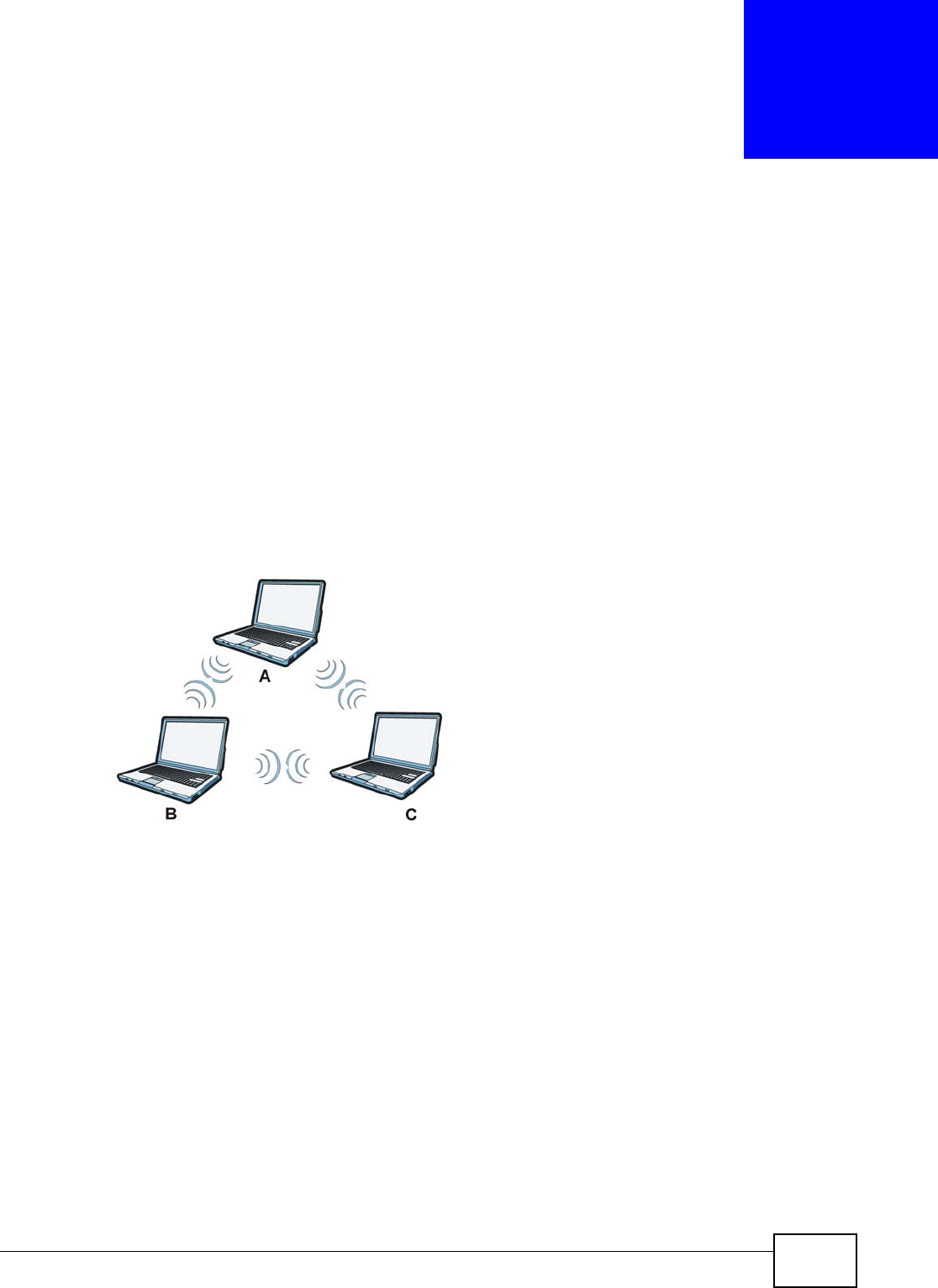
NBG-419N v2 User’s Guide 249
APPENDIX D
Wireless LANs
Wireless LAN Topologies
This section discusses ad-hoc and infrastructure wireless LAN topologies.
Ad-hoc Wireless LAN Configuration
The simplest WLAN configuration is an independent (Ad-hoc) WLAN that connects a set of
computers with wireless adapters (A, B, C). Any time two or more wireless adapters are within
range of each other, they can set up an independent network, which is commonly referred to as an
ad-hoc network or Independent Basic Service Set (IBSS). The following diagram shows an example
of notebook computers using wireless adapters to form an ad-hoc wireless LAN.
Figure 165 Peer-to-Peer Communication in an Ad-hoc Network
BSS
A Basic Service Set (BSS) exists when all communications between wireless clients or between a
wireless client and a wired network client go through one access point (AP).
Intra-BSS traffic is traffic between wireless clients in the BSS. When Intra-BSS is enabled, wireless
client A and B can access the wired network and communicate with each other. When Intra-BSS is
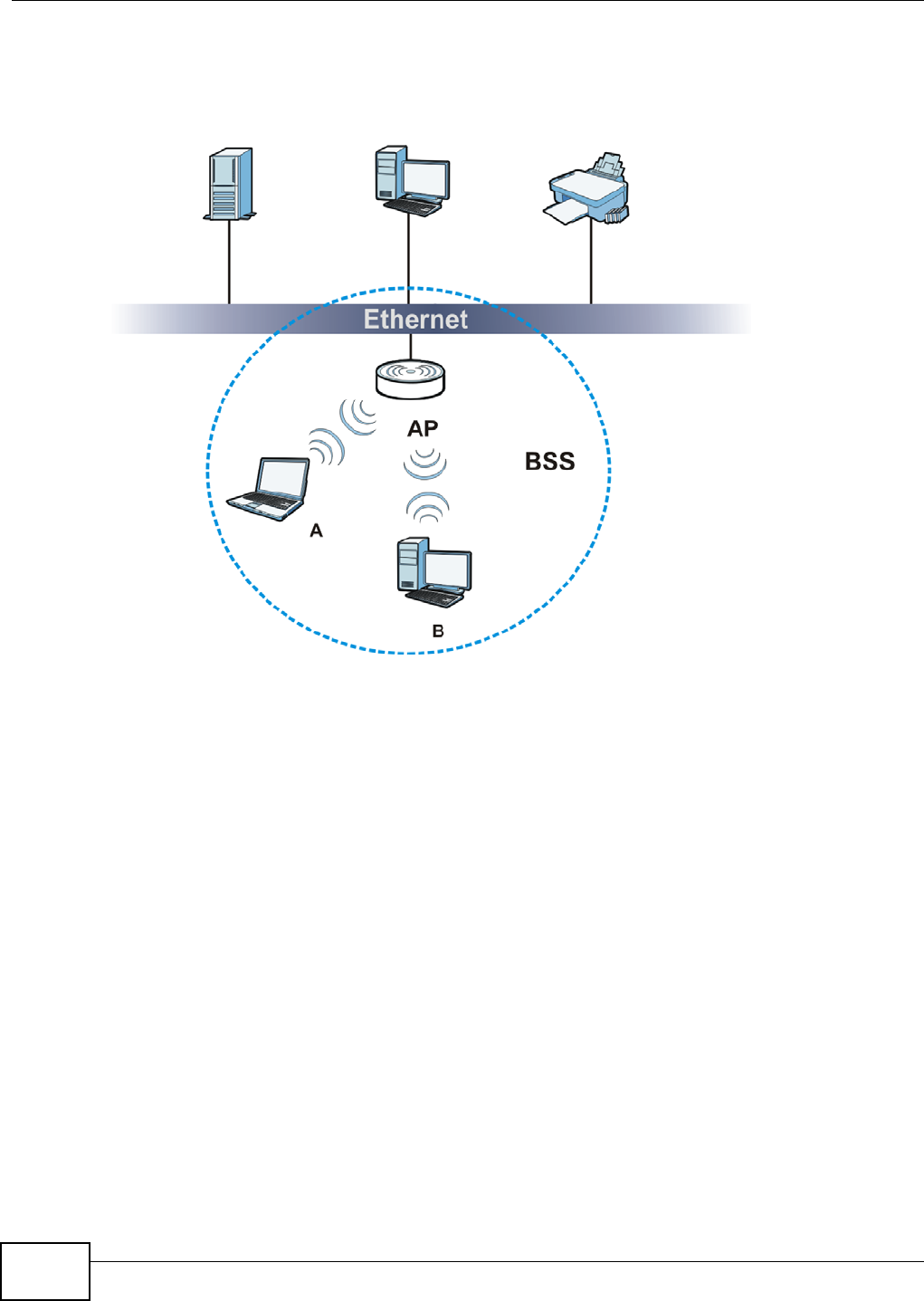
Appendix D Wireless LANs
NBG-419N v2 User’s Guide
250
disabled, wireless client A and B can still access the wired network but cannot communicate with
each other.
Figure 166 Basic Service Set
ESS
An Extended Service Set (ESS) consists of a series of overlapping BSSs, each containing an access
point, with each access point connected together by a wired network. This wired connection
between APs is called a Distribution System (DS).
This type of wireless LAN topology is called an Infrastructure WLAN. The Access Points not only
provide communication with the wired network but also mediate wireless network traffic in the
immediate neighborhood.
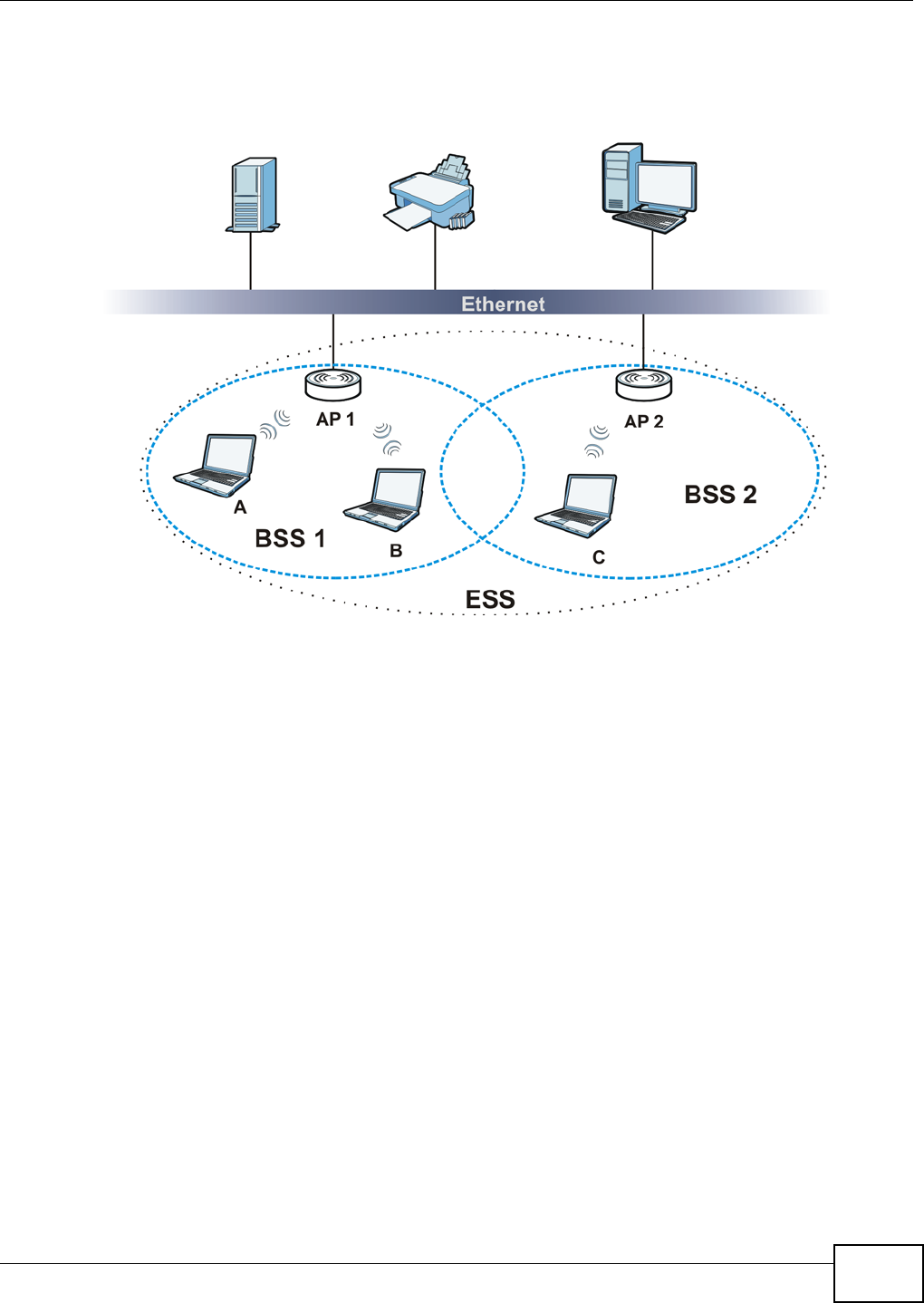
Appendix D Wireless LANs
NBG-419N v2 User’s Guide 251
An ESSID (ESS IDentification) uniquely identifies each ESS. All access points and their associated
wireless clients within the same ESS must have the same ESSID in order to communicate.
Figure 167 Infrastructure WLAN
Channel
A channel is the radio frequency(ies) used by wireless devices to transmit and receive data.
Channels available depend on your geographical area. You may have a choice of channels (for your
region) so you should use a channel different from an adjacent AP (access point) to reduce
interference. Interference occurs when radio signals from different access points overlap causing
interference and degrading performance.
Adjacent channels partially overlap however. To avoid interference due to overlap, your AP should
be on a channel at least five channels away from a channel that an adjacent AP is using. For
example, if your region has 11 channels and an adjacent AP is using channel 1, then you need to
select a channel between 6 or 11.
RTS/CTS
A hidden node occurs when two stations are within range of the same access point, but are not
within range of each other. The following figure illustrates a hidden node. Both stations (STA) are
within range of the access point (AP) or wireless gateway, but out-of-range of each other, so they
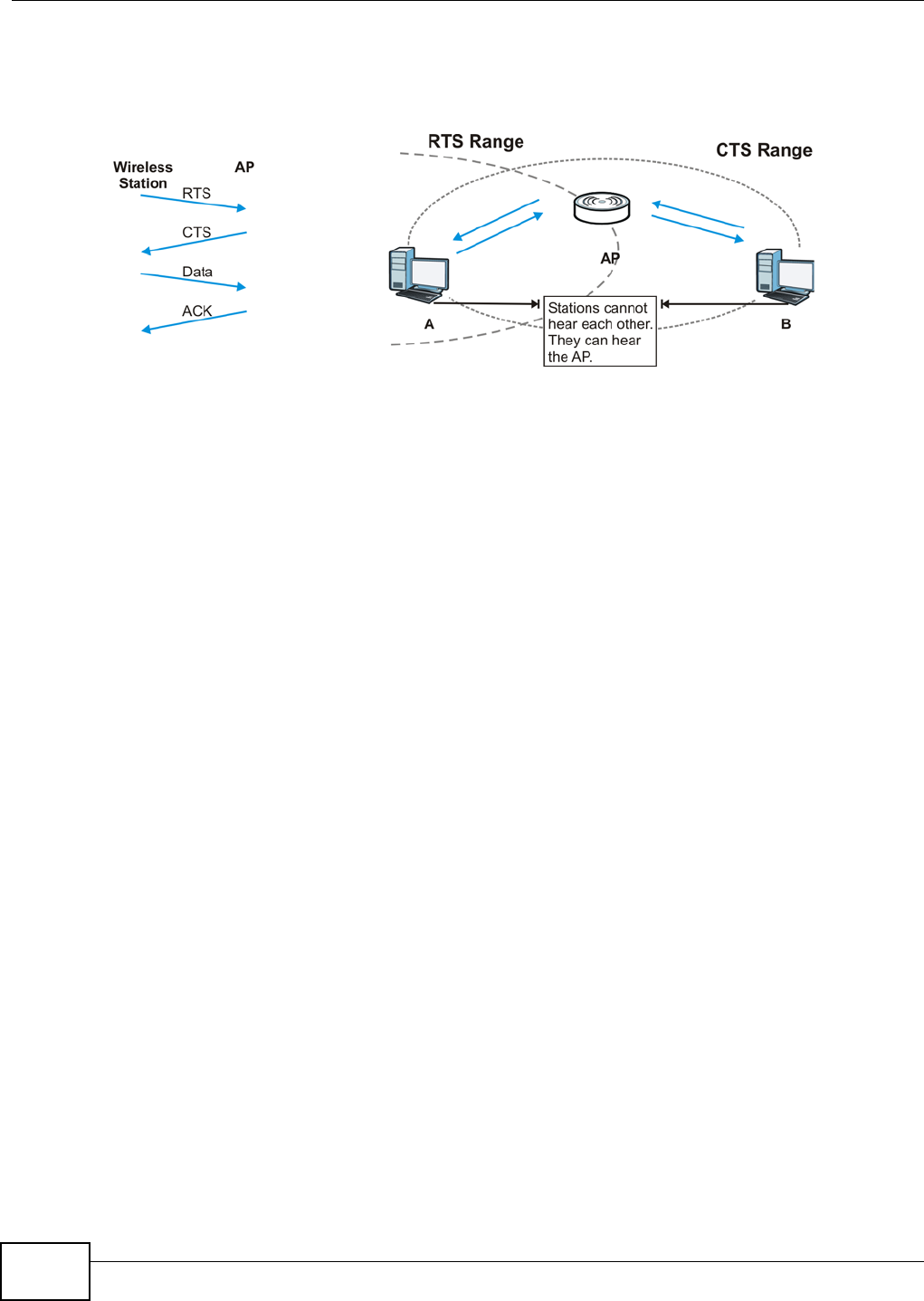
Appendix D Wireless LANs
NBG-419N v2 User’s Guide
252
cannot "hear" each other, that is they do not know if the channel is currently being used. Therefore,
they are considered hidden from each other.
Figure 168 RTS/CTS
When station A sends data to the AP, it might not know that the station B is already using the
channel. If these two stations send data at the same time, collisions may occur when both sets of
data arrive at the AP at the same time, resulting in a loss of messages for both stations.
RTS/CTS is designed to prevent collisions due to hidden nodes. An RTS/CTS defines the biggest
size data frame you can send before an RTS (Request To Send)/CTS (Clear to Send) handshake is
invoked.
When a data frame exceeds the RTS/CTS value you set, the station that wants to transmit this
frame must first send an RTS (Request To Send) message to the AP for permission to send it. The
AP then responds with a CTS (Clear to Send) message to all other stations within its range to notify
them to defer their transmission. It also reserves and confirms with the requesting station the time
frame for the requested transmission.
Stations can send frames smaller than the specified RTS/CTS directly to the AP without the RTS
(Request To Send)/CTS (Clear to Send) handshake.
You should only configure RTS/CTS if the possibility of hidden nodes exists on your network and
the "cost" of resending large frames is more than the extra network overhead involved in the RTS
(Request To Send)/CTS (Clear to Send) handshake.
If the RTS/CTS value is greater than the Fragmentation Threshold value (see next), then the
RTS (Request To Send)/CTS (Clear to Send) handshake will never occur as data frames will be
fragmented before they reach RTS/CTS size.
Note: Enabling the RTS Threshold causes redundant network overhead that could
negatively affect the throughput performance instead of providing a remedy.
Fragmentation Threshold
A Fragmentation Threshold is the maximum data fragment size that can be sent in the wireless
network before the AP will fragment the packet into smaller data frames.
A large Fragmentation Threshold is recommended for networks not prone to interference while
you should set a smaller threshold for busy networks or networks that are prone to interference.
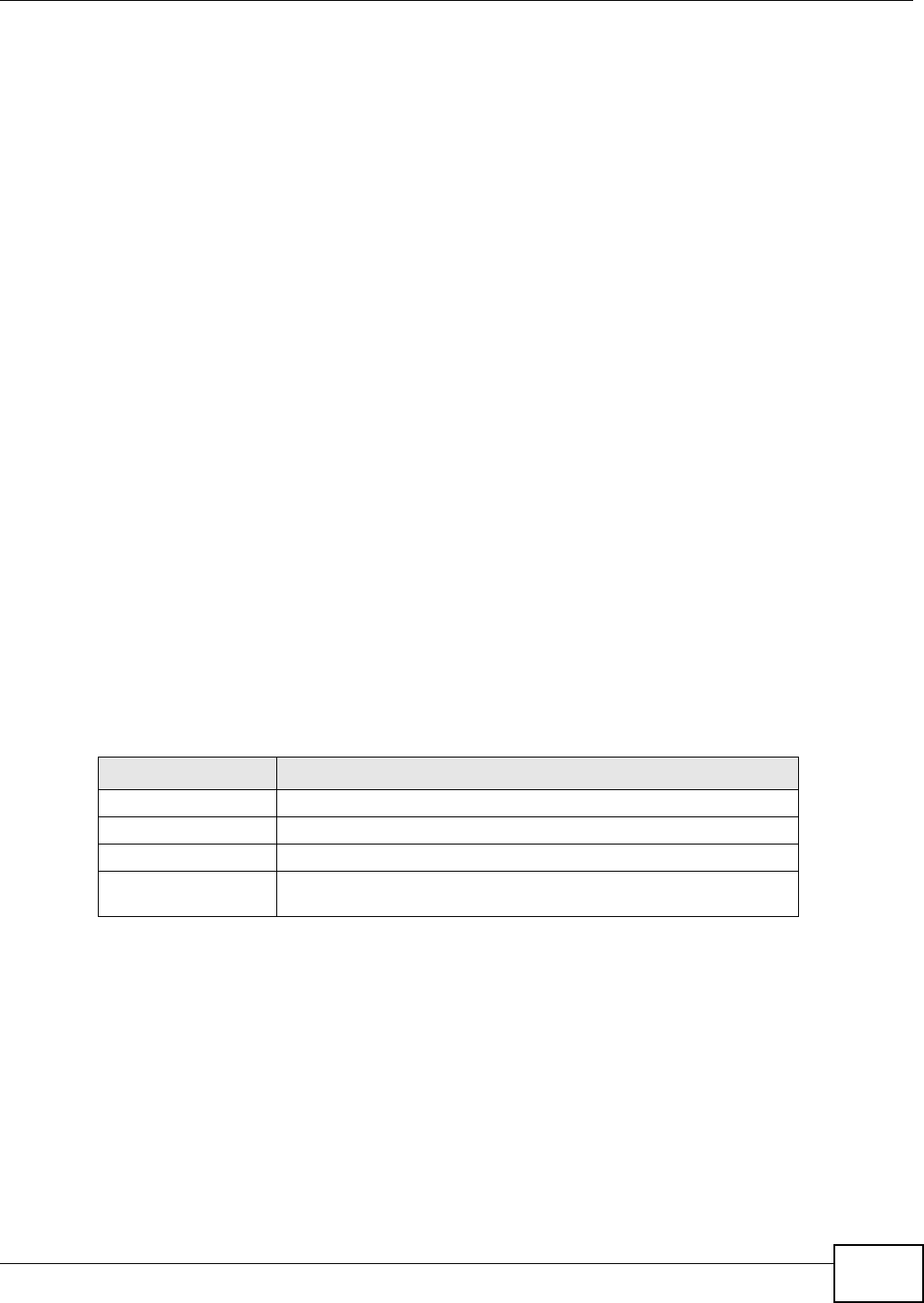
Appendix D Wireless LANs
NBG-419N v2 User’s Guide 253
If the Fragmentation Threshold value is smaller than the RTS/CTS value (see previously) you
set then the RTS (Request To Send)/CTS (Clear to Send) handshake will never occur as data frames
will be fragmented before they reach RTS/CTS size.
Preamble Type
Preamble is used to signal that data is coming to the receiver. Short and long refer to the length of
the synchronization field in a packet.
Short preamble increases performance as less time sending preamble means more time for sending
data. All IEEE 802.11 compliant wireless adapters support long preamble, but not all support short
preamble.
Use long preamble if you are unsure what preamble mode other wireless devices on the network
support, and to provide more reliable communications in busy wireless networks.
Use short preamble if you are sure all wireless devices on the network support it, and to provide
more efficient communications.
Use the dynamic setting to automatically use short preamble when all wireless devices on the
network support it, otherwise the Router uses long preamble.
Note: The wireless devices MUST use the same preamble mode in order to communicate.
IEEE 802.11g Wireless LAN
IEEE 802.11g is fully compatible with the IEEE 802.11b standard. This means an IEEE 802.11b
adapter can interface directly with an IEEE 802.11g access point (and vice versa) at 11 Mbps or
lower depending on range. IEEE 802.11g has several intermediate rate steps between the
maximum and minimum data rates. The IEEE 802.11g data rate and modulation are as follows:
Wireless Security Overview
Wireless security is vital to your network to protect wireless communication between wireless
clients, access points and the wired network.
Wireless security methods available on the Router are data encryption, wireless client
authentication, restricting access by device MAC address and hiding the Router identity.
Table 95 IEEE 802.11g
DATA RATE (MBPS) MODULATION
1 DBPSK (Differential Binary Phase Shift Keyed)
2 DQPSK (Differential Quadrature Phase Shift Keying)
5.5 / 11 CCK (Complementary Code Keying)
6/9/12/18/24/36/48/
54
OFDM (Orthogonal Frequency Division Multiplexing)
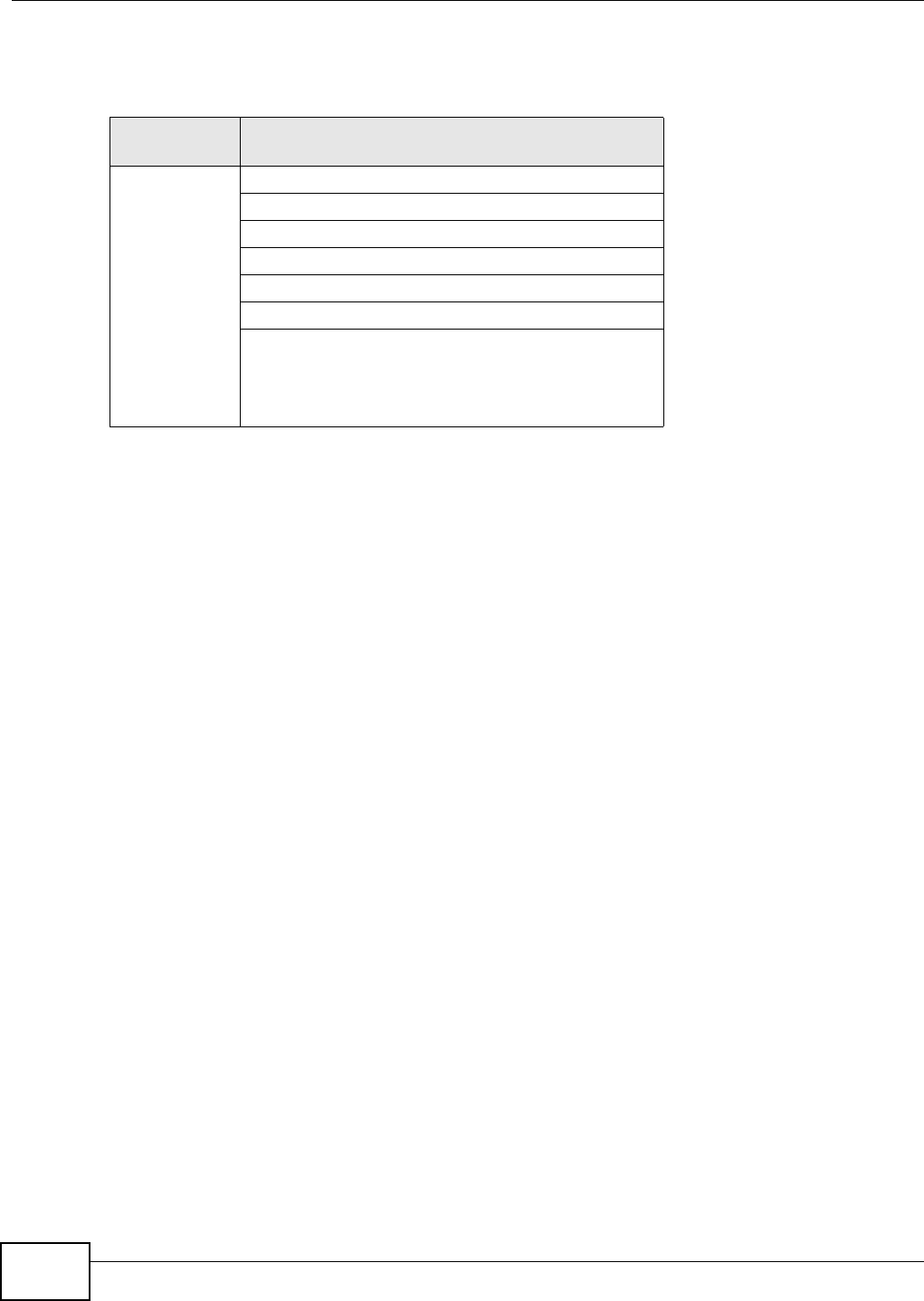
Appendix D Wireless LANs
NBG-419N v2 User’s Guide
254
The following figure shows the relative effectiveness of these wireless security methods available on
your Router.
Note: You must enable the same wireless security settings on the Router and on all
wireless clients that you want to associate with it.
IEEE 802.1x
In June 2001, the IEEE 802.1x standard was designed to extend the features of IEEE 802.11 to
support extended authentication as well as providing additional accounting and control features. It
is supported by Windows XP and a number of network devices. Some advantages of IEEE 802.1x
are:
• User based identification that allows for roaming.
• Support for RADIUS (Remote Authentication Dial In User Service, RFC 2138, 2139) for
centralized user profile and accounting management on a network RADIUS server.
• Support for EAP (Extensible Authentication Protocol, RFC 2486) that allows additional
authentication methods to be deployed with no changes to the access point or the wireless
clients.
RADIUS
RADIUS is based on a client-server model that supports authentication, authorization and
accounting. The access point is the client and the server is the RADIUS server. The RADIUS server
handles the following tasks:
• Authentication
Determines the identity of the users.
•Authorization
Determines the network services available to authenticated users once they are connected to the
network.
• Accounting
Keeps track of the client’s network activity.
Table 96 Wireless Security Levels
SECURITY
LEVEL SECURITY TYPE
Least
Secure
Most Secure
Unique SSID (Default)
Unique SSID with Hide SSID Enabled
MAC Address Filtering
WEP Encryption
IEEE802.1x EAP with RADIUS Server Authentication
Wi-Fi Protected Access (WPA)
WPA2

Appendix D Wireless LANs
NBG-419N v2 User’s Guide 255
RADIUS is a simple package exchange in which your AP acts as a message relay between the
wireless client and the network RADIUS server.
Types of RADIUS Messages
The following types of RADIUS messages are exchanged between the access point and the RADIUS
server for user authentication:
• Access-Request
Sent by an access point requesting authentication.
• Access-Reject
Sent by a RADIUS server rejecting access.
• Access-Accept
Sent by a RADIUS server allowing access.
• Access-Challenge
Sent by a RADIUS server requesting more information in order to allow access. The access point
sends a proper response from the user and then sends another Access-Request message.
The following types of RADIUS messages are exchanged between the access point and the RADIUS
server for user accounting:
• Accounting-Request
Sent by the access point requesting accounting.
• Accounting-Response
Sent by the RADIUS server to indicate that it has started or stopped accounting.
In order to ensure network security, the access point and the RADIUS server use a shared secret
key, which is a password, they both know. The key is not sent over the network. In addition to the
shared key, password information exchanged is also encrypted to protect the network from
unauthorized access.
Types of EAP Authentication
This section discusses some popular authentication types: EAP-MD5, EAP-TLS, EAP-TTLS, PEAP and
LEAP. Your wireless LAN device may not support all authentication types.
EAP (Extensible Authentication Protocol) is an authentication protocol that runs on top of the IEEE
802.1x transport mechanism in order to support multiple types of user authentication. By using EAP
to interact with an EAP-compatible RADIUS server, an access point helps a wireless station and a
RADIUS server perform authentication.
The type of authentication you use depends on the RADIUS server and an intermediary AP(s) that
supports IEEE 802.1x. .
For EAP-TLS authentication type, you must first have a wired connection to the network and obtain
the certificate(s) from a certificate authority (CA). A certificate (also called digital IDs) can be used
to authenticate users and a CA issues certificates and guarantees the identity of each certificate
owner.

Appendix D Wireless LANs
NBG-419N v2 User’s Guide
256
EAP-MD5 (Message-Digest Algorithm 5)
MD5 authentication is the simplest one-way authentication method. The authentication server
sends a challenge to the wireless client. The wireless client ‘proves’ that it knows the password by
encrypting the password with the challenge and sends back the information. Password is not sent in
plain text.
However, MD5 authentication has some weaknesses. Since the authentication server needs to get
the plaintext passwords, the passwords must be stored. Thus someone other than the
authentication server may access the password file. In addition, it is possible to impersonate an
authentication server as MD5 authentication method does not perform mutual authentication.
Finally, MD5 authentication method does not support data encryption with dynamic session key. You
must configure WEP encryption keys for data encryption.
EAP-TLS (Transport Layer Security)
With EAP-TLS, digital certifications are needed by both the server and the wireless clients for
mutual authentication. The server presents a certificate to the client. After validating the identity of
the server, the client sends a different certificate to the server. The exchange of certificates is done
in the open before a secured tunnel is created. This makes user identity vulnerable to passive
attacks. A digital certificate is an electronic ID card that authenticates the sender’s identity.
However, to implement EAP-TLS, you need a Certificate Authority (CA) to handle certificates, which
imposes a management overhead.
EAP-TTLS (Tunneled Transport Layer Service)
EAP-TTLS is an extension of the EAP-TLS authentication that uses certificates for only the server-
side authentications to establish a secure connection. Client authentication is then done by sending
username and password through the secure connection, thus client identity is protected. For client
authentication, EAP-TTLS supports EAP methods and legacy authentication methods such as PAP,
CHAP, MS-CHAP and MS-CHAP v2.
PEAP (Protected EAP)
Like EAP-TTLS, server-side certificate authentication is used to establish a secure connection, then
use simple username and password methods through the secured connection to authenticate the
clients, thus hiding client identity. However, PEAP only supports EAP methods, such as EAP-MD5,
EAP-MSCHAPv2 and EAP-GTC (EAP-Generic Token Card), for client authentication. EAP-GTC is
implemented only by Cisco.
LEAP
LEAP (Lightweight Extensible Authentication Protocol) is a Cisco implementation of IEEE 802.1x.
Dynamic WEP Key Exchange
The AP maps a unique key that is generated with the RADIUS server. This key expires when the
wireless connection times out, disconnects or reauthentication times out. A new WEP key is
generated each time reauthentication is performed.
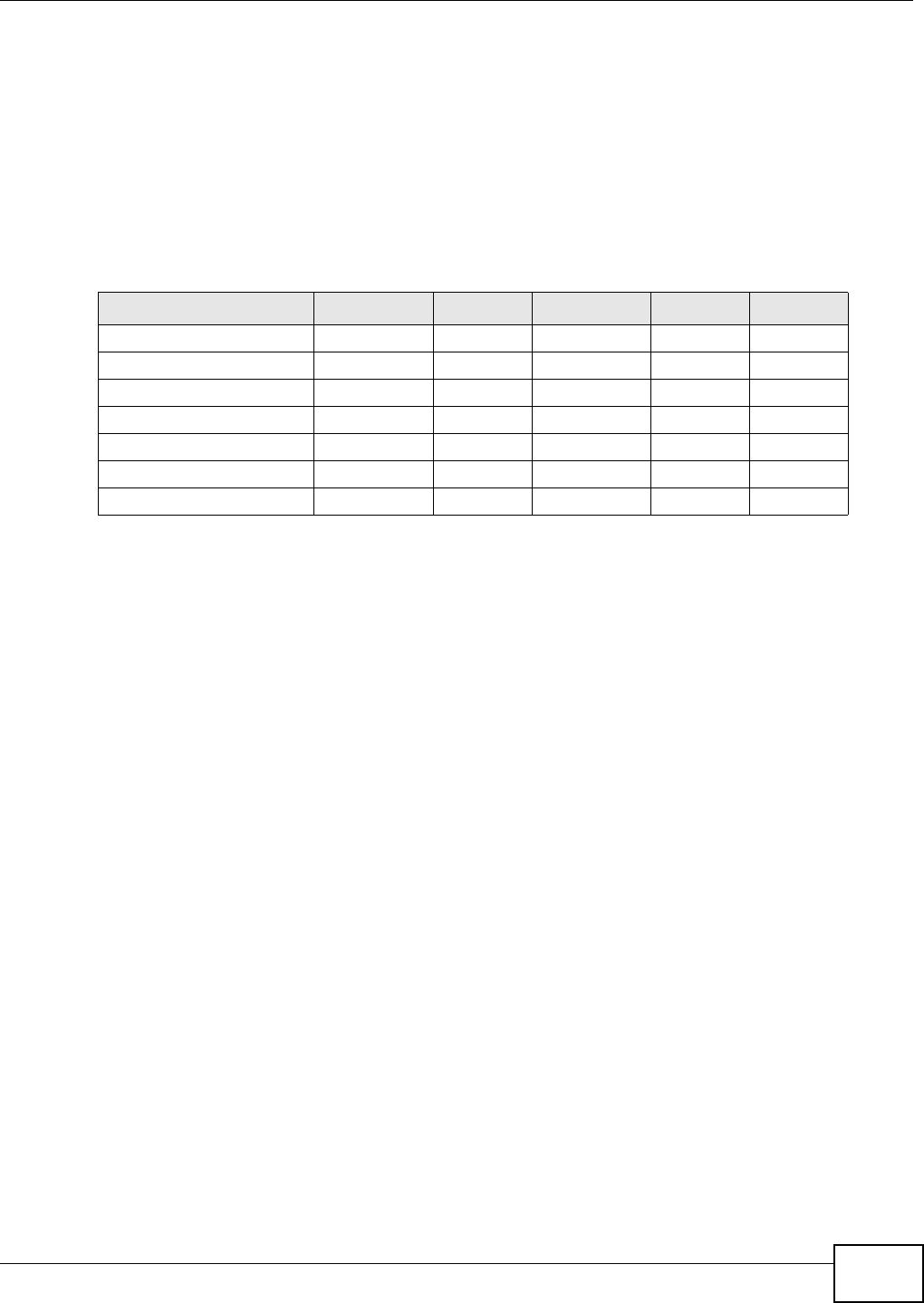
Appendix D Wireless LANs
NBG-419N v2 User’s Guide 257
If this feature is enabled, it is not necessary to configure a default encryption key in the wireless
security configuration screen. You may still configure and store keys, but they will not be used while
dynamic WEP is enabled.
Note: EAP-MD5 cannot be used with Dynamic WEP Key Exchange
For added security, certificate-based authentications (EAP-TLS, EAP-TTLS and PEAP) use dynamic
keys for data encryption. They are often deployed in corporate environments, but for public
deployment, a simple user name and password pair is more practical. The following table is a
comparison of the features of authentication types.
WPA and WPA2
Wi-Fi Protected Access (WPA) is a subset of the IEEE 802.11i standard. WPA2 (IEEE 802.11i) is a
wireless security standard that defines stronger encryption, authentication and key management
than WPA.
Key differences between WPA or WPA2 and WEP are improved data encryption and user
authentication.
If both an AP and the wireless clients support WPA2 and you have an external RADIUS server, use
WPA2 for stronger data encryption. If you don't have an external RADIUS server, you should use
WPA2-PSK (WPA2-Pre-Shared Key) that only requires a single (identical) password entered into
each access point, wireless gateway and wireless client. As long as the passwords match, a wireless
client will be granted access to a WLAN.
If the AP or the wireless clients do not support WPA2, just use WPA or WPA-PSK depending on
whether you have an external RADIUS server or not.
Select WEP only when the AP and/or wireless clients do not support WPA or WPA2. WEP is less
secure than WPA or WPA2.
Encryption
WPA improves data encryption by using Temporal Key Integrity Protocol (TKIP), Message Integrity
Check (MIC) and IEEE 802.1x. WPA2 also uses TKIP when required for compatibility reasons, but
offers stronger encryption than TKIP with Advanced Encryption Standard (AES) in the Counter
mode with Cipher block chaining Message authentication code Protocol (CCMP).
TKIP uses 128-bit keys that are dynamically generated and distributed by the authentication server.
AES (Advanced Encryption Standard) is a block cipher that uses a 256-bit mathematical algorithm
Table 97 Comparison of EAP Authentication Types
EAP-MD5 EAP-TLS EAP-TTLS PEAP LEAP
Mutual Authentication No Yes Yes Yes Yes
Certificate – Client No Yes Optional Optional No
Certificate – Server No Yes Yes Yes No
Dynamic Key Exchange No Yes Yes Yes Yes
Credential Integrity None Strong Strong Strong Moderate
Deployment Difficulty Easy Hard Moderate Moderate Moderate
Client Identity Protection No No Yes Yes No

Appendix D Wireless LANs
NBG-419N v2 User’s Guide
258
called Rijndael. They both include a per-packet key mixing function, a Message Integrity Check
(MIC) named Michael, an extended initialization vector (IV) with sequencing rules, and a re-keying
mechanism.
WPA and WPA2 regularly change and rotate the encryption keys so that the same encryption key is
never used twice.
The RADIUS server distributes a Pairwise Master Key (PMK) key to the AP that then sets up a key
hierarchy and management system, using the PMK to dynamically generate unique data encryption
keys to encrypt every data packet that is wirelessly communicated between the AP and the wireless
clients. This all happens in the background automatically.
The Message Integrity Check (MIC) is designed to prevent an attacker from capturing data packets,
altering them and resending them. The MIC provides a strong mathematical function in which the
receiver and the transmitter each compute and then compare the MIC. If they do not match, it is
assumed that the data has been tampered with and the packet is dropped.
By generating unique data encryption keys for every data packet and by creating an integrity
checking mechanism (MIC), with TKIP and AES it is more difficult to decrypt data on a Wi-Fi
network than WEP and difficult for an intruder to break into the network.
The encryption mechanisms used for WPA(2) and WPA(2)-PSK are the same. The only difference
between the two is that WPA(2)-PSK uses a simple common password, instead of user-specific
credentials. The common-password approach makes WPA(2)-PSK susceptible to brute-force
password-guessing attacks but it’s still an improvement over WEP as it employs a consistent,
single, alphanumeric password to derive a PMK which is used to generate unique temporal
encryption keys. This prevent all wireless devices sharing the same encryption keys. (a weakness of
WEP)
User Authentication
WPA and WPA2 apply IEEE 802.1x and Extensible Authentication Protocol (EAP) to authenticate
wireless clients using an external RADIUS database. WPA2 reduces the number of key exchange
messages from six to four (CCMP 4-way handshake) and shortens the time required to connect to a
network. Other WPA2 authentication features that are different from WPA include key caching and
pre-authentication. These two features are optional and may not be supported in all wireless
devices.
Key caching allows a wireless client to store the PMK it derived through a successful authentication
with an AP. The wireless client uses the PMK when it tries to connect to the same AP and does not
need to go with the authentication process again.
Pre-authentication enables fast roaming by allowing the wireless client (already connecting to an
AP) to perform IEEE 802.1x authentication with another AP before connecting to it.
Wireless Client WPA Supplicants
A wireless client supplicant is the software that runs on an operating system instructing the wireless
client how to use WPA. At the time of writing, the most widely available supplicant is the WPA patch
for Windows XP, Funk Software's Odyssey client.
The Windows XP patch is a free download that adds WPA capability to Windows XP's built-in "Zero
Configuration" wireless client. However, you must run Windows XP to use it.
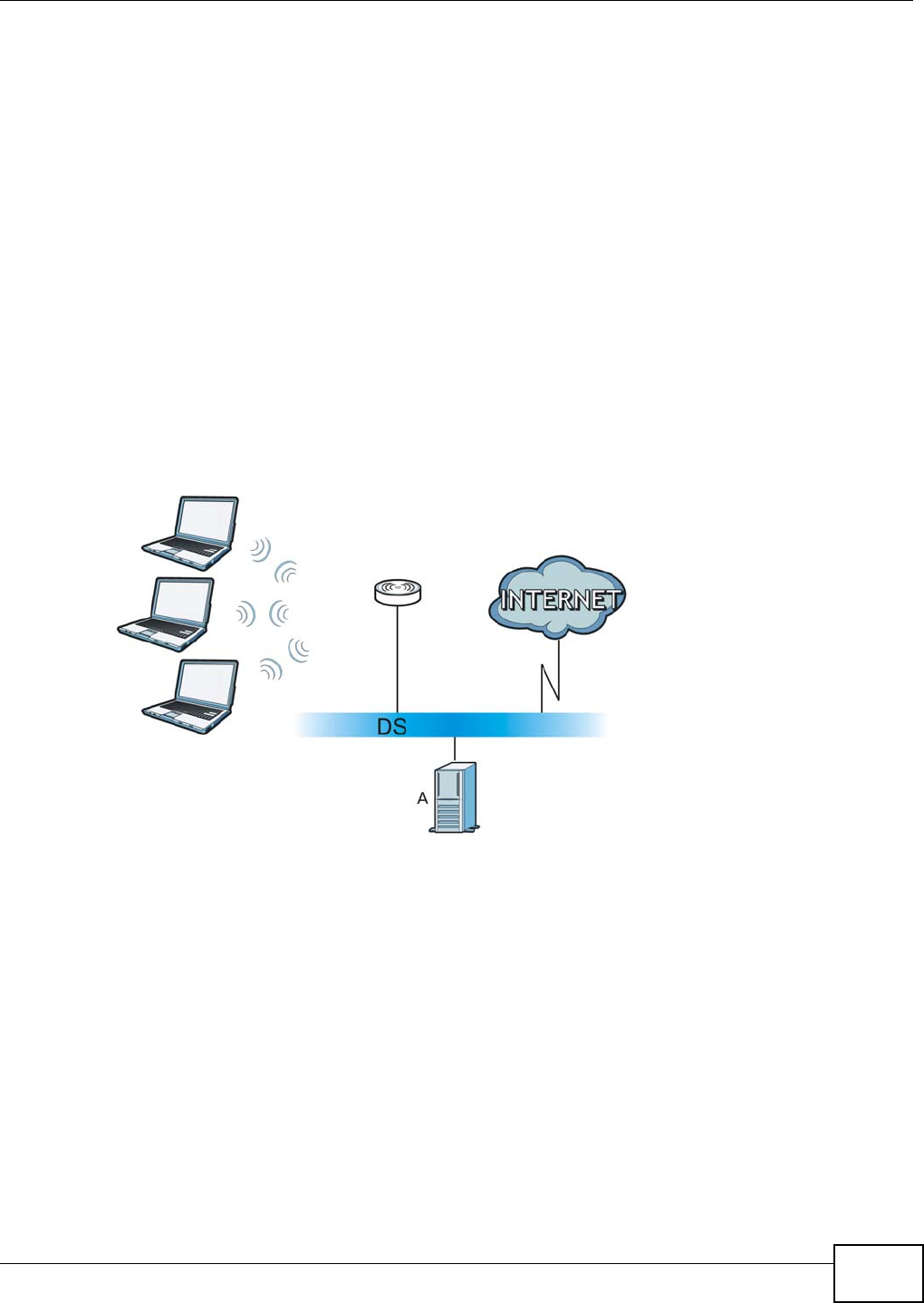
Appendix D Wireless LANs
NBG-419N v2 User’s Guide 259
WPA(2) with RADIUS Application Example
To set up WPA(2), you need the IP address of the RADIUS server, its port number (default is 1812),
and the RADIUS shared secret. A WPA(2) application example with an external RADIUS server
looks as follows. "A" is the RADIUS server. "DS" is the distribution system.
1The AP passes the wireless client's authentication request to the RADIUS server.
2The RADIUS server then checks the user's identification against its database and grants or denies
network access accordingly.
3A 256-bit Pairwise Master Key (PMK) is derived from the authentication process by the RADIUS
server and the client.
4The RADIUS server distributes the PMK to the AP. The AP then sets up a key hierarchy and
management system, using the PMK to dynamically generate unique data encryption keys. The
keys are used to encrypt every data packet that is wirelessly communicated between the AP and
the wireless clients.
Figure 169 WPA(2) with RADIUS Application Example
WPA(2)-PSK Application Example
A WPA(2)-PSK application looks as follows.
1First enter identical passwords into the AP and all wireless clients. The Pre-Shared Key (PSK) must
consist of between 8 and 63 ASCII characters or 64 hexadecimal characters (including spaces and
symbols).
2The AP checks each wireless client's password and allows it to join the network only if the password
matches.
3The AP and wireless clients generate a common PMK (Pairwise Master Key). The key itself is not
sent over the network, but is derived from the PSK and the SSID.
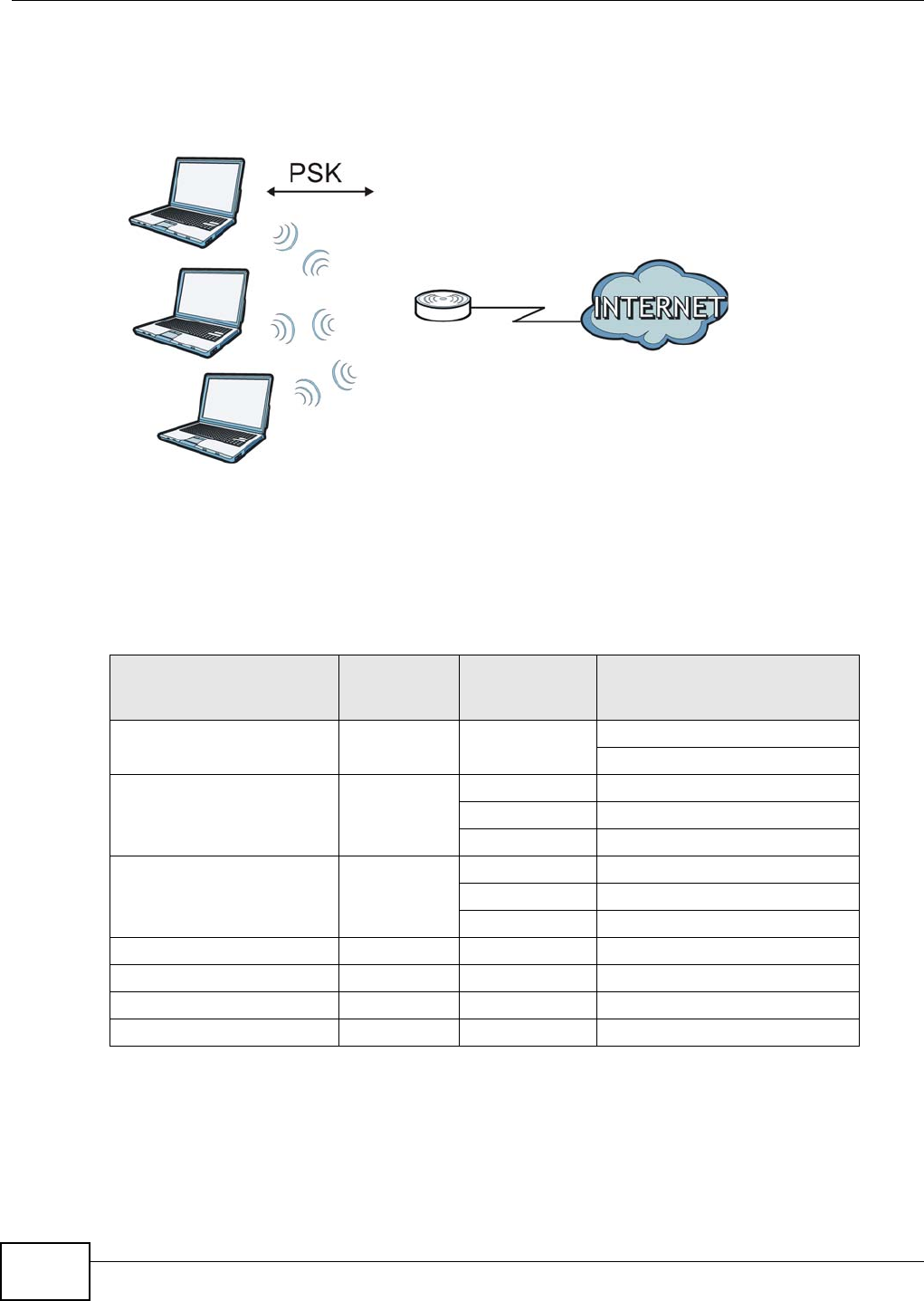
Appendix D Wireless LANs
NBG-419N v2 User’s Guide
260
4The AP and wireless clients use the TKIP or AES encryption process, the PMK and information
exchanged in a handshake to create temporal encryption keys. They use these keys to encrypt data
exchanged between them.
Figure 170 WPA(2)-PSK Authentication
Security Parameters Summary
Refer to this table to see what other security parameters you should configure for each
authentication method or key management protocol type. MAC address filters are not dependent on
how you configure these security features.
Antenna Overview
An antenna couples RF signals onto air. A transmitter within a wireless device sends an RF signal to
the antenna, which propagates the signal through the air. The antenna also operates in reverse by
capturing RF signals from the air.
Table 98 Wireless Security Relational Matrix
AUTHENTICATION
METHOD/ KEY
MANAGEMENT PROTOCOL
ENCRYPTIO
N METHOD ENTER
MANUAL KEY IEEE 802.1X
Open None No Disable
Enable without Dynamic WEP Key
Open WEP No Enable with Dynamic WEP Key
Yes Enable without Dynamic WEP Key
Yes Disable
Shared WEP No Enable with Dynamic WEP Key
Yes Enable without Dynamic WEP Key
Yes Disable
WPA TKIP/AES No Enable
WPA-PSK TKIP/AES Yes Disable
WPA2 TKIP/AES No Enable
WPA2-PSK TKIP/AES Yes Disable

Appendix D Wireless LANs
NBG-419N v2 User’s Guide 261
Positioning the antennas properly increases the range and coverage area of a wireless LAN.
Antenna Characteristics
Frequency
An antenna in the frequency of 2.4GHz or 5GHz is needed to communicate efficiently in a wireless
LAN
Radiation Pattern
A radiation pattern is a diagram that allows you to visualize the shape of the antenna’s coverage
area.
Antenna Gain
Antenna gain, measured in dB (decibel), is the increase in coverage within the RF beam width.
Higher antenna gain improves the range of the signal for better communications.
For an indoor site, each 1 dB increase in antenna gain results in a range increase of approximately
2.5%. For an unobstructed outdoor site, each 1dB increase in gain results in a range increase of
approximately 5%. Actual results may vary depending on the network environment.
Antenna gain is sometimes specified in dBi, which is how much the antenna increases the signal
power compared to using an isotropic antenna. An isotropic antenna is a theoretical perfect antenna
that sends out radio signals equally well in all directions. dBi represents the true gain that the
antenna provides.
Types of Antennas for WLAN
There are two types of antennas used for wireless LAN applications.
• Omni-directional antennas send the RF signal out in all directions on a horizontal plane. The
coverage area is torus-shaped (like a donut) which makes these antennas ideal for a room
environment. With a wide coverage area, it is possible to make circular overlapping coverage
areas with multiple access points.
• Directional antennas concentrate the RF signal in a beam, like a flashlight does with the light
from its bulb. The angle of the beam determines the width of the coverage pattern. Angles
typically range from 20 degrees (very directional) to 120 degrees (less directional). Directional
antennas are ideal for hallways and outdoor point-to-point applications.
Positioning Antennas
In general, antennas should be mounted as high as practically possible and free of obstructions. In
point-to–point application, position both antennas at the same height and in a direct line of sight to
each other to attain the best performance.
For omni-directional antennas mounted on a table, desk, and so on, point the antenna up. For
omni-directional antennas mounted on a wall or ceiling, point the antenna down. For a single AP
application, place omni-directional antennas as close to the center of the coverage area as possible.

Appendix D Wireless LANs
NBG-419N v2 User’s Guide
262
For directional antennas, point the antenna in the direction of the desired coverage area.
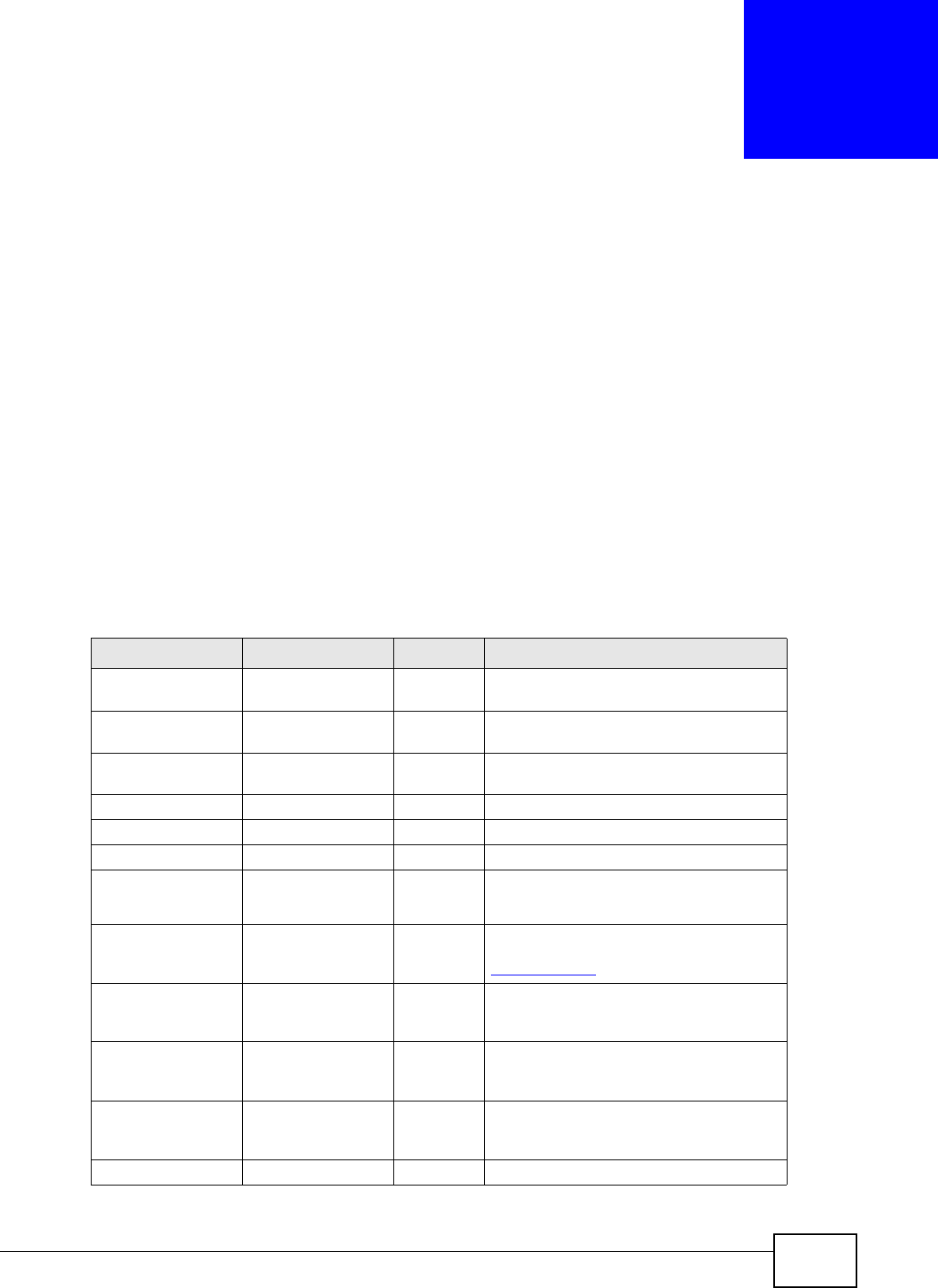
NBG-419N v2 User’s Guide 263
APPENDIX E
Common Services
The following table lists some commonly-used services and their associated protocols and port
numbers. For a comprehensive list of port numbers, ICMP type/code numbers and services, visit
the IANA (Internet Assigned Number Authority) web site.
•Name: This is a short, descriptive name for the service. You can use this one or create a
different one, if you like.
•Protocol: This is the type of IP protocol used by the service. If this is TCP/UDP, then the service
uses the same port number with TCP and UDP. If this is USER-DEFINED, the Port(s) is the IP
protocol number, not the port number.
•Port(s): This value depends on the Protocol. Please refer to RFC 1700 for further information
about port numbers.
•If the Protocol is TCP, UDP, or TCP/UDP, this is the IP port number.
•If the Protocol is USER, this is the IP protocol number.
•Description: This is a brief explanation of the applications that use this service or the situations
in which this service is used.
Table 99 Commonly Used Services
NAME PROTOCOL PORT(S) DESCRIPTION
AH
(IPSEC_TUNNEL)
User-Defined 51 The IPSEC AH (Authentication Header)
tunneling protocol uses this service.
AIM/New-ICQ TCP 5190 AOL’s Internet Messenger service. It is
also used as a listening port by ICQ.
AUTH TCP 113 Authentication protocol used by some
servers.
BGP TCP 179 Border Gateway Protocol.
BOOTP_CLIENT UDP 68 DHCP Client.
BOOTP_SERVER UDP 67 DHCP Server.
CU-SEEME TCP
UDP
7648
24032
A popular videoconferencing solution from
White Pines Software.
DNS TCP/UDP 53 Domain Name Server, a service that
matches web names (for example
www.zyxel.com) to IP numbers.
ESP
(IPSEC_TUNNEL)
User-Defined 50 The IPSEC ESP (Encapsulation Security
Protocol) tunneling protocol uses this
service.
FINGER TCP 79 Finger is a UNIX or Internet related
command that can be used to find out if a
user is logged on.
FTP TCP
TCP
20
21
File Transfer Program, a program to enable
fast transfer of files, including large files
that may not be possible by e-mail.
H.323 TCP 1720 NetMeeting uses this protocol.

Appendix E Common Services
NBG-419N v2 User’s Guide
264
HTTP TCP 80 Hyper Text Transfer Protocol - a client/
server protocol for the world wide web.
HTTPS TCP 443 HTTPS is a secured http session often used
in e-commerce.
ICMP User-Defined 1Internet Control Message Protocol is often
used for diagnostic or routing purposes.
ICQ UDP 4000 This is a popular Internet chat program.
IGMP (MULTICAST) User-Defined 2Internet Group Management Protocol is
used when sending packets to a specific
group of hosts.
IKE UDP 500 The Internet Key Exchange algorithm is
used for key distribution and
management.
IRC TCP/UDP 6667 This is another popular Internet chat
program.
MSN Messenger TCP 1863 Microsoft Networks’ messenger service
uses this protocol.
NEW-ICQ TCP 5190 An Internet chat program.
NEWS TCP 144 A protocol for news groups.
NFS UDP 2049 Network File System - NFS is a client/
server distributed file service that provides
transparent file sharing for network
environments.
NNTP TCP 119 Network News Transport Protocol is the
delivery mechanism for the USENET
newsgroup service.
PING User-Defined 1Packet INternet Groper is a protocol that
sends out ICMP echo requests to test
whether or not a remote host is reachable.
POP3 TCP 110 Post Office Protocol version 3 lets a client
computer get e-mail from a POP3 server
through a temporary connection (TCP/IP
or other).
PPTP TCP 1723 Point-to-Point Tunneling Protocol enables
secure transfer of data over public
networks. This is the control channel.
PPTP_TUNNEL
(GRE)
User-Defined 47 PPTP (Point-to-Point Tunneling Protocol)
enables secure transfer of data over public
networks. This is the data channel.
RCMD TCP 512 Remote Command Service.
REAL_AUDIO TCP 7070 A streaming audio service that enables
real time sound over the web.
REXEC TCP 514 Remote Execution Daemon.
RLOGIN TCP 513 Remote Login.
RTELNET TCP 107 Remote Telnet.
RTSP TCP/UDP 554 The Real Time Streaming (media control)
Protocol (RTSP) is a remote control for
multimedia on the Internet.
SFTP TCP 115 Simple File Transfer Protocol.
Table 99 Commonly Used Services (continued)
NAME PROTOCOL PORT(S) DESCRIPTION

Appendix E Common Services
NBG-419N v2 User’s Guide 265
SMTP TCP 25 Simple Mail Transfer Protocol is the
message-exchange standard for the
Internet. SMTP enables you to move
messages from one e-mail server to
another.
SNMP TCP/UDP 161 Simple Network Management Program.
SNMP-TRAPS TCP/UDP 162 Traps for use with the SNMP (RFC:1215).
SQL-NET TCP 1521 Structured Query Language is an interface
to access data on many different types of
database systems, including mainframes,
midrange systems, UNIX systems and
network servers.
SSH TCP/UDP 22 Secure Shell Remote Login Program.
STRM WORKS UDP 1558 Stream Works Protocol.
SYSLOG UDP 514 Syslog allows you to send system logs to a
UNIX server.
TACACS UDP 49 Login Host Protocol used for (Terminal
Access Controller Access Control System).
TELNET TCP 23 Telnet is the login and terminal emulation
protocol common on the Internet and in
UNIX environments. It operates over TCP/
IP networks. Its primary function is to
allow users to log into remote host
systems.
TFTP UDP 69 Trivial File Transfer Protocol is an Internet
file transfer protocol similar to FTP, but
uses the UDP (User Datagram Protocol)
rather than TCP (Transmission Control
Protocol).
VDOLIVE TCP 7000 Another videoconferencing solution.
Table 99 Commonly Used Services (continued)
NAME PROTOCOL PORT(S) DESCRIPTION

Appendix E Common Services
NBG-419N v2 User’s Guide
266

NBG-419N v2 User’s Guide 267
APPENDIX F
Legal Information
Copyright
Copyright © 2012 by ZyXEL Communications Corporation.
The contents of this publication may not be reproduced in any part or as a whole, transcribed,
stored in a retrieval system, translated into any language, or transmitted in any form or by any
means, electronic, mechanical, magnetic, optical, chemical, photocopying, manual, or otherwise,
without the prior written permission of ZyXEL Communications Corporation.
Published by ZyXEL Communications Corporation. All rights reserved.
Disclaimer
ZyXEL does not assume any liability arising out of the application or use of any products, or
software described herein. Neither does it convey any license under its patent rights nor the patent
rights of others. ZyXEL further reserves the right to make changes in any products described herein
without notice. This publication is subject to change without notice.
Certifications
Federal Communications Commission (FCC) Interference Statement
The device complies with Part 15 of FCC rules. Operation is subject to the following two conditions:
• This device may not cause harmful interference.
• This device must accept any interference received, including interference that may cause
undesired operations.
This device has been tested and found to comply with the limits for a Class B digital device pursuant
to Part 15 of the FCC Rules. These limits are designed to provide reasonable protection against
harmful interference in a residential installation. This device generates, uses, and can radiate radio
frequency energy, and if not installed and used in accordance with the instructions, may cause
harmful interference to radio communications. However, there is no guarantee that interference will
not occur in a particular installation.
If this device does cause harmful interference to radio/television reception, which can be
determined by turning the device off and on, the user is encouraged to try to correct the
interference by one or more of the following measures:
1Reorient or relocate the receiving antenna.
2Increase the separation between the equipment and the receiver.

Appendix F Legal Information
NBG-419N v2 User’s Guide
268
3Connect the equipment into an outlet on a circuit different from that to which the receiver is
connected.
4Consult the dealer or an experienced radio/TV technician for help.
FCC Radiation Exposure Statement
• This transmitter must not be co-located or operating in conjunction with any other antenna or
transmitter.
• IEEE 802.11b or 802.11g operation of this product in the U.S.A. is firmware-limited to channels 1
through 11.
• To comply with FCC RF exposure compliance requirements, a separation distance of at least 20
cm must be maintained between the antenna of this device and all persons.
注意 !
依據 低功率電波輻射性電機管理辦法
第十二條 經型式認證合格之低功率射頻電機,非經許可,公司、商號或使用
者均不得擅自變更頻率、加大功率或變更原設計之特性及功能。
第十四條 低功率射頻電機之使用不得影響飛航安全及干擾合法通信;經發現
有干擾現象時,應立即停用,並改善至無干擾時方得繼續使用。
前項合法通信,指依電信規定作業之無線電信。低功率射頻電機須忍
受合法通信或工業、科學及醫療用電波輻射性電機設備之干擾。
本機限在不干擾合法電臺與不受被干擾保障條件下於室內使用。
減少電磁波影響,請妥適使用。
Notices
Changes or modifications not expressly approved by the party responsible for compliance could
void the user's authority to operate the equipment.
This device has been designed for the WLAN 2.4 GHz network throughout the EC region and
Switzerland, with restrictions in France.
This Class B digital apparatus complies with Canadian ICES-003.
Cet appareil numérique de la classe B est conforme à la norme NMB-003 du Canada.
Industry Canada Statement
This device complies with RSS-210 of the Industry Canada Rules. Operation is subject to the
following two conditions:
1this device may not cause interference and

Appendix F Legal Information
NBG-419N v2 User’s Guide 269
2this device must accept any interference, including interference that may cause undesired
operation of the device
This device has been designed to operate with an antenna having a maximum gain of 2dBi.
Antenna having a higher gain is strictly prohibited per regulations of Industry Canada. The required
antenna impedance is 50 ohms.
To reduce potential radio interference to other users, the antenna type and its gain should be so
chosen that the EIRP is not more than required for successful communication.
IC Radiation Exposure Statement:
This equipment complies with IC radiation exposure limits set forth for an uncontrolled
environment. This equipment should be installed and operated with minimum distance 20cm
between the radiator & your body.
Viewing Certifications
1Go to http://www.zyxel.com.
2Select your product on the ZyXEL home page to go to that product's page.
3Select the certification you wish to view from this page.
ZyXEL Limited Warranty
ZyXEL warrants to the original end user (purchaser) that this product is free from any defects in
material or workmanship for a specific period (the Warranty Period) from the date of purchase. The
Warranty Period varies by region. Check with your vendor and/or the authorized ZyXEL local
distributor for details about the Warranty Period of this product. During the warranty period, and
upon proof of purchase, should the product have indications of failure due to faulty workmanship
and/or materials, ZyXEL will, at its discretion, repair or replace the defective products or
components without charge for either parts or labor, and to whatever extent it shall deem
necessary to restore the product or components to proper operating condition. Any replacement
will consist of a new or re-manufactured functionally equivalent product of equal or higher value,
and will be solely at the discretion of ZyXEL. This warranty shall not apply if the product has been
modified, misused, tampered with, damaged by an act of God, or subjected to abnormal working
conditions.
Note
Repair or replacement, as provided under this warranty, is the exclusive remedy of the purchaser.
This warranty is in lieu of all other warranties, express or implied, including any implied warranty of
merchantability or fitness for a particular use or purpose. ZyXEL shall in no event be held liable for
indirect or consequential damages of any kind to the purchaser.
To obtain the services of this warranty, contact your vendor. You may also refer to the warranty
policy for the region in which you bought the device at http://www.zyxel.com/web/
support_warranty_info.php.

Appendix F Legal Information
NBG-419N v2 User’s Guide
270
Registration
Register your product online to receive e-mail notices of firmware upgrades and information at
www.zyxel.com.
Open Source Licenses
This product contains in part some free software distributed under GPL license terms and/or GPL
like licenses. Open source licenses are provided with the firmware package. You can download the
latest firmware at www.zyxel.com. To obtain the source code covered under those Licenses, please
contact support@zyxel.com.tw to get it.
Regulatory Information
European Union
The following information applies if you use the product within the European Union.
Declaration of Conformity with Regard to EU Directive 1999/5/EC (R&TTE
Directive)
Compliance Information for 2.4GHz and 5GHz Wireless Products Relevant to the EU and Other
Countries Following the EU Directive 1999/5/EC (R&TTE Directive)
[Czech] ZyXEL tímto prohlašuje, že tento zařízení je ve shodě se základními požadavky a dalšími
příslušnými ustanoveními směrnice 1999/5/EC.
[Danish] Undertegnede ZyXEL erklærer herved, at følgende udstyr udstyr overholder de væsentlige
krav og øvrige relevante krav i direktiv 1999/5/EF.
[German] Hiermit erklärt ZyXEL, dass sich das Gerät Ausstattung in Übereinstimmung mit den
grundlegenden Anforderungen und den übrigen einschlägigen Bestimmungen der Richtlinie
1999/5/EU befindet.
[Estonian] Käesolevaga kinnitab ZyXEL seadme seadmed vastavust direktiivi 1999/5/EÜ põhinõuetele
ja nimetatud direktiivist tulenevatele teistele asjakohastele sätetele.
English Hereby, ZyXEL declares that this equipment is in compliance with the essential
requirements and other relevant provisions of Directive 1999/5/EC.
[Spanish] Por medio de la presente ZyXEL declara que el equipo cumple con los requisitos esenciales
y cualesquiera otras disposiciones aplicables o exigibles de la Directiva 1999/5/CE.
[Greek] ΜΕ ΤΗΝ ΠΑΡΟΥΣΑ ZyXEL ∆ΗΛΩΝΕΙ ΟΤΙ εξοπλισμός ΣΥΜΜΟΡΦΩΝΕΤΑΙ ΠΡΟΣ ΤΙΣ
ΟΥΣΙΩ∆ΕΙΣ ΑΠΑΙΤΗΣΕΙΣ ΚΑΙ ΤΙΣ ΛΟΙΠΕΣ ΣΧΕΤΙΚΕΣ ∆ΙΑΤΑΞΕΙΣ ΤΗΣ Ο∆ΗΓΙΑΣ 1999/5/ΕC.
[French] Par la présente ZyXEL déclare que l'appareil équipements est conforme aux exigences
essentielles et aux autres dispositions pertinentes de la directive 1999/5/EC.
[Italian] Con la presente ZyXEL dichiara che questo attrezzatura è conforme ai requisiti essenziali ed
alle altre disposizioni pertinenti stabilite dalla direttiva 1999/5/CE.
[Latvian] Ar šo ZyXEL deklarē, ka iekārtas atbilst Direktīvas 1999/5/EK būtiskajām prasībām un
citiem ar to saistītajiem noteikumiem.
[Lithuanian] Šiuo ZyXEL deklaruoja, kad šis įranga atitinka esminius reikalavimus ir kitas 1999/5/EB
Direktyvos nuostatas.
[Dutch] Hierbij verklaart ZyXEL dat het toestel uitrusting in overeenstemming is met de essentiële
eisen en de andere relevante bepalingen van richtlijn 1999/5/EC.

Appendix F Legal Information
NBG-419N v2 User’s Guide 271
National Restrictions
This product may be used in all EU countries (and other countries following the EU directive 1999/
5/EC) without any limitation except for the countries mentioned below:
Ce produit peut être utilisé dans tous les pays de l’UE (et dans tous les pays ayant transposés la
directive 1999/5/CE) sans aucune limitation, excepté pour les pays mentionnés ci-dessous:
Questo prodotto è utilizzabile in tutte i paesi EU (ed in tutti gli altri paesi che seguono le direttive EU
1999/5/EC) senza nessuna limitazione, eccetto per i paesii menzionati di seguito:
Das Produkt kann in allen EU Staaten ohne Einschränkungen eingesetzt werden (sowie in anderen
Staaten die der EU Direktive 1995/5/CE folgen) mit Außnahme der folgenden aufgeführten
Staaten:
In the majority of the EU and other European countries, the 2, 4- and 5-GHz bands have been
made available for the use of wireless local area networks (LANs). Later in this document you will
find an overview of countries inwhich additional restrictions or requirements or both are applicable.
The requirements for any country may evolve. ZyXEL recommends that you check with the local
authorities for the latest status of their national regulations for both the 2,4- and 5-GHz wireless
LANs.
[Maltese] Hawnhekk, ZyXEL, jiddikjara li dan tagħmir jikkonforma mal-ħtiġijiet essenzjali u ma
provvedimenti oħrajn relevanti li hemm fid-Dirrettiva 1999/5/EC.
[Hungarian] Alulírott, ZyXEL nyilatkozom, hogy a berendezés megfelel a vonatkozó alapvetõ
követelményeknek és az 1999/5/EK irányelv egyéb elõírásainak.
[Polish] Niniejszym ZyXEL oświadcza, że sprzęt jest zgodny z zasadniczymi wymogami oraz
pozostałymi stosownymi postanowieniami Dyrektywy 1999/5/EC.
[Portuguese] ZyXEL declara que este equipamento está conforme com os requisitos essenciais e outras
disposições da Directiva 1999/5/EC.
[Slovenian] ZyXEL izjavlja, da je ta oprema v skladu z bistvenimi zahtevami in ostalimi relevantnimi
določili direktive 1999/5/EC.
[Slovak] ZyXEL týmto vyhlasuje, že zariadenia spĺňa základné požiadavky a všetky príslušné
ustanovenia Smernice 1999/5/EC.
[Finnish] ZyXEL vakuuttaa täten että laitteet tyyppinen laite on direktiivin 1999/5/EY oleellisten
vaatimusten ja sitä koskevien direktiivin muiden ehtojen mukainen.
[Swedish] Härmed intygar ZyXEL att denna utrustning står I överensstämmelse med de väsentliga
egenskapskrav och övriga relevanta bestämmelser som framgår av direktiv 1999/5/EC.
[Bulgarian] С настоящото ZyXEL декларира, че това оборудване е в съответствие със съществените
изисквания и другите приложими разпоредбите на Директива 1999/5/ЕC.
[Icelandic] Hér með lýsir, ZyXEL því yfir að þessi búnaður er í samræmi við grunnkröfur og önnur
viðeigandi ákvæði tilskipunar 1999/5/EC.
[Norwegian] Erklærer herved ZyXEL at dette utstyret er I samsvar med de grunnleggende kravene og
andre relevante bestemmelser I direktiv 1999/5/EF.
[Romanian] Prin prezenta, ZyXEL declară că acest echipament este în conformitate cu cerinţele
esenţiale şi alte prevederi relevante ale Directivei 1999/5/EC.

Appendix F Legal Information
NBG-419N v2 User’s Guide
272
The following countries have restrictions and/or requirements in addition to those given in the table
labeled “Overview of Regulatory Requirements for Wireless LANs”:.
Belgium
The Belgian Institute for Postal Services and Telecommunications (BIPT) must be notified of any
outdoor wireless link having a range exceeding 300 meters. Please check http://www.bipt.be for
more details.
Draadloze verbindingen voor buitengebruik en met een reikwijdte van meer dan 300 meter dienen
aangemeld te worden bij het Belgisch Instituut voor postdiensten en telecommunicatie (BIPT). Zie
http://www.bipt.be voor meer gegevens.
Les liaisons sans fil pour une utilisation en extérieur d’une distance supérieure à 300 mètres
doivent être notifiées à l’Institut Belge des services Postaux et des Télécommunications (IBPT).
Visitez http://www.ibpt.be pour de plus amples détails.
Denmark
In Denmark, the band 5150 - 5350 MHz is also allowed for outdoor usage.
I Danmark må frekvensbåndet 5150 - 5350 også anvendes udendørs.
France
For 2.4 GHz, the output power is restricted to 10 mW EIRP when the product is used outdoors in the
band 2454 - 2483.5 MHz. There are no restrictions when used indoors or in other parts of the 2.4
GHz band. Check http://www.arcep.fr/ for more details.
Pour la bande 2.4 GHz, la puissance est limitée à 10 mW en p.i.r.e. pour les équipements utilisés en
extérieur dans la bande 2454 - 2483.5 MHz. Il n'y a pas de restrictions pour des utilisations en
intérieur ou dans d'autres parties de la bande 2.4 GHz. Consultez http://www.arcep.fr/ pour de plus
amples détails.
Italy
This product meets the National Radio Interface and the requirements specified in the National
Frequency Allocation Table for Italy. Unless this wireless LAN product is operating within the
Overview of Regulatory Requirements for Wireless LANs
Frequency Band (MHz) Max Power Level
(EIRP)1 (mW)
Indoor ONLY Indoor and Outdoor
2400-2483.5 100 V
5150-5350 200 V
5470-5725 1000 V
R&TTE 1999/5/EC
WLAN 2.4 – 2.4835 GHz
IEEE 802.11 b/g/n
Location Frequency Range(GHz) Power (EIRP)
Indoor (No restrictions) 2.4 – 2.4835 100mW (20dBm)
Outdoor 2.4 – 2.454 100mW (20dBm)
2.454 – 2.4835 10mW (10dBm)

Appendix F Legal Information
NBG-419N v2 User’s Guide 273
boundaries of the owner's property, its use requires a “general authorization.” Please check http://
www.sviluppoeconomico.gov.it/ for more details.
Questo prodotto è conforme alla specifiche di Interfaccia Radio Nazionali e rispetta il Piano
Nazionale di ripartizione delle frequenze in Italia. Se non viene installato all 'interno del proprio
fondo, l'utilizzo di prodotti Wireless LAN richiede una “Autorizzazione Generale”. Consultare http://
www.sviluppoeconomico.gov.it/ per maggiori dettagli.
Latvia
The outdoor usage of the 2.4 GHz band requires an authorization from the Electronic
Communications Office. Please check http://www.esd.lv for more details.
2.4 GHz frekvenèu joslas izmantoðanai ârpus telpâm nepiecieðama atïauja no Elektronisko sakaru
direkcijas. Vairâk informâcijas: http://www.esd.lv.
Notes:
1. Although Norway, Switzerland and Liechtenstein are not EU member states, the EU Directive
1999/5/EC has also been implemented in those countries.
2. The regulatory limits for maximum output power are specified in EIRP. The EIRP level (in dBm) of
a device can be calculated by adding the gain of the antenna used(specified in dBi) to the output
power available at the connector (specified in dBm).
List of national codes
Safety Warnings
• Do NOT use this product near water, for example, in a wet basement or near a swimming pool.
• Do NOT expose your device to dampness, dust or corrosive liquids.
• Do NOT store things on the device.
• Do NOT install, use, or service this device during a thunderstorm. There is a remote risk of electric shock
from lightning.
• Connect ONLY suitable accessories to the device.
COUNTRY ISO 3166 2 LETTER CODE COUNTRY ISO 3166 2 LETTER CODE
Austria AT Malta MT
Belgium BE Netherlands NL
Cyprus CY Poland PL
Czech Republic CR Portugal PT
Denmark DK Slovakia SK
Estonia EE Slovenia SI
Finland FI Spain ES
France FR Sweden SE
Germany DE United Kingdom GB
Greece GR Iceland IS
Hungary HU Liechtenstein LI
Ireland IE Norway NO
Italy IT Switzerland CH
Latvia LV Bulgaria BG
Lithuania LT Romania RO
Luxembourg LU Turkey TR
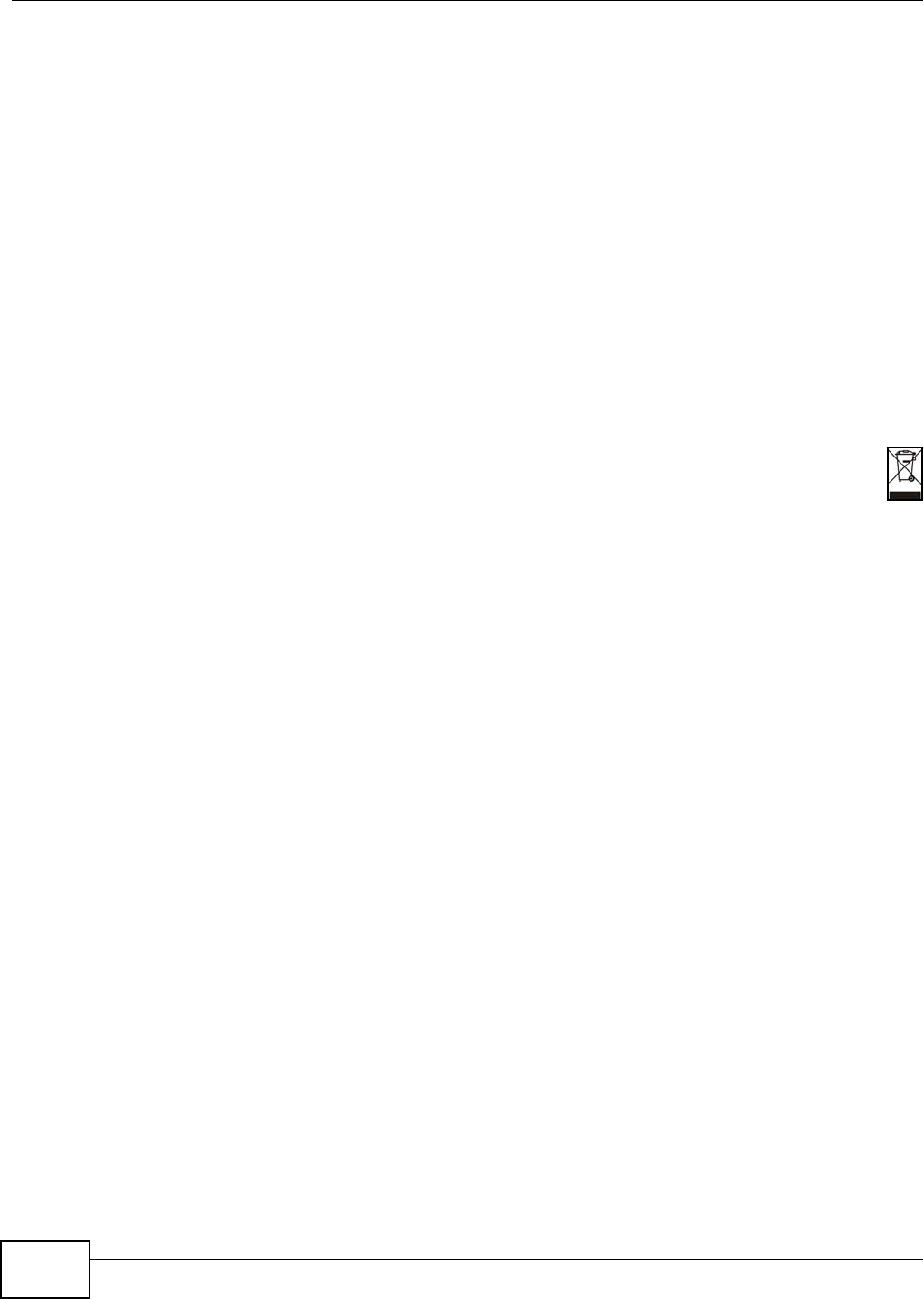
Appendix F Legal Information
NBG-419N v2 User’s Guide
274
• Do NOT open the device or unit. Opening or removing covers can expose you to dangerous high voltage
points or other risks. ONLY qualified service personnel should service or disassemble this device. Please
contact your vendor for further information.
• Make sure to connect the cables to the correct ports.
• Place connecting cables carefully so that no one will step on them or stumble over them.
• Always disconnect all cables from this device before servicing or disassembling.
• Use ONLY an appropriate power adaptor or cord for your device.
• Connect the power adaptor or cord to the right supply voltage (for example, 110V AC in North America or
230V AC in Europe).
• Do NOT allow anything to rest on the power adaptor or cord and do NOT place the product where anyone can
walk on the power adaptor or cord.
• Do NOT use the device if the power adaptor or cord is damaged as it might cause electrocution.
• If the power adaptor or cord is damaged, remove it from the power outlet.
• Do NOT attempt to repair the power adaptor or cord. Contact your local vendor to order a new one.
• Do not use the device outside, and make sure all the connections are indoors. There is a remote risk of
electric shock from lightning.
• Do NOT obstruct the device ventilation slots, as insufficient airflow may harm your device.
• Antenna Warning! This device meets ETSI and FCC certification requirements when using the included
antenna(s). Only use the included antenna(s).
• If you wall mount your device, make sure that no electrical lines, gas or water pipes will be damaged.
Your product is marked with this symbol, which is known as the WEEE mark. WEEE stands for Waste
Electronics and Electrical Equipment. It means that used electrical and electronic products should not be
mixed with general waste. Used electrical and electronic equipment should be treated separately.

Index
NBG-419N v2 User’s Guide 275
Index
A
ActiveX 160
Address Assignment 120
Advanced Encryption Standard
See AES.
AES 257
alternative subnet mask notation 213
antenna
directional 261
gain 261
omni-directional 261
AP 15
AP (access point) 251
AP Mode
menu 76
status screen 74, 80
AP+Bridge 15
Auto-bridge 130, 131
B
Bandwidth management
overview 163
priority 165
services 169
Basic Service Set, See BSS 249
BitTorrent 169
Bridge/Repeater 15
bridged APs, security 106
BSS 249
C
CA 256
Certificate Authority
See CA.
certifications 267
notices 268
viewing 269
Channel 66, 75
channel 104, 251
interference 251
Configuration
restore 186
content filtering 159
by keyword (in URL) 159
by web feature 159
Cookies 161
copyright 267
CPU usage 67, 75, 81
CTS (Clear to Send) 252
D
Daylight saving 184
DDNS 147
see also Dynamic DNS
service providers 147
DHCP 47, 137
DHCP server
see also Dynamic Host Configuration Protocol
DHCP server 134, 137
DHCP table 47
DHCP client information
DHCP status
disclaimer 267
DNS 139
DNS Server 120
DNS server 139
documentation
related 2
Domain Name System 139
Domain Name System. See DNS.
duplex setting 67, 75, 82
Dynamic DNS 147

Index
NBG-419N v2 User’s Guide276
Dynamic Host Configuration Protocol 137
dynamic WEP key exchange 256
DynDNS 147
DynDNS see also DDNS 147
E
EAP Authentication 255
encryption 105, 257
key 105
WPA compatible 105
ESS 250
ESSID 195
Extended Service Set, See ESS 250
F
FCC interference statement 267
File Transfer Program 169
Firewall
ICMP packets 157
Firmware upload 184
file extension
using HTTP
firmware version 66, 74, 80
fragmentation threshold 252
FTP. see also File Transfer Program 169
G
General wireless LAN screen 106
Guide
Quick Start 2
H
hidden node 251
HTTP 169
Hyper Text Transfer Protocol 169
I
IANA 218
IBSS 249
IEEE 802.11g 253
IGMP 121
see also Internet Group Multicast Protocol
version
IGMP version 121
Independent Basic Service Set
See IBSS 249
initialization vector (IV) 258
Internet Assigned Numbers Authority
See IANA 218
Internet Group Multicast Protocol 121
IP Address 135, 142, 143
IP alias 134
IP Pool 137
J
Java 160
L
LAN 133
IP pool setup 134
LAN overview 133
LAN setup 133
LAN TCP/IP 134
Language 187
Link type 67, 75, 81
Local Area Network 133
M
MAC 110
MAC address 104, 120
cloning 120
MAC address filter 104
MAC address filtering 110

Index
NBG-419N v2 User’s Guide 277
MAC filter 110
managing the device
good habits 16
using the web configurator. See web configurator.
using the wireless switch.
using the WPS. See WPS.
MBSSID 15
Media access control 110
Memory usage 67, 75, 81
Message Integrity Check (MIC) 257
mode 15
Multicast 121
IGMP 121
N
NAT 141, 142, 218
how it works 141
overview 141
see also Network Address Translation
NAT Traversal 173
Navigation Panel 68, 76
navigation panel 68, 76
Network Address Translation 141, 142
O
Operating Channel 66, 75
operating mode 15
other documentation 2
P
P2P 169
Pairwise Master Key (PMK) 258, 259
peer-to-peer 169
Point-to-Point Protocol over Ethernet 123
Point-to-Point Tunneling Protocol 125
Pool Size 138
Port forwarding 143
default server 142
local server 143
port speed 67, 75, 82
PPPoE 123
dial-up connection
PPTP 125
preamble mode 253
product registration 270
PSK 258
Q
Quality of Service (QoS) 113
Quick Start Guide 2
R
RADIUS 254
message types 255
messages 255
shared secret key 255
registration
product 270
related documentation 2
Remote management
and NAT 170
limitations 170
system timeout 171
Reset button 43
Reset the device 43
Restore configuration 186
RIP 153
Roaming 111
RTS (Request To Send) 252
threshold 251, 252
RTS/CTS Threshold 104, 111, 112
S
safety warnings 273
Scheduling 116
Service and port numbers 158, 168

Index
NBG-419N v2 User’s Guide278
Service Set 61, 106
Service Set IDentification 61, 106
Service Set IDentity. See SSID.
Session Initiated Protocol 169
SIP 169
SSID 61, 66, 75, 81, 104, 106
Static DHCP 138
Static Route 149
Status 65
subnet 211
Subnet Mask 135, 136
subnet mask 212
subnetting 214
Summary
DHCP table 47
Packet statistics 48
Wireless station status 49
System General Setup 181
System restart 187
T
TCP/IP configuration 137
Temporal Key Integrity Protocol (TKIP) 257
Time setting 183
trigger port 144
Trigger port forwarding 144
example 146
process 146
U
Universal Plug and Play 173
Application 173
Security issues 174
UPnP 173
URL Keyword Blocking 161
User Name 148
V
VoIP 169
VPN 125
W
WAN (Wide Area Network) 119
WAN advanced 130
WAN MAC address 120
warranty 269
note 269
Web Configurator
how to access 39
Overview 39
web configurator 16
Web Proxy 161
WEP Encryption 84, 109, 110
WEP encryption 108
WEP key 108
Wi-Fi Protected Access 257
Wireless association list 49
wireless channel 195
wireless client WPA supplicants 258
wireless LAN 195
wireless LAN scheduling 116
Wireless network
basic guidelines 103
channel 104
encryption 105
example 103
MAC address filter 104
overview 103
security 104
SSID 104
Wireless security 104
overview 104
type 104
wireless security 195, 253
wireless switch 16
Wireless tutorial 89
WPS 89
Wizard setup 29
WLAN

Index
NBG-419N v2 User’s Guide 279
interference 251
security parameters 260
World Wide Web 169
WPA 257
key caching 258
pre-authentication 258
user authentication 258
vs WPA-PSK 258
wireless client supplicant 258
with RADIUS application example 259
WPA compatible 105
WPA2 257
user authentication 258
vs WPA2-PSK 258
wireless client supplicant 258
with RADIUS application example 259
WPA2-Pre-Shared Key 257
WPA2-PSK 257, 258
application example 259
WPA-PSK 257, 258
application example 259
WPS 16
WWW 169
X
Xbox Live 169

Index
NBG-419N v2 User’s Guide280